This document is Steven Edward Atkin's dissertation submitted to Florida Institute of Technology in partial fulfillment of the requirements for a Doctor of Philosophy in Computer Science. The dissertation proposes a new multi-layered architecture called Metacode for multilingual information processing. It analyzes existing character encoding schemes and algorithms like bidirectional reordering and character normalization, and argues they lack a coherent architectural framework. The dissertation then introduces abstractions and mechanisms to organize these elements into the Metacode architecture.
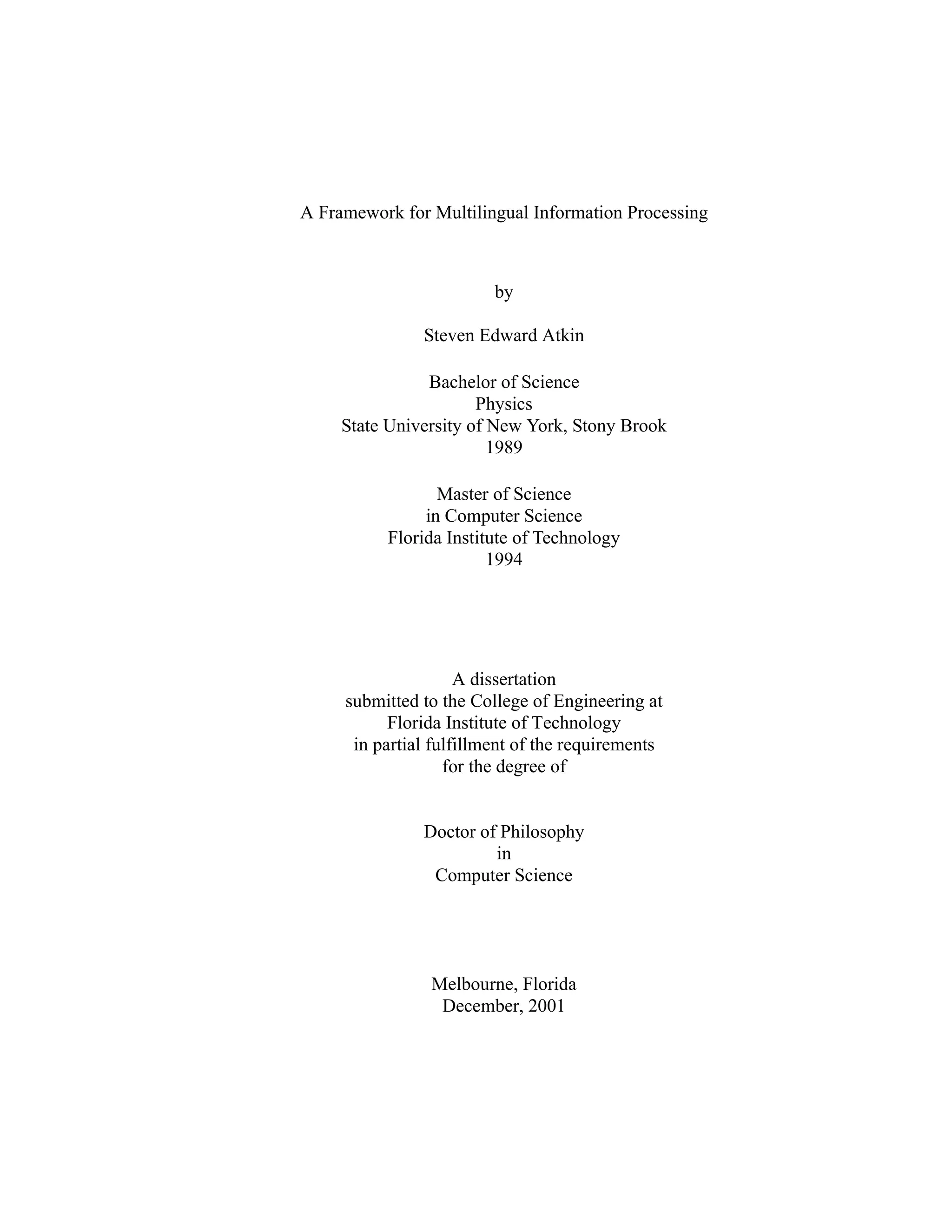

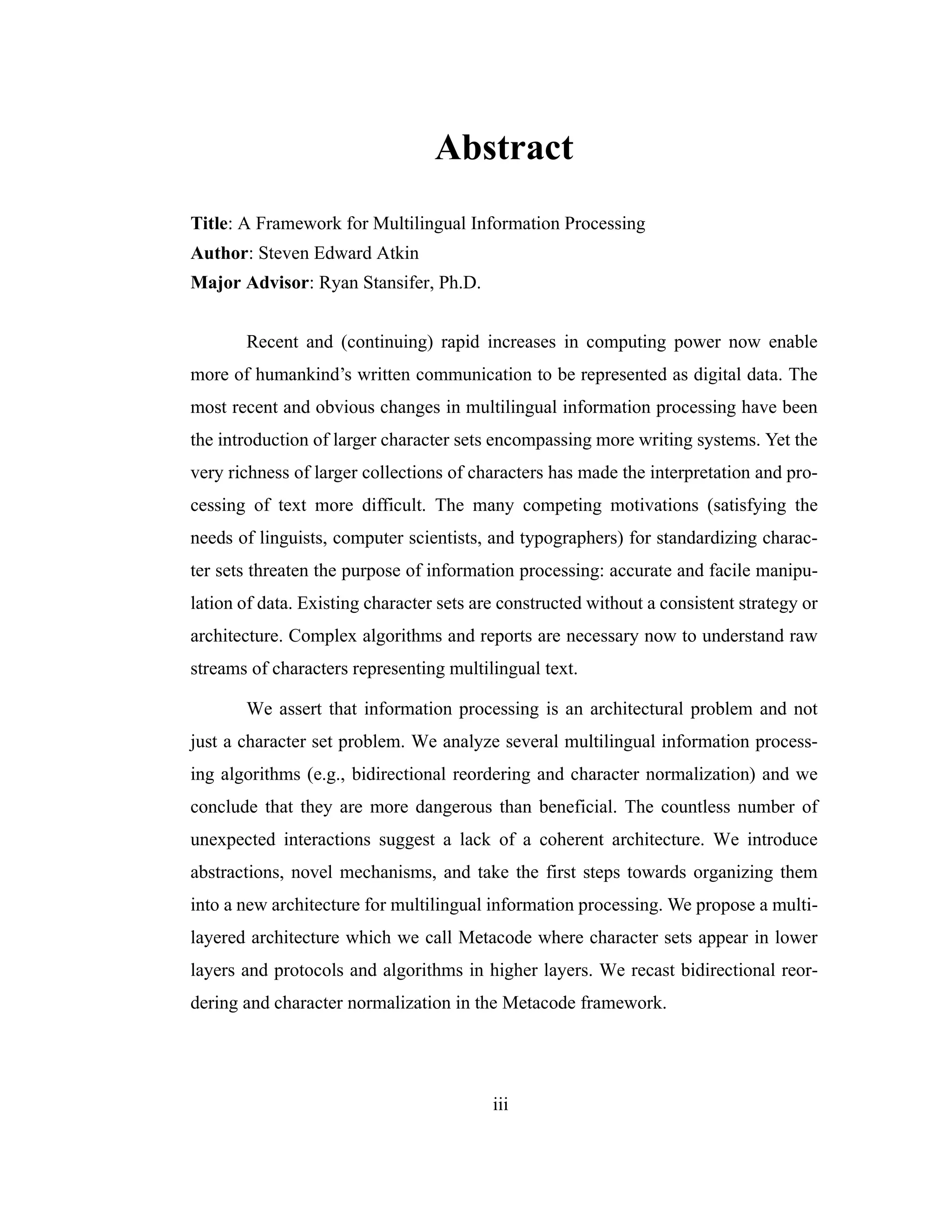
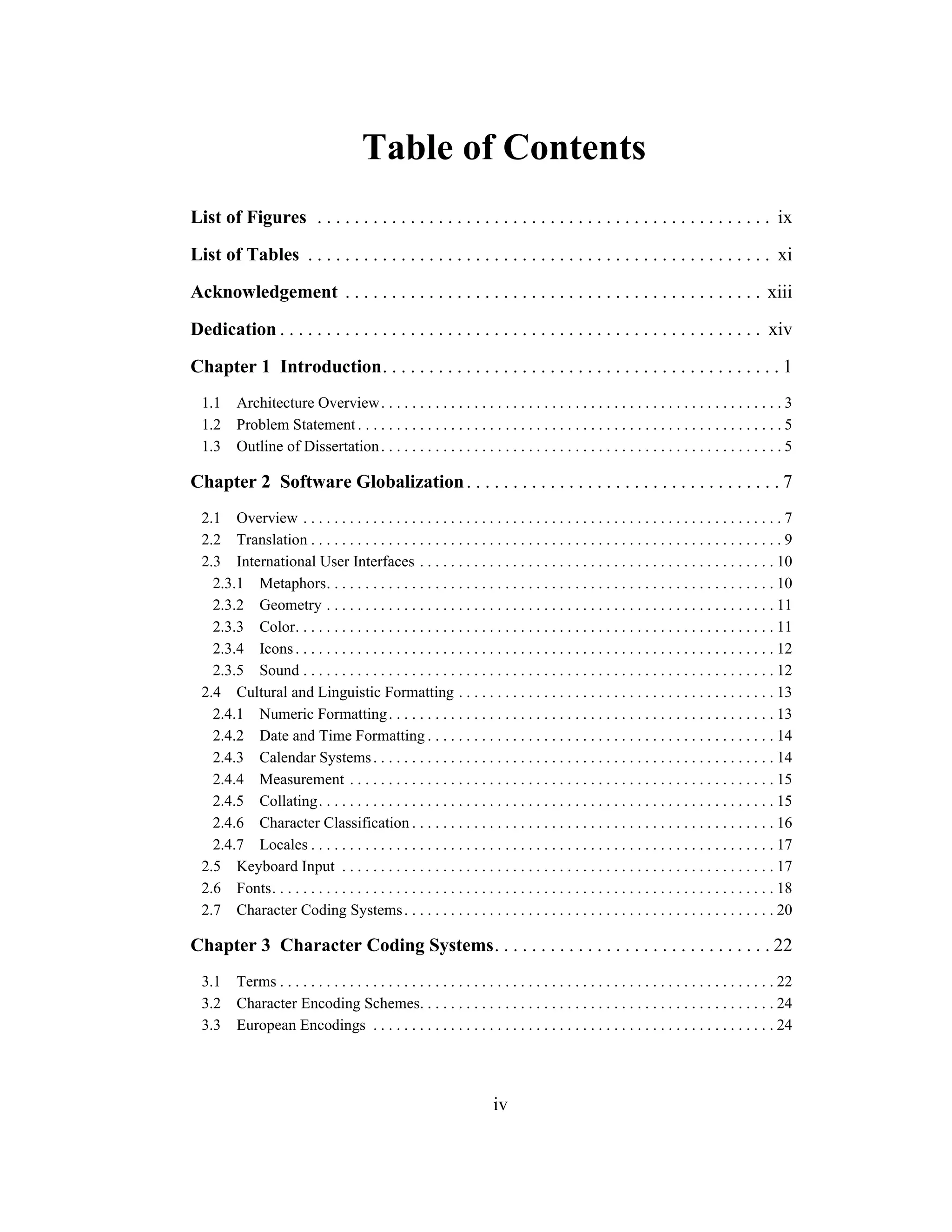
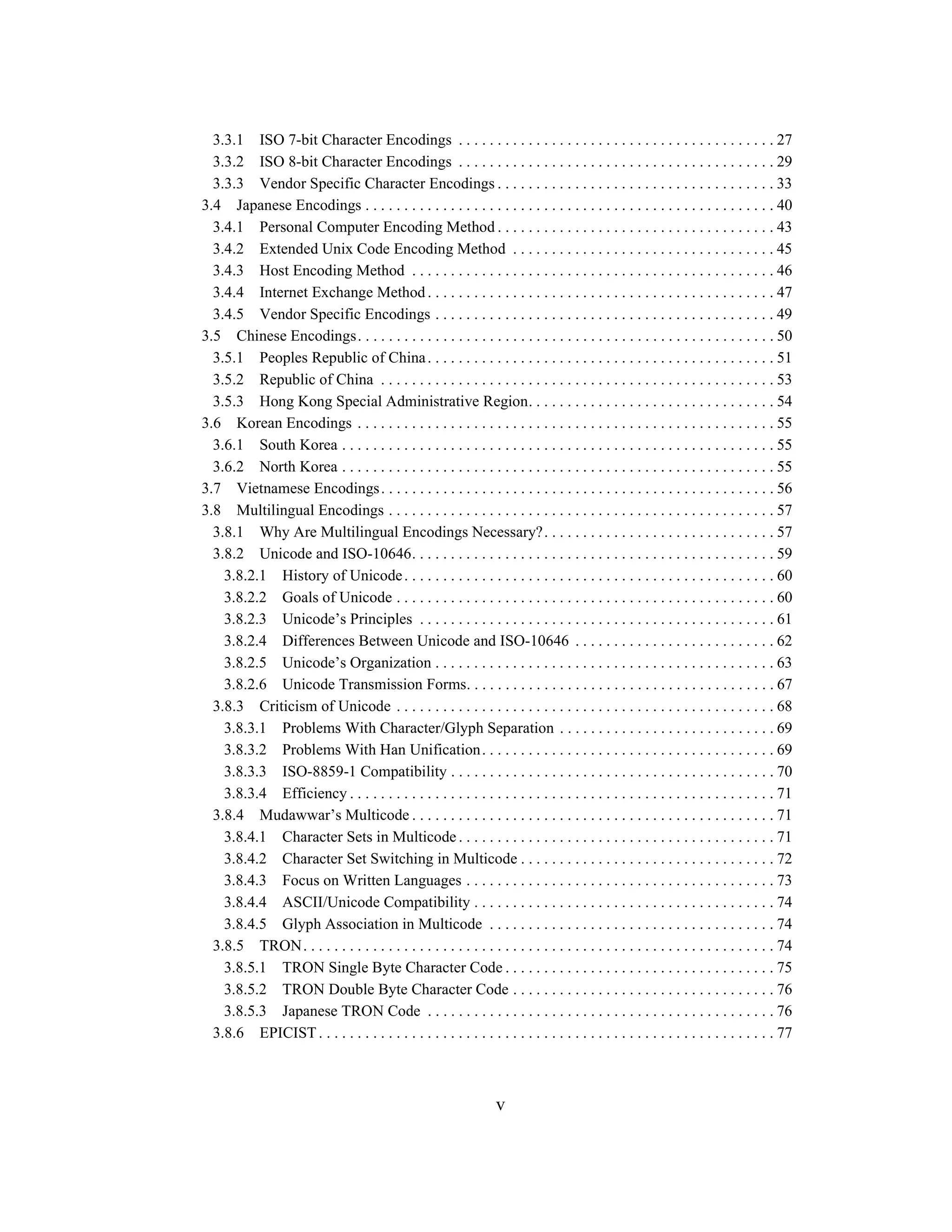
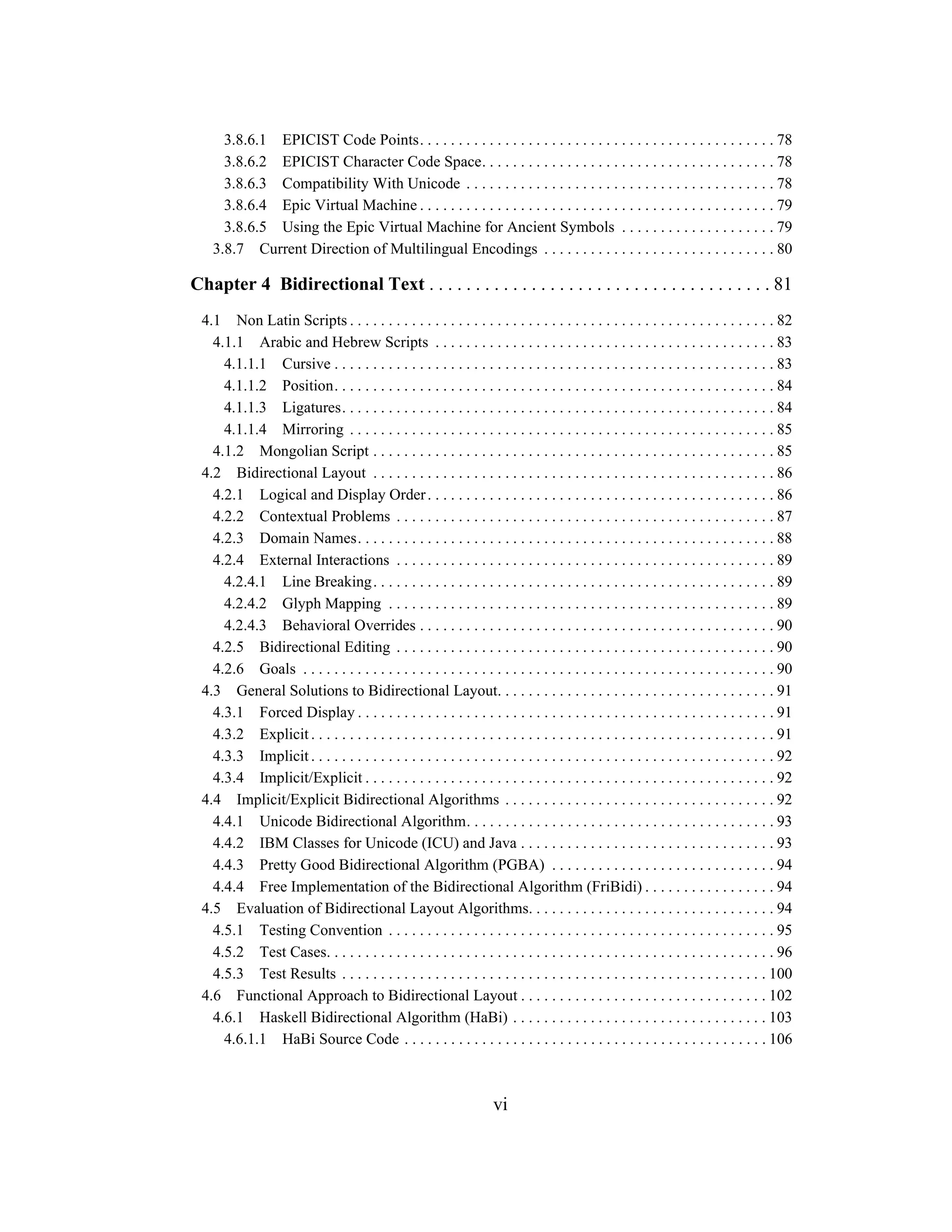
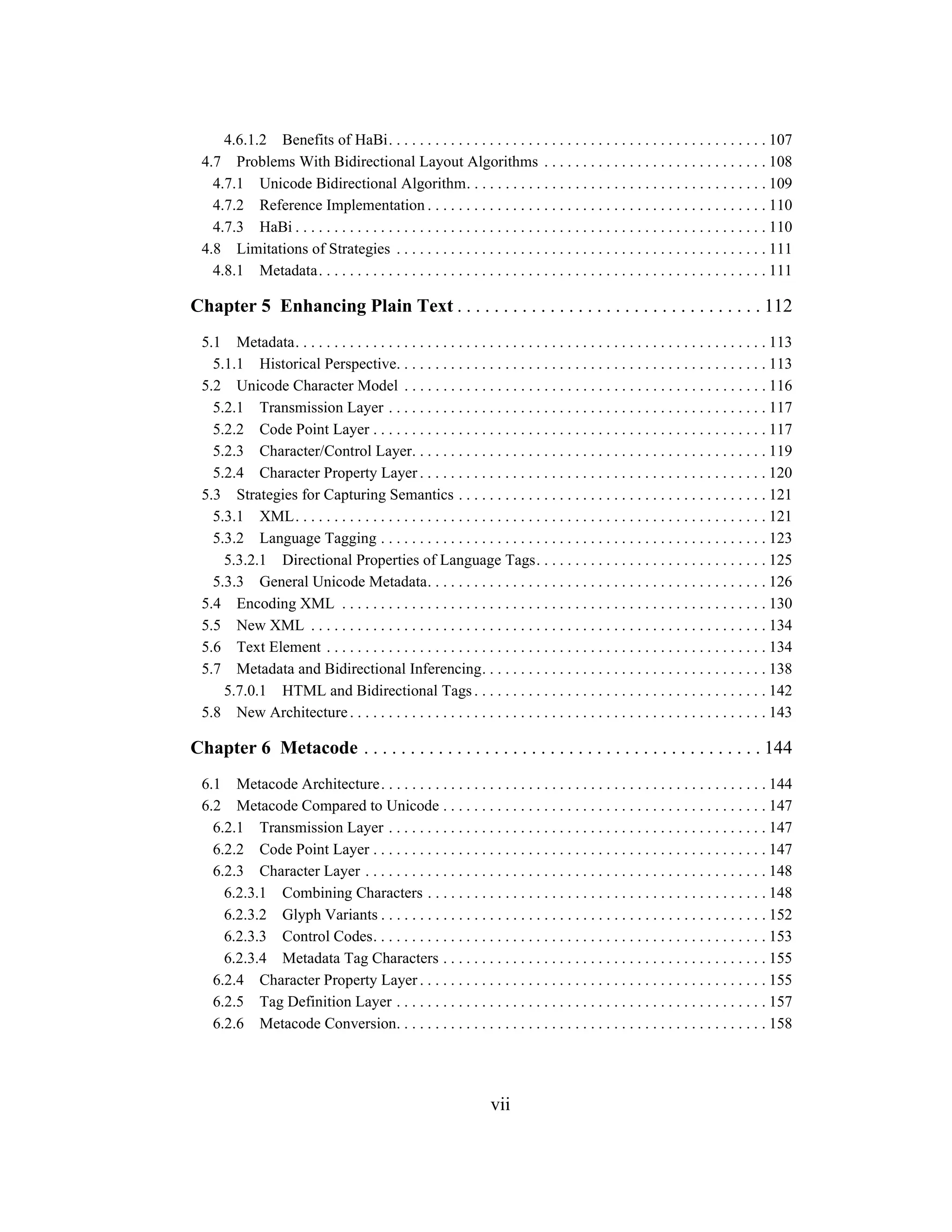
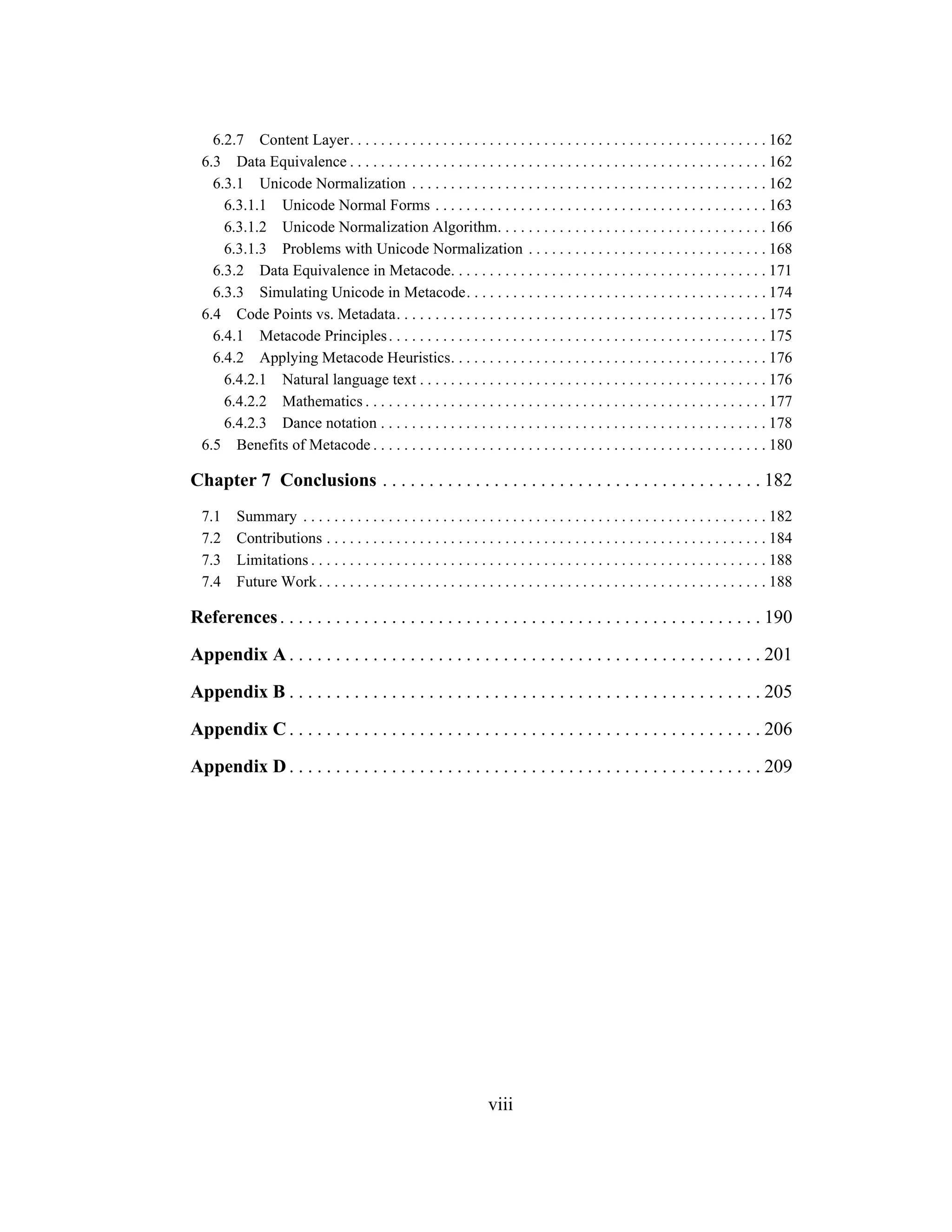
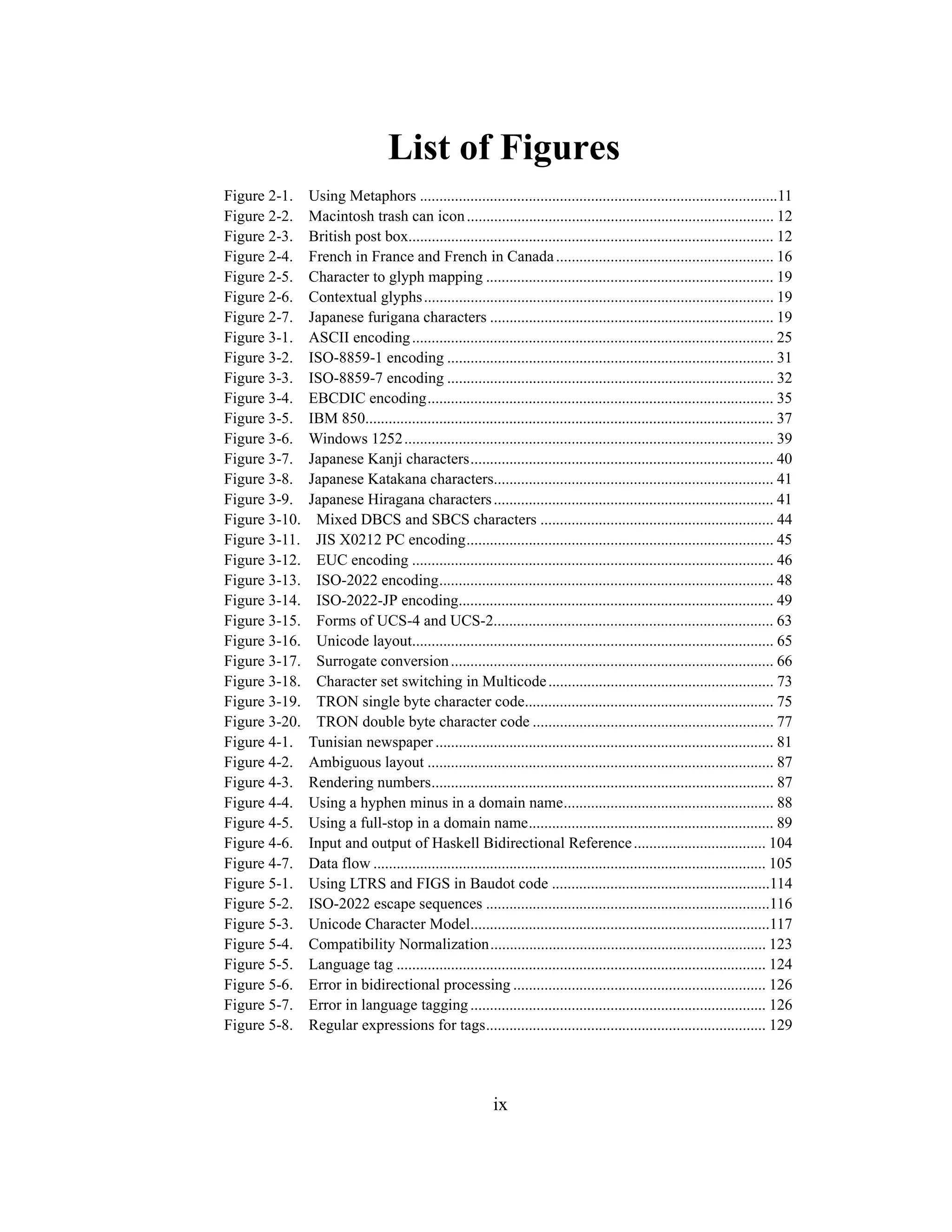
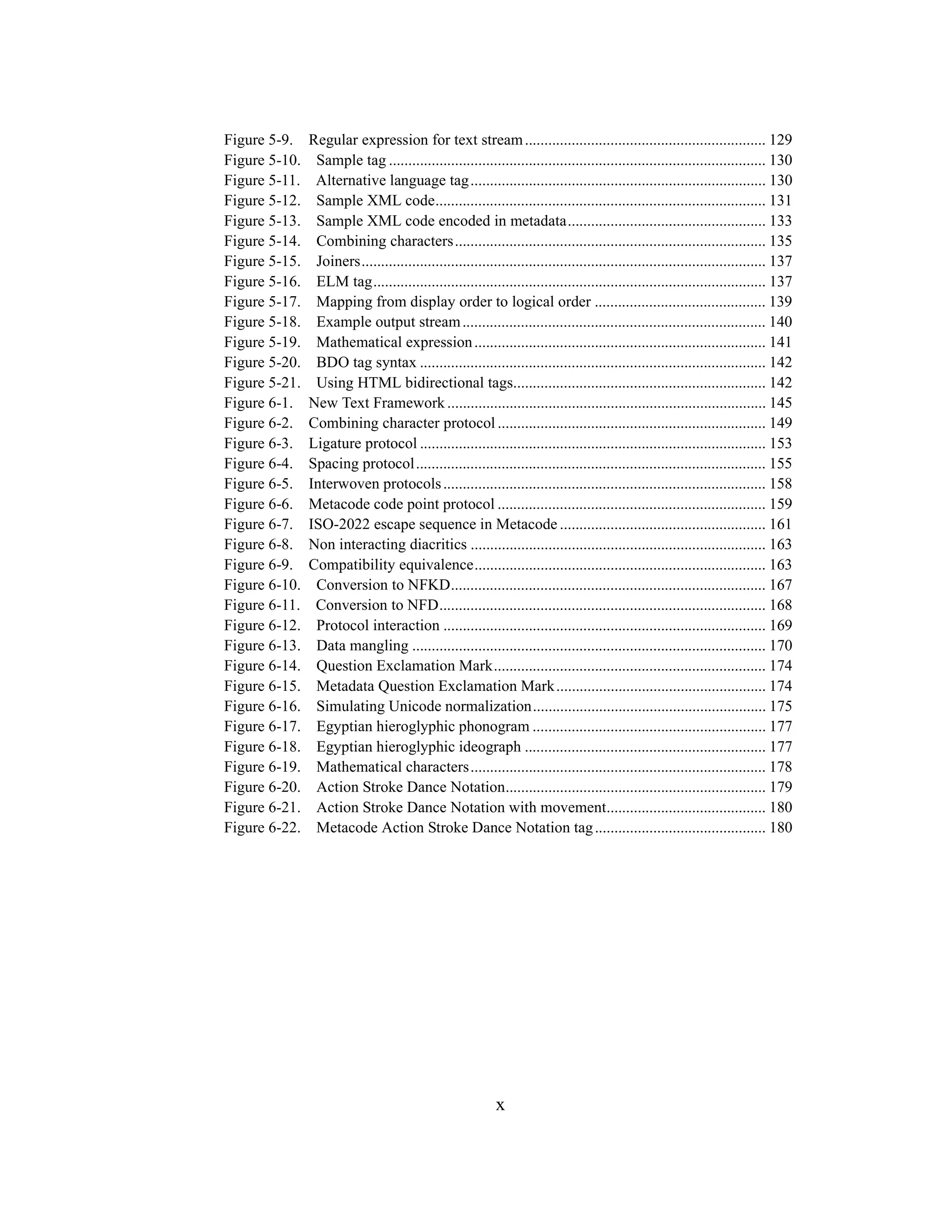
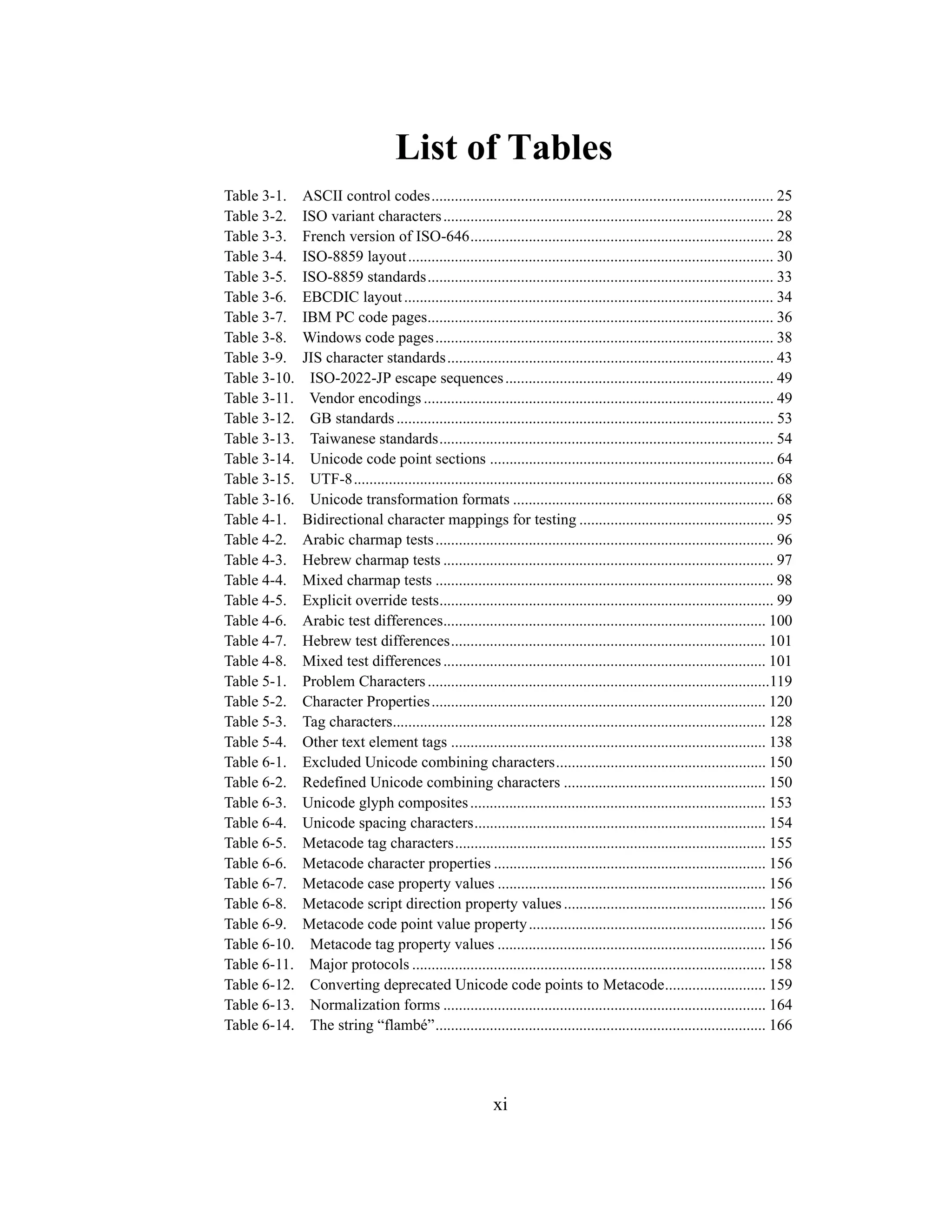

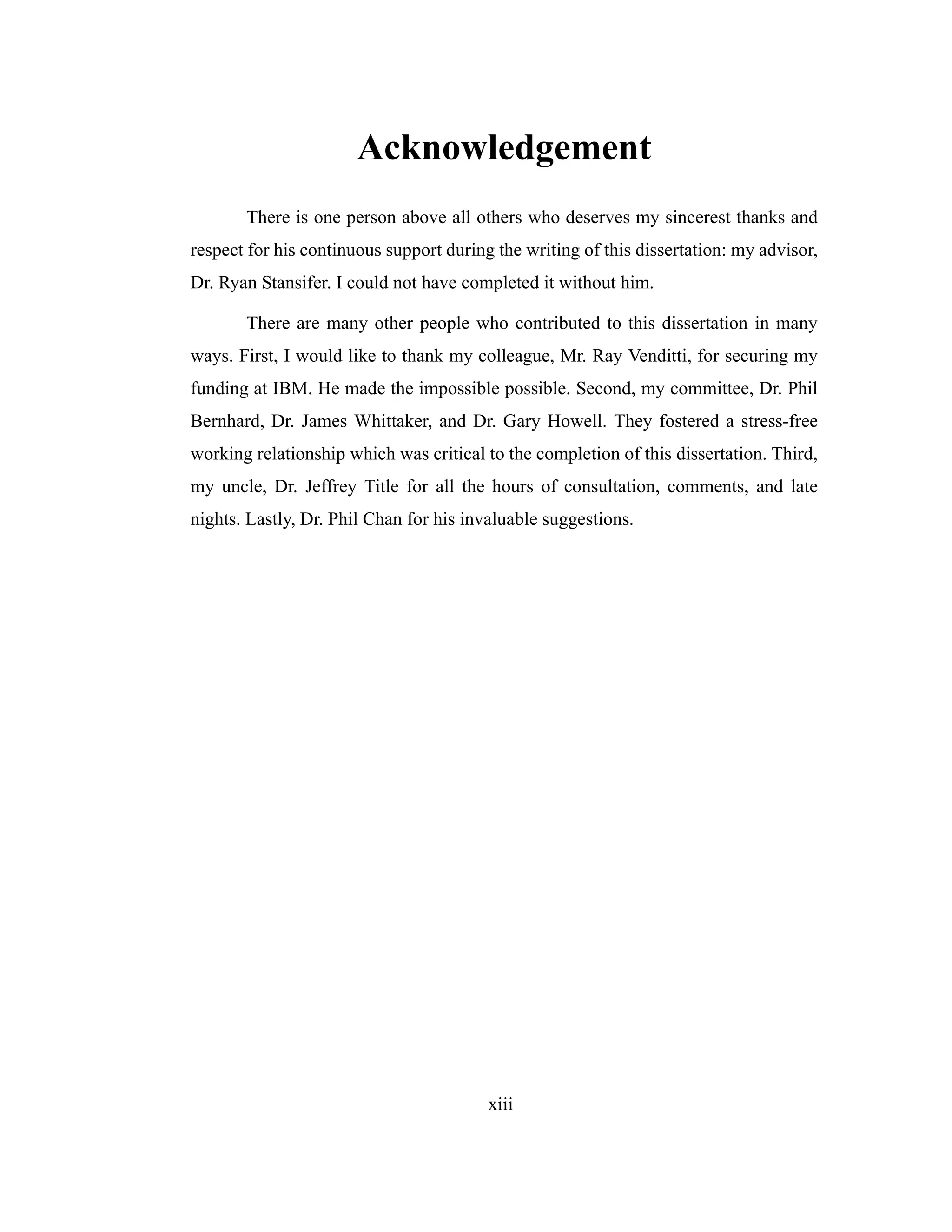
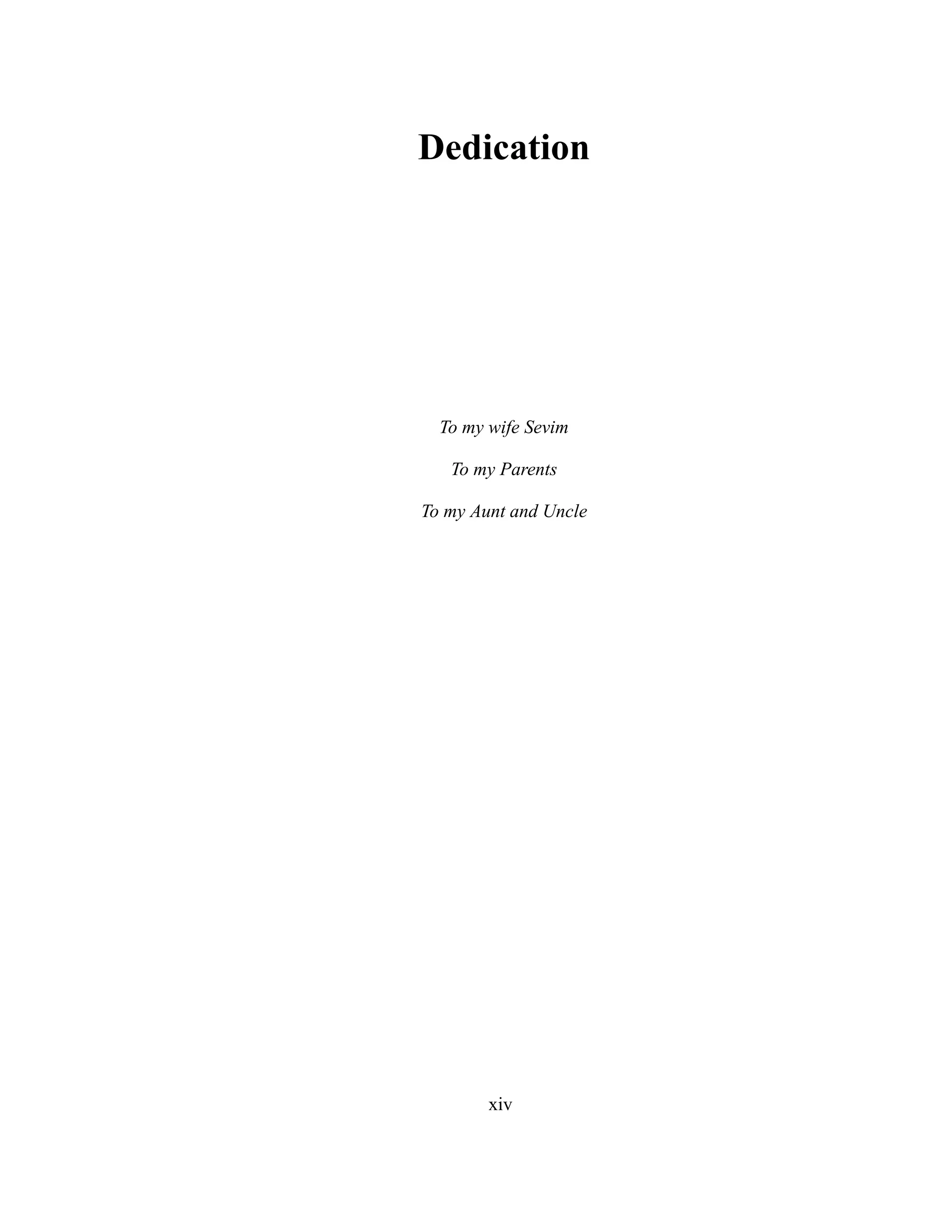
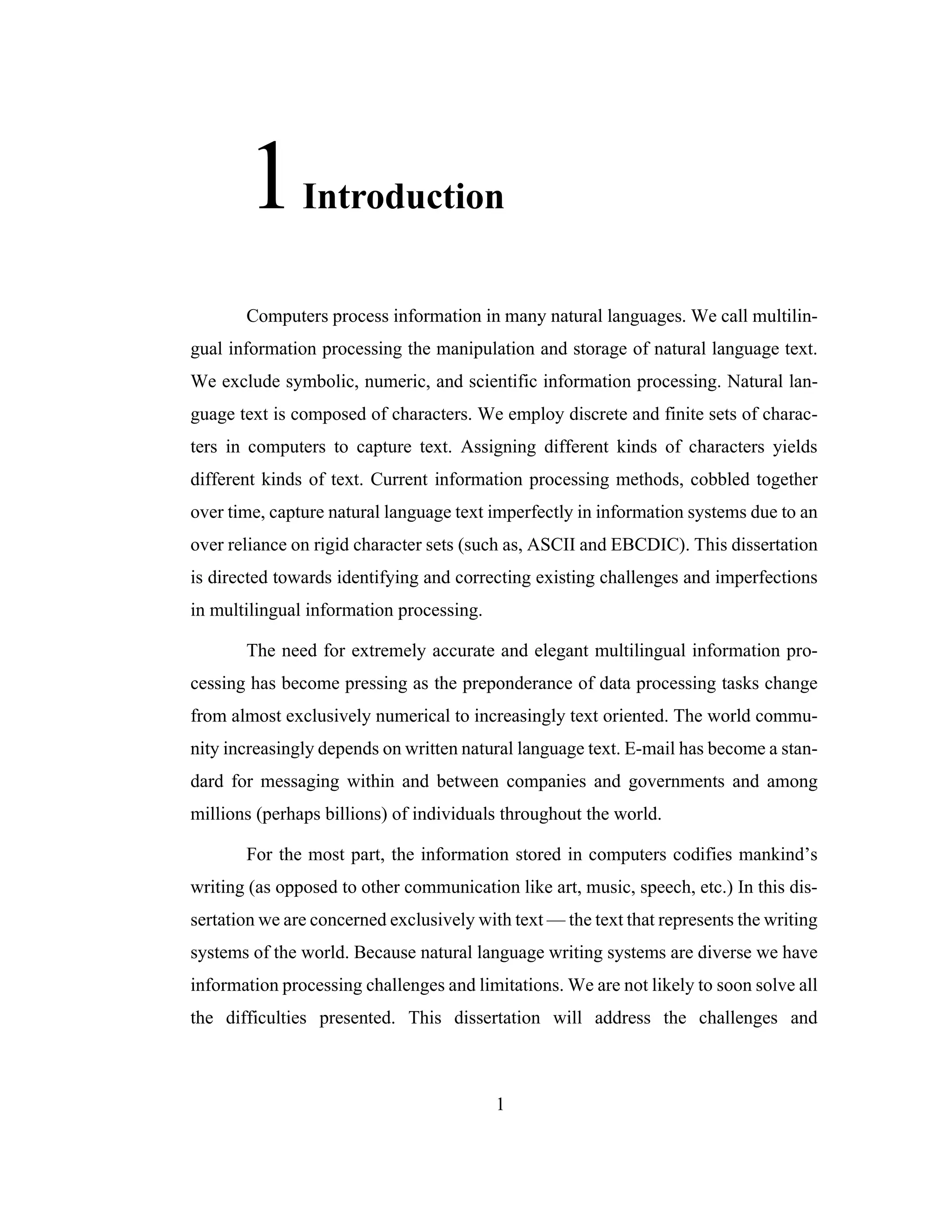




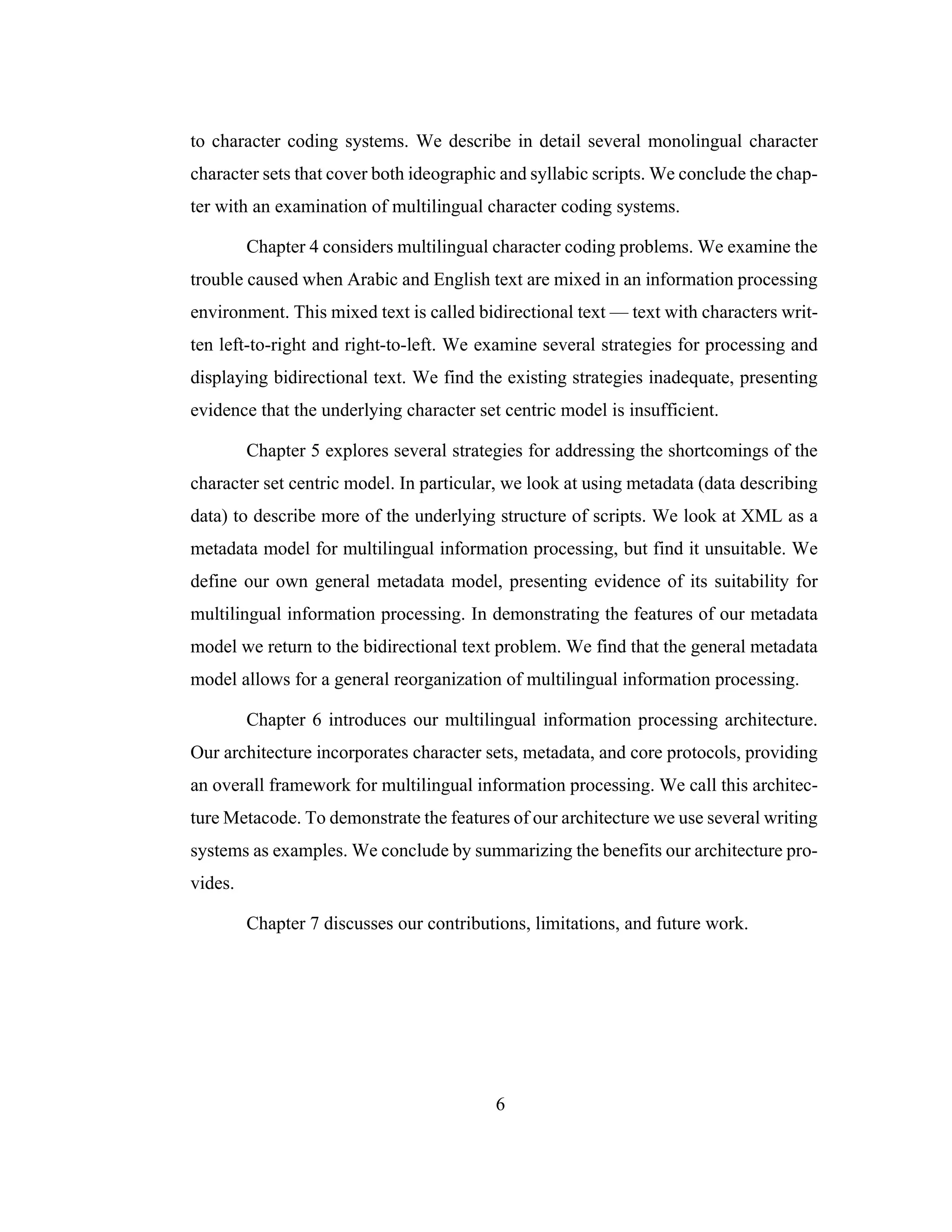
![7
2Software Globalization
Software globalization is concerned with the application of practices and pro-
cesses to make a software product usable throughout the world. The term globaliza-
tion refers to the whole process starting from an internationalized version of an
application through the production of multiple localized versions of it. The three
terms internationalization, localization, and translation broadly define the various
subdisciplines of software globalization. Software globalization builds upon interna-
tionalization, localization, and translation. In this dissertation we define internation-
alization as the process of creating cultural and language neutral software. The term
localization refers to the process of adapting a software product to a specific culture
and language. The term translation is defined as the process of converting human
readable text from one language into another. [55]
Throughout this chapter we discuss the primary subdisciplines that make up
the field of software globalization. In each subdiscipline we outline the principle
issues and current trends. The software globalization area is a relatively new field of
study, and as we will see the boundaries of the field are still open to debate.
2.1 Overview
Unlike, other research areas of computer science, software globalization has
arisen not from academia, but rather from industry. We argue that this industrial
movement has occurred for the following reasons: increasing user expectations,
proliferation of distributed computing, explosive software development costs, com-
pounding maintenance outlays, and governmental requirements.](https://image.slidesharecdn.com/0f3c79e3-c95a-412c-8137-2676e0a933c3-161215183642/75/cs-2002-01-21-2048.jpg)
![8
The market for computing in the 1950’s and early 1960’s was not home users,
but rather large institutions (banking, industrial, governmental, and research). In
many cases computing at these large institutions was primarily for the purposes of
number crunching. Therefore, linguistic/cultural support was not a strong require-
ment. In fact, even English was not fully supported (lower case characters do not
appear until 1967). Moreover, if a system did provide additional linguistic support it
was usually a language that could be represented using the Latin script.
In the late 1970’s we see a dramatic shift in computing from number crunch-
ing to information processing. This shift, coupled with the advent of personal com-
puting in the 1980’s, caused user expectations to rise. It was no longer possible to
insist that users conform to the computer/software, but rather software must adapt to
the user, making linguistic/cultural support a must. Most commercial software during
this time period was developed within the United States, so development teams had
little experience with linguistic/cultural issues. Support for other languages/cultures
was viewed as customization/translation and not as part of main line development.
This customization/translation activity was farmed out to another organization within
the company or an outside localization firm. Therefore, software development/deliv-
ery became staged. By staged we mean, first the US version would be delivered fol-
lowed by various language versions. This overall strategy caused software
development costs to explode. [29],[61],[85]
The ever increasing costs can be attributed to two factors. First, customiza-
tion, in reality, requires more than just translation, because in many cases the source
code itself required modification. In some cases source modifications were incom-
patible with changes made for other languages. It became necessary to maintain sep-
arate source lines for the individual languages, further increasing development costs.
Maintaining these separate source lines had a rippling effect throughout the entire
software development process. Its effects were most strongly felt during mainte-
nance, because in many cases corrective fixes could not be applied universally across](https://image.slidesharecdn.com/0f3c79e3-c95a-412c-8137-2676e0a933c3-161215183642/75/cs-2002-01-22-2048.jpg)
![9
the various language versions. Multiple fixes would be created, further increasing the
overall software development cost. [61],[85]
The multiple source line development strategy had a direct impact upon cus-
tomers, in particular large multinational customers. Most multinational customers
wanted the ability to simultaneously roll out multiple language software solutions
across their entire corporation. This was difficult to achieve, because of the staged
development/delivery method in effect at the time. Each specific language version
was based upon a different source line, thereby requiring the customer to repeat the
entire certification process for each language. By the late 1980’s this strategy became
crippling as costs sky rocketed. [70]
A strong push from multiple source line development to single source line
development was undertaken in the 1990’s. It is at this point in time that we see the
beginnings of internationalization and localization. It was a move in the right direc-
tion, but the internationalization problem turned out to involve a lot more factors than
simply translating and converging multiple source lines. In the sections below we
explore these factors, which in turn form the six individual sub fields of software glo-
balization: Translation, International User Interfaces, Cultural/Linguistic Format-
ting, Keyboard Input, Fonts, and Character Coding Systems.
2.2 Translation
Naturally, a software system must be translated into the user’s native lan-
guage for it to be useful. At first it might seem that translating a programs message’s
and user interface elements is a relatively simple task. There are subtleties, however.
Literal translations of text strings in applications without regard for human
factors principles may serve as a source for confusing or misleading user interfaces.
One such example comes form the Danish translation of MacPaint. One of the menus
in MacPaint is called “Goodies” which is acceptable as the name of a menu in](https://image.slidesharecdn.com/0f3c79e3-c95a-412c-8137-2676e0a933c3-161215183642/75/cs-2002-01-23-2048.jpg)
![10
English. The literal translation of goodies in Danish is the word godter. This is a
proper translation, but has an entirely different connotation (mostly having to do with
candy), leading users to confusion. [8]
Translation of user manuals must also be approached with caution. For exam-
ple, the following is a sample of an English translation from the preface of a printer
manual in Japanese:
“We sincerely expect that the PRINTER CI-600 will be appreciated
more than ever, in the fields of ‘data-transformation’ by means of
human-scale, and the subsequent result of ‘fluent metabolism’ as
regards the artificial mammoth creature-systematized information
within the up-to-date human society.”
Clearly this example demonstrates that the problem of translation is one of global
importance. [8]
2.3 International User Interfaces
Software must fit into the cultural context of the user. Internationalized appli-
cations should appear as if they were custom designed for each individual market.
This requires a deep understanding of not only languages, but also of cultural norms,
taboos, and metaphors. [91],[8]
2.3.1 Metaphors
Just as metaphors permeate our everyday communication, so do they occur
throughout the interfaces we use. It is the use of metaphors that makes our interaction
with software seem more natural and intuitive. For example, the icons shown in
Figure 2-1. are from Lotus 1-2-3. The second icon, with somebody running, is
intended to let you “run” a macro [29]. The problem is that not everyone “runs” a
macro. In France, for example, the metaphor isn’t running a macro it’s “throwing” a
macro. So using the metaphor of somebody running makes no sense for users in
France. What may seem natural to users in the United States may not appear to be](https://image.slidesharecdn.com/0f3c79e3-c95a-412c-8137-2676e0a933c3-161215183642/75/cs-2002-01-24-2048.jpg)
![11
obvious to users in other markets. Therefore, as software is internationalized and
localized it is imperative that metaphors be tailored for each market just as language
is. [25],[8]
Figure 2-1. Using Metaphors
2.3.2 Geometry
Even visual scanning patterns are culturally dependent. Studies with English
and Hebrew readers have demonstrated the existence of these differences. English
readers tend to start scanning an object from the left quadrant, while Hebrew readers
tend to scan from the right quadrant. This is probably due to the fact that each lan-
guage has a specific scanning direction (English left-to-right and Hebrew right-to-
left). This infers that the formatting and positioning of windows in an application
must also be tailored for each market. [1],[8]
2.3.3 Color
The varied use of color in everyday things is common. However, cultural dif-
ferences can affect the meanings attributed to color. For example, in the United States
the color red is often used to indicate danger, while in China the color red represents
happiness. The color white in the United States represents hope and purity, however
in Japan the color white represents death. By using color correctly, interfaces can be
created where color can impart and reinforce information conveyed by other media,
such as text. [83],[91],[8]](https://image.slidesharecdn.com/0f3c79e3-c95a-412c-8137-2676e0a933c3-161215183642/75/cs-2002-01-25-2048.jpg)
![12
2.3.4 Icons
The abundant use of icons in today’s graphical interfaces aims to provide a
more intuitive user interface by equating an underlying action or function to a sym-
bol. The seemingly simple trash icon in the Macintosh interface seems at first to have
only one underlying meaning, disposing of files. See Figure 2-2. Nevertheless, in the
United Kingdom an entirely different meaning was ascribed to this icon. It turned out
that the trash can icon resembled a British post box better than a British trash can,
creating confusion. See Figure 2-3. Therefore, even the style of icons is culturally
dependent. [37],[38],[81],[91],[8]
Figure 2-2. Macintosh trash can icon
Figure 2-3. British post box
2.3.5 Sound
Not only are icons culturally sensitive, but the use of sound is as well. The use
of sound has improved the “user-friendliness” of applications by reinforcing visually
displayed messages. At first appearance this seems to be culturally neutral, but Lotus
corporation discovered that this was not true. Lotus spent considerable time and
money to internationalize 1-2-3 for the Japanese market, but were dismayed to find
that 1-2-3 did not receive a favorable reception. Lotus was unaware that the simple
“error beep” present in 1-2-3 was a source of great discomfort for the Japanese. The](https://image.slidesharecdn.com/0f3c79e3-c95a-412c-8137-2676e0a933c3-161215183642/75/cs-2002-01-26-2048.jpg)
![13
Japanese tend to work in highly crowded offices and are fearful of letting coworkers
know they are making mistakes. Hence it was only natural that the Japanese avoided
using 1-2-3 when they were at work. [91],[14]
The range of issues just described broadly defines the area of interest to the
international user interface community. The design of international user interfaces is
mostly viewed as a facet of localization. This is not a strict rule as there is some
amount of overlap with some of the other sub fields of globalization.
2.4 Cultural and Linguistic Formatting
Differences in notational conventions provide yet another area that must
undergo internationalization. For example, although all countries have some form of
a monetary system, few countries agree on details such as the currency symbol and
the formatting of currency. Similarly, most people agree that time is measured by the
cycles of the earth and the moon, but the ubiquitous Gregorian calendar used in
Europe and North America isn’t necessarily utilized all around the world. Such dif-
fering views require highly flexible software that can process and represent data for
a wide variety of cultures and languages. In the following paragraphs we discuss
some of the common issues surrounding cultural and linguistic formatting. [85]
2.4.1 Numeric Formatting
Most regions of the world adhere to Arabic numbers, where values are base
10. Problems arise when large and fractional numbers are used. In the United States,
the “radix” point (the character which separates the whole part of the number from
the fractional part) is the full-stop. Throughout most of Europe the radix point is a
comma. In the United States the comma is used as break for separating groups of
numbers. Europeans use single quotes to separate groups of numbers. In addition to
the problem of formatting numeric quantities, the interpretation of the values of num-
bers is also culturally sensitive. For example, in the United States a “billion” is](https://image.slidesharecdn.com/0f3c79e3-c95a-412c-8137-2676e0a933c3-161215183642/75/cs-2002-01-27-2048.jpg)
![14
represented as a thousand million (1,000,000,000), but in Europe a billion is a million
million (1,000,000,000,000), which is a substantially larger quantity. [91],[8]
2.4.2 Date and Time Formatting
As numbers are culturally dependent so are dates. For example the date 11/1/
1993 is interpreted as November 1st, 1993 in the United States, but throughout most
of Europe the date is interpreted as January 11th, 1993. On the surface this does not
seem to be a difficult problem to handle, but countries that use non-western calendars
(Japan, China, Israel, etc.) all have different ways of keeping track of the date. Just
like dates the expression of time is also culturally dependent. For example, in the
United States time is based on a 12 hour time table, while other countries prefer a 24
hour system. [91],[8]
2.4.3 Calendar Systems
Many countries use the 12 month, 365 day Gregorian calendar and define Jan-
uary 1 as the first day of a new year. Many Islamic countries (e.g., Saudi Arabia and
Egypt) also use a calendar with 12 months, but only 354 or 355 days. Because this
year is shorter than the Gregorian year, the first day of the Islamic year changes from
year to year on the Gregorian calendar. Therefore, the Islamic calendar has no con-
nection to the physical seasons. [75]
Israelis use the Hebrew calendar that has either 12 or 13 months, based upon
whether it is a leap year. Non leap years have 12 months and between 353 and 355
days. In a leap year, however, an extra thirteenth month is added. This extra month
allows the Hebrew calendar to stay synchronized with the seasons of the year. [75]
Determining the year also depends on the calendar system. For example, in
Japan two calendar systems are used Gregorian and Imperial. In the Imperial system
the year is based on the number of years the current emperor has been reigning. When
the emperor dies and a new emperor ascends the throne, a new era begins, and the](https://image.slidesharecdn.com/0f3c79e3-c95a-412c-8137-2676e0a933c3-161215183642/75/cs-2002-01-28-2048.jpg)
![15
year count for that era begins. Furthermore, in Japan it is culturally unacceptable to
create a software calendar system that allows a user to reset the year to the beginning,
since this implies the imminent demise of the current emperor. [75],[14]
2.4.4 Measurement
Systems of measurement also vary throughout the world. For example, most
of Europe uses units of measurement that are based upon the MKS system (meters,
kilograms, and seconds), while in the United States measurement is based upon SI
units (inches, pounds, and seconds). Such differences need to be accounted for within
software systems. For example, a word processor should display its ruler in inches
when used in the United States, but should display its units in centimeters when used
in Europe. [91],[8]
2.4.5 Collating
Naturally, numeric data is not the only kind of data subject to cultural and lin-
guistic influences. The ordering of words (character data) is dependent upon both lan-
guage and culture. Even in languages that use the same script system, collation orders
vary. In Spanish the character, sequence “cho” comes after “co”, because “ch” is col-
lated as a single character, while in English “cho” comes before “co”.
In many cases the sorting conventions used by Asian languages are more
complex than the sorting conventions of western languages. In Asian languages ideo-
graphic characters occur more frequently than alphabetic characters. The concepts
used in sorting alphabetic scripts are not necessarily applicable to ideographic scripts.
Ideographic characters represent concepts and thus can be sorted in a variety of ways
(e.g., by phonetic representation, by the character’s base building block, or by the
number of strokes used to write the character).](https://image.slidesharecdn.com/0f3c79e3-c95a-412c-8137-2676e0a933c3-161215183642/75/cs-2002-01-29-2048.jpg)
![16
2.4.6 Character Classification
In the development of internationalized software we often find it useful to
classify characters (e.g., alphabetic, uppercase, lowercase, numeric, etc.) because it
eases processing of character data. Different languages, however, may classify char-
acters differently. For example, in English only 52 characters are classified as alpha-
betic. Danish classifies 112 characters as alphabetic. [85]
Many languages have no concept of case (lowercase and uppercase). Lan-
guages based on Ideographic characters (e.g., Chinese, Japanese, and Korean) all
have a single case. This single case property can also be found in some phonetic
scripts (e.g., Arabic and Hebrew). [75]
Even languages that make case distinctions do not always use the same case
conversion rules. For example, in German the Eszett character “ß” is a lowercase
character that gets converted to two uppercase S’s. Therefore, not every lowercase
character has a simple uppercase equivalent. [75]
In some situations even the same language may use different case conversion
rules. For example, in French when diacritic characters are converted from lowercase
to uppercase the diacritics are usually removed. On the other hand, in French Cana-
dian diacritics are retained during case conversion. See Figure 2-4. Therefore, know-
ing only the language does not guarantee proper case conversion. [75]
Figure 2-4. French in France and French in Canada](https://image.slidesharecdn.com/0f3c79e3-c95a-412c-8137-2676e0a933c3-161215183642/75/cs-2002-01-30-2048.jpg)
![17
2.4.7 Locales
The cultural and linguistic formatting information described above is gener-
ally captured as a collection of data items and algorithms. This repository of cultural
and linguistic formatting information is called a locale. Application developers use
locales to internationalize/localize software. Locales are usually supplied by operat-
ing systems and can be found in both PC systems (e.g., OS/2, Unix, Windows,
MacOS) and host based systems (e.g., OS/400 and System 390). It is becoming
increasingly popular to find locales not only in operating systems but in program-
ming languages (e.g., Java, Python, and Haskell) as well. In general there is little
variation between the cultural formatting information found in the numerous locale
implementations. [9],[108]
Locales are named according to the country and language they support. The
name of a locale is based on two ISO (International Standards Organization) stan-
dards: ISO-639 (code for the representation of language names), and ISO-3166
(codes for the representation of names of countries). For the most part the name of a
locale is formed by concatenating a code from ISO-639 with a code from ISO-3166.
[95]
The setting of a locale is usually done by an individual user or a system
administrator. When a system administrator configures a locale for a system, it is
likely that they are selecting the default locale for an entire system. Depending on the
system, a user may or may not have the ability to switch or modify a locale. [75]
2.5 Keyboard Input
Differences in writing systems also pose unique challenges. This is especially
true for Chinese, Japanese, and Korean, because these languages have a large number
of characters and thus require a special mechanism to input them from a keyboard.
This special mechanism is known as an input method editor (IME). IMEs enable the](https://image.slidesharecdn.com/0f3c79e3-c95a-412c-8137-2676e0a933c3-161215183642/75/cs-2002-01-31-2048.jpg)
![18
input of a large number of characters using a small set of physical keys on a keyboard.
[75]
There are three basic types of IMEs: telegraph code, phonetic, and structural.
A telegraph code IME allows the user to enter the decimal or hexadecimal value of a
character rather than the actual character itself. This is a very simple to use IME,
however, it requires the user to either memorize the decimal values of characters or
carry around a book that lists all the values. [75]
A phonetic IME takes as input the phonetic representation of a character or
sequence of characters rather than the characters themselves. The IME converts the
phonetic representation into characters by using a dictionary. In some cases the pho-
netic representation may yield more than one result. When more than one result is
obtained the user is given a list from which they make a selection for the appropriate
conversion. The phonetic IME does not require a user to memorize decimal values,
however it takes longer to determine the appropriate conversion due to dictionary
lookup. [75]
In a structural IME users enter a character by selecting the character’s build-
ing blocks. In many cases the same building blocks could generate more than one
result. When multiple results are obtained the user is shown a list of candidates and
is asked to pick the most appropriate character. Structural based IMEs do not require
dictionary lookup, however they usually require the user to search through longer
lists of characters. [75]
2.6 Fonts
Users don’t view or print characters directly, rather a user views or prints
glyphs (a graphic representation of a character). Fonts are collections of glyphs with
some element of design consistency. Many glyphs do not have a one-to-one relation-
ship to characters. Sometimes glyphs represent combinations of characters. For](https://image.slidesharecdn.com/0f3c79e3-c95a-412c-8137-2676e0a933c3-161215183642/75/cs-2002-01-32-2048.jpg)
![19
example, a user might type two characters, which might be displayed using a single
glyph. See Figure 2-5. In other cases the choice of a glyph may be context dependent.
For example, a character may take different forms depending on its position within a
word: a separate glyph for a character at the beginning, middle, and end of a word.
See Figure 2-6. [29],[69],[7]
Figure 2-5. Character to glyph mapping
Figure 2-6. Contextual glyphs
As scripts vary, so do the fonts that can display them. Assumptions that fonts
of the same size and style will display different scripts approximately the same size
is incorrect. This is especially true of fonts from Asia. Some scripts have constructs
that go beyond simply placing one glyph after another in a row or column (e.g Japa-
nese furigana, which are used for annotation). The furigana usually appear above
ideographic characters and are used as a pronunciation guide. See Figure 2-7. Fully
internationalized systems must take such issues into consideration. [29]
Figure 2-7. Japanese furigana characters](https://image.slidesharecdn.com/0f3c79e3-c95a-412c-8137-2676e0a933c3-161215183642/75/cs-2002-01-33-2048.jpg)
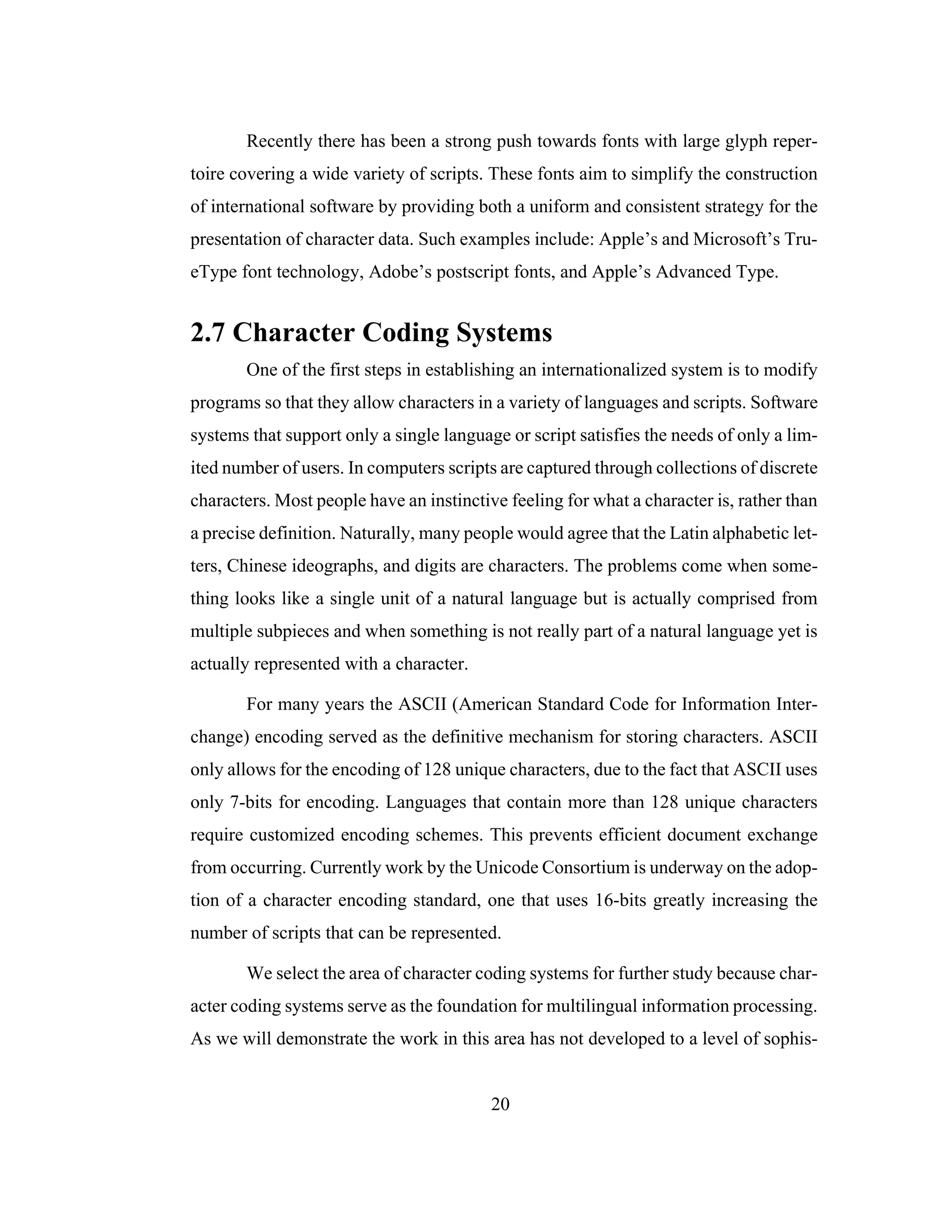


![23
from popular literature in the field of character encoding systems and are used when
the popular definition is more widely accepted. [5],[64],[106]
The following terms and definitions are used in this dissertation:
• Character — “smallest component of written language with semantic value
(including phonetic value).” [104]
• Control character — a character that affects the recording, processing, transmis-
sion or interpretation of data. [27]
• Graphic character — a character other than a control character, that has a visual
representation. [27]
• Combining character — a member of an identified subset of a coded character
set, intended for combination with the preceding or following character. [27]
• Glyph or glyph image— the actual concrete shape, representation of a character.
[96],[106]
• Ligature — a single glyph that is constructed from one or more glyphs. [57]
• Octet — “an 8-bit byte.” [104]
• Character set — “a complete group of characters for one or more writing sys-
tems.” [104]
• Code point — “a numerical index (or position) in an encoding table (coded char-
acter set) used for encoding characters.” [96]
• Escape sequence — a sequence of bit combinations that is used for control pur-
poses in code extension procedures. [27]
• Coded character set — “a mapping from a set of abstract characters to a set of
integers (code points).” [104],[106]
• Code extension — a technique for encoding characters that are not included in a
coded character set. [27]
• Character encoding scheme — “a mapping from a coded character set (or sev-
eral) to a set of octets.” [104],[106]
• Code page — “a coded character set and a character encoding scheme which is
part of a related series.” [104]
• Single byte character set (SBCS) — A character set whose characters are repre-
sented by one byte. [43]](https://image.slidesharecdn.com/0f3c79e3-c95a-412c-8137-2676e0a933c3-161215183642/75/cs-2002-01-37-2048.jpg)
![24
• Double byte character set (DBCS) — A character set whose characters are repre-
sented by two bytes. [43]
• Multiple byte character set (MBCS) — A character set whose character are repre-
sented using a variable number of bytes. [43]
• Transport protocol — A data encoding solely for transmission purposes. [103]
3.2 Character Encoding Schemes
In general we divide character encoding schemes into two broad categories:
monolingual and multilingual encodings. Additionally, character encoding schemes
can be further divided into the following categories [64]:
• Fixed width encoding — in a fixed width encoding each character is represented
using the same number of bytes.
• Modal encoding — in a modal encoding escape sequences are used to signal a
switch between various character sets or modes.
• Non-modal or variable width encoding — in a non-modal encoding the code
point values themselves are used to switch between character sets. Therefore,
characters may be represented using a variable number of bytes. Characters in a
non-modal encoding typically range from one to four bytes.
In the next section we study the character encoding schemes used predomi-
nantly in Western and Eastern Europe. We then turn our attention to the encoding
systems used in Asia. In particular, we explore the encodings used to represent Jap-
anese, Chinese, and Korean. Finally, we conclude the chapter with multilingual char-
acter encodings.
3.3 European Encodings
During the early 1960’s the industry took the Latin alphabet, European
numerals, punctuation marks, and various hardware control codes, and assigned them
to a set of integers (7-bits) and called the resulting mapping ASCII (American Stan-
dard Code for Information Interchange.) ASCII is both a coded character set and an
encoding. In ASCII each code point is represented by a fixed width 7-bit integer. It](https://image.slidesharecdn.com/0f3c79e3-c95a-412c-8137-2676e0a933c3-161215183642/75/cs-2002-01-38-2048.jpg)
![25
is important to note that in ASCII characters are identified by their graphic shape and
not by their meaning. Identifying characters by their shape simplifies character set
construction. For example, in ASCII the code for an apostrophe is the same whether
it is used as an accent mark, or as a single quotation mark. This simplification tech-
nique is certainly not a new idea. Typographers have been doing this for many years.
For example, we no longer see Latin final character forms being used in English.
[15],[26],[104],[87]
The ASCII encoding is divided into two broad sections: controls and graphic
characters. ASCII controls are in the hex ranges 0x00-0x1F and 0x7F, while the
ASCII graphic characters are in the hex range 0x20-0x7E. See Figure 3-1. ASCII’s
control codes are listed in Table 3-1. [15],[26],[104]
Figure 3-1. ASCII encoding
Table 3-1. ASCII control codes
Value
(hex)
Abbreviation Name
0x00 NULL null/idle
0x01 SOM start of message](https://image.slidesharecdn.com/0f3c79e3-c95a-412c-8137-2676e0a933c3-161215183642/75/cs-2002-01-39-2048.jpg)
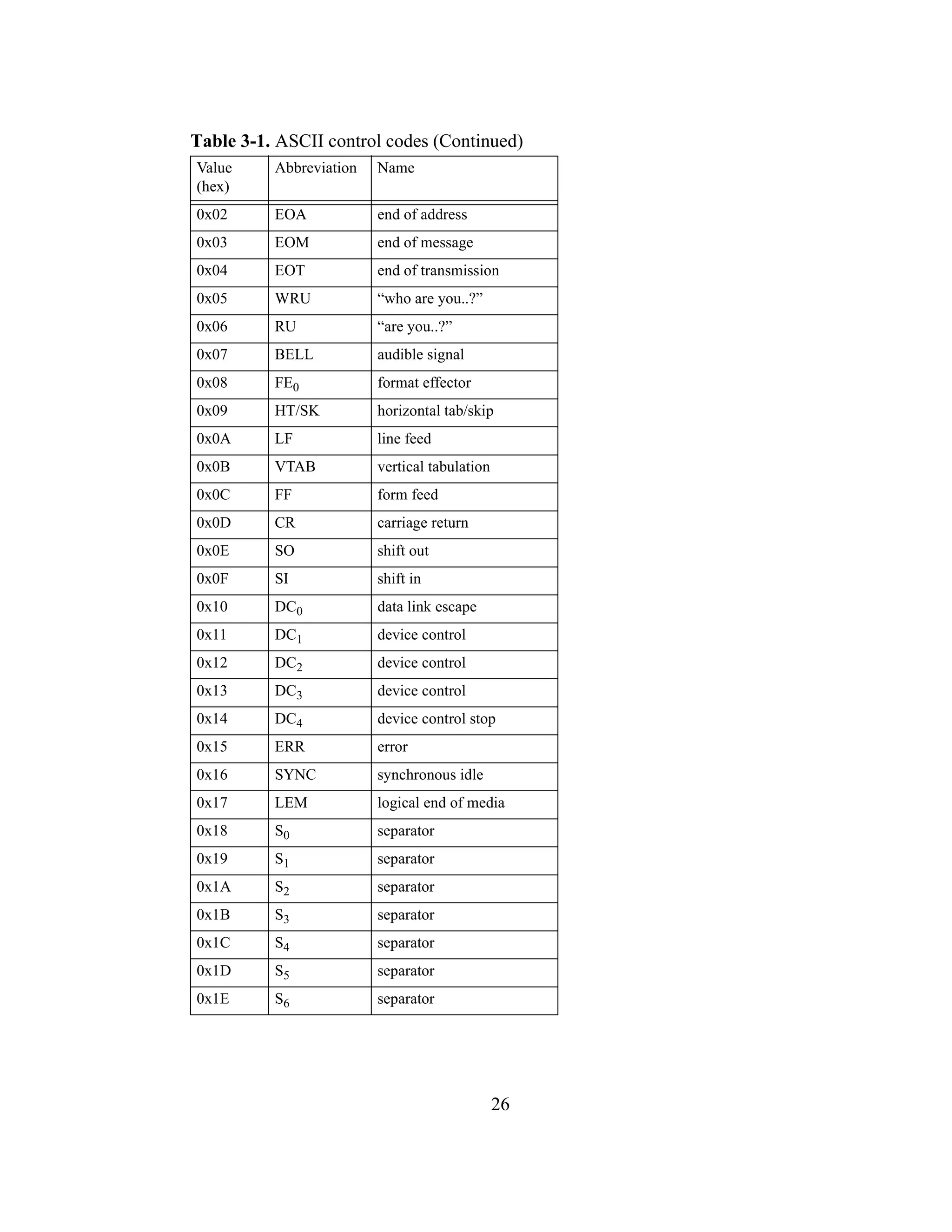
![27
3.3.1 ISO 7-bit Character Encodings
Naturally, the number of languages that can be represented in ASCII is quite
limited. Only English, Hawaiian, Indonesian, Swahili, Latin and some Native Amer-
ican languages can be represented. Even though ASCII is capable of representing
English, ASCII at its core is uniquely American. For example, ASCII includes the
dollar sign “$”, but no other currency symbol. So while British users can still use
ASCII, they have no way of representing their currency symbol, the sterling “£”.
[75],[104]
Seeing a need for representing other languages system vendors created vari-
ations on ASCII that included characters unique to specific languages. These varia-
tions are standardized in ISO-646. ISO-646 defines rules for encoding graphic
characters in the hex range 0x20-0x7E. See Figure 3-1. Standards bodies then apply
the rules to create language/script specific versions of ISO-646 sets. The ISO-646
standard defines one specific version that it calls the IRV (International Reference
Version), which is the same as ASCII. [75],[46]
In ISO-646 a specific set of characters are guaranteed to be in every lan-
guage/script specific version of ISO-646. These characters are referred to as the
invariant characters. The invariant characters include most of the ASCII characters.
Nevertheless, ISO also defines a set of characters that it calls variant characters.
0x1F S7 separator
0x7F DEL delete/idle
Table 3-1. ASCII control codes (Continued)
Value
(hex)
Abbreviation Name](https://image.slidesharecdn.com/0f3c79e3-c95a-412c-8137-2676e0a933c3-161215183642/75/cs-2002-01-41-2048.jpg)
![28
Variant characters may be replaced by other characters that are needed for specific
languages/scripts. See Table 3-2. [75],[46]
There is no requirement that the variant characters be replaced in any of the
language/script specific versions of ISO-646. For example, the French version of
ISO-646 does not replace the circumflex “^” and the dollar sign “$”. See Table 3-3.
Unfortunately, French ISO-646 is still not capable of representing all of French in
spite of these changes. In French all vowels can take circumflexes, however there is
not enough room to represent them in ISO-646, hence the need for 8-bit encodings.
[75], [46]
Table 3-2. ISO variant characters
Value
(hex)
Character Name
0x23 # number sign
0x24 $ dollar sign
0x40 @ commercial at
0x5B [ left square bracket
0x5C backslash
0x5D ] right square bracket
0x5E ^ circumflex
0x60 ` grave accent
0x7B { left curly bracket
0x7C | vertical bar
0x7D } right curly bracket
0x7E ~ tilde
Table 3-3. French version of ISO-646
Value
(hex)
Character Name
0x23 £ sterling
0x24 $ dollar sign
0x40 à a with grave](https://image.slidesharecdn.com/0f3c79e3-c95a-412c-8137-2676e0a933c3-161215183642/75/cs-2002-01-42-2048.jpg)
![29
3.3.2 ISO 8-bit Character Encodings
Around the late 1980s, the European Computer Manufacturers Association
(ECMA) began creating and, with ISO, issuing standards for encoding European
scripts based on an 8-bit code point. These standards have been adopted by most
major hardware and software vendors. Such companies include IBM, Microsoft, and
DEC [50]. The most popular and widely used of these encodings is ISO-8859-1, com-
monly known as Latin 1. [27],[104],[47]
The ISO-8859-1 encoding contains the characters necessary to encode the
Western European and Scandinavian languages. See Figure 3-2 [44]. ISO-8859-1 is
just one of many ISO-8859-x character encodings. Most of the ISO-8859-x encod-
ings existed as national or regional standards before ISO adopted them. Each of the
ISO-8859-x encodings have some common characteristics. Moreover, all of them
function as both coded character sets and character encoding schemes.
[26],[104],[47]
The ISO-8859-x encoding is divided into four sections. See Table 3-4. In
each ISO-8859 encoding the first 128 positions are the same as ASCII. However,
unlike ASCII the ISO-8859-x encodings rely on an 8-bit code point. Characters that
0x5B ° ring above
0x5C ç c with cedilla
0x5D § section sign
0x5E ^ circumflex
0x60 µ micro sign
0x7B é e with acute
0x7C ù u with grave
0x7D è e with grave
0x7E ¨ diaeresis
Table 3-3. French version of ISO-646 (Continued)
Value
(hex)
Character Name](https://image.slidesharecdn.com/0f3c79e3-c95a-412c-8137-2676e0a933c3-161215183642/75/cs-2002-01-43-2048.jpg)

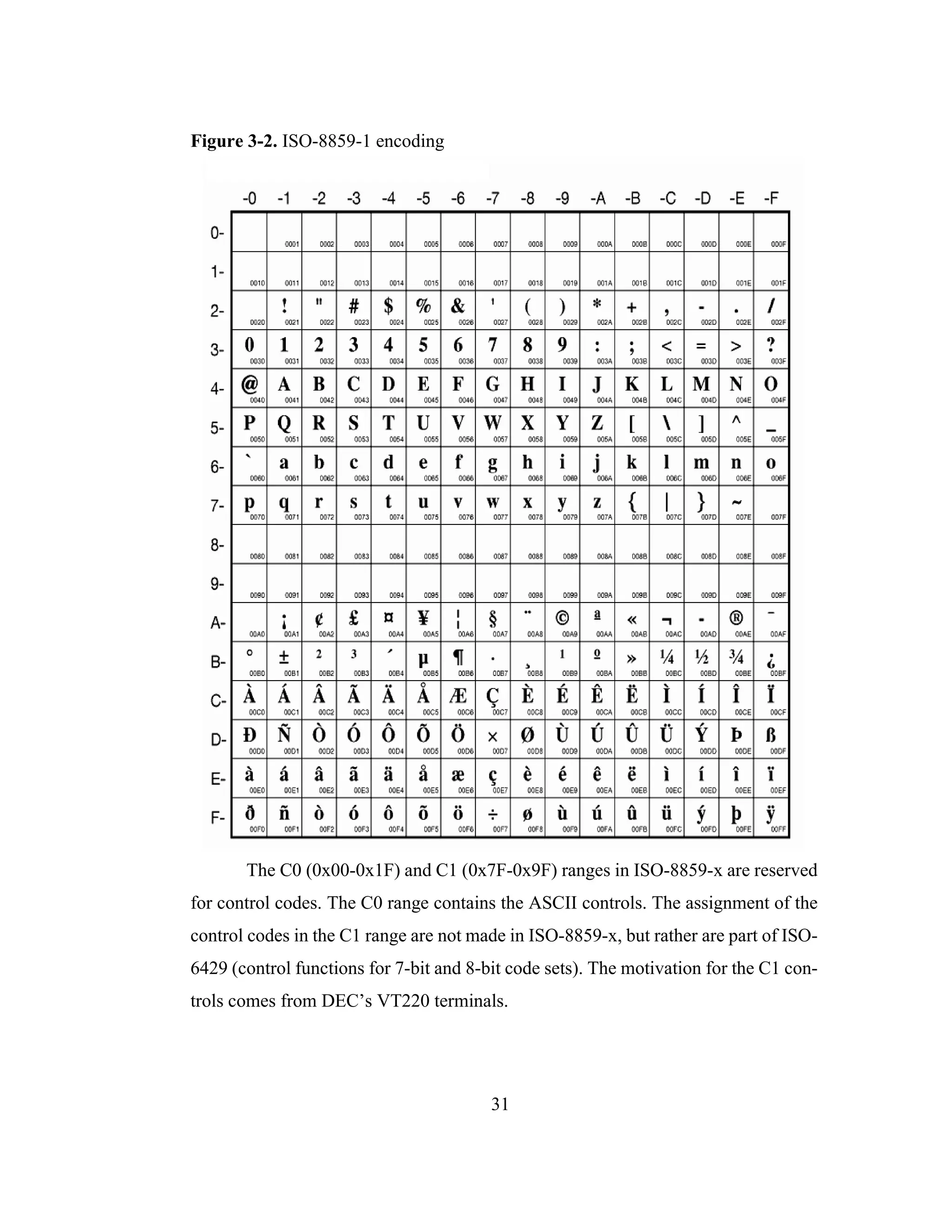
![32
Not all of the upper ranges G1 (0xA0-0xFF) of the ISO-8859-x standards are
based on Latin characters. For example, ISO-8859-7 has Greek characters in the
upper range. See Figure 3-3. The scripts/languages that the ISO-8859-x standards
support is summarized in Table 3-5.[11],[75],[104]
Figure 3-3. ISO-8859-7 encoding](https://image.slidesharecdn.com/0f3c79e3-c95a-412c-8137-2676e0a933c3-161215183642/75/cs-2002-01-46-2048.jpg)
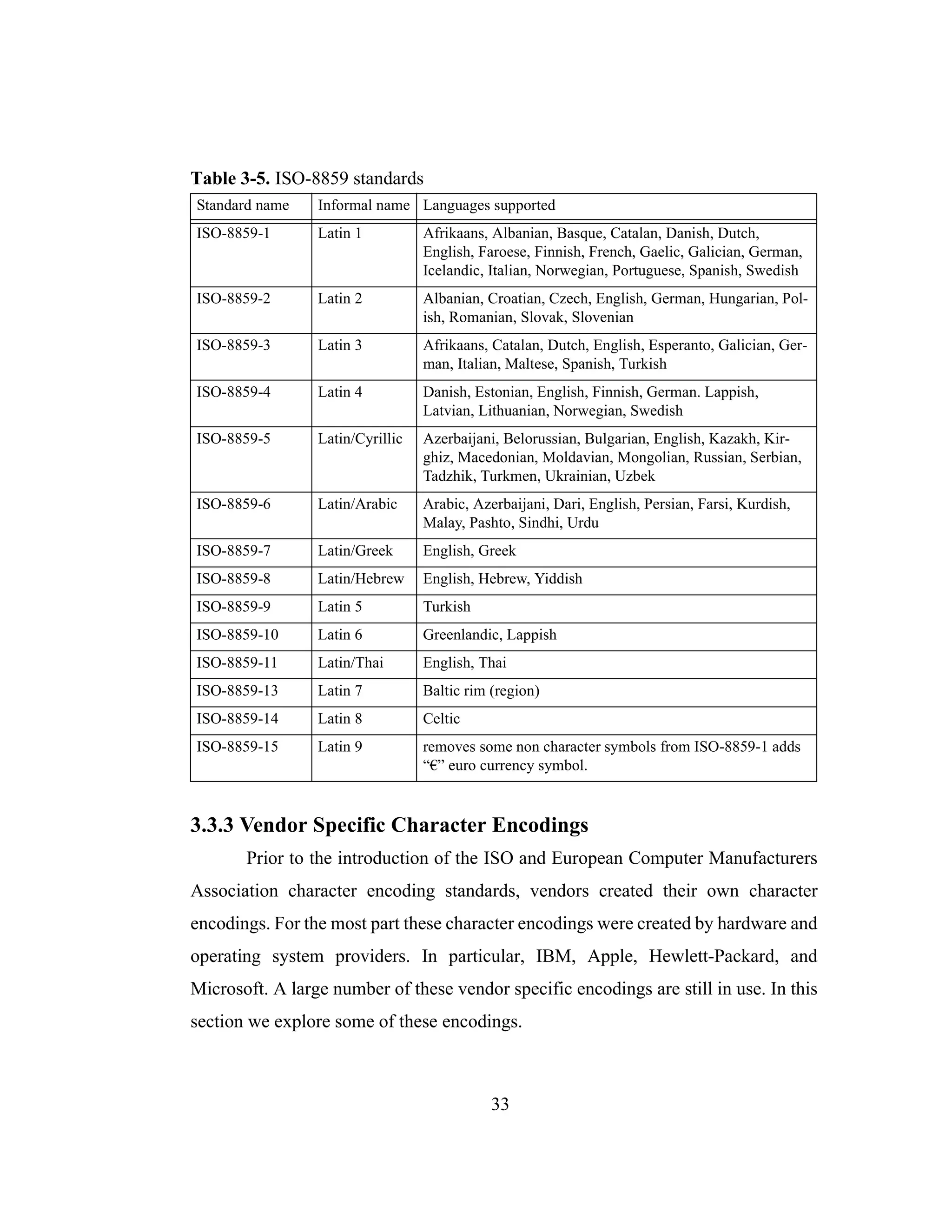
![34
IBM has a number of code pages for its mainframe series of computers that
are based upon EBCDIC (Extended Binary Coded Decimal Interchange Code). The
IBM EBCDIC series of code pages use an 8-bit code point. In EBCDIC the number
and type of printable characters are the same as ASCII, but the organization of
EBCDIC differs greatly from ASCII. See Table 3-6 and Figure 3-4. [40],[57]
Table 3-6. EBCDIC layout
EBCDIC code point range (hex) ASCII code point range (hex) Characters
0x00-0x3F 0x00-0x1F controls
0x40 0x20 space
0x41-0xF9 0x20-0x7E graphic characters
0xFA-0xFE N/A undefined
0xFF N/A control](https://image.slidesharecdn.com/0f3c79e3-c95a-412c-8137-2676e0a933c3-161215183642/75/cs-2002-01-48-2048.jpg)
![35
Figure 3-4. EBCDIC encoding
IBM also has a wide variety of IBM PC based code pages, sometimes referred
to as DOS code pages. See Table 3-7 [35]. These code pages are also based upon an
8-bit code point. However, unlike EBCDIC, PC code pages are based upon ASCII.
In particular, the hex range 0x00-0x7F is in direct correspondence with ASCII. For
the most part the PC code pages are quite similar to the ISO-8859-x series. There are,
however differences that are worth noting. For example, the IBM 850 PC code page](https://image.slidesharecdn.com/0f3c79e3-c95a-412c-8137-2676e0a933c3-161215183642/75/cs-2002-01-49-2048.jpg)
![36
is quite similar to Latin 1, however IBM 850 assigns graphic characters to the 0x80-
0xFF hex range, while ISO-8859-1 assigns control characters to the 0x80-0x9F hex
range. Additionally, IBM 850 contains a small set of graphic box characters that are
used for drawing primitive graphics. See Figure 3-5. [75]
Table 3-7. IBM PC code pages
Code page number Language group
437 English, French, German, Italian, Dutch
850 Western Europe, Americas, Oceania
852 Eastern Europe using Roman letters
855 Eastern Europe using Cyrillic letters
857 Western Europe and Turkish
861 Icelandic
863 Canadian-French
865 Nordic
866 Russian
869 Greek](https://image.slidesharecdn.com/0f3c79e3-c95a-412c-8137-2676e0a933c3-161215183642/75/cs-2002-01-50-2048.jpg)
![37
Figure 3-5. IBM 850
In a similar fashion Microsoft has also created a series of code pages for use
within Microsoft Windows. See Table 3-8 [35]. The Windows code pages are also](https://image.slidesharecdn.com/0f3c79e3-c95a-412c-8137-2676e0a933c3-161215183642/75/cs-2002-01-51-2048.jpg)
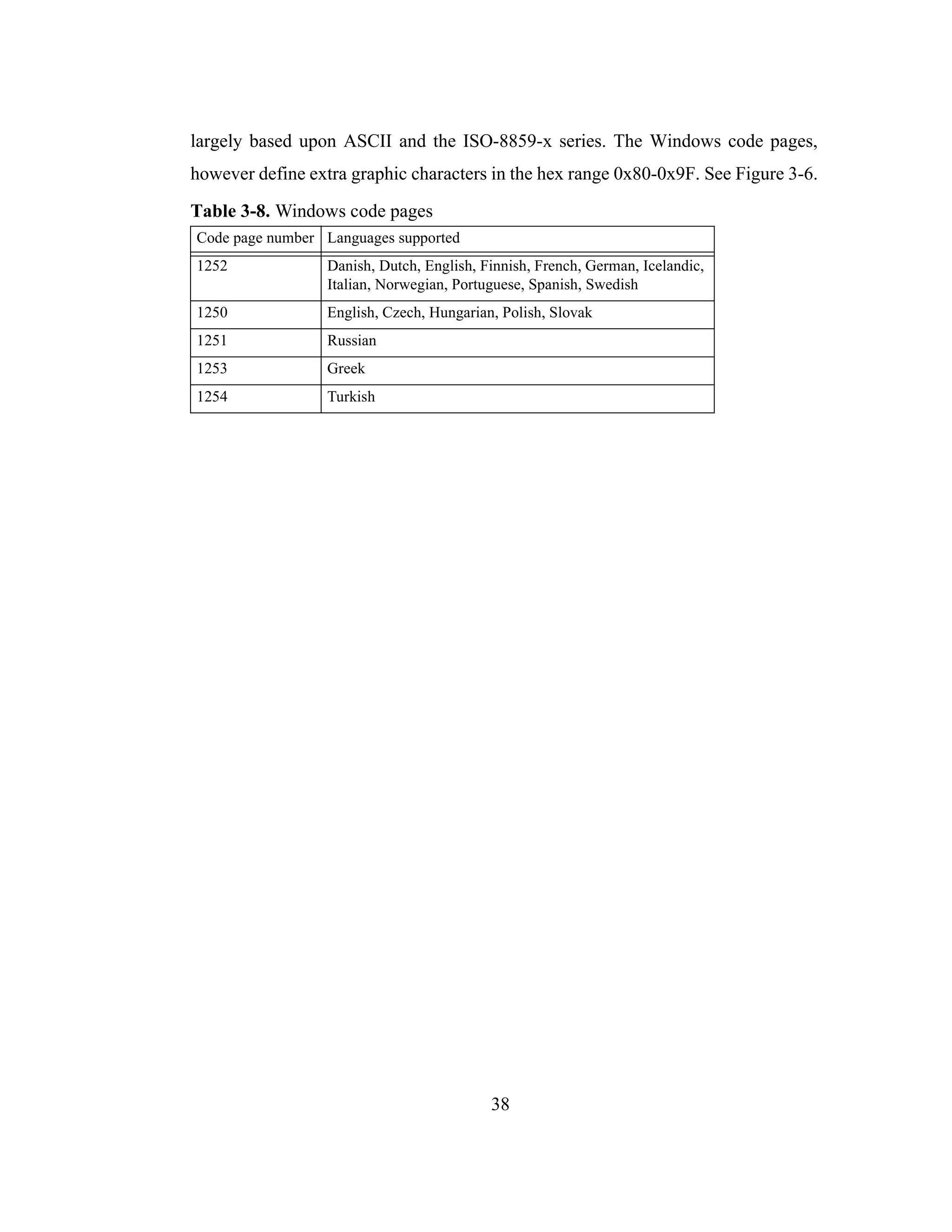
![39
Figure 3-6. Windows 1252
Hewlett-Packard has also codified a set of 8-bit code pages that are very much
akin to the ISO-8859-x series. In particular, Hewlett-Packard’s ROMAN8. In
ROMAN8 the hex range 0x00-0x7F is in direct correspondence with ASCII.
ROMAN8 provides some additional characters that are not in ISO-8859-1. Neverthe-
less, ROMAN8 does not have some characters that are in ISO-8859-1. For example,
the “©” copyright sign is present in ISO-8859-1, but not in ROMAN8. [63],[75]](https://image.slidesharecdn.com/0f3c79e3-c95a-412c-8137-2676e0a933c3-161215183642/75/cs-2002-01-53-2048.jpg)
![40
3.4 Japanese Encodings
Languages like Japanese, Chinese, and Korean have extensive writing sys-
tems that are based on both phonetic and ideographic characters. These systems
require more than 8-bits per character, because they contain literally thousands of
characters. In this section we describe the encoding methods used in Japan. We
choose to use Japanese for two reasons: First, Japan was the first country to encode
a large character set. Second, the Chinese and Korean encodings are largely based
upon the methods used in the Japanese encodings. [57]
The Japanese writing system is comprised from four different script systems:
Chinese ideographic characters (symbols that represent ideas or things, known as
Kanji in Japan), Katakana (syllabary used for writing borrowed words from other
languages), Hiragana (syllabary used for writing grammatical words and inflectional
endings), and Romaji (Latin letters used for non Japanese words). The Kanji script
used in Japan includes about 7,000 characters. The Katakana and Hiragana scripts
both represent the same set of 108 syllabic characters, and are collectively known as
Kana. A sampling of Kanji, Katakana, and Hiragana characters are shown in
Figure 3-7, Figure 3-8, and Figure 3-9. [57],[73],[96],[109]
Figure 3-7. Japanese Kanji characters](https://image.slidesharecdn.com/0f3c79e3-c95a-412c-8137-2676e0a933c3-161215183642/75/cs-2002-01-54-2048.jpg)
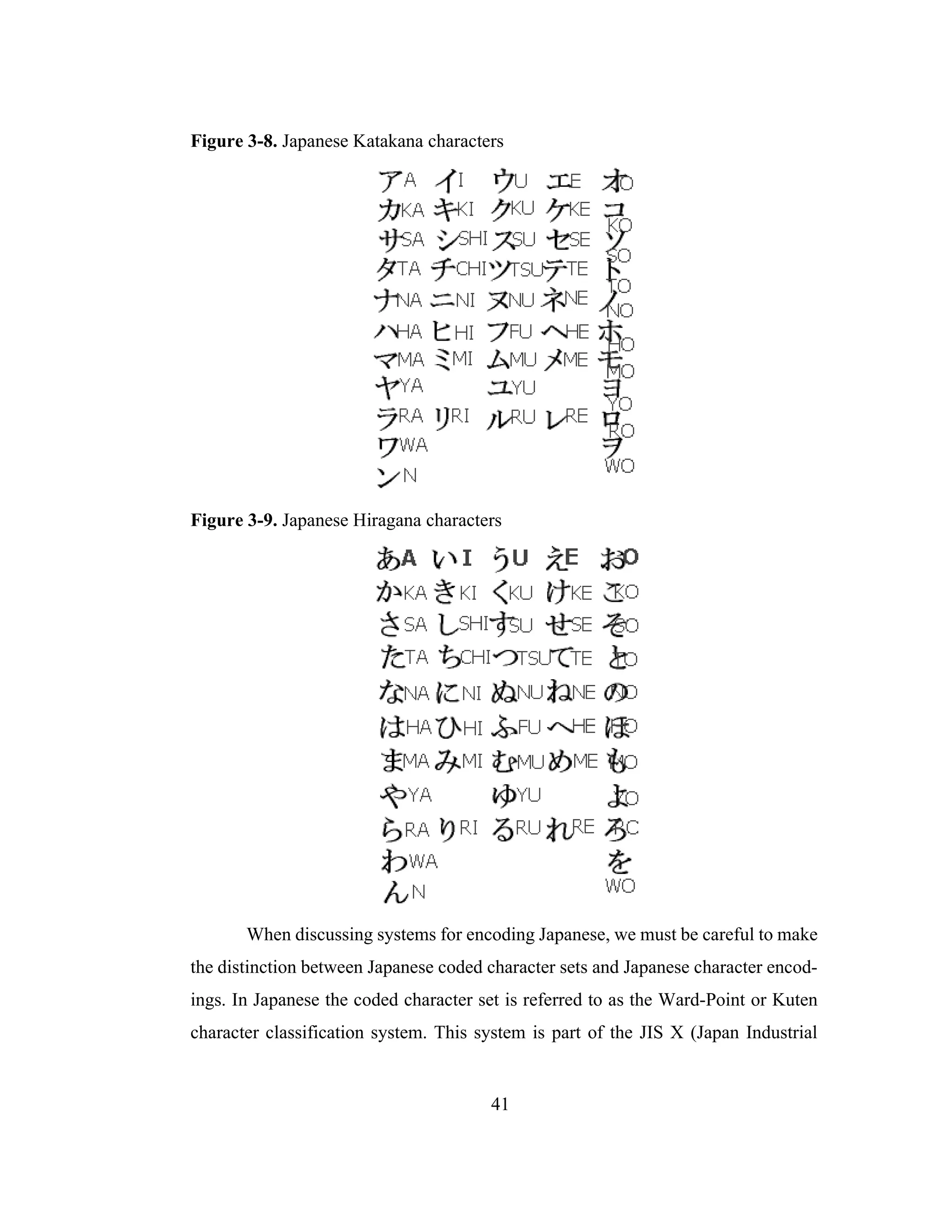
![42
Standard) published by the Japanese Standards Association. Using the Ward-Point
system requires knowledge of spoken and written Kanji. The system uses a two code
system for character identification. The two codes are commonly known as row and
cell and are represented using two bytes. [86]
Using a single byte 128 positions can be referenced. Nevertheless, the Japa-
nese only use the 94 printable ASCII characters. Therefore, in the Ward-Point sys-
tem, Kanji characters are arranged in groups of 94 characters. Each character is
assigned two values, a row number and a cell number. These values identify the char-
acter’s position within JIS. The row and cell numbers range from 1 to 94. Therefore,
JIS can be thought of as 94x94 character matrix. This allows 8,836 characters to be
represented. This coded character set scheme was first formalized in 1978 and is
known as JIS X 0208. [86]
In Japanese characters may be read in one of two ways, On and Kun. On is a
reading that is based on a Chinese pronunciation, while Kun is a reading based on a
Japanese pronunciation. Radicals in Japanese represent core components of Kanji
characters. These radicals are indicative of a group of Kanji characters. [86]
In the Ward-Point system characters are grouped according to their reading
and their radical makeup. Additionally, JIS specifies three levels of character group-
ings. Level 0 contains non-Kanji characters, while levels 1 and 2 are used exclusively
for Kanji characters. Level 1 contains the 2,965 most frequently occurring characters,
while level 2 contains an additional 3,388 characters. [86],[105]
The Japanese Standards Association has continually revised JIS adding,
removing and rearranging characters. Besides the Kanji characters, JIS also encodes
the Latin, Greek, and Cyrillic alphabets, because of business needs. The various JIS](https://image.slidesharecdn.com/0f3c79e3-c95a-412c-8137-2676e0a933c3-161215183642/75/cs-2002-01-56-2048.jpg)
![43
standards along with the characters that they each encode is summarized in Table 3-
9. [58],[86]
As we mentioned earlier the Japanese coded character sets are independent
from the method used to encode them. In the next section we examine the four meth-
ods (Personal Computer, Extended Unix Code, Host, and Internet Exchange) used for
encoding Japanese. The main difference between these encoding methods is in the
way in which they switch between single byte character sets (SBCS) and double byte
character sets (DBCS).
3.4.1 Personal Computer Encoding Method
The Personal Computer (PC) encoding method is a non-modal system. In a
non-modal encoding the code point value of a character is used to switch between
SBCS (ASCII characters) and DBCS (JIS Kanji). This encoding system is generally
referred to as shift-JIS (SJIS), because the Kanji characters shift around the SBCS
characters. In the SJIS encoding system DBCS mode is initiated when the code point
value of the first character of a two byte sequence falls within a predefined range
above hex 0x7F. Generally the range is hex 0x81-0xFF or 0xA1-0xFE. If a character
falls in the two byte range, then the character is treated as the first half of a two byte
sequence, otherwise the character is treated as a single byte sequence. See Figure 3-
10. The code page illustrated in Figure 3-11 represents JIS X0212 in this code page
Table 3-9. JIS character standards
Standard name Year adopted Number of characters Characters
JIS X0201-1976 1976 128 Latin, Katakana
JIS X0208-1978 1978 6,879 Kanji, Kana, Latin, Greek, Cyrillic
JIS X0208-1983 1983 6,974 Kanji, Kana, Latin, Greek, Cyrillic
JIS X0208-1990 1990 6,976 Kanji, Kana, Latin, Greek, Cyrillic
JIS X0212-1990 1990 6,067 Kanji, Greek with diacritics, Eastern
Europe, Latin
JIS X0213-2000 2000 4,344 Kanji, Kana, Latin, Greek, Cyrillic](https://image.slidesharecdn.com/0f3c79e3-c95a-412c-8137-2676e0a933c3-161215183642/75/cs-2002-01-57-2048.jpg)
![44
there are two double byte ranges hex 0x81-0x9F and hex 0xE0-0xFC. Additionally,
in JIS X0212 the Katakana characters are encoded as single byte sequences. See
Figure 3-11 hex range 0xA1-0xDF. [43],[86]
Figure 3-10. Mixed DBCS and SBCS characters](https://image.slidesharecdn.com/0f3c79e3-c95a-412c-8137-2676e0a933c3-161215183642/75/cs-2002-01-58-2048.jpg)

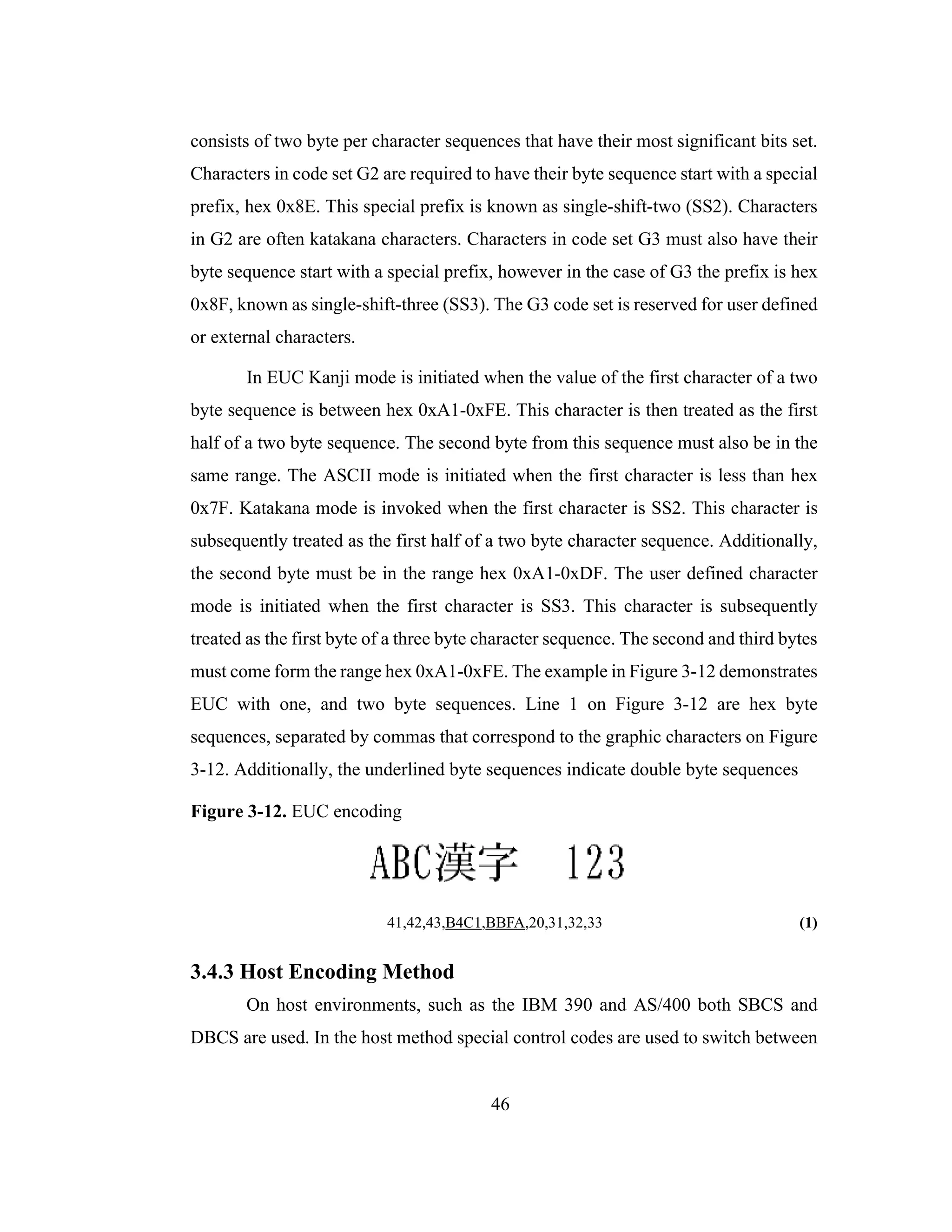
![47
SBCS mode and DBCS mode. To switch into DBCS mode the shift-in (0x0E) control
is used, while the shift-out (0x0F) control is used to switch back to SBCS mode.
Unlike the PC encoding method the values of the characters themselves are not used
to determine the mode, therefore the host method is a modal encoding system. On
host systems SBCS is based on EBCDIC, while DBCS is based on JIS. [43]
3.4.4 Internet Exchange Method
The internet exchange method, commonly known as ISO-2022 is a 7-bit/8-bit
encoding method that enables character data to be passed through older systems. In
some legacy systems the high order bit of an 8-bit byte gets stripped off, causing cor-
ruption of 8-bit character data. Therefore, all bytes in ISO-2022 must be in the hex
range 0x21-0x7E (printable ASCII). Generally, ISO-2022 is never used as an internal
character encoding. Nevertheless, Emacs processes character data in the ISO-2022
encoding [88]. The use of the term ISO-2022, however is somewhat misleading,
because ISO-2022 does not really specify character encodings, but rather an architec-
ture for intermixing coded character sets. The actual individual encodings are speci-
fied in RFCs. [104]
In ISO-2022 escape sequences and shift states are used to switch between
coded character sets. Therefore, ISO-2022 is a modal encoding system. ISO-2022
reserves the hex range 0x00-0x1F for 32 control codes and refers to this range as the
C0 block. This is the same as the ISO-8859 standard. Additionally, another set of 32
controls are also reserved, designated as C1. These controls may be represented with
escape sequences. The hex range 0x20-0x7F is reserved for up to four sets of graphic
characters, designated G0-G3 (in some graphic sets, each character may require mul-
tiple bytes). Most graphic sets only use the hex range 0x21-0x7E, in which case 0x20
(space), and 0x7F (delete) are reserved. Typically, the C0 and C1 blocks are taken
from ISO-6429. See Table 3-1. The G0 block is generally taken from ISO-646 (Inter-
national Reference Version). See Figure 3-1. In ISO-2022 an escape sequence starts](https://image.slidesharecdn.com/0f3c79e3-c95a-412c-8137-2676e0a933c3-161215183642/75/cs-2002-01-61-2048.jpg)
![48
with an ESC control character (0x1B). The bytes following the ESC are a set of fixed
values that are defined by the ISO-2022 standard. [24]
In many cases a single stream of characters can be encoded in more than one
way in ISO-2022. For example, the mixed ASCII Greek character stream on line 1
on Figure 3-13 can be represented by switching graphic character sets or by escaping
individual characters. Line 2 is the corresponding 7-bit byte sequence for the charac-
ters on line 1. The double underlined characters on line 2 indicate escape sequences.
By default ISO-2022 sets the G0 graphic character set to ASCII. Escape sequences
are used to switch character sets. The first escape sequence “1B,2C,46” on line 2
switches the G0 graphic character set to 7-bit Greek, while the second escape
sequence “1B,28,42” switches G0 back to ASCII. Line 3 is the corresponding 8-bit
byte sequence for the characters on line 1. The double underlined characters on line
3 indicate an escape sequence, while the single underlined characters “8E” indicate a
single-shift-two (SS2). The escape sequence “1B,2E,46” on line 3 assigns the 8-bit
Greek character set to the G2 graphic character set, while the SS2 character signals a
temporary switch into the G2 character set.
Figure 3-13. ISO-2022 encoding
(1)
47,72,65,65,6B,20,1B,2C,46,45,6B,6B,67,6D,69,6A,6C,1B,28,42 (2)
47,72,65,65,6B,20,1B,2E,46,8E,C5,8E,EB,8E,EB,8E,E7,8E,ED,8E,E9,8E,EA,8E,DC (3)
In the case of ISO-2022-JP (Japanese encoding of ISO-2022), a Kanji-in
escape sequence directs the bytes that follow to be treated as two bytes per character.
The first byte of the two byte sequence determines the character grouping, while the
second byte indicates the character within the grouping. A JIS out or Kanji out escape
sequence directs the bytes that follow to be treated as single byte characters. The
escape sequences for ISO-2022-JP are specified in Table 3-10. The example, on
Greek Ελληνικά](https://image.slidesharecdn.com/0f3c79e3-c95a-412c-8137-2676e0a933c3-161215183642/75/cs-2002-01-62-2048.jpg)
![49
Figure 3-14 illustrates how the characters from Figure 3-12 would be represented in
ISO-2022-JP. Line 1 are hex byte sequences that correspond to the graphic characters
on Figure 3-14. Double underlined bytes represent escape sequences, while under-
lined bytes indicate double byte character sequences. [86],[104]
Figure 3-14. ISO-2022-JP encoding
41,42,43,1B,24,42,3441,3B7A,1B,28,42,20,31,32.33 (1)
3.4.5 Vendor Specific Encodings
IBM, Microsoft, Apple, and DEC have provided a wide variety of Japanese
character encodings for use within their respective platforms and operating systems.
Unfortunately, in many cases these encodings are incompatible across vendors. Nat-
urally, as national/international standards emerged some migration path from legacy
encodings to standardized encodings became necessary. To satisfy this need vendors
have created/modified encodings. In almost all cases these encodings are variations
or super sets of existing encodings, although differences do exist. Some of the more
frequently occurring encodings are listed on Table 3-11. [52],[42],[43]
Table 3-10. ISO-2022-JP escape sequences
Escape sequence (hex) Escape sequence (graphic) Coded character set
0x1B,0x28,0x42 ESC ( B ASCII
0x1B,0x28,0x4A ESC ( J JIS X0201 (Roman)
0x1B,0x24,0x40 ESC $ @ JIS X0208-1978
0x1B,0x24,0x42 ESC $ B JIS X0208-1983
Table 3-11. Vendor encodings
Vendor Code page Based on
IBM 952 DBCS EUC JISX0208-1997
IBM 953 DBCS EUC JISX0212-1990](https://image.slidesharecdn.com/0f3c79e3-c95a-412c-8137-2676e0a933c3-161215183642/75/cs-2002-01-63-2048.jpg)
![50
3.5 Chinese Encodings
The traditional Chinese writing system is not a phonemic system. In Phone-
mic systems sound is represented as units that are in a one-to-one correspondence
with symbols. For example, a Latin based language, can be written with only 26
unique letters. On the other hand, Chinese requires thousands of unique symbols
(ideographic characters, known as Hanzi in China) to express itself. Moreover, it is
difficult to determine just how many characters exist today. One of the classic Chi-
nese dictionaries lists about 50,000 Hanzi characters, of which only 2,000-3,000 are
in general use. [93]
In general Chinese Hanzi characters are difficult to write and print due to the
large number of strokes in each character. Hanzi characters vary from one to over 30
strokes. Typically, each character requires seven to 17 strokes. The practical disad-
vantages of such a system when compared to an alphabet are obvious. [93]
Over time, however the Chinese script has taken on certain phonetic proper-
ties. In some cases, identical sounding but semantically remote characters would loan
their shapes to indicate the sound of a character. Additionally, the Chinese script and
language have been in a continuos state of flux. In particular, since the revolution of
1949 the Chinese government (Peoples Republic of China) has actively pursued sim-
plification of the Chinese script. [93]
In 1954 a committee was formed to reform the language. This committee sim-
plified nearly 2,200 Hanzi characters. In some cases the radicals (base shape of a
IBM 932/942 MBCS PC JIS X0208-1978
IBM 943 MBCS PC JIS X0208-1990
Microsoft MS 932 MBCS PC JIS X0208-1990
HP HP EUC DBCS EUC JIS X0212-1990
DEC DEC Kanji ISO-2022-JP JIS X0208-1983
Table 3-11. Vendor encodings (Continued)
Vendor Code page Based on](https://image.slidesharecdn.com/0f3c79e3-c95a-412c-8137-2676e0a933c3-161215183642/75/cs-2002-01-64-2048.jpg)
![51
Chinese Hanzi character) changed, while in others the number of strokes changed.
This simplification, however caused havoc in dictionaries, because Chinese dictio-
naries are organized by radical and stroke. Some scholars believe that the simplifica-
tion process has only made the Chinese script more difficult to understand.
Specifically, the reduction in the number of strokes makes several characters look
alike. While the government of the Peoples Republic of China has continued to pro-
mote this simplification process, it has not been universally accepted however, par-
ticularly in Taiwan and Hong Kong [93]
The Chinese language can also be represented through transliteration. In this
context we refer to transliteration of Chinese into its phonetic equivalent in Latin let-
ters. In general there are two Latin transliteration systems for Chinese, Wade-Giles
and Pinyin. The Wade-Giles system was invented by two british scholars during the
19th century. The Wade-Giles system is only used in Taiwan for representing place
names, street names, and people’s names. In mainland China only Pinyin is used.
[93],[77]
The Pinyin system was created during the Chinese Hanzi simplification pro-
cess. The Pinyin system can be used with or without diacritics. Most systems opt for
using Pinyin without diacritics, because diacritics require special fonts. [93]
In Taiwan the Bopomofo system is used for transliteration. The Bopomofo
system gets its name from the first four Taiwanese phonetic characters. The Bopo-
mofo characters represent consonants and vowels. Moreover, there is a one-to-one
correspondence between Pinyin and Bopomofo. [93],[77]
3.5.1 Peoples Republic of China
As we indicated above Japan was the first country to construct a large coded
character set and encoding. Similarly, China has done the same in their Guojia
Biaozbun (GB) standards; Guojia Biaozbun means National Standard. The Chinese
use the GB 2312-80 standard to manage Hanzi (Simplified Chinese characters),](https://image.slidesharecdn.com/0f3c79e3-c95a-412c-8137-2676e0a933c3-161215183642/75/cs-2002-01-65-2048.jpg)
![52
Bopomofo, Pinyin, Japanese Katakana, Japanese Hiragana, Latin, Greek, and Cyril-
lic in groups of 94x94 character matrices. This 94x94 matrix is the same design
employed in the Japanese standards. The overall structure is similar to JIS, but the
Chinese characters (Hanzi) are placed in different positions. The non-Hanzi charac-
ters are in the same locations as JIS. [104],[48],[105]
Just like JIS, the Hanzi characters are organized into two levels based upon
their frequency of use. Two additional groups for even less frequently used Hanzi
characters have been developed, for a total of three groups of Hanzi characters. Addi-
tionally, GB 2312-80 may be encoded using the PC, EUC, ISO-2022, and Host
encoding methods. [104],[48],[105]
After the construction of the GB 2312-80 standard, the Peoples Republic of
China expressed interest in supporting the efforts of both the Unicode Consortium
and ISO through publishing a Chinese national standard that was code and character
compatible with the evolving ISO-10646/Unicode standard, in particular version 2.1
of the Unicode standard. We delay a detailed discussion of ISO-10646/Unicode until
later. For purposes of discussion we can think of Unicode as a super set of all coded
character sets. [67]
This new Chinese standard was named GB 13000.1-93, which is commonly
known as GB 13000. Whenever ISO/Unicode would change their standard, the Chi-
nese would also update their standard. By adopting this strategy, GB 13000 was able
to include Traditional Chinese Hanzi characters (ideographic characters used in
Taiwan and Hong Kong), because these characters appeared in Unicode. Unfortu-
nately, GB 13000’s character encoding was not compatible with GB 2312-80. In
order to remain compatible with the GB 2312-80 encoding standard a new coded
character set was created that contained all the characters from both GB 13000 and
GB 2312-80, yet used an encoding that was compatible with GB 2312-80. This new
character set is known as Guojia Biaozbun Kuozban (GBK) and also uses groups of](https://image.slidesharecdn.com/0f3c79e3-c95a-412c-8137-2676e0a933c3-161215183642/75/cs-2002-01-66-2048.jpg)
![53
94x94 character matrices. Thus, code and character compatibility between GB 2312-
80 and GBK was ensured while at the same time, remaining synchronized with Uni-
code’s character set. [67],[94]
Prior to the release of the Unicode 3.0 standard, GBK was regarded as the de
facto coded character set and encoding for Mainland China. As the Unicode standard
progressed GBK became full. Finally, when it became time to adopt the new charac-
ters in Unicode 3.0 GBK would have to expand to a three byte per character encod-
ing. Thus, a new coded character set and character encoding was born. This new
encoding is known as GB 18030. GB 18030 is a multi byte encoding (one to four
bytes). The one and two byte portions, however are compatible with GBK. GB 18030
thus creates a one-to-one relationship between parts of GB 18030 and Unicode’s
encoding space. We summarize the various GB standards in Table 3-12.
[59],[67],[84]
3.5.2 Republic of China
Taiwan has developed Chinese National Standard (CNS) 11643, which con-
tains over 48,000 Traditional Chinese characters plus characters from the various
other scripts. CNS 11643 is also organized into groups of 94x94 character matrices.
Nevertheless, CNS 11643 is not the predominant coded character set within Taiwan,
rather BigFive is used. BigFive refers to the five companies that created it. BigFive
Table 3-12. GB standards
Standard name Year adopted Number of characters Characters
GB 2312-80 1981 7,445 Simplified Hanzi,Traditional Hanzi
(some), Pinyin, Bopomofo, Hiragana,
Katakana, Latin, Greek, Cyrillic
GBK 1993 21,886 Simplified Hanzi,Traditional Hanzi
(some), Pinyin, Bopomofo, Hiragana,
Katakana, Latin, Greek, Cyrillic
GB 18030-2000 2000 28,468 Simplified Hanzi,Traditional Hanzi
(some), Pinyin, Bopomofo, Hiragana,
Katakana, Latin, Greek, Cyrillic](https://image.slidesharecdn.com/0f3c79e3-c95a-412c-8137-2676e0a933c3-161215183642/75/cs-2002-01-67-2048.jpg)
![54
is grouped into 94x157 character matrices. BigFive encodes over 13,000 Traditional
Chinese characters plus Latin, Greek, Bopomofo, and other symbols. Fortunately
there are few differences between BigFive and CNS 11643. We summarize the Tai-
wanese standards in Table 3-13. [104]
3.5.3 Hong Kong Special Administrative Region
Historically, computers lacked support for the special characters commonly
used in Hong Kong and in the areas where Cantonese is spoken. Some of the missing
Hanzi characters were of foreign origin, particularly deriving from Japanese. The use
of these characters reflects Hong Kong’s role in the economics of Asia. Neither, the
BigFive, GB 2312-80, or GBK adequately supported the needs of Hong Kong or gen-
eral Cantonese users. [67],[68]
Software vendors created various solutions to providing the missing charac-
ters. Unfortunately, their efforts were uncoordinated resulting in solutions that were
incompatible with each other. Concurrent to this activity the special administrative
government of Hong Kong started developing the “Hong Kong Government Chinese
Character Set”. This informal specification was initially used internally as a govern-
mental standard. Soon after, it became a required feature for general computing sys-
tems within Hong Kong. [67],[68]
In 1999 these special characters were officially published in the “Hong Kong
Supplementary Character Set” (SCS). The SCS contains 4,072 characters, the major-
ity of which are Hanzi. Additionally, the SCS was explicitly designed to fully
Table 3-13. Taiwanese standards
Standard name Year adopted Number of characters Characters
CNS 11643 1992 48,027 Traditional Chinese Hanzi, Bopomofo,
Latin. Greek
BigFive 1984 13,494 Traditional Chinese Hanzi, Bopomofo,
Latin. Greek](https://image.slidesharecdn.com/0f3c79e3-c95a-412c-8137-2676e0a933c3-161215183642/75/cs-2002-01-68-2048.jpg)
![55
preserve the code point organization of BigFive, thus easing the problem of encod-
ing. [67],[68]
3.6 Korean Encodings
Just like Japanese and Chinese, Korean also uses a set of ideographic charac-
ters in its writing system. These ideographic characters are known as Hanja in
Korean. Additionally, Korean also uses a set of phonetic characters, referred to as
Hangul. The Hangul script was created by royal decree in 1443 by a group of schol-
ars. Each Hangul character is a grouping of two to five Hangul letters, known as Jamo
(phonemes). Each Hangul block forms a square cluster representing a syllable in the
Korean language. Jamo can be simple or double consonants and vowels. The modern
Hangul alphabet contains 24 basic Jamo elements (14 consonants and 10 vowels).
Extended letters can be derived by doubling the basic letters. [6],[109]
3.6.1 South Korea
As in the other Asian encodings Korea’s standards (KS) follow a layout sim-
ilar to JIS and GB. However, Cyrillic and Greek characters are not in the same posi-
tions as JIS and GB. In the KSX-1001 (formerly KSC-5601) characters are organized
into 94x94 matrices. KSX-1001 encodes Jamos (Korean letters), Hangul, Hanja,
Katakana, Hiragana, Latin, Greek, Cyrillic, as well as other symbols. Additionally,
Korea also encodes their own version of the ISO-646 standard, replacing hex 0x5C
(backslash) with the Won sign (Korean currency symbol). KSX-1001 can be encoded
using EUC and ISO-2022. [104]
3.6.2 North Korea
The North Korean government has also created a coded character set for
Korean, known as KPS 9566-97. It is constructed in a similar fashion to South
Korea’s KSX-1001. KPS 9566-97 encodes nearly 8,300 characters including: Jamos,](https://image.slidesharecdn.com/0f3c79e3-c95a-412c-8137-2676e0a933c3-161215183642/75/cs-2002-01-69-2048.jpg)
![56
Hangul, Hanja, Latin, Cyrillic, Greek, Hiragana, and Katakana. It can be encoded by
using EUC and ISO-2022. [22]
3.7 Vietnamese Encodings
Vietnamese was first written using the Chinese ideographic characters. This
system was in use by scholars until a few decades ago. In Vietnamese two Chinese
characters were usually combined, one character indicated the meaning, while the
second assisted with pronunciation. This system, chu nom, never gained widespread
adoption and was only used in literature. [92]
Around the 17th century Catholic missionaries arrived in Vietnam and began
to translate prayer books. In doing their translations they developed a new Roman-
ized script. This script is known as quoc ngu. Initially this new script was not met
with mass appeal. Nevertheless, when Vietnam became under French control (1864-
1945) quoc ngu was officially adopted. Thus, in modern Vietnam quoc ngu is used
universally and forms the basis for all Vietnamese computing. [92]
It would appear that modern Vietnamese could easily be incorporated into
one of the Latin based encodings, as Vietnamese is based upon a French model of
Latin characters. Like French an 8-bit encoding scheme should be sufficient for
encoding Vietnamese. Nevertheless, in Vietnamese there are many frequently occur-
ring accented letters. In addition to the alphabetic characters in the IRV (ASCII 0x00-
0x7F), Vietnamese requires an additional 134 combinations of a letter and diacritical
symbols. [92]
Obviously all such combinations can fit within the confines of an 8-bit encod-
ing space. However, it is highly desirable to maintain compatibility with the IRV
range. Requiring such compatibility does not leave enough room in the upper range
(0x80-0xFF) to encode all the necessary diacritic combinations. Some people within
the Vietnamese data processing community have argued that certain rarely used](https://image.slidesharecdn.com/0f3c79e3-c95a-412c-8137-2676e0a933c3-161215183642/75/cs-2002-01-70-2048.jpg)
![57
precomposed Vietnamese characters could be dropped altogether or could be
mapped into the C0 control space (0x00-0x1F). [92]
Until the introduction of Windows 95, no clear encoding standard had
emerged. Microsoft and the Vietnam Committee on Information Technology created
a new code page, known as Microsoft 1258 (CP 1258). CP 1258 can be made com-
patible with Latin 1 by dropping some precomposed characters. There are other com-
peting standards emerging, however. Most notably is the VISCII (Vietnamese
Standard Code for Information Interchange) standard, described in RFC 1456. The
VISCII standard does preserve all the precomposed characters, and is becoming quite
popular. [92]
In addition to the Microsoft and VISCII encoding schemes, there is a conven-
tion for exchanging Vietnamese across 7-bit systems. This 7-bit convention is known
as VIQR (Vietnamese Quoted-Readable), and is described in RFC 1456. VIQR is not
really encoding scheme, but is rather a method for typing, reading, and exchanging
Vietnamese data using ASCII. In VIQR precomposed characters are represented by
the vowel followed by ASCII characters whose appearances resemble those of the
corresponding Vietnamese diacritical marks. [92]
3.8 Multilingual Encodings
So far in our discussion of encoding schemes we have concentrated our
efforts on monolingual encodings. In this section we turn our attention to multilingual
encodings. We start this section with some motivation for the construction of multi-
lingual encodings, later turning our attention to the various strategies for capturing
multilingual data.
3.8.1 Why Are Multilingual Encodings Necessary?
Over the last twenty years the software industry has experienced incredible
growth. Initially, the demand for software was limited to just the United States,](https://image.slidesharecdn.com/0f3c79e3-c95a-412c-8137-2676e0a933c3-161215183642/75/cs-2002-01-71-2048.jpg)
![58
however as cheap computing proliferated this demand has spread the world over. For
the most part the development of software has been restricted to the United States.
Historically, most software development labs would produce an English language
version of a product, subsequently followed by multiple national language versions
(NLV). The construction of these NLVs was generally not done in the United States,
rather it was done by the overseas branch of the development lab or was contracted
out to an independent software vendor (ISV). [29],[20],[85]
Once the source code was delivered to the overseas lab or ISV the source code
would be modified to support the local encoding schemes for the language/country.
Simultaneous to this effort, a lab in the United States would start development on the
next version of the product. Therefore, the various NLVs always lagged behind the
English version of the product. [29],[61],[85] This situation caused several problems:
• Overseas marketing organizations faced a difficult time selling older versions of
products when newer versions were available in the United States.
• It became difficult to provide timely maintenance to a product because a fix
would need to be generated across several source trees.
• In many cases common fixes could not be used across source lines because each
source tree supported a different coded character set and encoding.
• Attempting to later merge support for all encoding schemes across all source
trees dramatically increased both the size and the complexity of the product.
Differences in encoding approaches and text processing make merging
source trees extremely difficult. In some situations merging source trees requires text
processing algorithms to be rewritten. For example, random character access func-
tions may need to be rewritten when a stateful encoding is merged with a stateless
encoding. In a stateful encoding the meaning of a character is dependent on neigh-
boring characters.
In some cases even memory management routines require modification. In
fixed width encoding schemes developers often assume that a byte and a character
are of the same size, or even worse the number of code units in a string represents the](https://image.slidesharecdn.com/0f3c79e3-c95a-412c-8137-2676e0a933c3-161215183642/75/cs-2002-01-72-2048.jpg)
![59
number of characters in the string. These assumptions causes problems for merging
source code based on a fixed width encoding scheme with source code based on a
variable width encoding scheme.
Merging problems may also be caused by differences in encoding philoso-
phies. In some cases entire text processing functions may need to be either removed
or redesigned when source trees are merged. For example, a text searching function
based on abstract characters would have to be redesigned when used with an encod-
ing based on glyphs.
These problems caused the software industry to reach two important conclu-
sions: First, that there was an imperative need to develop a single worldwide coded
character set and encoding that would be required for all software. Second, that all
NLVs of a product must be based on a single common source tree.
3.8.2 Unicode and ISO-10646
In discussing the creation of Unicode, we can not avoid discussing ISO-
10646 as well as the two are intertwined, sharing both a common history and goals.
In the 1980s, text encoding experts from around the world began work on two ini-
tially parallel projects to overcome character encoding obstacles. In 1984 ISO
actively started work on a universal character encoding. ISO placed heavy emphasis
on compatibility with existing ISO standards, in particular ISO-8859. In the spring of
1991 ISO published a draft international standard (DIS) 10646. By that time work on
Unicode was nearing completion, and many in the industry were concerned that there
would be great confusion from two competing standards. In the wake of opposition
to DIS-10646 from several of the ISO national bodies ISO and Unicode were asked
to work together to design a common universal character code standard which came
under the umbrella of Unicode. [16]](https://image.slidesharecdn.com/0f3c79e3-c95a-412c-8137-2676e0a933c3-161215183642/75/cs-2002-01-73-2048.jpg)
![60
3.8.2.1 History of Unicode
The Unicode standard first began at Xerox in 1985. The Xerox team (Huan-
mei Liao, Nelson Ng, Dave Opstad, and Lee Collins) was working on a database to
map the relationships between the identical ideographic characters in the Japanese
and Chinese character sets, and was referred to as Han unification. Around the same
time Apple, and in particular Mark Davis also began development of a universal
character set. [102]
In September of 1987, Joseph Becker from Xerox and Mark Davis from
Apple began discussions on a universal character encoding standard for multilingual
computing. In the summer of 1988 we see the first proposal for a universal character
encoding, which Joseph Becker named Unicode1. By 1989, several people from var-
ious software companies were meeting bimonthly, creating the first full review draft
of the Unicode standard. These discussions lead to the inclusion of all composite
characters from the ISO-8859-x standards and Apple’s Han unification work. In 1991
the Unicode consortium was officially incorporated as a nonprofit organization, and
is known as Unicode Inc. [102],[103]
Urged by public pressure from various industry representatives, the ISO-
10646 and Unicode design groups met in August of 1991. Together these two groups
created a single universal character encoding. Naturally, compromises were made by
both parties. This joint body officially published a standard in 1992, and is known as
Unicode/ISO-10646. [102]
3.8.2.2 Goals of Unicode
The purpose of Unicode is to address the need for a simple and reliable world-
wide text encoding. Unicode is sometimes referred to as “wide-body ASCII”, due to
1. The first detailed description of Unicode can be found in a reprint of Joseph Becker’s classic paper
“Unicode 88”. This reprint was published by the Unicode Consortium in 1988 in celebration of Uni-
code’s ten year anniversary.](https://image.slidesharecdn.com/0f3c79e3-c95a-412c-8137-2676e0a933c3-161215183642/75/cs-2002-01-74-2048.jpg)
![61
its use of 16 bits for encoding characters. Unicode is designed to encode all the major
living languages. Unicode is a fixed width, easy to understand encoding scheme.
Additionally, Unicode can support ready conversion from local or legacy encodings
into Unicode, thereby easing migration. [13]
At its core Unicode can be thought of as an extension of ASCII for two rea-
sons. First, Unicode like ASCII uses a fixed width character code. Second, Unicode
like ASCII enforces a strict one-to-one correspondence with characters and code
points. That is, each individual Unicode code point is an absolute and unambiguous
assignment of a 16-bit integer to a distinct character. Since there are obviously more
than 28 (256) characters in the world, the 8-bit byte in international/multilingual
encodings has become insufficient. The octet equals character strategy is both too
limiting and simplistic. Therefore, the 8-bit byte plays no role in Unicode. Moreover,
the name Unicode was chosen to suggest an encoding that is: unique, unified, and
universal. [13]
3.8.2.3 Unicode’s Principles
The design of Unicode is based upon ten founding principles [13],[32],[103]:
• Fixed width encoding — In Unicode, each character is represented by a single
16-bit code point. Moreover, each character is never encoded more than once.
• Full encoding — In Unicode all code points are assigned, from 0x0000-0xFFFF;
nothing is blocked out.
• Characters vs. glyphs — In Unicode a clear distinction is made between encoding
characters vs. encoding glyphs. Unicode only encodes characters, which are
abstract and express raw content. On the other hand, glyphs are specific visible
graphic forms expressing more than content. This issue is discussed in greater
detail in chapter 5.
• Semantics — In Unicode characters have properties.
• Ideographic unification — Having a clear separation between characters and
glyphs permits unification of the commonly shared ideographic characters in
Chinese, Japanese, and Korean.](https://image.slidesharecdn.com/0f3c79e3-c95a-412c-8137-2676e0a933c3-161215183642/75/cs-2002-01-75-2048.jpg)
![62
• Plain vs. fancy text — A simple but important distinction is made between plain
text which is a pure sequence of Unicode code points, and fancy text, which is
any text structure that bears additional information above the pure code points.
We discuss this issue in chapter 5.
• Logical order — In Unicode characters are stored in the order in which they are
read, which is not necessarily the same order in which they are displayed. The
concept of logical order is examined in chapter 4.
• Dynamic composition — Instead of allowing only the well known accented char-
acters, Unicode allows dynamic composition of accented forms where any base
character plus any combining character can make an accented form. We discuss
dynamic composition in greater detail in chapters 4 and 5.
• Equivalent sequences — In Unicode precomposed characters are semantically
equivalent to their combining counterparts. We spend considerable time discuss-
ing this throughout the rest of the dissertation.
• Convertibility — Round trip conversion between Unicode and legacy encodings
is possible since each character has a unique correspondence with a sequence of
one or more Unicode characters.
Naturally, some of Unicode’s design goals are in direct conflict with one
another. These conflicts have forced Unicode to make compromises from time to
time. However, one important goal Unicode has worked hard at honoring is its ability
to provide round trip conversions. In fact Joseph Becker in 1988 believed that Uni-
code’s initial utility would be as a mechanism for interchange. This was the same
reason why ASCII was constructed. Nevertheless, ASCII has transitioned from being
an interchange mechanism to an outright native encoding. The same can also be said
of Unicode. [13]
3.8.2.4 Differences Between Unicode and ISO-10646
By its nature, ISO-10646 officially known as the Universal Multiple-Octet
Coded Character Set, or simply known as the UCS (Universal Character Set), only
describes the technical details of the UCS encoding. Additionally, Unicode includes
specifications that assist implementers. Unicode defines the semantics of characters
more explicitly than ISO-10646 does. For example, Unicode provides algorithms for
determining the display order of Unicode text. We explore the ordering of Unicode](https://image.slidesharecdn.com/0f3c79e3-c95a-412c-8137-2676e0a933c3-161215183642/75/cs-2002-01-76-2048.jpg)
![63
text streams in the next chapter. Additionally, Unicode provides tables of character
attributes and conversion mappings to other character encodings. Nevertheless, Uni-
code and ISO-10646 are in agreement with respect to the defined characters. That is,
every character encoded in Unicode is also encoded in the same position as in ISO-
10646. [16]
The Unicode standard was initially designed as a 16-bit character encoding
allowing for 65,535 different code points. Unicode is actually comprised of a series
of planes each having 65,535 code points. If you think of the values 0x0000-0xFFFF
as constituting one plane called plane 0, then you could imagine multiple planes each
having 65,535 code points. Unicode refers to plane 0 as the BMP (Basic Multilingual
Plane). On the other hand, ISO-10646 was designed as a 32-bit character encoding,
with the most significant bit always set to 0. In ISO-1046 this 32-bit form is called
UCS-4 (Universal Character Set four octet form), while the 16-bit Unicode form is
called UCS-2 (Universal Character Set two octet form). [32]
Conceptually, the Universal Character Set is divided into 128 three dimen-
sional groups. Each group contains 256 planes containing 256 rows of 256 cells. The
four octets of UCS-4, therefore, represent the group, plane, row, and cell of a code
point in the Universal Character Set. See Figure 3-15 [43]. A UCS-2 code point can
be transformed into a UCS-4 code point by simple zero extension. [32]
Figure 3-15. Forms of UCS-4 and UCS-2
3.8.2.5 Unicode’s Organization
In this section we describe the layout of Unicode version 3.1, the latest ver-
sion of the standard. There are two ways in Unicode to refer to code points. The first](https://image.slidesharecdn.com/0f3c79e3-c95a-412c-8137-2676e0a933c3-161215183642/75/cs-2002-01-77-2048.jpg)
![64
method uses the hexadecimal value of the code point preceded by a capital letter “U”
and plus sign “+”. The second method is the same as the first except the plus sign is
omitted. The Unicode code space is divided up according to Table 3-14. A more
detailed layout is shown on Figure 3-16 [96]. Additionally, the first 256 characters
within the first range of Unicode are in direct agreement with ISO-8859-1, in such a
way that the 8-bit values are extended to 16-bit values by simply using zero exten-
sion. [16],[103]
Table 3-14. Unicode code point sections
Code point range (hex) Description
U0000-U1FFF General scripts
U2000-U2FFF Symbols
U3000-U33FF Chinese, Japanese, Korean miscellaneous characters
U4E00-U9FFF Chinese, Japanese, Korean ideographs
UAC00-UD7A3 Hangul
UD800-UDFFF surrogates
UE000-UF8FF private use
UF900-UFFFF compatibility and special](https://image.slidesharecdn.com/0f3c79e3-c95a-412c-8137-2676e0a933c3-161215183642/75/cs-2002-01-78-2048.jpg)
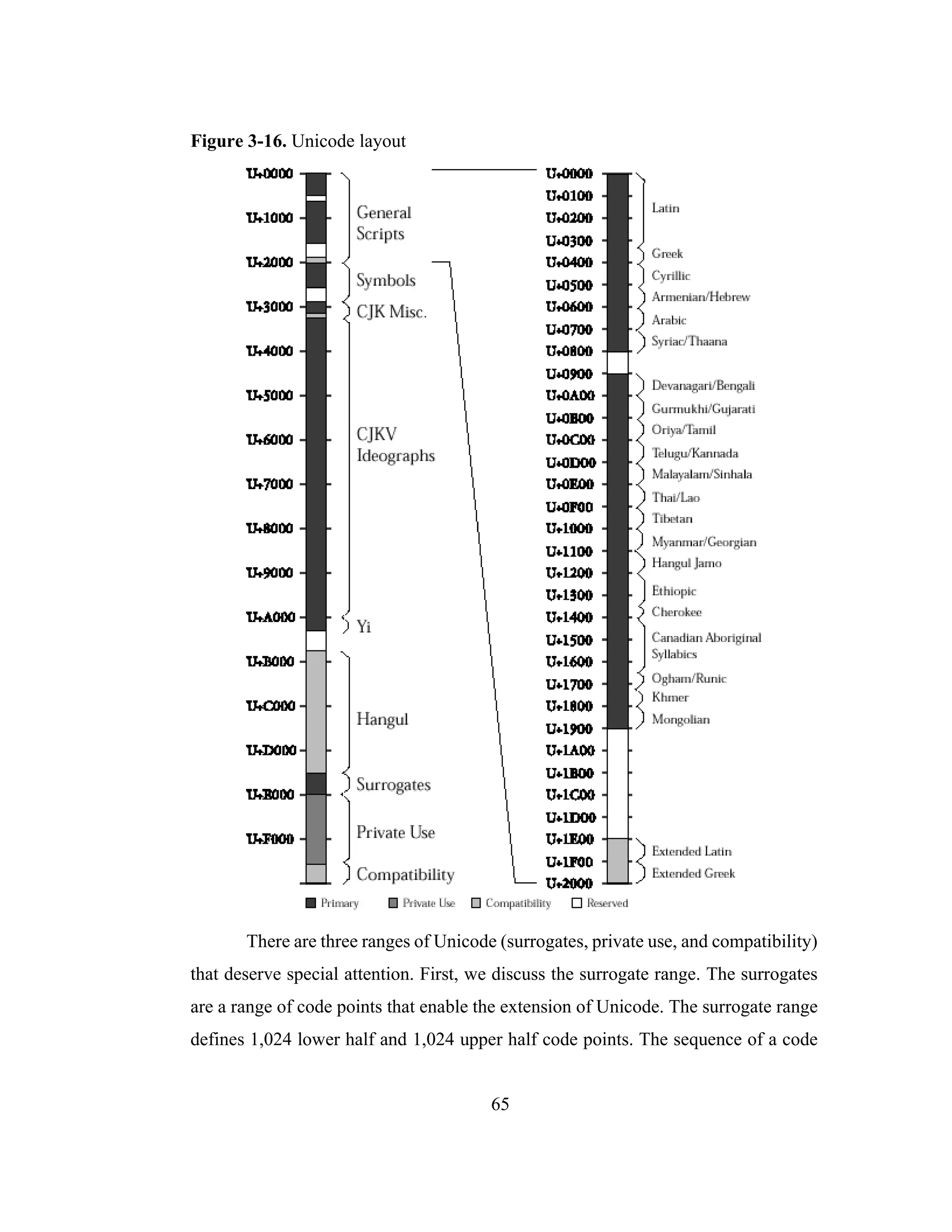
![66
point from the upper half surrogate range followed by a code point from the lower
half surrogate range identifies a character in planes 1-16 according to the algorithm
defined on Figure 3-17. Line 1 on Figure 3-17 takes a surrogate pair H and L (H
stands for upper surrogate, L stands for lower surrogate) and returns a Unicode scalar
value N. Line 2 on Figure 3-17 is the reverse of the algorithm on line 1.
[32],[103],[60]
Figure 3-17. Surrogate conversion
N = (H - 0xD800) * 0x400 + (L - 0xDC00) + 0x10000 (1)
H = (N - 0x10000) / 0x400 + 0xD800, L = (N - 0x10000) % 0x400 + 0xDC00 (2)
Up through Unicode version 3.0 all of Unicode’s characters were defined in
the BMP. However, version 3.1 of the standard is the first version that makes assign-
ments outside the BMP. Unicode 3.1 adds 44,946 new characters and when added to
the existing 49,194 characters, the new total is 94,140 characters. For the most part
the new characters are additional ideographic characters that provide complete cov-
erage of the characters in the Hong Kong supplementary character set, which was dis-
cussed earlier. [60]
The Unicode private use area is a range of Unicode that can be used by private
parties for character definition. This range, for example could be used for the defini-
tion of corporate logos or trademarks. It could also be used for protocol definition
when agreement is made between the interested parties. [32]
As we stated earlier Unicode was envisioned as an interchange encoding. In
order to guarantee that round trip conversion would always be possible Unicode
defined a special block of characters, known as the compatibility range. The compat-
ibility range contains alternative representations of characters from existing stan-
dards. These duplicate characters are defined elsewhere within the standard. The
primary purpose of these duplicates is to enable round trip mapping of Unicode and](https://image.slidesharecdn.com/0f3c79e3-c95a-412c-8137-2676e0a933c3-161215183642/75/cs-2002-01-80-2048.jpg)
![67
the various national standards. Later in the dissertation we will examine several prob-
lems caused by the use of the compatibility range. [32]
3.8.2.6 Unicode Transmission Forms
There are four primary ways in which Unicode and ISO-10646 code points
may be transmitted. Unfortunately, not all of the approaches are equivalent with
respect to the code points that may be transmitted. The UCS-4 encoding is the only
transmission mechanism that is capable of encoding all of the possible characters
defined in ISO-10646. Within the semantics of Unicode, the UTF-32 (Universal
Character Set Transformation Format 32-bit Form) is used to encode UCS-4. The dif-
ference being UTF-32 is restricted to the range 0x0-0x10FFFF which is precisely the
range of code points defined in Unicode, while in UCS-4 all 32-bit values are valid.
[32]
The UCS-2 encoding is capable of representing all of the code points defined
within the BMP. Code points outside of the BMP are not represented, due to the
group and plane numbers being fixed. [32]
The UTF-16 (Universal Character Set Transformation Format for Planes of
Group 0) encoding permits code points defined in planes 0-16 of group 0 to be
directly addressed. This is accomplished by combining individual 16-bit code points
into single ISO-10646 code points using the previously mentioned algorithm on
Figure 3-17. [32]
The UTF-8 (Universal Character Set Transformation 8-bit Form) encoding
allows Unicode and ISO-10646 to be transmitted as a sequence of 8-bit bytes rather
than as 16 or 32-bit units. It is a variable length encoding scheme requiring anywhere
from one to six bytes per code point, however in the case of UTF-32 the max number
of bytes would be limited to four. This is a common and useful transmission format,
because UTF-8’s single-byte form directly corresponds to ASCII. Additionally, it is](https://image.slidesharecdn.com/0f3c79e3-c95a-412c-8137-2676e0a933c3-161215183642/75/cs-2002-01-81-2048.jpg)
![68
safe to use in environments where code points are assumed to always be 8-bits
[32],[43]. See Table 3-15. Converting from UTF-32 proceeds in three steps [110]:
• Determine the number of octets required for the character value by looking in the
first column of Table 3-15.
• Prepare the high order bits of the octets as per the second through fifth columns
in Table 3-15.
• Fill in the bits marked by x from the bits of the character value, starting from the
low order bits putting them first in the last octet of the sequence, then next to last,
and so on until all x bits are filled in.
On Table 3-16 we show how the Unicode code point U1D5A0 (Mathematical
Sans-Serif Capital A) would be represented in the various Unicode transformation
formats.
3.8.3 Criticism of Unicode
For the purposes of introducing the other multilingual encoding schemes we
discuss some of Unicode problems.
Table 3-15. UTF-8
UTF-32 value hex UTF-8 1st byte UTF-8 2nd byte UTF-8 3rd byte UTF-8 4th byte
0000 0000 -
0000 007F
0xxxxxxx
0000 0080 -
0000 07FF
110xxxxx 10xxxxxx
0000 0800 -
0000 FFFF
1110xxxx 10xxxxxx 10xxxxxx
0001 0000 -
001F FFFF
11110xxx 10xxxxxx 10xxxxxx 10xxxxxx
Table 3-16. Unicode transformation formats
Form Byte sequence (hex)
UTF-32 1D5A0
UTF-16 D835,DDA0
UTF-8 F0,9D,96,A0](https://image.slidesharecdn.com/0f3c79e3-c95a-412c-8137-2676e0a933c3-161215183642/75/cs-2002-01-82-2048.jpg)
![69
3.8.3.1 Problems With Character/Glyph Separation
Although Unicode can remedy a large number of problems encountered by
multilingual applications, it also has numerous drawbacks. Some have argued that
Unicode cannot be used as a text encoding system, because of Unicode’s bias
towards the presentation of text. One does not have to search hard to find examples
of such biases. For example, Unicode encodes the fi ligature as a distinct character.
Most text encoding specialists would argue that fi is not a character, but rather is a
glyph. Therefore, the fi glyph has no business being encoded as a character in a text
encoding. In light of Unicode’s orientation towards presentation, some authors have
argued that Unicode should only be used as a glyph encoding. We will illustrate sev-
eral other examples in later chapters, that further support this argument. [36],[74]
3.8.3.2 Problems With Han Unification
As specified, Unicode’s primary purpose is to encode all the major written
scripts of the world, rather than all the worlds written languages. This distinction is
extremely important in Unicode. Nevertheless, most of the world’s encoding systems
actually encode written languages and not scripts. Recently, Unicode has provided a
mechanism, known as surrogates for encoding characters that are specific to certain
written languages. Nevertheless, the vast number of characters that are tied to written
languages, coupled with Unicode’s surrogate gymnastics hardly provide a satisfac-
tory solution. [31]
Currently, Unicode encodes 49,194 characters in its BMP, using the Han uni-
fication process. At first, this seemed more than sufficient, however input from sev-
eral nations (Japan, Mainland China, Taiwan, and Korea) was excluded during the
creation of the BMP. Moreover, these were the groups that had the most characters
to assign. Mainland China has responded by insisting that Unicode encode all of its
official 6,000 characters in addition to the many simplified characters, plus the older
classic set of some 40,000 characters. This alone would occupy nearly the entire
BMP. Taiwan has also responded in a similar fashion, insisting that they have the](https://image.slidesharecdn.com/0f3c79e3-c95a-412c-8137-2676e0a933c3-161215183642/75/cs-2002-01-83-2048.jpg)
![70
rights to their own complete set of classic characters. These Taiwanese characters
represented an additional 50,000 characters, and would not consider using the same
characters encoded by Mainland China. These two groups alone required over 90,000
distinct characters. [31]
The Japanese also said they were entitled to have their own characters
encoded in a distinct range. Naturally, once Korea got wind of these requests, they
also asked for their characters. If each country gets their way this could generate more
than 170,000 characters. In an attempt to satisfy these groups Unicode has created
surrogates. In the latest version of Unicode, 94,140 characters are encoded. This is
still painfully short of the 170,000 characters needed. Obviously, 32 bits would be
more than sufficient, however Unicode does not provide a 32-bit contiguous block.
Clearly, two separate 16-bit blocks do not solve the problem. In order to encode the
required number of characters, Unicode must resort to special encoding forms that
get piggybacked onto Unicode’s 16-bit form, thereby making what would be a simple
problem more complex. [31]
In many cases it is necessary to know which language a stream of characters
represents for data processing operations, particularly sorting, spell checking, and
grammar checking. In Unicode this can be difficult to ascertain, especially if a char-
acter is in the unified Han range. This causes difficulties in creating applications for
a single language, such as natural language processing. It is much easier to create
these applications if all the characters come from a single language block. This fur-
thers the argument for an encoding system that separates character blocks for differ-
ent languages. [74]
3.8.3.3 ISO-8859-1 Compatibility
Unicode is not really compatible with ISO-8859-1. Unicode streams are
sequences of 16-bit code points, while ISO-8859-1 streams are sequences of 8-bit
code points. Unicode’s encoding system does not directly recognize ISO-8859-1](https://image.slidesharecdn.com/0f3c79e3-c95a-412c-8137-2676e0a933c3-161215183642/75/cs-2002-01-84-2048.jpg)
![71
data. Unicode requires that ISO-8859-1 characters be first converted to Unicode by
zero extension. However, to transmit Unicode on the Internet, you have to use the 8-
bit safe Unicode transformation format (UTF-8). In the case of Unicode characters
that fall within in the ISO-8859-1 range the UTF-8 conversion simply removes the
leading zero. [74]
3.8.3.4 Efficiency
Most data are actually in a single language, and most languages can be
encoded using 8-bit code points. Using a 16-bit encoding scheme doubles both the
storage requirements of programs and the transmission time of character data. Com-
pression schemes could be used to help alleviate this, but they are impractical due to
their overhead.
3.8.4 Mudawwar’s Multicode
Multicode is a character encoding system proposed by Muhammad Mudaw-
war from the American University at Cairo in 1997 its goal is to address some of Uni-
code’s drawbacks. Multicode’s most important distinction is its use of multiple coded
character sets. Multicode is not an extension to any coded character set, but rather is
a collection of several coded character sets. In general, most coded character sets
have strong ties to specific written languages. On the other hand, there are some char-
acters that can be viewed as being language neutral, such as mathematical symbols.
To take advantage of this approach, unlike Unicode, Multicode is oriented towards
written languages and not scripts. Each coded character set used in Multicode is
designed to be independent and self sufficient, each having all necessary control
characters, punctuation, and special symbols. [74]
3.8.4.1 Character Sets in Multicode
Instead of attempting to merge all written languages into a single 16-bit coded
character set, Multicode defines separate 8-bit and 16-bit coded character sets. In](https://image.slidesharecdn.com/0f3c79e3-c95a-412c-8137-2676e0a933c3-161215183642/75/cs-2002-01-85-2048.jpg)
![72
Multicode there can be 256 separate coded character sets. Each coded character set
is assigned a unique numeric identifier. In the case of ASCII the identifier is 0. [74]
In Multicode there may be substantial overlap between coded character sets,
however there will be cases where a coded character set has unique characters. For
example, languages based on the Latin script share many common symbols, however
each has some unique letters. It is also possible to use more than one coded character
set for a language. For example, the Azeri language could be written using either
Cyrillic or Latin letters. [74],[111]
Multicode strives to define a unique coded character set for each written lan-
guage, unlike Unicode which merges scripts through a unification processes. Addi-
tionally, Multicode supports the use of more than one coded character set standard
for a given written language, in case different countries use these sets. [74]
3.8.4.2 Character Set Switching in Multicode
In order to support multilingual text, Multicode provides a mechanism for
switching between coded character sets. Multicode defines a special character for this
purpose and that is known as a switch character. In every 8-bit coded character set,
Multicode reserves the last code point 0xFF as the switch character. To switch to a
different coded character set, either 8-bit or 16-bit, a special two byte sequence is
inserted into the text stream. The first byte is the switch character, and the second
byte is a character set designator. For example, to switch from French (assumed to
be coded character set 0x01) to Hindi (assumed to be 0x50) the two byte sequence
0xFF50 would be inserted into the text stream. [74]
In each 16-bit coded character set, Multicode reserves the range 0xFF00-
0xFFFF as switch characters. The first byte of the switch sequence is always 0xFF
and represents the switch character. The second byte of the switch sequence is the
character set designator. Therefore, switching in a 16-bit coded character set is really
the same as switching in a 8-bit character set. See Figure 3-18. In Figure 3-18, File 1](https://image.slidesharecdn.com/0f3c79e3-c95a-412c-8137-2676e0a933c3-161215183642/75/cs-2002-01-86-2048.jpg)
![73
contains a stream of Arabic characters, File 2 contains ASCII and French characters,
while File 3 contains Japanese and ASCII characters. In each case a switch sequence
is used to switch out of Multicode’s default ASCII mode. [74]
Figure 3-18. Character set switching in Multicode
In Multicode, 16-bit coded character sets are only used in cases where a writ-
ten language requires it. Multicode always uses the smallest coded character set for
any given written language. When compared to Unicode, Multicode requires only
half the storage for those written languages that can be represented using 8-bits. [74]
3.8.4.3 Focus on Written Languages
Multicode by design is oriented towards written languages. Each coded char-
acter is designed to encode a particular written language. Furthermore, each coded
character set provides a full set of control codes, thereby eliminating the need to
switch to a special character set for control functions. Additionally, language infor-
mation is implicitly encoded in Multicode via the character set switch sequences. In
Multicode language centric data processing is well defined because there is never any
confusion over which written language a character comes from. [74]](https://image.slidesharecdn.com/0f3c79e3-c95a-412c-8137-2676e0a933c3-161215183642/75/cs-2002-01-87-2048.jpg)
![74
3.8.4.4 ASCII/Unicode Compatibility
Multicode is directly compatible with ASCII. No conversion is necessary to
use ASCII data in Multicode. ASCII is the default coded character set in Multicode;
assigned the character set designator 0x00. Furthermore, Multicode is also compati-
ble with Unicode. Multicode reserves the 0xFF character set designator for this pur-
pose. There is never any misinterpretation of the switch sequence by Unicode,
because 0xFFFF is an invalid Unicode character, hence it must be a switch. [74]
3.8.4.5 Glyph Association in Multicode
In Multicode several characters may share a common glyph, but have differ-
ent code point values. For example, the letter a which appears in both the French and
ASCII coded character sets could be encoded in two different positions. In Multicode
characters would be associated to glyphs using either character set specific fonts or a
single unified font. By using character set specific fonts, font sizes are kept to a min-
imum as glyphs that are unnecessary to the display of a written language are not
included in the font. Additionally, there is a one-to-one mapping between characters
and glyphs. On the other hand, character set specific fonts duplicate glyphs that may
be common across a number of character sets. A unified font would remove this
redundancy, but would require a character to glyph index conversion, because the
property of a one-to-one mapping between characters and glyphs would be lost. Most
notably, Unicode could be used as a unified glyph index. This would allow the use of
TrueType and OpenType fonts as they use Unicode for indexing glyphs. [74]
3.8.5 TRON
TRON (The Real-Time Operating System Nucleus) is an open architecture
that specifies interfaces and design guidelines for operating system kernels. The
TRON Application Databus (TAD) is the standard for ensuring data compatibility
across computers that support the TRON architecture. TAD supports multilingual
data via multiple character sets. TAD provides both a uniform and efficient method](https://image.slidesharecdn.com/0f3c79e3-c95a-412c-8137-2676e0a933c3-161215183642/75/cs-2002-01-88-2048.jpg)
![75
for manipulating character sets. Additionally, applications based on TAD are inde-
pendent of any particular coded character set. [82]
In TAD, language specifier codes are used to switch from one language to
another. Characters in TRON may be single byte, double byte or a combination of the
two. At language boundaries language specifier codes are inserted, so that single byte
and double byte codes can be intermixed within a single text stream. Therefore,
TRON like Multicode always uses the most compact coded character set for a given
written language. [82]
3.8.5.1 TRON Single Byte Character Code
In TRON control codes, character codes, language specifier codes, and
TRON escape codes are all based on a single byte code point. See Figure 3-19. The
control codes in TRON are mostly the same as ASCII’s. Nevertheless, code point
0x20 (ASCII space) is treated as a control code, and is called a separator in TRON.
The separator is used to indicate both word and phrase divisions as opposed to 0xA0
(blank). In TRON the handling of the separator is language specific, but in English
the separator acts as an ASCII space. In other words, the separator is used as a gap
when lines are broken, and it displays a variable width space for use in proportional
spacing. [82]
Figure 3-19. TRON single byte character code
The character codes (0x21-0x7E, 0x80-0x9F, 0xA0, and 0xA1-0xFD) cover
220 characters. The 0xA0 character (blank) is handled as a fixed width space. In the
case of English, the blank is called a required space. A required space is treated as
an alphabetic character. However, the required space cannot be used to together with
punctuation for breaking a line. [82]](https://image.slidesharecdn.com/0f3c79e3-c95a-412c-8137-2676e0a933c3-161215183642/75/cs-2002-01-89-2048.jpg)
![76
The language specifier code 0xFE is used for switching the language of the
character codes (0x21-0x7E and 0x80-0xFD). Additionally, it can be expanded into
multiple bytes through repeated application of the language specifier. For example,
the double byte sequence 0xFEFE would expand the number of language specifiers
by 220. [82]
In TRON 0xFF is used as an escape signal when the code point that follows
it is in the 0x80-0xFE range. The TRON escape is used for punctuation in text and
graphic segment data. Additionally, in TRON 0xFF is used to indicate a TRON spe-
cial code when the code point that follows it is in the 0x21-0x7E range. TRON spe-
cial codes are used by the TRON Application Control-Flow Language and are
employed as special codes that can be embedded in text. [82]
3.8.5.2 TRON Double Byte Character Code
In TRON the double byte code is divided into four character zones (A,B,C,
and D), language specifier codes, TRON escape codes, and TRON special codes. See
Figure 3-20. Additionally, control codes appear as single byte code points inside two
byte character codes. The language specifier codes, TRON special codes, and TRON
escape codes are the same as their single byte analogs. Combined, the A, B, C, and
D character blocks encode 48,400 characters.
3.8.5.3 Japanese TRON Code
Japanese TRON code is a double byte code system. The A block corresponds
to the JIS X0208 standard. The B block contains those frequently occurring charac-
ters that are not in JIS X0208. In the C and D blocks are infrequently used characters.
The set of Latin characters that are used in Japanese are treated as belonging to the
Japanese group, rather than the Latin group. Therefore, in order to mix Japanese and
English, it is necessary to switch in and out of Japanese. Generally, however Latin
characters are infrequently used in Japanese. When Latin characters are used, it is
usually for the purpose of enumerating points in a preface using for example, the](https://image.slidesharecdn.com/0f3c79e3-c95a-412c-8137-2676e0a933c3-161215183642/75/cs-2002-01-90-2048.jpg)
![77
letters A, B, C. For this reason, Latin characters are duplicated in the Japanese group.
[82]
Figure 3-20. TRON double byte character code
3.8.6 EPICIST
The Efficient, Programmable, and Interchangeable Code Infrastructure for
Symbols and Texts (EPICIST) is a multilingual character coding system. The cre-
ators of EPICIST believe that the existing character coding standards are inflexible,
insufficient, and inefficient for addressing the needs of multilingual computing. In
particular, the currently available character code standards intentionally avoid the
handling of private or personal characters or symbols. They only specify small ranges](https://image.slidesharecdn.com/0f3c79e3-c95a-412c-8137-2676e0a933c3-161215183642/75/cs-2002-01-91-2048.jpg)
![78
of private characters. In the case of global digital libraries, which need to use non-
standardized symbols, the existing approaches are woefully inadequate. A new
framework is required in order to support more general or user specific symbols since
formal standardization is not practical. [79]
3.8.6.1 EPICIST Code Points
EPICIST is a dynamic symbol code infrastructure for multilingual comput-
ing. EPICIST can handle both general symbols and existing defined characters. EPI-
CIST is a variable length character coding system, which is based upon a fixed width
16-bit code point. This 16-bit code point is called an EPIC Unit (EPICU). A symbol
in EPICIST consists of one or more EPICUs. The most significant bit of an EPICU
is bit 16, while the least significant bit is bit 0. In an EPICU the two most significant
bits are used to indicate whether the unit is the head of a symbol or a tail of a symbol.
If bit 16 is 0 then the unit is the tail of a symbol. However, if bit 15 is 0 then the unit
is the head of a symbol. If both bits 15 and 16 are 0, then the unit is a symbol itself.
Thus, locating symbol boundaries is both simple and efficient. [79]
3.8.6.2 EPICIST Character Code Space
The code space of EPICIST is divided into subspaces. These subspaces fall
into four categories: standardized character set subspaces, Epic VM (virtual machine)
subspaces, user specific subspaces, and temporary subspaces. Symbol code values
that consist of one or two EPICUs are predominately used for encoding the standard-
ized characters and Epic VM instructions. Sequences of three EPICUs are reserved
for future standardized characters. Symbol code values that contain four or more
EPICUs are set aside for user specific symbols. [79]
3.8.6.3 Compatibility With Unicode
Just like the Unicode standard, which uses a capital U to indicate a Unicode
code point, EPICIST uses a capital letter P to indicate a code point. However,](https://image.slidesharecdn.com/0f3c79e3-c95a-412c-8137-2676e0a933c3-161215183642/75/cs-2002-01-92-2048.jpg)
![79
compound EPICIST symbols that are comprised of multiple EPICU’s use a full-stop
to delineate each unit. [79]
In EPICIST the lower code values are in direct correspondence with Unicode,
except for the CJK miscellaneous symbols. For example, the Unicode character range
U0000-U2FFF maps directly to the EPICIST range P0000-P2FFF. On the other hand
the Unicode range U3000-U3FFF map to the EPICIST range P8000.7000-
P8000.7FFF. [79]
In EPICIST combining characters are unnecessary, because every combina-
tion of combining characters can be assigned to a unique code point in EPICIST. On
the other hand, Unicode must use combining characters as the code space of Unicode
is insufficient if all combinations were to be defined. Therefore, Unicode uses an
incomplete set of composite characters. [78]
3.8.6.4 Epic Virtual Machine
The code range P3000-P3FFF is used and set aside for Epic VM instructions
and numerical representation. The code range P3E00-P3EFF contains the predefined
Epic VM instructions, while the P3000-P3CFF range is marked for user defined Epic
VM instructions. The code range P3F00-P3FFF is used to represent the block of inte-
gers between -128 and 127. The Epic VM decodes input symbols as instructions and
executes them. Using Epic VM one can define or modify instruction definitions
which may have been defined during runtime. In Epic VM a user can define a code
sequence at a code point. When a symbol is input, a specified code sequence is exe-
cuted. Thus, it is possible to invoke instructions as functions. [79]
3.8.6.5 Using the Epic Virtual Machine for Ancient Symbols
It is frequently difficult to standardize ancient characters that are not currently
being used, but are under study by scholars. If researchers have differing opinions
about the identities of symbols, then standardization is not possible. If at some point
scholars can come to agreement, then ancient symbols can be standardized.](https://image.slidesharecdn.com/0f3c79e3-c95a-412c-8137-2676e0a933c3-161215183642/75/cs-2002-01-93-2048.jpg)
![80
Nevertheless, academic study cannot wait for standardization. The EPICIST system
allows researchers who have differing opinions about the identification of symbols
to assign symbols to different code points and continue on with their investigations.
Once the standardization process is complete, an Epic VM program can be embedded
in EPICIST to map old code points to the new standardized ones. This is possible
because an Epic VM program is nothing more than a set of symbols and are transmit-
ted along with data encoded in EPICIST. [78]
3.8.7 Current Direction of Multilingual Encodings
It appears Unicode is the prominent multilingual encoding. Some of the rea-
sons for this are based on sound technical arguments, while others are for political
and or commercial reasons. Technically, working with Unicode is actually no more
difficult than working with ASCII, because of Unicode’s fixed width stateless char-
acters. On the other hand, Multicode, TRON, and EPICIST require either the manip-
ulation of multi-byte characters, the manipulation of variable length code sequences,
or maintaining stateful information.
Commercially, Unicode has been a major success. Unicode can be found in
operating systems (Linux, MacOS, OS/2, and Windows), programming languages
(Java, Perl, and Python) as well as web browsers (Mozilla, Netscape, and Internet
Explorer). Therefore, we use Unicode as a basis for illustrating information process-
ing problems that arise from adopting a multilingual encoding.](https://image.slidesharecdn.com/0f3c79e3-c95a-412c-8137-2676e0a933c3-161215183642/75/cs-2002-01-94-2048.jpg)
![81
4Bidirectional Text
Unicode’s ability to mix the various script systems of the world makes the
creation of multilingual documents no more difficult than the creation of monolin-
gual documents. But this causes difficulties. An example of text using two different
script systems is given in Figure 4-1. This text is an excerpt from a Tunisian newspa-
per, and tells of an upcoming international music festival. In this example we see an
English phrase “(Tabarka World Music Festival)” embedded in a paragraph that is
comprised of mostly Arabic text. The paragraph also contains European numerals for
the date. The beginning of the paragraph starts in the upper right hand corner, and is
read from right-to-left except when numerals or English phrases are encountered. We
call such text streams “bidirectional text”. [4]
Figure 4-1. Tunisian newspaper
For the most part the layout of such bidirectional paragraphs is fairly straight
forward. There are subtleties however, that can make the layout become non-trivial.
Additionally, in some cases ambiguities may arise from the intermixing of script sys-
tems with conflicting directions. The goal of this chapter is to explore some of these](https://image.slidesharecdn.com/0f3c79e3-c95a-412c-8137-2676e0a933c3-161215183642/75/cs-2002-01-95-2048.jpg)
![82
subtleties and ambiguities. In particular, great attention is given to the intermixing of
Latin based scripts (written left-to-right) with the Arabic and Hebrew script systems
(written right-to-left). We demonstrate that the layout of multilingual text is non-triv-
ial. This is followed by an investigation of the current techniques (algorithms) that
are being used for layout of multilingual text. Lastly, the deficiencies in the current
strategies are illustrated.
4.1 Non Latin Scripts
The inexact match between phoneme (phonetic unit that represents a distinct
sound in a language) and orthographic representation has made it possible for English
to represent its intricate system of sounds with out the need of diacritical marks (mod-
ifying marks that alter the phonetic value of a character). Each word in English can
be in encoded in ASCII. The remaining Latin script languages rely strongly on the
use of diacritical marks and hence cannot be correctly encoded in ASCII. [62]
The addition of diacritical marks to an alphabet cannot help but complicate
layout and editing. In some scripts the actual glyphs (visual shape of a character or a
sequence of characters) are altered dramatically. The reason for this lies in the history
of literacy in the language. The glyphs for a set of alphabetic characters is strongly
connected to the medium on (or in) which the glyphs are rendered. For example, the
graphic shapes representing the syllabary of Sumerian were created by pressing a
narrow triangular shaped stylus into clay, producing wedge shaped marks, known as
cuneiform, from which the script gets its name. [62]
The more recent Semitic scripts, of which Arabic is presently the most wide-
spread, are pen and ink scripts. The development of Arabic as an efficient handwrit-
ing has made it relatively hard to work with in an automated environment. This
difficulty comes not only from Arabic’s cursive nature, but also from its bidirectional
(an intermixing of text segments written right-to-left with segments written left-to-
right) layout requirements. These challenges are discussed in later sections. [62]](https://image.slidesharecdn.com/0f3c79e3-c95a-412c-8137-2676e0a933c3-161215183642/75/cs-2002-01-96-2048.jpg)
![83
4.1.1 Arabic and Hebrew Scripts
Arabic writing is alphabetical. Ideally alphabets consist of a few dozen letters,
each of them representing only one unique sound. In modern Arabic there are 28
basic letters, 8 of them doublets differentiated by diacritics and 6 optional letters for
representing vowels. The letters are written from right-to-left, with words being sep-
arated by white space. The letters within a word are generally connected to each
other. Numerals are read from left-to-right just like the Latin based languages. From
a strictly information processing perspective this is quite similar to Latin based
scripts, disregarding the right-to-left writing direction and the interconnecting of let-
ters. [71]
When the first attempts were made to construct a type font for Arabic, there
was no model from which to construct glyphs other than handwriting. The Arabic
language was not often inscribed on stone, so stonecutters were not given any incen-
tive to create their own glyphs in spite of the popularity of stone monuments and
inscriptions. Nevertheless, Arabic is difficult to capture in computers because Arabic
is a hand written script requiring some amount of compromise for discrete characters.
The compromise of using discrete characters to codify Arabic writing makes it diffi-
cult to express certain intrinsic properties (cursive, position, ligatures, and mirrors)
of the Arabic script. We examine these properties below. [62]
4.1.1.1 Cursive
The finest Arabic inscriptions are imitations of handwriting, and are almost
always cut in relief. A calligrapher would paint an inscription on a surface from
which a stonecutter would then chisel away the unpainted stone. This left the letters
standing out against a background. Nevertheless, this fluid, connected nature of
Arabic is difficult to adapt to the technology of movable type or matrix based glyph
design. [62]](https://image.slidesharecdn.com/0f3c79e3-c95a-412c-8137-2676e0a933c3-161215183642/75/cs-2002-01-97-2048.jpg)
![84
4.1.1.2 Position
In Arabic, and to some extent in Hebrew, the mapping of a glyph to a charac-
ter is not one-to-one as in the Latin script. Instead the selection of a character’s glyph
is based upon its position within a word. Subsequently, each Arabic character may
have up to four possible shapes: [6], [21], [89]
• Initial - Character appears in the beginning of a word
• Final - Character appears at the end of a word.
• Medial - Character appears somewhere in the middle.
• Isolated - Character is surrounded by white space.
Furthermore, glyph selection must also take into consideration the linking
abilities of the surrounding characters. For example, some glyphs may only link on
their right side while others may permit links on either side. In Arabic each character
belongs to one of the following joining classes:[96]
• Right joining - Alef, Dal, Thal, Zain
• Left joining - None
• Dual joining - Beh, Teh, Theh, ...
• Join causing - Tatweel, Joiner (U200D)
• Non joining - Spacing characters, Non-joiner (U200C)
• Transparent - Combining marks
In Hebrew some characters do have final forms even though Hebrew is not a
cursive script. The idea of contextual shaping is certainly not limited just to right-to-
left scripts. For example, the Greek script provides a special final form for the sigma
character. [96]
4.1.1.3 Ligatures
Occasionally two or more glyphs combine to form a new single glyph called
a ligature. This resultant shape then replaces the individual glyphs from which it is
comprised. In Arabic this occurs frequently and in Hebrew rarely. In particular the](https://image.slidesharecdn.com/0f3c79e3-c95a-412c-8137-2676e0a933c3-161215183642/75/cs-2002-01-98-2048.jpg)
![85
Alef Lamed ligature (UFB4F) is used in liturgical books. The number of actual liga-
tures used in Arabic text is difficult to determine. However Unicode devotes nearly
1,000 code points for them. Although infrequent, ligatures do occur even in English.
Specifically, the fi ligature where the letter f merges with the letter i. [6], [21], [89]
4.1.1.4 Mirroring
In some cases glyph selection may be based on a character’s direction. These
characters are known as mirrored characters (parentheses and brackets). When mir-
rored characters are intermixed with Arabic and or Hebrew characters, a complemen-
tary shape may need to be selected so as to preserve the correct meaning of an
expression. For example, consider the text stream 1 < 2 in logical order (one less than
two). If this stream is to be displayed in a right-to-left sequence it must be displayed
as 2 > 1. In order to preserve the correct meaning the < is changed to >. This process
is known as mirroring or symmetric swapping. [89]
4.1.2 Mongolian Script
Mongolian writing is also alphabetic, like Arabic. In Mongolian there are 27
basic letters, and 8 letters for representing vowels. Words are separated by white
space. Mongolian’s ancestor, classic Uigur script belonged to the right-to-left Arabic
script family. Like other Arabic based scripts, a character’s shape is based upon its
position within a word. This makes Mongolian and Arabic quite similar, however
Mongolian has more complicated orthographies. In some cases position information
is not always enough to specify final glyphs, and there can even be some variation
for the same form. Under Chinese influence Mongolian is now written vertically in
columns from top to bottom, in a general left-to-right direction. Nevertheless, this
script system brings yet another challenge to information processing. [53]](https://image.slidesharecdn.com/0f3c79e3-c95a-412c-8137-2676e0a933c3-161215183642/75/cs-2002-01-99-2048.jpg)
![86
4.2 Bidirectional Layout
As computing power increases and as high quality laser printers become com-
monplace, user expectations rise. The computer must now be able to take sequences
of intermixed characters (left-to-right and right-to-left) and place them in their proper
position. We call this process “bidirectional layout”. In this section we explore some
of the issues related to bidirectional layout.
4.2.1 Logical and Display Order
For the most part the order in which characters are stored in typesetting sys-
tems (logical order) is equivalent to the order in which they are visually presented
(display order). The only exceptions being those scripts that are written from right-
to-left. When the logical and display orders are not equivalent an algorithm is
required to convert the logical order to display order. At first this might seem trivial,
given that a right-to-left script simply has its display order in reverse. Unfortunately
this is not the case. Technically, Arabic and Hebrew are not simply right-to-left
scripts, rather they are bidirectional scripts. This bidirectional nature is exhibited
when alphabetic and numeric data are intermixed. For example, the digits 2 and 9 in
Figure 4-1 are the number 29 and not 92. Therefore, an algorithm that simply reverses
characters is inadequate. [10]
Additionally, we must also consider text data that is comprised from various
script systems. As soon as any word or phrase from a non right-to-left script (English,
German, etc.) is incorporated into a right-to-left script (Arabic, Hebrew, etc.), the
same bidirectional problem arises. In certain cases the correct layout of a text stream
may be ambiguous even when the directions of the scripts are known. Consider the
following example in Figure 4-2 in which Arabic letters are represented by upper
case Latin characters.](https://image.slidesharecdn.com/0f3c79e3-c95a-412c-8137-2676e0a933c3-161215183642/75/cs-2002-01-100-2048.jpg)
![87
Figure 4-2. Ambiguous layout
fred does not believe TAHT YAS SYAWLA I
In the absence of context (a base or paragraph direction) there are two possi-
ble ways to read the sentence. When read from left-to-right (Fred does not believe I
always say that), and when read from right-to-left (I always say that Fred does not
believe.) It thus becomes apparent that the problem is not only an algorithmic one but
a contextual one. [41]
4.2.2 Contextual Problems
A logical to display conversion algorithm must also contend with the problem
of context. In many cases an algorithm must consider the context in which a sequence
of characters (alphabetic and numeric) appears. This can lead to cases in which an
algorithm will yield inappropriate results when the context is not known or misun-
derstood.
Consider a phone number appearing in a stream of Arabic letters, MY
NUMBER IS (321)713-0261. In this example uppercase Latin letters represent
Arabic letters, and the digits represent European numerals. This should not be ren-
dered as a mathematical expression. In Arabic mathematical expressions are read
right-to-left, while phone numbers are read left-to-right. See Figure 4-3. [12],[96]
Figure 4-3. Rendering numbers
0261-713(321) SI REBMUN YM (incorrect)
(321)713-0261 SI REBMUN YM (correct)
Without understanding the context in which numbers appear, the correct dis-
play cannot be determined. There are numerous contextual and cultural factors (e.g.,
language and locale) that need to be given consideration when converting to display
order.](https://image.slidesharecdn.com/0f3c79e3-c95a-412c-8137-2676e0a933c3-161215183642/75/cs-2002-01-101-2048.jpg)
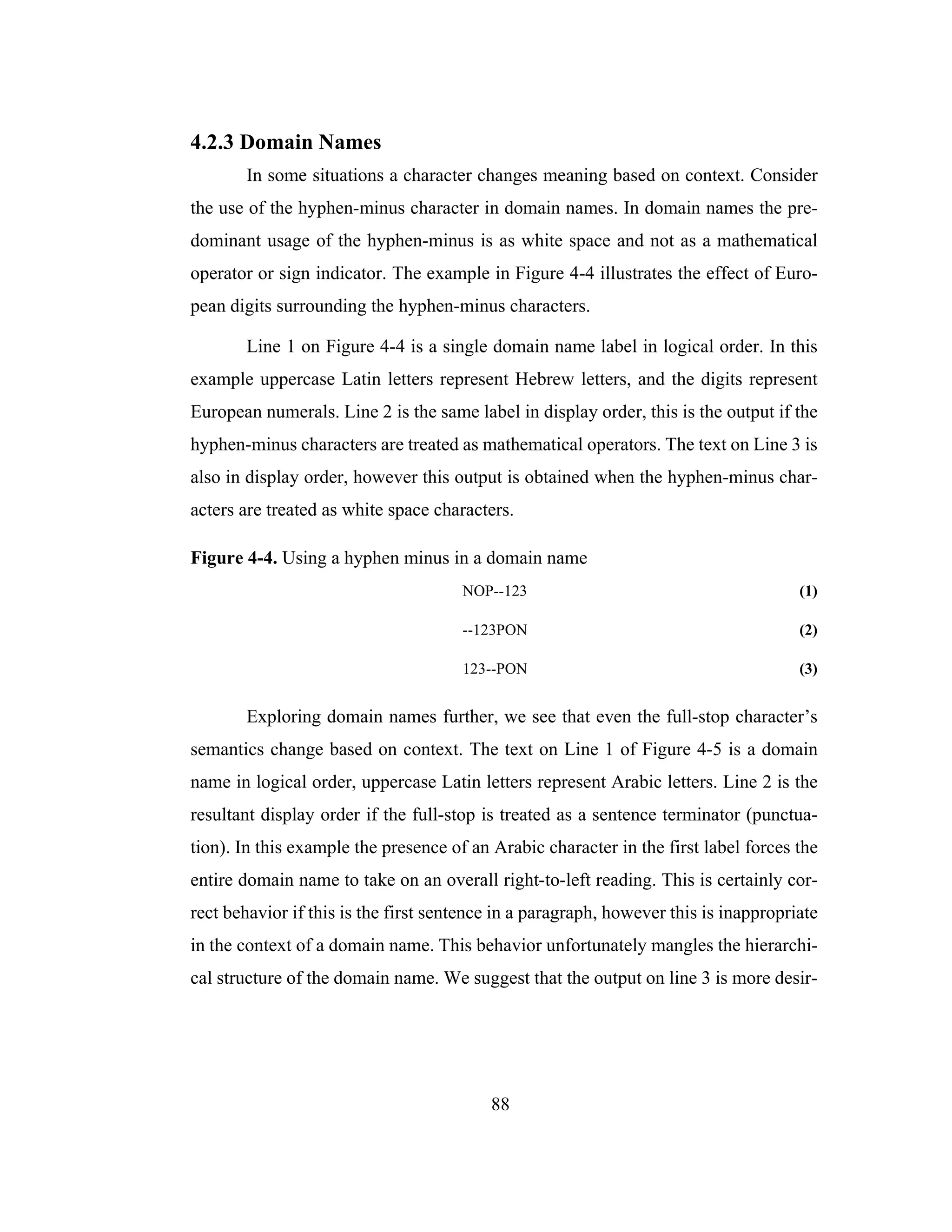
![89
able, as this output is consistent with the current structure of domain names. In this
case the full-stop characters are ignored.
Figure 4-5. Using a full-stop in a domain name
ABC.ibm.com (1)
ibm.com.CBA (2)
CBA.ibm.com (3)
4.2.4 External Interactions
The layout of bidirectional text is a complex process requiring the interaction
of various systems. We discussed above the contextual problem in bidirectional
layout and how it is solved by contextual analysis and character reordering. This is
only one piece of the puzzle.
4.2.4.1 Line Breaking
When bidirectional text is displayed or printed it is done so on a line by line
basis for each paragraph. The lines, however are not actually comprised of characters,
but rather glyphs. The process of constructing the lines, “line breaking”, requires that
the widths of all the glyphs in the paragraph along with the width of the display area
be known. It is inappropriate to assume that the number of and width of each charac-
ter is the same when displayed. This requires a sophisticated mapping between char-
acters and glyphs. [6], [21]
4.2.4.2 Glyph Mapping
Traditionally glyphs are selected and drawn by font rendering engines rather
than via character replacement. The logic for this approach is centered around glyph
availability. Some glyphs may simply not be available in a font (e.g., Hebrew and
Greek final forms). If implementers were to replace sequences of characters with new
character ligatures, there would be no guarantee that they would be present in a font
as well. Some ligatures are not able to be constructed by using character replacement,](https://image.slidesharecdn.com/0f3c79e3-c95a-412c-8137-2676e0a933c3-161215183642/75/cs-2002-01-103-2048.jpg)
![90
as they are not present in Unicode. The choice of an appropriate glyph requires
knowledge of the font and its available glyphs.
4.2.4.3 Behavioral Overrides
Putting aside glyph related problems there are still other facets in a complete
layout solution. For example, user supplied information may be required in order to
determine where a paragraph begins and ends. Examining just the stream contents
isn’t always sufficient. This information could appear as control codes or be supplied
externally. [96]
In some cases user preferences or locales can also force the stream contents
to change. For example, the shapes used to display numeric characters could be con-
trolled by a locale. In an Arabic locale numeric characters would be displayed with
“Hindi” shapes, while a Western European locale would use “Arabic” shapes for
numbers. [41]
4.2.5 Bidirectional Editing
There are also aspects of bidirectional layout that are outside the scope of
overrides, in particular the caret and the mouse. Movement of the caret and hit testing
of the mouse becomes more complex in bidirectional streams. If the caret is moving
linearly within one of the (logical or visual) streams, then this movement needs to be
translated to the other stream. Highlighting poses a similar problem as to which
stream is being highlighted (logical or visual). [6], [21]
4.2.6 Goals
Unfortunately, the tasks that the developer would like to provide are not nec-
essarily the same ones that can be provided. All of this depends on how the algorithm
is intended to be used. If the intended use is to fit within in some broader context then
it may be acceptable to leave some features out. If the intended use is to provide a
complete layout framework, a set of features above and beyond the ones mentioned](https://image.slidesharecdn.com/0f3c79e3-c95a-412c-8137-2676e0a933c3-161215183642/75/cs-2002-01-104-2048.jpg)
![91
may be required. The specification of a bidirectional algorithm can only be imple-
mented as a character stream reordering (What else can an implementer do?), yet the
bidirectional layout problem can only be solved in a larger context.
4.3 General Solutions to Bidirectional Layout
There are four general ways in which the bidirectional display problem can
be addressed. Three of these strategies are automated, while one requires user inter-
vention:
• Forced Display
• Explicit
• Implicit
• Implicit/Explicit
4.3.1 Forced Display
The Forced Display algorithm requires users to enter characters in display
order. So if a text stream contained Arabic (right-to-left) characters the user would
simply enter them backwards. This inelegant solution becomes cumbersome when
scripts are intermixed. On the other hand, this approach has the advantage that the
output (display order) is always correct and independent of the context. [12]
4.3.2 Explicit
Another potential solution to the bidirectional problem is to allow users to
enter text in logical order but expect them to use some explicit formatting codes (for
example, U202B and U202A in Unicode) for segments of text that run contrary to the
base text direction, but what does one do with the explicit control codes in tasks other
than display? For example, what effect should these controls have on searching and
data interchange. These explicit codes require specific code points to be set-aside for
them as well. In some encodings this may be unacceptable due to the fixed number
of code points available and the number of code points required to represent the script](https://image.slidesharecdn.com/0f3c79e3-c95a-412c-8137-2676e0a933c3-161215183642/75/cs-2002-01-105-2048.jpg)
![92
itself. A less technical problem is the pain this process causes the users, requiring
constant thought in terms of presentation, which is an unnatural way to think about
text. [12], [41]
4.3.3 Implicit
Humans want to be able to enter text in the same way as one would read it
aloud. Ideally, one would like to maintain the flexibility of entering characters in log-
ical order while still achieving the correct visual appearance. Such “implicit layout
algorithms” do exist. They require no explicit directional codes nor any higher-order
protocols. These algorithms can automatically determine the correct visual layout by
simply examining the logical text stream. Generally the implicit rules are sufficient
for the layout of most text streams. Still, there are situations in which an implicit algo-
rithm will not always yield an acceptable result, because it is difficult to design a set
of heuristics for every situation. [41]
4.3.4 Implicit/Explicit
An implicit/explicit Algorithm offers the greatest level of flexibility by pro-
viding a mechanism for unambiguously determining the visual representation of all
raw streams of text. This type of algorithm combines the benefits of implicit layout
algorithms with the flexibility of an explicit algorithm. Throughout the rest of this
chapter we limit our discussion of bidirectional algorithms to this type of algorithm,
because it shows the greatest potential for solving the bidirectional display problem.
[96]
4.4 Implicit/Explicit Bidirectional Algorithms
The primary algorithm explored below is the Unicode Bidirectional Algo-
rithm. This algorithm is in the implicit/explicit class of bidirectional algorithms. The
other algorithms that are discussed in this section are variations of Unicode’s algo-
rithm.](https://image.slidesharecdn.com/0f3c79e3-c95a-412c-8137-2676e0a933c3-161215183642/75/cs-2002-01-106-2048.jpg)
![93
4.4.1 Unicode Bidirectional Algorithm
The Unicode Bidirectional Algorithm is described in Unicode Technical
Report #9. There are two reference implementations — one written in the program-
ming language Java and one in C [100]. The Unicode algorithm is based upon exist-
ing implicit layout algorithms and explicit directional control codes that may be in
the input stream.
The core of the Unicode Bidirectional algorithm is centered around three
aspects: resolving character types, reordering characters and analyzing mirrors. The
bidirectional algorithm is applied to each paragraph on a line by line basis. During
resolution, characters that do not have a strong direction are assigned a direction
based on the surrounding characters or directional overrides. In this context the term
“strong” indicates a character that is either a left-to-right character or a right-to-left
character. In the reordering phase, sequences of characters are reversed as necessary
to obtain the correct visual ordering. Finally, each mirrored character (parenthesis,
brackets, braces, etc.) is examined to see if it needs to be replaced with its symmetric
mirror.[100]
The Unicode Bidirectional Algorithm determines the general reading direc-
tion of a paragraph either explicitly or implicitly. In the explicit method the reading
direction of a paragraph is communicated to the algorithm outside of and independent
from the characters in the paragraph. The implicit method determines the reading
direction of a paragraph by applying a set of heuristics on the characters in the para-
graph. [100]
4.4.2 IBM Classes for Unicode (ICU) and Java
Java 1.2 provides a complete framework for creating multi script applica-
tions. Java’s TextLayout and LineBreakMeasurer classes facilitate the layout of com-
plex text in a platform neutral manner. The underlying approach to reordering is
based on the Unicode Bidirectional Algorithm. [21]](https://image.slidesharecdn.com/0f3c79e3-c95a-412c-8137-2676e0a933c3-161215183642/75/cs-2002-01-107-2048.jpg)
![94
ICU’s approach is very close to Java due in some respect to the fact that the
overall internationalization architecture of Java is based on ICU. The key differences
are centered around glyph management. In ICU glyph management routines are not
necessary because ICU is not designed to be a complete programming environment.
The ICU components are designed to work in conjunction with other libraries. [45]
4.4.3 Pretty Good Bidirectional Algorithm (PGBA)
Mark Leisher’s PGBA is another algorithm for bidirectional reordering. The
algorithm takes an implicit approach to reordering. PGBA does not attempt to match
Unicode’s reordering algorithm. However PGBA’s implicit algorithm does match
the implicit section of the Unicode Bidirectional Algorithm. At the moment it does
not support the explicit bidirectional control codes (LRE, LRO, RLE, RLO, PDF).
One should not infer that the lack of support for directional control codes results in
an incomplete algorithm. Under most circumstances the implicit algorithm reorders
a text stream correctly. Secondly, these control codes are not always present in all
encoding schemes. Of course it would be a nice feature, but certainly not a necessary
one. [56]
4.4.4 Free Implementation of the Bidirectional Algorithm (FriBidi)
Dov Grobgeld’s FriBidi follows the Unicode Bidirectional Reference more
closely. Notably there is support for integration with graphical user interfaces along
with a collection of code page converters. However as in PGBA the explicit control
codes are not currently supported. [34]
4.5 Evaluation of Bidirectional Layout Algorithms
In this section we report on the results of our independent evaluation of the
output of the bidirectional algorithms. The primary goal we sought in evaluating the
algorithms was to determine whether or not their output matched Unicode’s reference](https://image.slidesharecdn.com/0f3c79e3-c95a-412c-8137-2676e0a933c3-161215183642/75/cs-2002-01-108-2048.jpg)
![95
algorithm. We have tested them on a large number of small, carefully crafted test
cases of basic bidirectional text.
4.5.1 Testing Convention
To simulate Arabic and Hebrew input/output a simple set of rules are utilized.
These rules make use of characters from the Latin 1 charset. The character mappings
allow Latin 1 text to be used instead of real Unicode characters for Arabic, Hebrew,
and control codes. This is an enormous convenience in writing, reading, running and
printing the test cases. This form is the same as the one used by the Unicode Bidirec-
tional Reference Java Implementation [100]. See Table 4-1. Unfortunately not all of
the implementations adhere to these rules in their test cases. To compensate for this,
changes were made to some of the implementations.
In the Unicode C reference implementation additional character mapping
tables were added to match those of the Unicode Java Reference implementation.
Also the bidirectional control codes were remapped from the control range 0x00-
Table 4-1. Bidirectional character mappings for testing
Type Arabic Hebrew Mixed English
L a - z a - z a - z a - z
AL A - Z A - M
R A - Z N - Z
AN 0 - 9 5 - 9
EN 0 - 9 0 - 4 0 - 9
LRE [ [ [ [
LRO { { { {
RLE ] ] ] ]
RLO } } } }
PDF ^ ^ ^ ^
NSM ~ ~ ~ ~](https://image.slidesharecdn.com/0f3c79e3-c95a-412c-8137-2676e0a933c3-161215183642/75/cs-2002-01-109-2048.jpg)
![96
0x1F to the printable range 0x20-0x7E. This remapping allows test results to be com-
pared more equitably.
In PGBA and FriBidi the character attribute tables were modified to match
the character mappings outlined in Table 4-1. The strategy for testing ICU and Java
was slightly different than PGBA and FriBidi. In the ICU and Java test cases we used
the character types rather than character mappings.
4.5.2 Test Cases
The test cases are presented in Tables: 4-2, 4-3, 4-4, and 4-5. The source
column of each table shows the test input. The expected column is what we think the
correct output should be. In all cases this is the output produced by our HaBi imple-
mentation. These test cases are taken from the following sources:
• Mark Leisher - His web page provides a suite of test cases as well as a table of
results for other implementations [56]. See Tables: 4-2 and 4-3.
• Unicode Technical Report #9 - Some of the examples are used for testing con-
formance [100]. See Table 4-2.
• Additional test cases for uncovering potential bugs in an implementation’s han-
dling of weak types and directional controls. See Tables: 4-4 and 4-5.
Table 4-2. Arabic charmap tests
Source Expected
1 car is THE CAR in arabic car is RAC EHT in arabic
2 CAR IS the car IN ENGLISH HSILGNE NI the car SI RAC
3 he said “IT IS 123, 456, OK” he said “KO ,456 ,123 SI TI”
4 he said “IT IS (123, 456), OK” he said “KO ,(456 ,123) SI TI”
5 he said “IT IS 123,456, OK” he said “KO ,123,456 SI TI”
6 he said “IT IS (123,456), OK” he said “KO ,(123,456) SI TI”
7 HE SAID “it is 123, 456, ok” “ok ,456 ,123 it is” DIAS EH
8 <H123>shalom</H123> <123H/>shalom<123H>
9 HE SAID “it is a car!” AND RAN NAR DNA “!it is a car” DIAS EH
10 HE SAID “it is a car!x” AND RAN NAR DNA “it is a car!x” DIAS EH](https://image.slidesharecdn.com/0f3c79e3-c95a-412c-8137-2676e0a933c3-161215183642/75/cs-2002-01-110-2048.jpg)
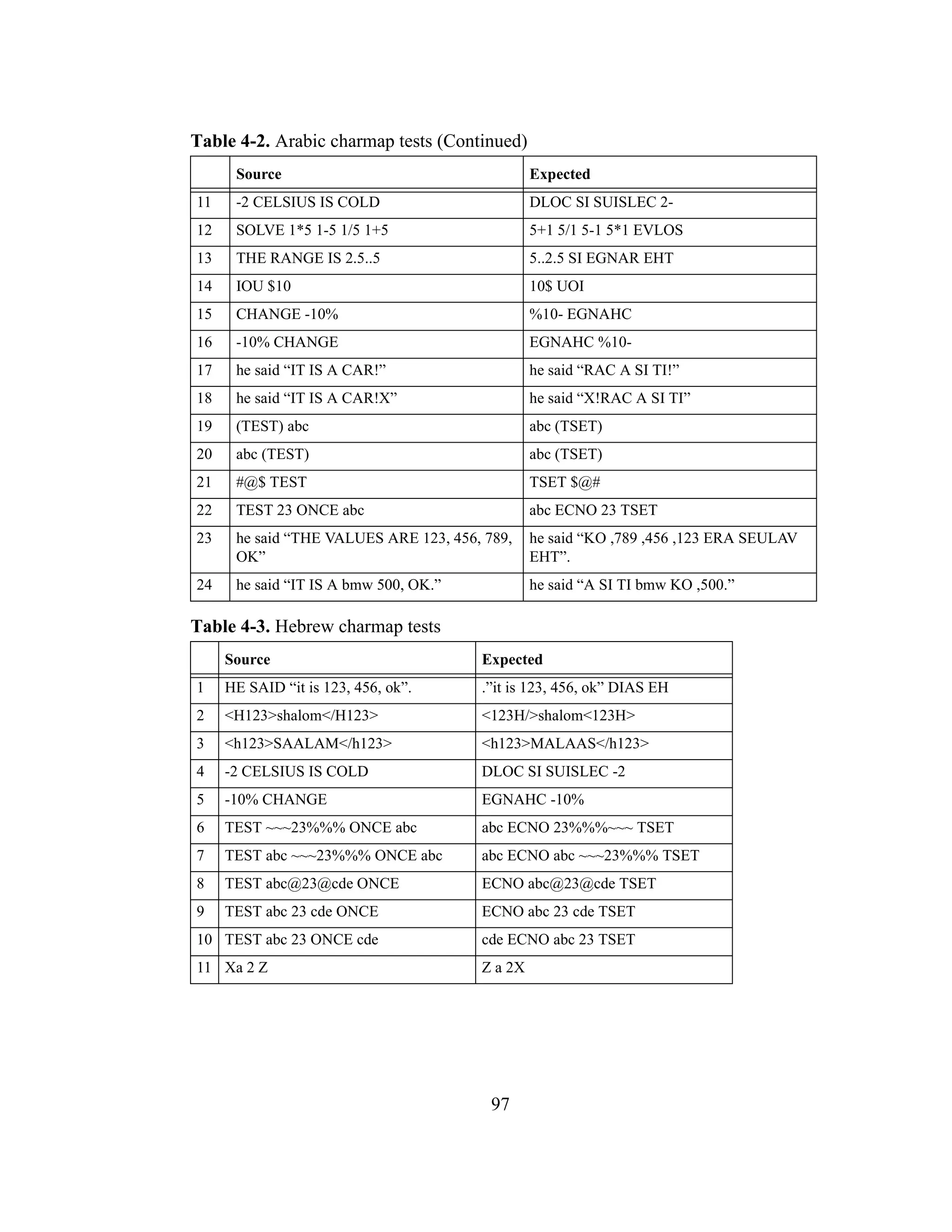
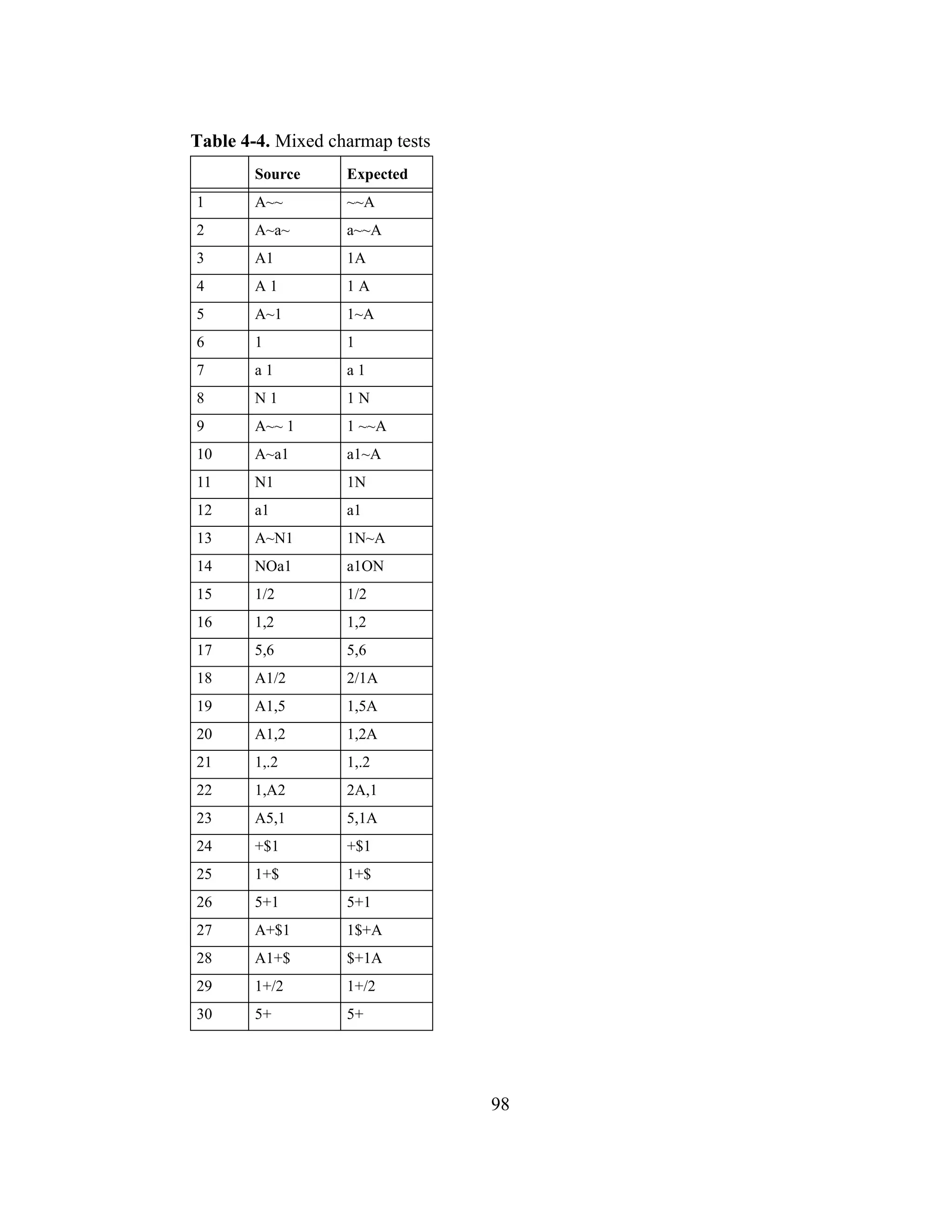

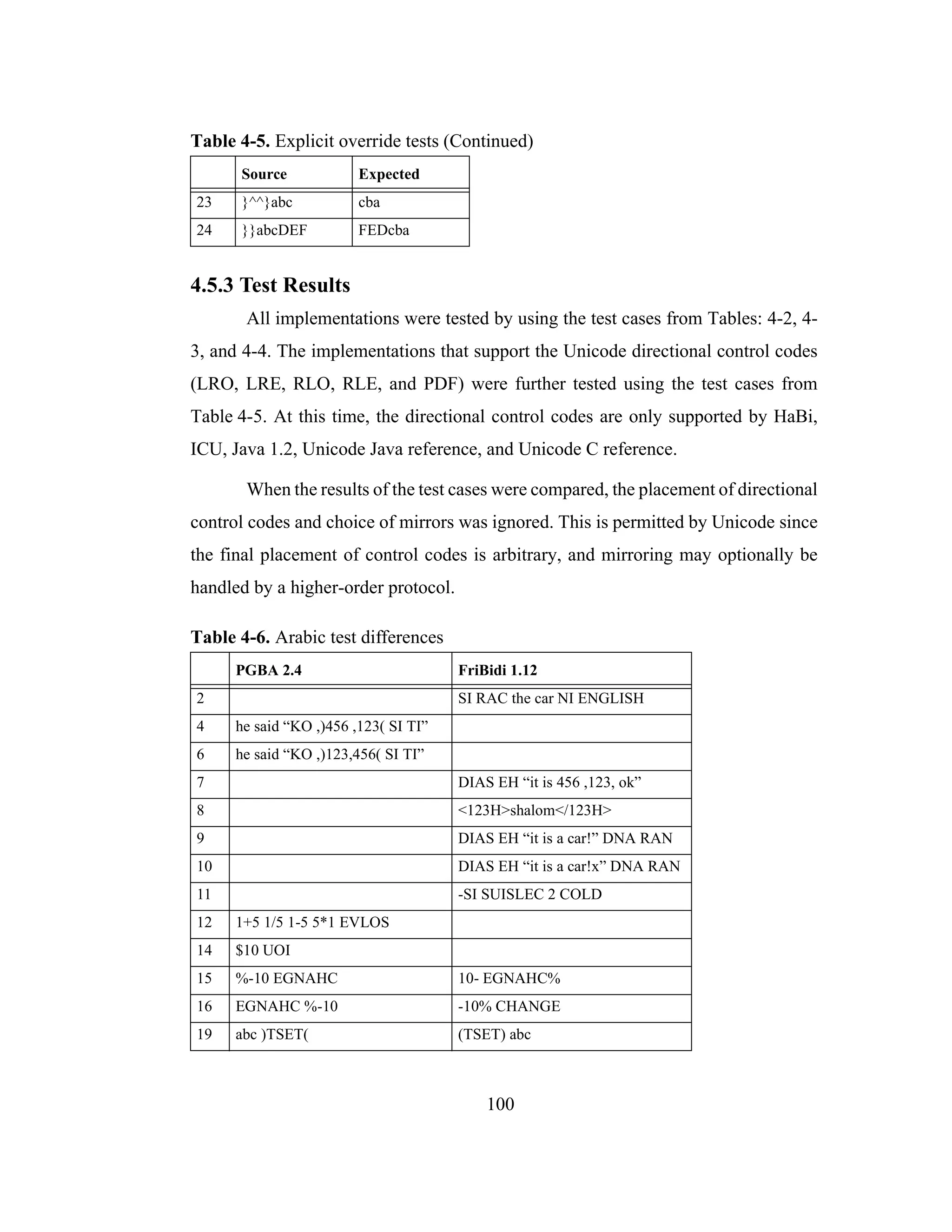

![102
In PGBA, types AL and R are treated as being equivalent [56]. This in itself
does not present a problem as long as the data stream is free of AL and EN (European
number). However, a problem arises when an AL is followed by an EN for example,
test case 18 from Table 4-4. In this situation the ENs should be treated as ANs (Ara-
bic number) and not left as ENs.
The handling of a NSM is also different in PGBA. PGBA treats a NSM as
being equal to an ON (other neutral) [56]. This delays the handling of NSM until the
neutral type resolution phase rather than in the weak type resolution phase. By delay-
ing their handling, the wrong set of rules are used to resolve the NSM type. For exam-
ple, in test case 2 from Table 4-4 the last NSM should be treated as type L instead of
type R.
In FriBidi there are a few bugs in the implementation. Specifically, when an
AL is followed by an EN the EN is not being changed to type AN. See test case 18
in Table 4-4. This is the same symptom as was found in PGBA, but the root cause is
different. In FriBidi, step W2 (weak processing phase rule two) the wrong type is
being examined it should be type EN instead of type N.
There is also a bug in determining the first strong directional character. The
only types that are recognized as having a strong direction are types R and L. Type
AL should also be recognized as a strong directional character. For example, when
test case 1 from Table 4-4 is examined FriBidi incorrectly determines that there are
no strong directional characters present. It then proceeds to default the base direction
to type L when it should actually be of type R. This problem also causes test cases 2,
9, and 11 from Table 4-2 to fail.
4.6 Functional Approach to Bidirectional Layout
Having examined several bidirectional algorithms we see numerous problems
with the implementations. We believe these errors are not the fault of the implemen-](https://image.slidesharecdn.com/0f3c79e3-c95a-412c-8137-2676e0a933c3-161215183642/75/cs-2002-01-116-2048.jpg)
![103
tations, but rather are the fault of the algorithm and its description. In this section we
introduce the Haskell bidirectional algorithm (HaBi). Our goal is to apply functional
programming techniques to the problem of bidirectional layout, so as to discover the
essence of the Unicode Bidirectional Algorithm. A greater understanding of the algo-
rithm is obtained by a clear functional description of its operations [41]. Without a
clear description, implementers may encounter ambiguities that ultimately lead to
divergent implementations, contrary to the primary goal of the Unicode Bidirectional
Algorithm. During the construction of our functional implementation we excluded all
references to the Java and C implementations of the Unicode Bidirectional Algo-
rithm, so as to prevent any bias.
4.6.1 Haskell Bidirectional Algorithm (HaBi)
In this section the source code to HaBi is presented. The HaBi reference
implementation uses the Hugs 98 version of Haskell 98 [51] as it is widely available
(Linux, Windows, and Macintosh) and easily configurable.
Since the dominant concern in HaBi is comprehension and readability our
implementation closely follows the textual description as published in the Unicode
Technical Report #9. See Figure 4-7. HaBi is comprised of five phases as in the Java
Unicode Bidirectional Reference implementation:
• Resolution of explicit directional controls
• Resolution of weak types
• Resolution of neutral types
• Resolution of implicit levels
• Reordering of levels
Currently there is no direct support for Unicode in the Hugs 98 implementa-
tion of Haskell 981
. So we treat Unicode as lists of 16 or 32-bit integers. The authors
provide two modules for Unicode manipulation. The first is used to create Unicode
(UCS4, UCS2, and UTF-8) strings. The second is used for determining character](https://image.slidesharecdn.com/0f3c79e3-c95a-412c-8137-2676e0a933c3-161215183642/75/cs-2002-01-117-2048.jpg)

![105
steps of the algorithm. The first step in our implementation is to lookup and assign
bidirectional attributes to the logical character stream. The attributes are obtained
from the online character database as published in Unicode 3.0. At this point explicit
processing assigns level numbers as well as honoring any directional overrides.
Weak and neutral processing potentially causes attribute types to change based upon
surrounding attribute types. Implicit processing assigns final level numbers to the
streams which control reordering. Reordering then produces a sequence of Unicode
characters in display order.
Figure 4-7. Data flow
HaBi uses the following three internal types:
• type Attributed = (Ucs4, Bidi)
• type Level= (Int, Ucs4, Bidi)
• data Run = LL[Level] | LR[Level] | RR[Level] | RL[Level]
Wherever possible the implementation treats characters collectively as
sequential runs rather than as individual characters [1]. By using one of data type
Run’s four possible type constructors, characters can then be grouped by level. These
four constructors signify the possible combinations of starting and ending run direc-
tions. For example, the LL constructor signifies that the start of a run and the end of
a run are both left-to-right. Therefore runs of LL followed by RL are not created.
Before the details of the source code are discussed it is important to make note
of the following concerning HaBi:
Unicode Attribute Level
Lookup
Explicit
Weak
Neutral
Implicit
Reorder](https://image.slidesharecdn.com/0f3c79e3-c95a-412c-8137-2676e0a933c3-161215183642/75/cs-2002-01-119-2048.jpg)
![106
• The logical text stream is assumed to have already been separated into paragraphs
and lines.
• Directional control codes are removed once processed.
• No limit is imposed on the number of allowable embeddings.
• Mirroring is accomplished by performing character replacement.
By separating those facets of layout dealing with reordering from those that are con-
cerned with rendering (line breaking, glyph selection, and shaping) it becomes easier
to understand the Haskell implementation.
4.6.1.1 HaBi Source Code
In the source code, functions are named in such a way so as to correspond to
the appropriate section in the Unicode Bidirectional textual reference [100]. See
Appendix A. For example, the function named weak refers to overall weak resolution.
While the function named w1_7 lines 46-72 specifically refers to steps 1 through 7 in
weak resolution.
The function logicalToDisplay lines 152-160 in Appendix A, is used to convert
a stream in logical order to one in display order. First, calls to the functions explicit
lines 37-41, weak lines 74-79, neutral lines 95-100, and implicit lines 115-120 form runs
of fully resolved characters. Calls to reorder lines 135-141 and mirror lines 144-150
are then applied to the fully resolved runs which in turn yield a stream in display
order. This is discussed in greater detail in the next few paragraphs.
The explicit function breaks the logical text stream into logical runs via calls
to p2_3 lines1-8, x2_9 lines 10-27 and x10 lines 29-35. The reference description sug-
gests the use of stacks for keeping track of levels, overrides, and embeddings. In our
implementation stacks are used as well, but they are implicit rather than explicit
(function x2_9 arguments two, three, and four). The functions weak, neutral, and
implicit are then mapped onto each individual run.](https://image.slidesharecdn.com/0f3c79e3-c95a-412c-8137-2676e0a933c3-161215183642/75/cs-2002-01-120-2048.jpg)
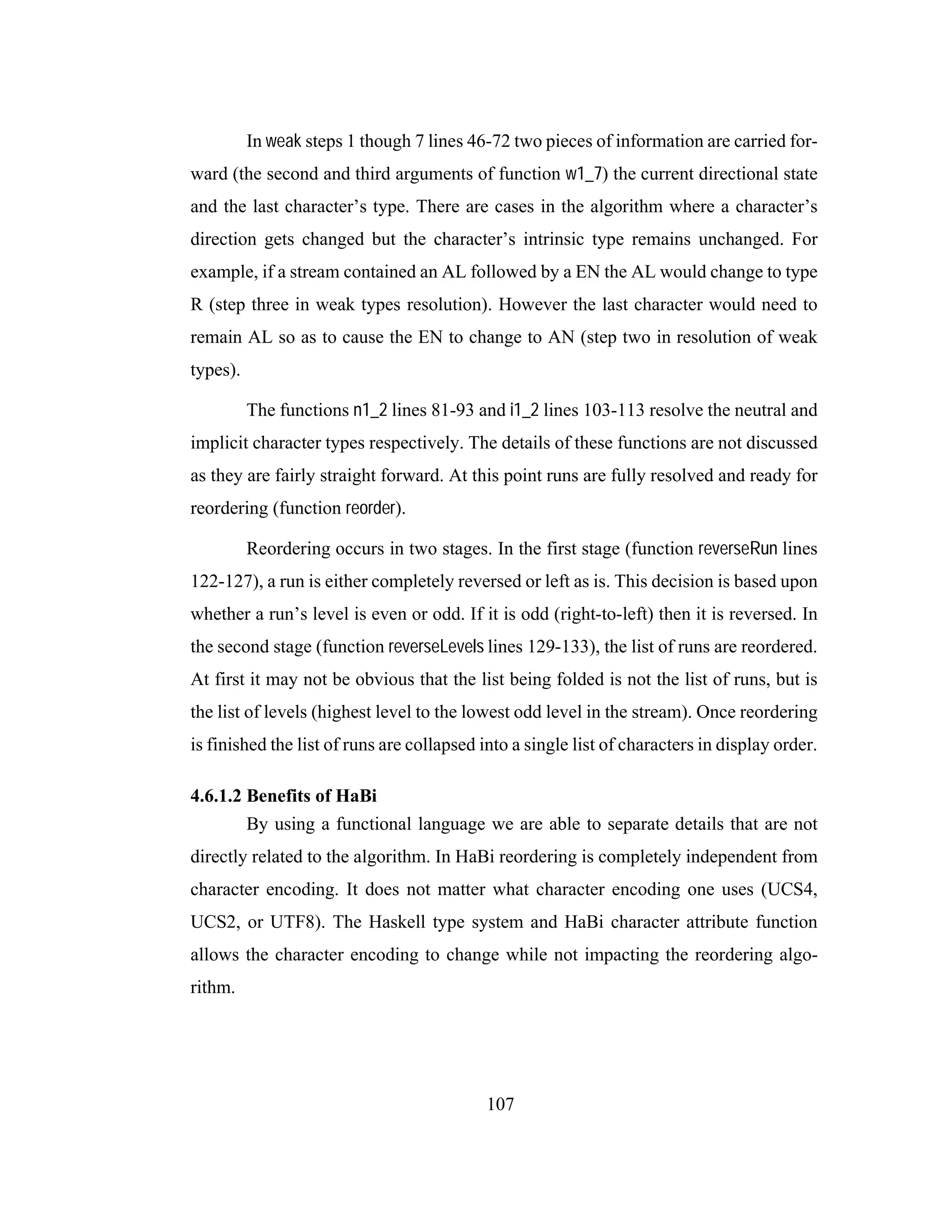
![108
Other implementations may find this level of separation difficult to achieve
(Java and C). In C the size of types are not guaranteed to be portable, making C
unsuitable as a reference. In the Java reference implementation the ramifications of
moving to UCS4 are unclear. Our reference presents the steps as simple, easy to
understand functions without side effects. This allows implementers to comprehend
the true meaning of each step in the algorithm independently of the others while
remaining free from language implementation details. The creation of test cases is
thus more systematic.
4.7 Problems With Bidirectional Layout Algorithms
The biggest hindrance to the creation of a mechanism for converting logical
data streams to display streams lies in the problem description. The problem of bidi-
rectional layout is ill defined with respect to the input(s) and output(s).
Certainly the most obvious input is the data stream itself. But several situa-
tions require additional input in order to correctly determine the output stream. For
example, in Farsi, mathematical expressions are written left-to-right while in Arabic
they are written right-to-left [41]. This may require a special sub input (directional
control code) to appear within the stream for proper handling to occur. If it becomes
necessary to use control codes for obtaining the desired results, the purpose of an
algorithm becomes unclear.
The problem of converting logical data streams to display streams is more
confounding when one considers other possible inputs (paragraph levels, line breaks,
shaping, directional overrides, numeric overrides, etc.) Are they to be treated as sep-
arate inputs? If they are treated as being distinct, when, where and how should they
be used?
Determining the output(s) is not simple either. The correct output(s) is largely
based on the context in which an algorithm will be used. If an algorithm is used to](https://image.slidesharecdn.com/0f3c79e3-c95a-412c-8137-2676e0a933c3-161215183642/75/cs-2002-01-122-2048.jpg)
![109
render text, then appropriate outputs might be a glyph vector and a set of screen posi-
tions. On the other hand, if an algorithm is simply being used to determine character
reordering, then an acceptable output might just be a reordered character stream.
4.7.1 Unicode Bidirectional Algorithm
The Unicode Bidirectional algorithm has gone through several iterations over
the years. The current textual reference has been greatly refined. Nevertheless, we
believe that there is still room for improvement. Implementing a bidirectional layout
algorithm is not a trivial matter even when one restricts an implementation to just
reordering. Part of the difficulty can be attributed to the textual description of the
algorithm. Additionally there are areas that require further clarification.
As an example, consider step L2 of the Unicode Bidirectional Reference
Algorithm. It states the following, “From the highest level found in the text to the
lowest odd level on each line, reverse any contiguous sequence of characters that are
at that level or higher. [100]” This has more than one possible interpretation. It could
mean that once the highest level has been found and processed the next level for pro-
cessing should be one less than the current level. It could also be interpreted as mean-
ing that the next level to be processed is the next lowest level actually present in the
text, which may be greater than one less than the current level. It was only through
an examination of Unicode’s Java implementation that we were able to determine the
answer. (The next level is one less than the current.)
There are also problems concerning the bounds of the Unicode Bidirectional
Algorithm. In the absence of higher-order protocols it is not always possible to per-
form all the steps of the Unicode Bidirectional Algorithm. In particular, step L4
requires mirrored characters to be depicted by mirrored glyphs if their resolved direc-
tionality is R. However, glyph selection requires knowledge of fonts and glyph sub-
stitution tables. One possible mechanism for avoiding glyph substitutions is to
perform mirroring via character substitutions. In this approach mirrored characters](https://image.slidesharecdn.com/0f3c79e3-c95a-412c-8137-2676e0a933c3-161215183642/75/cs-2002-01-123-2048.jpg)
![110
are replaced by their corresponding character mirrors. In most situations this
approach yields the same results. The only drawback occurs when a mirrored char-
acter does not have its corresponding mirror encoded in Unicode. For example, the
square root character (U221A) does not have its corresponding mirror encoded.
When the Unicode Bidirectional Algorithm performs contextual analysis on
text it overrides the static proprieties assigned to some of the characters. This occurs
during the processing of weak and neutral types. Separating this portion of the algo-
rithm from resolving implicit levels and reordering levels greatly extends the appli-
cability of the algorithm. Ideally the analysis of the text should be distinct from the
actual determination of directional boundaries.
Domain names, mathematical expressions, phone numbers, and other higher-
order data elements are detected during the analysis phase. Nevertheless, it is impos-
sible to create an algorithm that can always correctly identify such elements. The real
issue is whether or not it is possible to create an algorithm that identifies such ele-
ments within some reasonable range of error and under a set of acceptable constraints
for the elements themselves.
4.7.2 Reference Implementation
We argue that if source code is now going to serve as a reference we should
pick source code that is more attuned to describing algorithms. We claim to have pro-
vided such a reference through the use of Haskell 98. Our HaBi reference is clear and
succinct. The total number of lines of source code for the complete solution is less
than 300 lines. The Unicode Java reference implementation is over 1000 lines [100].
4.7.3 HaBi
Even though, HaBi is a great improvement over current imperative imple-
mentations the functional approach has offered only limited success. Our original
goal was to discover the true nature of bidirectional display, in hopes of producing a](https://image.slidesharecdn.com/0f3c79e3-c95a-412c-8137-2676e0a933c3-161215183642/75/cs-2002-01-124-2048.jpg)
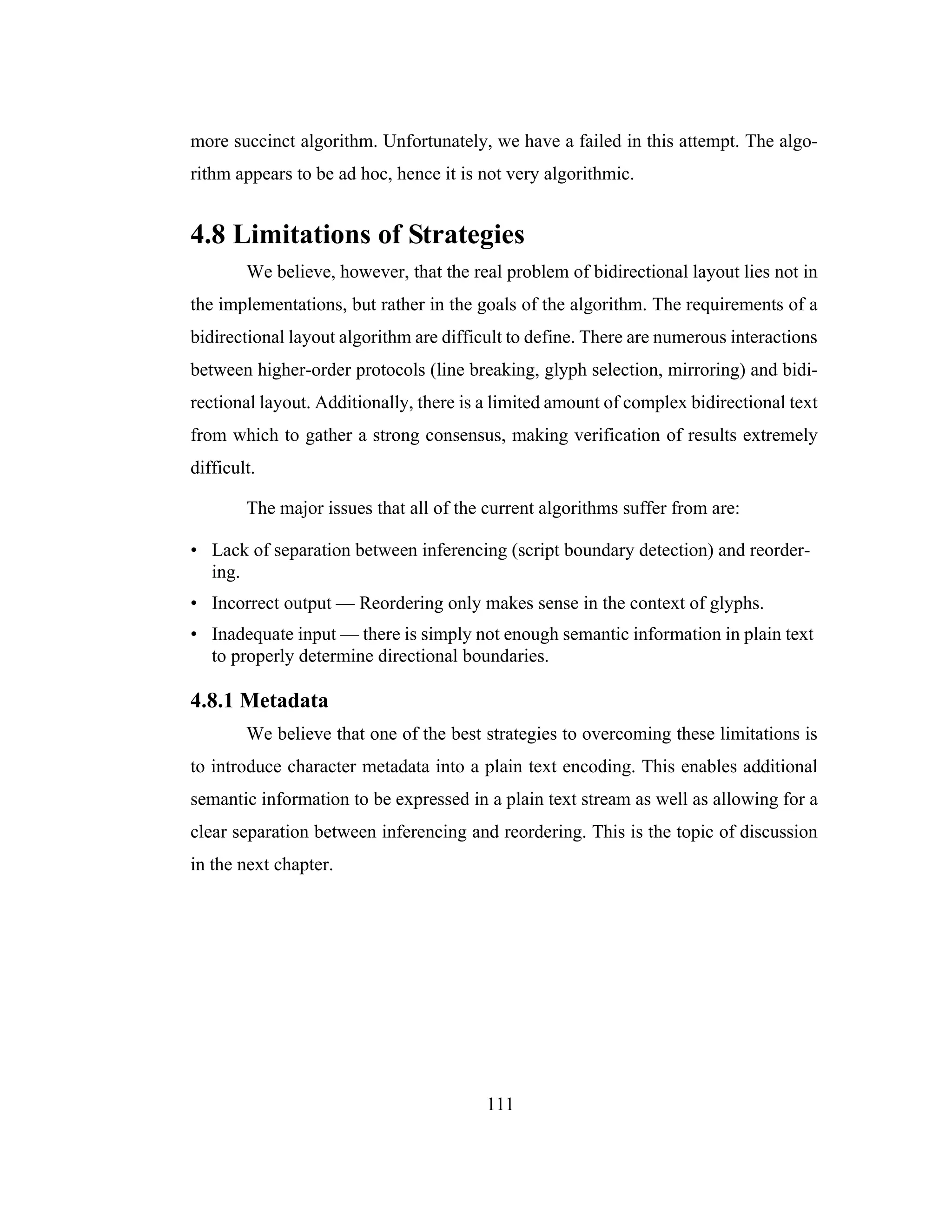
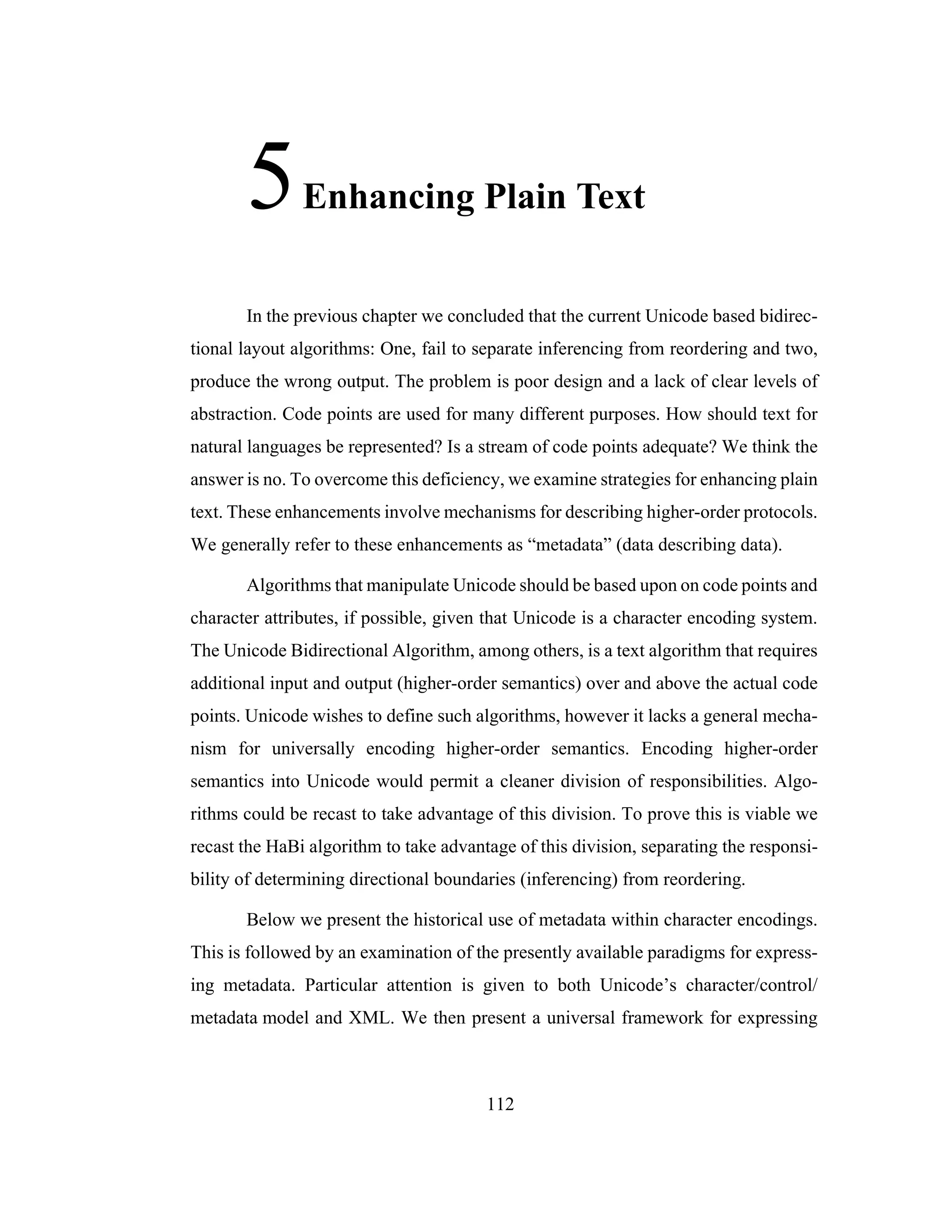
![113
higher-order protocols within Unicode. Finally, the chapter concludes with evidence
demonstrating the benefits and adaptability of the new approach.
5.1 Metadata
The need for expressing metadata has existed ever since humans started com-
municating with each other. Metadata is primarily expressed through our verbal
speech. The tone, volume, and speed in which something is spoken often signals its
importance or underlying emotion. Often this is more important than the data itself,
and more difficult to codify.
Writing and printing systems also have their need for metadata. This metadata
has been variously conveyed through the use of color, style, and size of glyphs. Ini-
tially metadata was used as a mechanism for circumventing the limitations of early
encoding schemes. As our communication mechanisms advanced so did our need for
expressing metadata.
5.1.1 Historical Perspective
One of the earliest uses of metadata appears in Baudot’s 5-bit teleprinter.
Baudot divided his character set into two distinct planes, named Letters and Figures.
The Letters plane contained all the Uppercase Latin letters while the Figures plane
contained the Arabic numerals and punctuation characters. Together, these two
planes shared a single set of code values. To distinguish their meaning Baudot intro-
duced two special meta-characters, letter shift “LTRS” and figure shift “FIGS”.
Whenever code points were transmitted they were preceded by either a FIGS or
LTRS character. This enabled unambiguous interpretation of characters. This is sim-
ilar to the shift lock mechanism in typewriters. For example, line 1 of Figure 5-1
spells out “BAUDOT” while line 2 spells out “?-7$95”.[49],[18]](https://image.slidesharecdn.com/0f3c79e3-c95a-412c-8137-2676e0a933c3-161215183642/75/cs-2002-01-127-2048.jpg)
![114
Figure 5-1. Using LTRS and FIGS in Baudot code
0x1F 0x19 0x03 0x07 0x09 0x18 0x10 BAUDOT (1)
0x1B 0x19 0x03 0x07 0x09 0x18 0x10 ?-7$95 (2)
This still left the problem of how to transmit a special signal to a teleprinter
operator. Baudot once again set aside a special code point, named bell “BEL”. This
code point would not result in anything being printed, but rather it would be recog-
nized by the physical teleprinter as the command to ring a bell. [49]
About 1900, we see code points being used as format effectors (code points
that control the positioning of printed characters on a page). A good example of such
usage can be seen in Murray’s code. Murray’s code introduced two additional char-
acters column “COL”, and line page “LINE PAGE”. Known in International Teleg-
raphy Alphabet Number 2 (ITA2) as carriage return and line feed. These characters
were used to control the positioning of the rotating typehead and to control the
advancement of paper. Murray’s encoding scheme was used for nearly fifty years
with little modification. It also served as the foundation for future encoding tech-
niques.[49]
During the late 1950s and early 1960s telecommunication hardware rapidly
became complex. Consequently, hardware manufacturers needed more highly
sophisticated protocols and greater amounts of metadata. For this purpose the US
Army introduced a 6-bit character code called FIELDATA. FIELDATA was the first
encoding to formally introduce the concept of supervisor codes, known today has
control codes. These code points were used to signal communications hardware.[49]
The hardware manufacturers were certainly not alone in their need for meta-
data. The data processing community soon realized that they also had a need for
metadata. This unfortunately taxed the existing encoding schemes (5-bit and 6-bit) so
much so as to render them unusable. As a result, richer and more flexible encoding](https://image.slidesharecdn.com/0f3c79e3-c95a-412c-8137-2676e0a933c3-161215183642/75/cs-2002-01-128-2048.jpg)
![115
schemes were created, the prime example being the American Standard Code for
Information Interchange (ASCII). [12]
ASCII with its 7-bit encoding, served not only as a mechanism for data inter-
change, but also had many other special features. One feature was a mechanism for
metadata. This metadata could be used for communicating higher-order protocols in
both hardware and software. The architecture is based upon ASCII’s escape character
“ESC” at hex value 0x1B. Initially the ESC was used for shifting between character
sets. This was of a particular importance to ALGOL programmers. For example, it
allowed if to be used as both an identifier and a reserved word simultaneously. The
presence of the ESC indicated that the if should be treated as a reserved word, rather
than as an identifier [28]. As ASCII was adopted internationally the ESC became
useful for signaling the swapping in and out of international character sets. This con-
cept was expanded upon in 1980s in the ISO-2022 standard. [15],[54],[75]
ISO-2022 is an architecture and registration scheme for intermixing multiple
7-bit or 8-bit encodings using a modal encoding system similar to Baudot’s. Escape
sequences or special characters are used to switch between different character sets or
between multiple versions of the same character set. This scheme operates in two
phases. The first phase handles the switching between character sets, while the
second handles the actual characters that make up the text.[57]
Non-modal encoding systems by contrast make direct use of the byte values
in determining the size of a character. In non-modal encoding systems characters may
vary in size within a stream of text; characters typically range from one to four bytes.
This occurs in both the UTF-8 and UTF-16 encodings. [57]
In ISO-2022 up to four different sets of graphical characters may be simulta-
neously available, labeled G0 through G3. Escape sequences are used to assign and
switch between the individual graphical sets. For example, line 1 of Figure 5-2 shows](https://image.slidesharecdn.com/0f3c79e3-c95a-412c-8137-2676e0a933c3-161215183642/75/cs-2002-01-129-2048.jpg)
![116
the byte sequence for assigning the ASCII encoding to the G0 alternate graphic char-
acter set. Line 2 shows the Latin 1 encoding being assigned to the G1 set.[3],[75]
Figure 5-2. ISO-2022 escape sequences
ESC 0x28 0x42 assign ASCII to G0 (1)
ESC 0x2D 0x41 assign Latin 1 to G1 (2)
Most data processing tools make little if any distinction amongst data types.
Data processing tools simply view information as bytes leaving the meaning of the
data entirely open to human interpretation. For example, “UNIX grep” assumes that
data is represented as a linear sequence of stateless fixed length independent bytes.
Grep is highly flexible when it comes to searching characters or object code. This
model has served text processing well under the assumption that one character equals
one code point, but encoding systems have advanced and user expectations have
risen.[76]
Over the last ten or so years Unicode has become the de facto standard for
encoding multilingual text. This has brought a host of new outcomes that few could
have imagined even a decade ago. Despite this advance, users want more than just
enough information for intelligible communication. Plain text in its least common
denominator is simply insufficient.
There have been several discussions and a few attempts to enrich plain text;
ISO-2022 is one, XML can also be viewed in this framework. Both concern meta
information yet have different purposes, goals, and audiences. The transition from
storing and transmitting text as plain streams of code points is now well under-
way.[23]
5.2 Unicode Character Model
Figure 5-3 presents what might be called the Unicode character model. It (like
the network model) has a transmission layer at the bottom and an application layer at](https://image.slidesharecdn.com/0f3c79e3-c95a-412c-8137-2676e0a933c3-161215183642/75/cs-2002-01-130-2048.jpg)
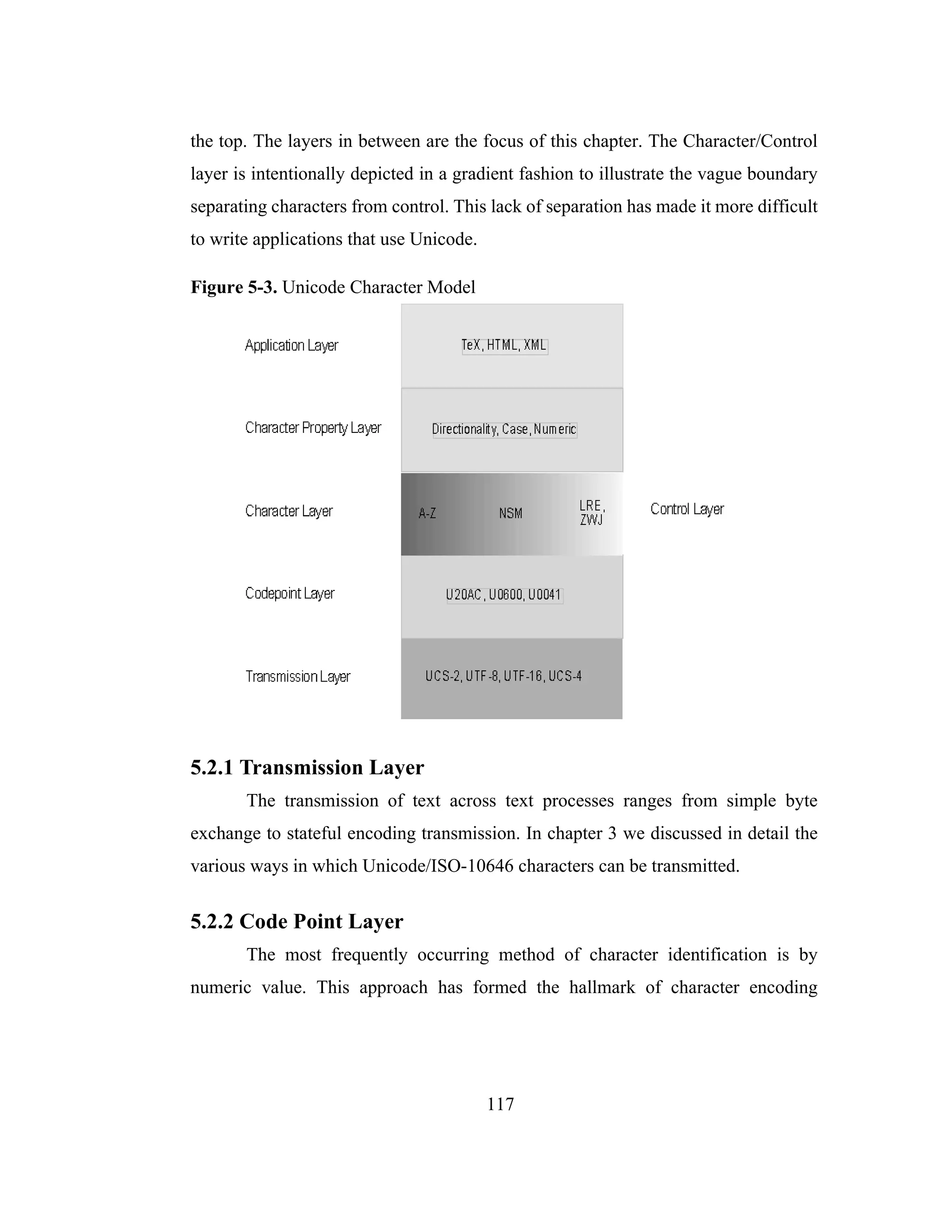
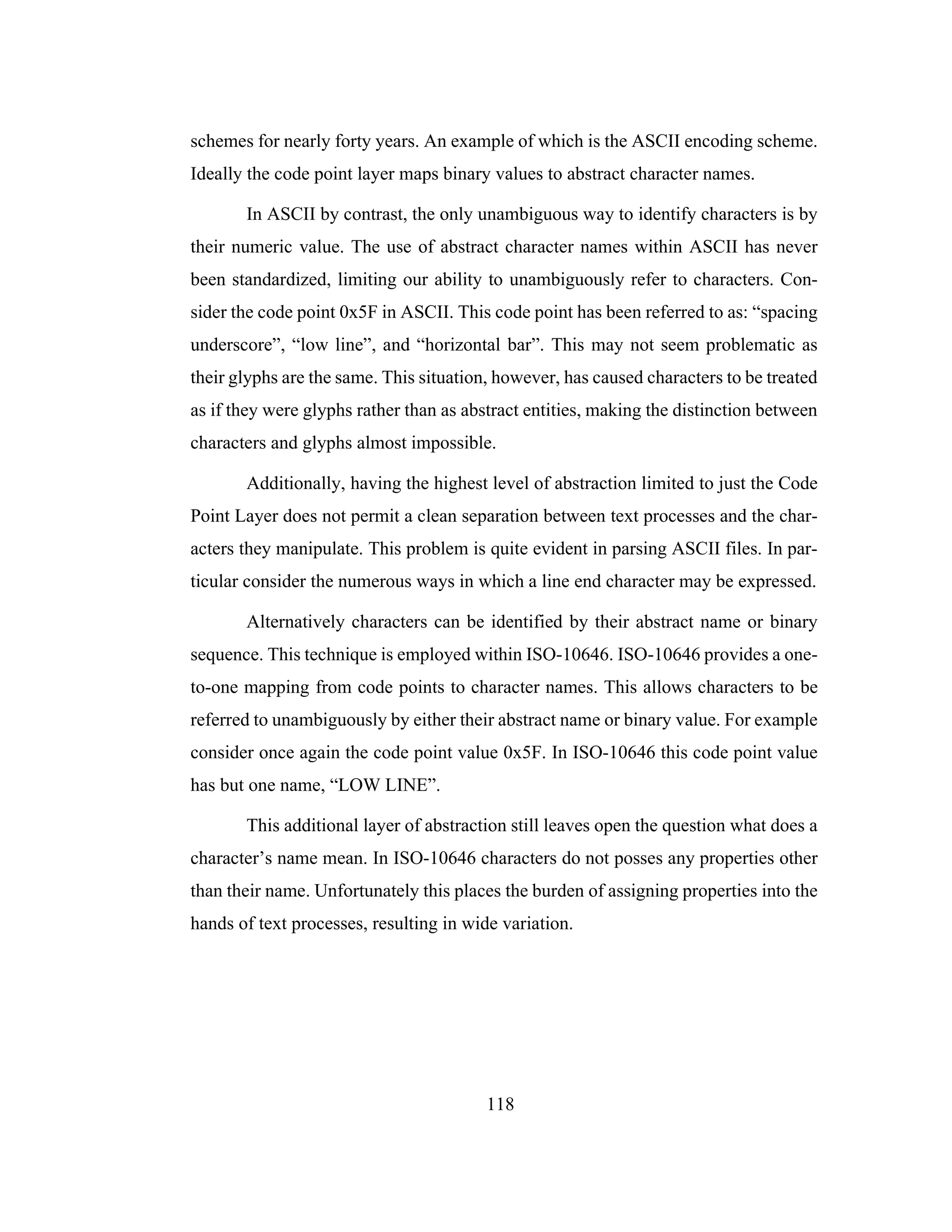
![119
5.2.3 Character/Control Layer
Unicode defines the term character as “The smallest component of written
language that has semantic value; refers to the abstract meaning and/or shape, rather
than a specific shape.” This definition is at odds with what is actually present within
Unicode. There are several characters defined within Unicode that do not belong to
any written language “controls” (characters that cause special actions to occur, but
are not considered part of the data) as well as characters that specifically convey a
definitive typographic shape “glyphs”, Table 5-1. This intermixing has made it
nearly impossible to determine when a character should be treated as data, metadata,
or a glyph. Furthermore, the method by which new control codes are introduced is
completely ad hoc. There is no standard range within Unicode that contains just con-
trols. [96]
Table 5-1. Problem Characters
Type Code Point Purpose
OBJ REPLACE 0xFFFC placeholder for external objects
ANNOTATION 0xFFF9 -
0xFFFB
used for formatting ruby characters in Japanese
CHAR REPLACE 0xFFFD placeholder for non convertible characters
CONTROL 0x0000 -
0x001F,
0x007F -
0x0096
C0 and C1 control characters, used for legacy
NON BREAKING
SPACES
0x00A0,
0xFEFF,
0x202F
non breaking space
NSM 0x0300 -
0x0362
non spacing diacritical marks used to form glyphs
SPACES 0x2000 -
0x200A,
0x200B,
0x3000
en, em, thin, hair, zero width, ideographic spaces
SEPARATORS 0x2028 -
0x2029
line and paragraph separator](https://image.slidesharecdn.com/0f3c79e3-c95a-412c-8137-2676e0a933c3-161215183642/75/cs-2002-01-133-2048.jpg)
![120
5.2.4 Character Property Layer
Clearly there exists a need for character properties. Text processes want to be
able to interchange and interpret text unambiguously. Unicode adds an additional
layer of abstraction onto ISO-10646. In Unicode each character may posses proper-
ties from three general areas, “normative”, “informative”, and “directional”. For
example, see Table 5-2. [32]
ZWNJ 0x200C zero width non joiner, prevent ligature formation
ZWJ 0x200D zero width joiner, promote ligature formation
LRM 0x200E left-to-right mark, used in bidi processing
RLM 0x200F right-to-left mark, used in bidi processing
BIDI CONTROLS 0x202A -
0x202E
used for overriding directional properties, and for
embedding directional runs
SHAPING 0x206A -
0x206F
used to control Arabic shaping
PRESENTATION
FORMS
0xFB50 -
0xFDFF,
0xFE70 -
0xFEFE
Arabic ligatures and glyph variants used by rendering
engines
HALFWIDTH AND
FULLWIDTH
0xFF00 -
0xFFEF
half-width and full-width forms used in rendering
engines
Table 5-2. Character Properties
Code Point Character Name Normative Informative Directional
0x005F LOW LINE punctuation
connector
neutral
0x0061 LATIN SMALL LETTER A lowercase letter left to right
0x0661 ARABIC-INDIC DIGIT
ONE
decimal digit arabic numeral
Table 5-1. Problem Characters (Continued)
Type Code Point Purpose](https://image.slidesharecdn.com/0f3c79e3-c95a-412c-8137-2676e0a933c3-161215183642/75/cs-2002-01-134-2048.jpg)
![121
5.3 Strategies for Capturing Semantics
There are two general approaches to encoding higher-order semantics within
text streams: in-band signaling and out-of-band signaling.
Using in-band signaling determining whether a character is data or metadata
depends on the context in which a character is found. That is, code points are over-
loaded. This achieves maximal use of the character encoding, as characters are not
duplicated. It also does not require encoding modifications as protocols change. All
of this progress comes at the expense of parsing. It is no longer possible to conduct a
simple parse of a stream looking for just data or metadata. This technique is
employed within the HTML and XML protocols. [99]
Using out-of-band signaling for describing Unicode metadata requires the
definition and transmission of complex structures similar to document data type def-
initions (DTD) in XML. This has the ill effect of making the transmission of Unicode
more intricate. It would no longer be acceptable to simply transmit the raw Unicode
text. Without the metadata, the meaning of the raw text may be ambiguous. On the
other hand, parsing of data and metadata would be trivial, given that the two are not
intermixed. [99]
5.3.1 XML
The extensible markup language (XML) provides a standard way of sharing
structured documents and for defining other markup languages. XML uses Unicode
as its character encoding for data and markup. Control codes, data characters, and
markup characters may appear intermixed in a text stream. Confusion may ensue
when control codes, data characters, and markup characters are combined with over-
lapping higher-order protocols. Additionally, there may be situations in which
markup and control should not be interleaved. This issue is quickly being realized
both within XML and Unicode. [23]](https://image.slidesharecdn.com/0f3c79e3-c95a-412c-8137-2676e0a933c3-161215183642/75/cs-2002-01-135-2048.jpg)
![122
Whitespace characters in XML are used in both markup and data. The char-
acters used in XML to represent whitespace are limited to “space”, “tab”, “carriage
return”, and “line feed”. Unicode on the other hand, offers several characters for rep-
resenting whitespace the (e.g., line separator U2028 and the paragraph separator
U2029). The use of U2028 and U2029 within XML may lead to confusion because
of the conflicting semantics. [33]
In Unicode these characters may be used to indicate hard line breaks and para-
graphs within a data stream. These may affect visual rendering as well as acting as
separators. When used within XML it is unclear whether the implied semantics can
be ignored. Does the presence of one of these control codes indicate that a rendering
protocol is being specified in addition to their use as whitespace, or are they simply
whitespace? [23]
XML completely excludes certain Unicode characters from names (tags). The
characters in the compatibility area and specials area UF900-UFFFE from Unicode
are not permitted to be used within XML names. Their exclusion is due in part to the
characters being already encoded in other places within Unicode. This is by no means
the only reason. If characters from the compatibility area were included the issue of
normalization would then to be addressed. (In this context normalization refers to
name equivalence). [33]
Unicode provides guidelines and an algorithm for determining when two
character sequences are equivalent. Unicode attempts to address this issue in Unicode
Technical Report #15 Unicode Normalization Forms. In general there are two kinds
of normalization, Canonical and Compatibility. [101]
Canonical normalization handles equivalence between decomposed and pre-
composed characters. This type of normalization is reversible. Compatibility normal-
ization addresses equivalence between characters that do not visually appear the
same. This type of normalization is irreversible.[32],[101]](https://image.slidesharecdn.com/0f3c79e3-c95a-412c-8137-2676e0a933c3-161215183642/75/cs-2002-01-136-2048.jpg)
![123
Compatibility normalization in particular is problematic within XML. XML
is designed to represent raw data free from any particular preferred presentation.
Characters that may be compatible do not necessarily share the same semantics [32].
It may be the case that an additional protocol is being specified within the stream. For
example, the UFB00 character on line 1 of Figure 5-4 is compatible with the two
character sequence “U0066 U0066” on line 2 of Figure 5-4. Line 1 also specifies an
additional protocol; in this case ligatures. In such a situation it is unclear whether or
not the names were intended to be distinct. It is difficult to tell when the control func-
tion (higher-order protocol specification) of a character can be ignored and when it
can’t. Additionally, some have argued that Unicode’s Normalization Algorithm is
difficult to implement, resource intensive, and prone to errors. To avoid such prob-
lems XML has chosen not to perform normalization when comparing names.
[18],[33]
Figure 5-4. Compatibility Normalization
UFB00 ff ligature (1)
U0066 U0066 ff no ligature (2)
Problems such as these are due to the lack of separation between syntax and
semantics within Unicode. The absence of a general mechanism for specifying
higher-order protocols “metadata” only serves to further confound these
issues.[18],[33]
5.3.2 Language Tagging
Over the years there has become a need for language “tagging” of multilin-
gual text. In some cases such information is necessary for correct behavior. For
example, language information becomes necessary when an intermixed stream of
Japanese, Chinese, and Korean is to be rendered. In this case, the unified Han char-](https://image.slidesharecdn.com/0f3c79e3-c95a-412c-8137-2676e0a933c3-161215183642/75/cs-2002-01-137-2048.jpg)
![124
acters need to be displayed using language specific glyph variants. Without higher-
order language information it becomes difficult to select the appropriate glyphs.
Recently Unicode has added a mechanism for encoding language information
within plain text. This is achieved in Unicode through the introduction of a special
set of characters that may be used for language tagging. The current strategy under
consideration within Unicode is to add 97 new characters to Unicode. These charac-
ters would be comprised of copies of the ASCII graphic characters, a language
character tag, and a cancel tag character. These characters would be encoded in Plane
14 “surrogates” U000E0000 - U000E007F.[99]
The use of the tags in Unicode is very simple. First a tag identifier character
is chosen, followed by an arbitrary number of unicode tag characters. A tag is implic-
itly terminated when either a non tag character is found or another tag identifier is
encountered. Currently there is only one tag identifier defined, the language tag. See
Figure 5-5. Line 1 of Figure 5-5 demonstrates the use of the fixed code point language
tag “U000E0001” along with the cancel tag “U000E007F”. The plane 14 ASCII
graphic characters are in bold and are used to identify the language. The language
name is formed by concatenating the language id from ISO-639 and the country code
from ISO-3166. In the future a generic tag identifier may be added for private tag def-
initions. [99]
Figure 5-5. Language tag
U000E0001 fr-Fr french text U000E0001 U000E007F (1)
Tag values can be cancelled by using the tag cancel character. The cancel
character is simply appended onto a tag identifier. This has the effect of cancelling
that tag identifier’s value. If the cancel tag is transmitted without a tag identifier the
effect is to cancel any and all processed tag values. [99]](https://image.slidesharecdn.com/0f3c79e3-c95a-412c-8137-2676e0a933c3-161215183642/75/cs-2002-01-138-2048.jpg)
![125
The value of a tag continues until either it implicitly goes out of scope or a
cancel tag character is found. Tags of the same type may not be nested. The occur-
rence of two consecutive tag types simply applies the new value to the rest of the
unprocessed stream. Tags of differing types may be interlocked. Tags of different
types are assumed to ignore each other; there are no dependencies between tags. [99]
Tag characters have no particular visible rendering and have no direct affect
on the layout of a stream. Tag aware processes may chose to format streams
according to their own interpretation of tags and their associated values. Tag unaware
processes should leave tag data alone and continue processing. [99]
5.3.2.1 Directional Properties of Language Tags
In this section we show that language tags can interact with other facets of
Unicode including the Bidirectional Algorithm.
In Unicode, language tag characters are all marked as having a neutral direc-
tion. Neutral characters pick up their direction from the surrounding strong characters
(left or right). This seems reasonable as we do not wish the tags to accidentally influ-
ence the Bidirectional Algorithm. If the direction of the tags were left-to-right or
right-to-left, rather than neutral, then the tags would influence the resolution of weak
and neutral types due to their juxtaposition. [96]
The example in Figure 5-6 demonstrates this error. In Figure 5-6 Arabic char-
acters are represented in upper case. The character sequence LANGar (Arabic lan-
guage tag) in bold is a visual representation for the Unicode sequence
(UE0001,UE0061,UE0072). In this example assume that the language tag characters
are assigned the left-to-right direction. Line 1 is a sequence of characters in logical
order, while line 2 is the expected resultant display ordering. The display ordering in
line 3 is incorrect, because the tag characters inadvertently participated in bidirec-
tional processing. Marking language tags as neutral makes sense in this framework
of protecting the Bidirectional Algorithm.](https://image.slidesharecdn.com/0f3c79e3-c95a-412c-8137-2676e0a933c3-161215183642/75/cs-2002-01-139-2048.jpg)
![126
Ironically, in the process of protecting the Bidirectional Algorithm we inad-
vertently allowed the Bidirectional Algorithm to influence language tags. For exam-
ple, line 1 on Figure 5-7 is a sequence of Arabic characters in logical order with an
embedded language tag, Urdu (UE0001,UE0075,UE0072). Line 2 is the same
sequence of characters, but in display order (output from the Bidirectional Algo-
rithm). When the character sequence is rendered the language tag, however, is dis-
played backwards and appears as “ru” which indicates Russian. The reason the
language tag is displayed backwards is, because neutral characters pick up their
direction form the surrounding characters, in this case right-to-left. Clearly this is
undesirable and therefore must be prevented.
Figure 5-6. Error in bidirectional processing
CIBARA LANGar, 123 (1)
123 , LANGar ARABIC (2)
LANGar , 123 ARABIC (3)
Figure 5-7. Error in language tagging
U0624,UE0001,UE0075,UE0072,U00623 — lang ur (Urdu), logical (1)
U0623,UE0072,UE0075,UE0001,U0624 — lang ru (Russian), display (2)
This problem can be solved by introducing a new bidirectional property,
“ignore”. This will enable the Bidirectional Algorithm to continue to function prop-
erly while also protecting the semantics of tags. Characters that posses the direction
ignore will not have any direction and will not pick up any surrounding direction, pre-
venting these characters from participating in the Bidirectional Algorithm. [96],[100]
5.3.3 General Unicode Metadata
It is still possible to construct a metadata signaling mechanism for the specific
purpose of mixing data and metadata and yet allow for simple parsing. This is called](https://image.slidesharecdn.com/0f3c79e3-c95a-412c-8137-2676e0a933c3-161215183642/75/cs-2002-01-140-2048.jpg)
![127
“light-weight in-band signalling”. This is the approach that Unicode has adopted for
language tagging. [99]
The light-weight approach is useful, but Unicode’s application of it creates
two problems. First, new tag identifiers always require the introduction of a new Uni-
code code point. This puts Unicode in a constant state of flux as well as fixing the
number of possible tag identifiers. Second, there is no way to specify multiple
parameters for a tag. This deficiency forces the creation of additional tag identifiers
to circumvent this limitation.
We propose that a more generalized approach be taken. Our design philoso-
phy is to encode a minimal set of stateless metadata characters that enable the defini-
tion of higher-order protocols. Our use of the term stateless in this context refers to
whether a character’s type (data or metadata) can be determined by its code point
value alone. In some metadata systems (HTML and XML) a character’s type can
only be determined by examining the full context in which it appears. Unfortunately,
these systems require sophisticated parsing techniques. We argue for the use of state-
less characters in our system because they simplify both parsing and understanding.
Naturally, the construction of a metadata encoding system requires a balanc-
ing of trade-offs. One such trade-off is whether or not to define a syntax for the def-
inition of tags. We believe that we should specify a minimal and flexible syntax for
tags that allows for unambiguous communication, yet does not impose any particular
style of protocol such as HTML.
In choosing the set of metadata characters we suggest that we keep the copy
of the ASCII graphic characters that are used in Unicode’s language tagging model.
We should however remove the fixed code point tag identifiers. In their place we
introduce two new characters, tag delimiter U000E0001 and tag argument separator
U000E0002. See Table 5-3. The motivation for these characters comes from the
SGML/XML/HTML camps. These characters provide an easy migration path for](https://image.slidesharecdn.com/0f3c79e3-c95a-412c-8137-2676e0a933c3-161215183642/75/cs-2002-01-141-2048.jpg)
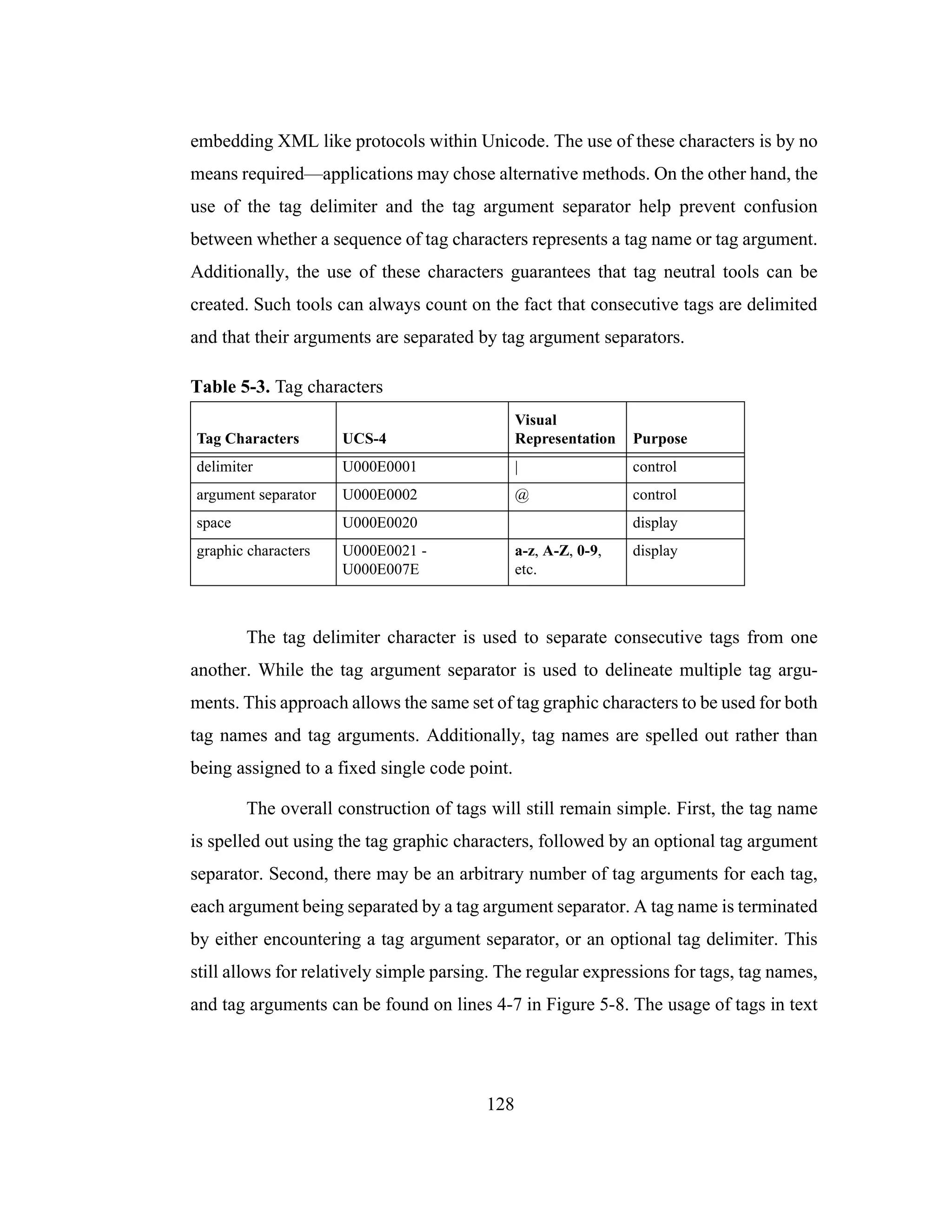
![129
streams is also very simple to comprehend. See the regular expression on line 2 in
Figure 5-9.
Figure 5-8. Regular expressions for tags
<tag graphic character> ::= [U000E0020-U000E007E] (1)
<tag delimiter> ::= U000E0001 (2)
<tag argument separator> ::= U000E0002 (3)
<tag name> ::= <tag graphic character>+ (4)
<tag argument> ::= <tag argument separator><tag graphic character>+
(5)
<tag> ::= <tag name><tag argument>*
(6)
<tag> ::= <tag delimiter> (7)
Figure 5-9. Regular expression for text stream
<data character> ::= [U00000000-U0002FA1D] (1)
<text stream> ::= (<data character>|<tag>)+
(2)
Throughout this chapter tag characters are represented in boldface. Addition-
ally the vertical bar “|” is used to depict the tag delimiter and the at sign “@” denotes
the tag argument separator. See Table 5-3. For example, line 1 of Figure 5-10 shows
a stream with two tags, “XX” and “YY”. Additionally, the tag “XX” has one argu-
ment “a”, and the “YY” tag has two arguments “b” and “c”. The example suggests
the nesting of “YY” within “XX”. In this sample protocol we terminate the scope of
a tag by repeating the tag name preceded by the tag graphic character solidus “/”. This
method of terminating scope is not a requirement, protocols may adopt other methods
or none at all.
The semantics of such combinations are left to protocol designers rather than
the metadata. This affords the greatest flexibility and yet still retains the ability to per-](https://image.slidesharecdn.com/0f3c79e3-c95a-412c-8137-2676e0a933c3-161215183642/75/cs-2002-01-143-2048.jpg)
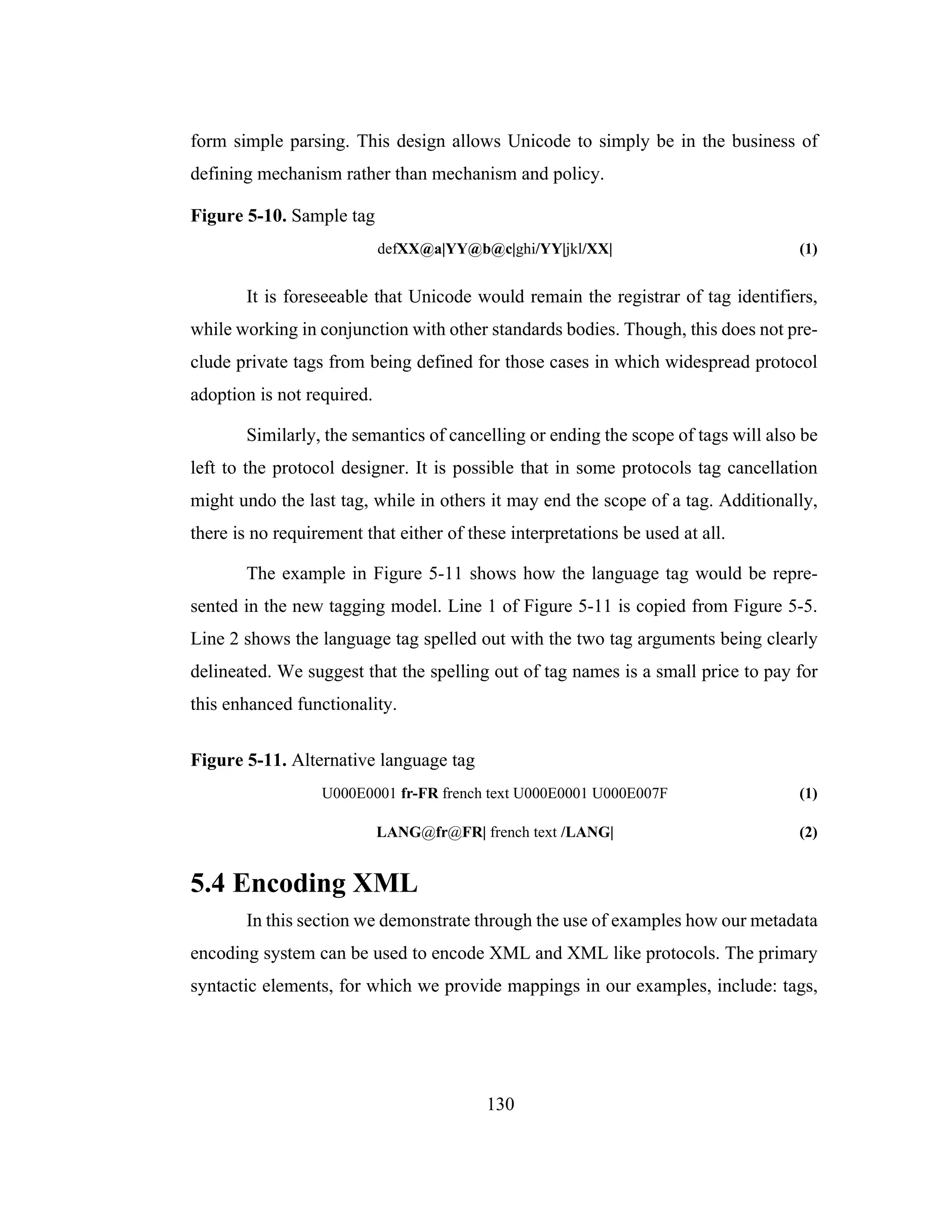
![131
entity references, and comments. We believe that these elements are sufficient for
demonstrating that the mapping of XML to metadata is both feasible and simple.
The example in Figure 5-12 shows a sample address book modeled in XML.
The address book contains a collection of contacts, in this case just one contact. Each
contact in turn contains a name and address. In this example we see three general
types of tags:
• Self closing tags — the <business/> tag on line 8 on Figure 5-12.
• Start tags — the <addressbook> tag on line 3 on Figure 5-12.
• End tags — the </contact> tag on line 13 on Figure 5-12.
Additionally, each tag may optionally contain arguments. For example, the <contact
type=”business”> tag on line 5 on Figure 5-12, contains a single tag argument. In
this tag the string type represents the name of the argument while the string business
is its corresponding value. [72]
Figure 5-12. Sample XML code
1 <?xml version=”1.0”?>
2 <!ENTITY amp “&”>
3 <addressbook>
4 <!- this is an address ->
5 <contact type=”business”>
6 <name>Steve's Bar & Grill</name>
7 <nickname>>Steve<</nickname>
8 <business/>
9 <address>150 W. University Blvd</address>
10 <city>Melbourne</city>
11 <state>FL</state>
12 <zip>32901</zip>
13 </contact>
14 </addressbook>
The sample XML file also contains entity references. In XML entity refer-
ences assign aliases to pieces of data. It serves as a unique reference to some XML
data. Entity references are made by using an ampersand and a semicolon. For exam-
ple, line 6 on Figure 5-12 shows a reference to the amp entity (ampersand), while the](https://image.slidesharecdn.com/0f3c79e3-c95a-412c-8137-2676e0a933c3-161215183642/75/cs-2002-01-145-2048.jpg)
![132
definition of the reference is shown on line 2. Normally, these characters would be
processed differently in XML. However, with entity references an XML parser does
not get confused. [72]
In this example we also see the use of a comment. See line 4 on Figure 5-12.
Comments are used to provide additional information about an XML document,
however they are not actually part of the data in a XML document. Comments begin
with a <! and end with ->. The only restriction XML places upon comments is that
they do not contain double hyphens --, as they conflict with XML’s comment syntax.
[72]
In general when we map a XML document to combined data/metadata most
characters remain unchanged. This is particularly true of characters that are not part
of XML tags. Nevertheless, characters that make up an XML tag get mapped to a cor-
responding metadata graphic tag character. However, we believe that their is some
flexibility in this mapping. In particular, the < and > do not need to be mapped at all.
These characters are not needed, because a XML parser can now immediately tell
whether a character is part of a tag or not simply by examining its code point value.
Therefore, it is unnecessary to map these characters.
The text in Figure 5-13 is the same XML document from Figure 5-13 re-
encoded using our metadata tagging system. In certain cases we have changed the
syntax of the XML tags slightly to take advantage of our metadata system and to be
more consistent with our general tag syntax. In particular, these changes can be seen
on lines 1, 2 and 5. Additionally, we have created a tag specifically for the purpose
of indicating a comment. See line 4 on Figure 5-13. To indicate whether a tag is a
start tag, end tag, or a self closing tag we have adopted the following convention:
• If the tag is an end tag then the tag name is preceded by a solidus “/”.
• If the tag is a self closing then tag the tag name is followed by a solidus.
• All remaining tags are assumed to be start tags.](https://image.slidesharecdn.com/0f3c79e3-c95a-412c-8137-2676e0a933c3-161215183642/75/cs-2002-01-146-2048.jpg)


![135
example, the text element tag. This tag will enable the embedding of additional lin-
guistic information into pain text streams.
Traditionally text processes manipulated ASCII data with the implicit under-
standing that every code point equated to a single character and in turn a single text
element, which then served as a fundamental unit of manipulation. In most cases this
assumption held, especially given that only English text was being processed. [96]
Multilingual information processing, however breaks the assumption that
code points, characters, and text elements are all equal. Text elements are directly
tied to a text process, script, and language. Encodings today provide an abstract set
of characters directly mapped onto set of numerals. The abstract characters are then
grouped to form text elements.[96]
In some cases a text element may still equate to a single character while in
other situations a text element may be comprised of several characters. For example,
in Spanish the character sequence “ll” is treated as a single text element when sorted,
but is treated as two text elements “l” and “l” when printed. [96]
Unicode relies on an abstract notion of characters and text elements. Unfor-
tunately, a general mechanism for indicating text elements is lacking. In some
instances a text element is implicitly specified through a sequence of characters. For
example, line 1 of Figure 5-14 shows how a base character and a non spacing diacritic
combine to form a single text element. See line 2 of Figure 5-14.
Figure 5-14. Combining characters
U00D6 O¨ decomposed (1)
U004F U0308 Ö precomposed (2)
In other cases text elements are explicitly specified by control codes. In par-
ticular, Unicode uses control codes (e.g., the zero width joiner U200D and the zero
width non joiner U200C) for forming visual text elements. These characters affect](https://image.slidesharecdn.com/0f3c79e3-c95a-412c-8137-2676e0a933c3-161215183642/75/cs-2002-01-149-2048.jpg)
![136
ligature formation and cursive connection of glyphs. The intended semantic of the
zero width non joiner is to break cursive connections and ligatures. The zero width
joiner is designed to form a more highly connected rendering of adjacent charac-
ters.[97]
For example, line 1 of Figure 5-15 shows the sequence of code points for con-
structing a ligature. The characters x and y represent arbitrary characters. Line 2
shows how the zero width non joiner can be used to break a cursive connection. Prob-
lems still arise when one wishes to suppress ligatures while still promoting cursive
connections. In this situation Unicode recommends combining the zero width non
joiner and the zero width joiner. See line 3 of Figure 5-15.[97]
Rather than using control codes with complicated semantics and implicit
sequences of characters to form text elements, a simple generalized mechanism can
be used. Nonetheless, Unicode has no general way to indicate that sequences of char-
acters should be viewed as a single text element. The current approach relies on a
higher-order protocol outside of Unicode, such as XML which is designed to describe
the structure of documents and collections of data, not individual characters and text
elements. XML requires data to strictly adhere to a hierarchical organization. This
may be appropriate for documents, but can be troublesome for a simple text stream.
The model that is really required needs to be organized around characters and text
elements.
This can be achieved through metadata tags and simple protocols. For exam-
ple, the zero width joiner and zero width non joiner characters can be described by a
new tag; the text element “ELM”. The ELM tag is used to group multiple characters
together so that they can be treated as a single grapheme or text element. For exam-
ple, line 1 of Figure 5-16 shows a text element “xy” for all purposes.
When characters are grouped together it may be for the purpose of rendering,
sorting, or case conversion. The purpose of the grouping does not need to be](https://image.slidesharecdn.com/0f3c79e3-c95a-412c-8137-2676e0a933c3-161215183642/75/cs-2002-01-150-2048.jpg)
![137
understood by Unicode. The semantics should only be determined by processes that
make direct use of such information. The tag is simply a conduit for signaling higher-
order semantics.
For example, line 2 of Figure 5-16 shows a text element “xy” for the purposes
of forming ligatures, but not searching or sorting. Line 3 demonstrates the text ele-
ment “xy” being cursively connected, while suppressing ligature formation.
Additionally the ELM tag can be used to form other semantic groupings. For
example, in Spanish when “c” is followed by “h” the two single characters combine
to form the single text element “ch”. See line 4 of Figure 5-16. This grouping does
not effect rendering, but has implications in sorting. In German however, groupings
affect case conversion. For example, the character sequence “SS” when converted to
lowercase results in the single character “ß”. See line 5 of Figure 5-16.[96]
Figure 5-15. Joiners
x U200D y (1)
x U200C y (2)
x U200D U200C U200D y (3)
Figure 5-16. ELM tag
ELM|xy/ELM| (1)
ELM@LIG|xy/ELM| (2)
ELM@JOIN|xy/ELM| (3)
ELM@COLL|ch/ELM| (4)
ELM@CASE|SS/ELM| (5)](https://image.slidesharecdn.com/0f3c79e3-c95a-412c-8137-2676e0a933c3-161215183642/75/cs-2002-01-151-2048.jpg)
![138
Table 5-4 lists a few other types of tags that are also based upon the general
text element tag. Each entry in Table 5-4 specifies a specific Unicode semantic con-
struct and its associated metadata tag.
5.7 Metadata and Bidirectional Inferencing
Plain text streams that contain characters of varying direction pose a particu-
lar problem for determining the correct visual presentation. There are several
instances in which it is nearly impossible to render bidirectional text correctly in the
absence of any higher-order information. In particular, picking glyphs requires that a
rendering engine have knowledge of fonts.
The Unicode Bidirectional Algorithm operates as a stream to stream conver-
sion which is logical given that Unicode is a character encoding mechanism and not
a glyph encoding scheme [96]. This output, however is insufficient by itself to
Table 5-4. Other text element tags
Semantic
Construct
Metadata Tag
Ligatures ELM@LIG|xy/ELM|
Glyph Variant ELM@FNT|xy/ELM|
Non Breaking ELM@NBR|xy/ELM|
Initial Form ELM@INI|xy/ELM|
Medial Form ELM@MED|xy/ELM|
Final Form ELM@FIN|xy/ELM|
Isolated Form ELM@ISO|xy/ELM|
Circle ELM@CIR|xy/ELM|
Superscript ELM@SUP|xy/ELM|
Subscript ELM@SUB|xy/ELM|
Vertical ELM@VER|xy/ELM|
Wide ELM@WID|xy/ELM|
Narrow ELM@NAR|xy/ELM|
Small ELM@SMA|xy/ELM|
Square ELM@SQU|xy/ELM|
Fraction ELM@FRA|xy/ELM|](https://image.slidesharecdn.com/0f3c79e3-c95a-412c-8137-2676e0a933c3-161215183642/75/cs-2002-01-152-2048.jpg)
![139
correctly display bidirectional text. If a process is going to present bidirectional text
then the output must be glyphs and glyph positions. The Unicode Bidirectional algo-
rithm can not possibly produce this output and, still remain consistent with Unicode’s
primary character encoding scheme.
The core of the Unicode Bidirectional algorithm is centered around three
aspects: resolving character types, reordering characters and analyzing mirrors. The
bidirectional algorithm is applied to each paragraph on a line by line basis. During
resolution characters that do not have a strong direction are assigned a direction based
on the surrounding characters or directional overrides. In the reordering phase
sequences of characters are reversed as necessary to obtain the correct visual order-
ing. Finally, each mirrored character (parenthesis, brackets, braces, etc.) is examined
to see if it needs to be replaced with its symmetric mirror.[96]
This algorithm causes an irreversible change to the input stream which is a
significant flaw. The logical ordering is no longer available. This inhibits the con-
struction of an algorithm that takes as input a stream in display order and produces as
output its corresponding logical ordering. The example in Figure 5-17 illustrates this
problem. In Figure 5-17 Arabic letters are depicted by upper case latin letters while
the right square bracket indicates a right-to-left override (U202E). Line 1 is a stream
in display order, lines 2 and 3 are streams in logical order. In either case if the Bidi-
rectional Algorithm is applied to line 2 or line 3 the result is line 1.
Figure 5-17. Mapping from display order to logical order
123 (DCBA) (1)
(ABCD) 123 (2)
]123 (ABCD) (3)
It is also impossible to tell whether a stream has been processed by the Bidi-
rectional Algorithm. The output does not contain any identifying markers to indicate](https://image.slidesharecdn.com/0f3c79e3-c95a-412c-8137-2676e0a933c3-161215183642/75/cs-2002-01-153-2048.jpg)

![141
The Bidirectional Algorithm only requires two changes to accommodate the
new tags. In those places where the text is to be reversed a DIR tag is inserted to indi-
cate the resultant direction rather than actually reversing the stream itself. In those
places where a symmetric mirror is required a MIR tag is inserted to indicate that this
character should be replaced with its corresponding mirror. The Haskell functions
tagLevel and tagRun replace functions reverseRun, reverseLevels and reorder. See
Appendix B lines 1-39. The mirror function has been changed to insert a MIR tag
rather than directly replacing a character with its symmetric mirror.
The Bidirectional Algorithm could also be extended to directly interpret tags
itself. This would be extremely beneficial in cases where the data and the implicit
rules do not provide adequate results. For example, in Farsi mathematical expressions
are written left-to-right while in Arabic they are written right-to-left.
Under the traditional Bidirectional Algorithm control codes would need to be
inserted into the stream to force correct rendering. See line 1 Figure 5-19 where the
characters “LRE” and “PDF” represent the Unicode control codes Left to Right
Embedding and Pop Directional Format respectively [100].
The extended Bidirectional Algorithm would address this through the addi-
tion of two tags “MATH” and “LANG”. These tags would be inserted into the stream
to identify the language and that portion of the stream that is a mathematical expres-
sion. By using tagging the output stream still remains in logical order with its direc-
tion correctly resolved without the need of control codes. See lines 2 and 3 of Figure
5-19.
Figure 5-19. Mathematical expression
LRE 1 + 1 = 2 PDF (1)
LANG@fa@IR|MATH| 1 + 1 = 2 /MATH| (2)
LANG@fa@IR|MATH|DIR@L| 1 + 1 = 2 /MATH|/DIR| (3)](https://image.slidesharecdn.com/0f3c79e3-c95a-412c-8137-2676e0a933c3-161215183642/75/cs-2002-01-155-2048.jpg)
![142
5.7.0.1 HTML and Bidirectional Tags
The HTML 4.0 specification introduces a bidirectional override tag “BDO”
for explicitly controlling the direction by which a tag’s contents should be displayed.
Lines 1 and 2 of Figure 5-20 illustrate the syntax of this tag. This tag is currently sup-
ported in Microsoft’s Internet Explorer. [23]
Figure 5-20. BDO tag syntax
<bdo dir=”LTR”>body content</bdo> (1)
<bdo dir=”RTL”>body content</bdo> (2)
These tags can be used in conjunction with the Unicode bidirectional tags.
The Unicode tags can be directly converted into the HTML bidirectional tags [23].
This allows for a clean division of responsibilities for displaying bidirectional data.
The Unicode metadata tags simply serve as bidirectional markers. Browsers can then
directly render the resultant HTML. This permits the Unicode bidirectional algorithm
to be free from the problems of determining font and display metrics.
The UniMeta program takes as input a file encoded in UTF-8 which contains
Unicode text in logical order with bidirectional tags. See Appendix C lines 1-99. The
UniMeta program then converts the input text into HTML. Each unicode metadata tag
is replaced with a corresponding HTML tag. Currently there is no corresponding tag
for mirroring in HTML. When a Unicode MIR tag is found it is simply ignored. The
example in Figure 5-21 illustrates the output from the UniMeta Java program. Lines 1
and 2 are copied from Figure 5-18. Line 3 is the resultant HTML with BDO tags.
Figure 5-21. Using HTML bidirectional tags
(ABCD)123 (1)
PAR@R|MIR|(ABCDMIR|)DIR@L|123/DIR|/PAR| (2)
<bdo dir=”rtl”>(ABCD) <bdo dir=”ltr”>123</bdo></bdo> (3)](https://image.slidesharecdn.com/0f3c79e3-c95a-412c-8137-2676e0a933c3-161215183642/75/cs-2002-01-156-2048.jpg)
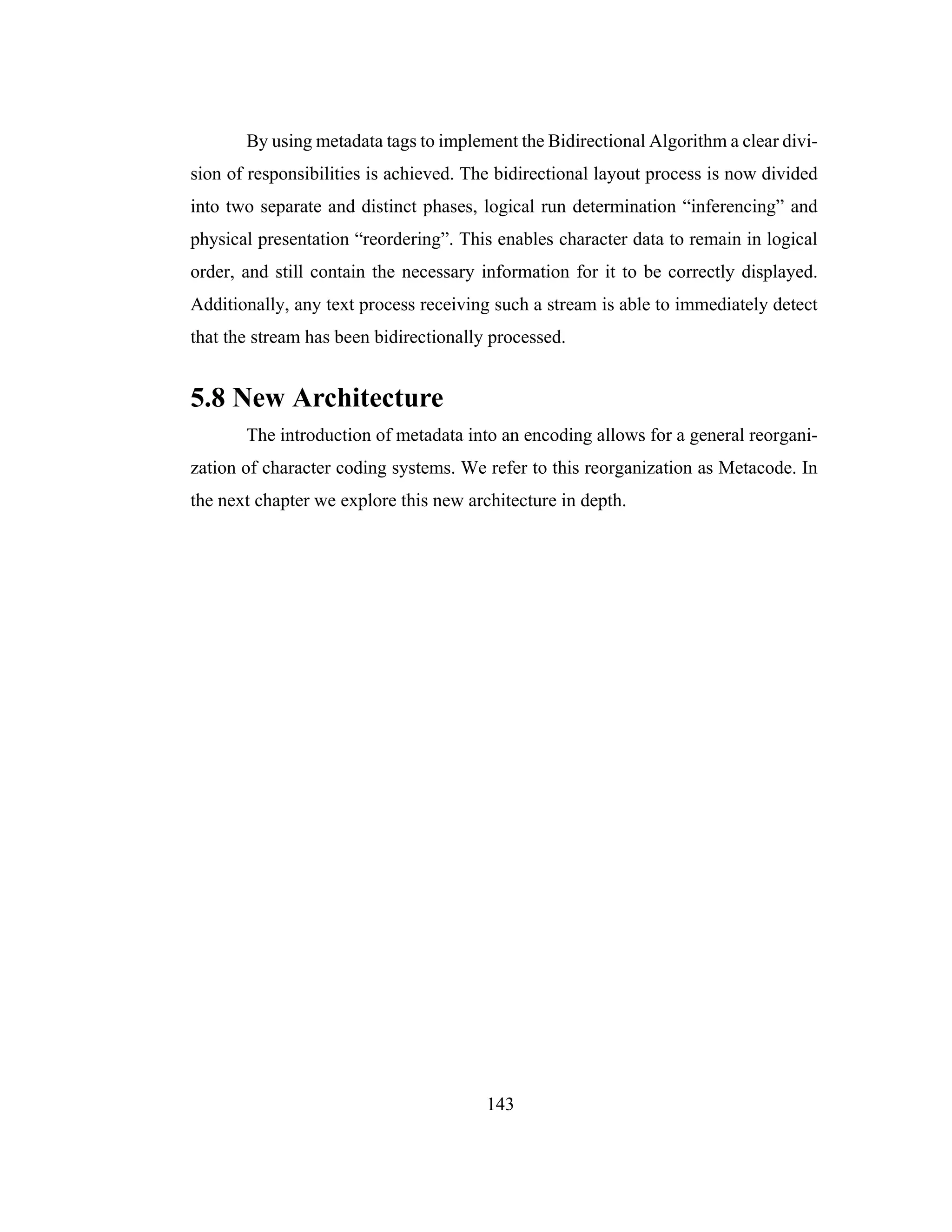
![144
6Metacode
In this chapter we present both a new coded character set and text encoding
framework that enables a separation of concerns, we call this the Metacode system.
In the Metacode information processing system, concepts (policies) are separate and
distinct from implementation (mechanism). Metacode at its core is an architecture for
describing written natural language data. Metacode permits various ideas, concepts
and policies to coexist, while still remaining efficient. The key advantage this new
architecture offers over current models is its ability to unambiguously separate con-
tent from control. In Metacode only characters that express raw content are encoded.
In particular, Metacode does not encode controls, ligatures, glyph variants, and half-
width forms. By only encoding “pure” characters, Metacode places a greater empha-
sis on content. In this chapter we make recommendations and take the first steps
towards implementing an architecture for multilingual information processing.
6.1 Metacode Architecture
Figure 6-1 presents the layers in the new text framework we propose. Meta-
code is built upon the same general principles used in the Open Systems Interconnec-
tion (OSI) network layer model [90]. In particular the architecture is designed around
the following notions:
• A layer is created when a different level of abstraction is required.
• Each layer performs a well defined function.
• The number of layers is large enough to allow for a clean separation of responsi-
bilities, but not so small as to group unrelated functions together out of necessity.](https://image.slidesharecdn.com/0f3c79e3-c95a-412c-8137-2676e0a933c3-161215183642/75/cs-2002-01-158-2048.jpg)

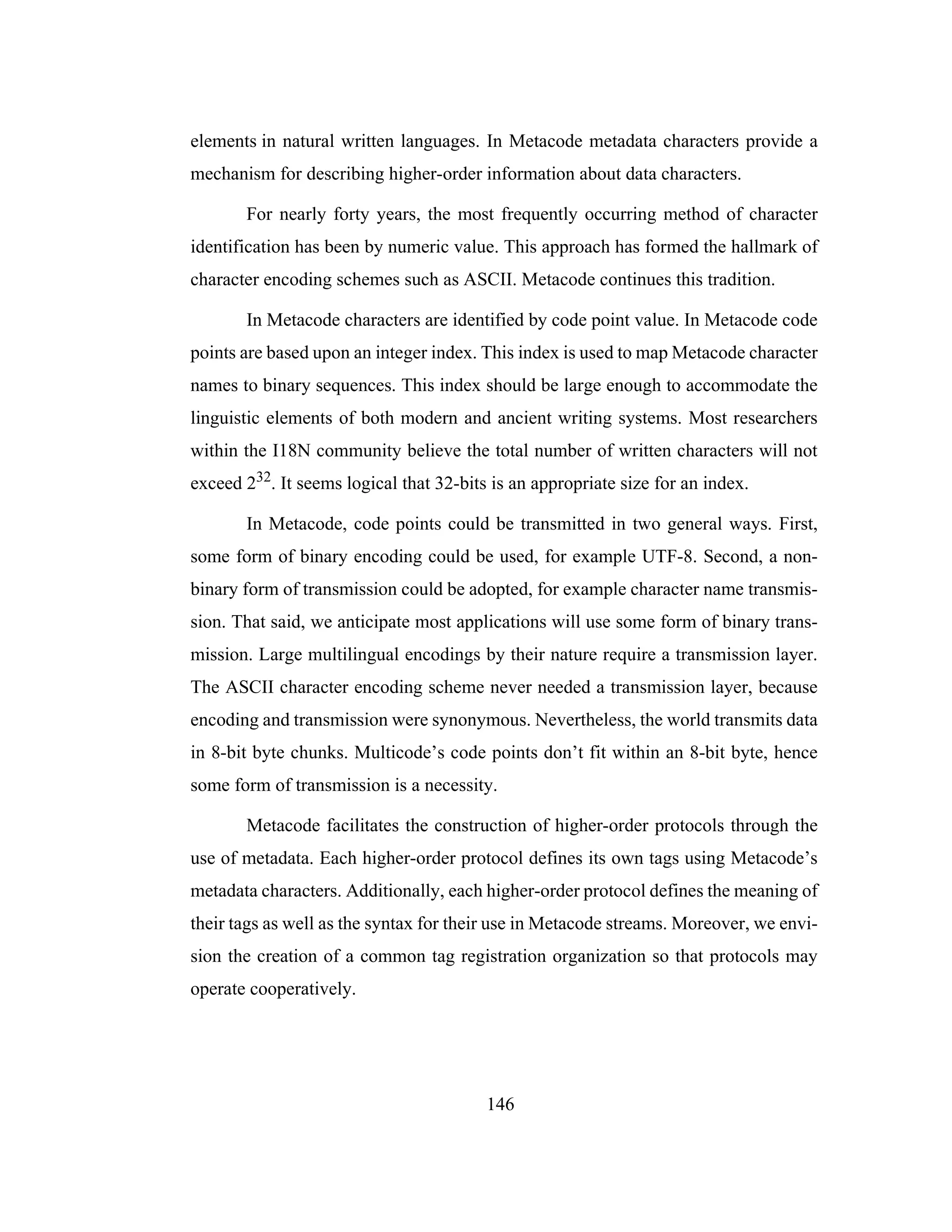
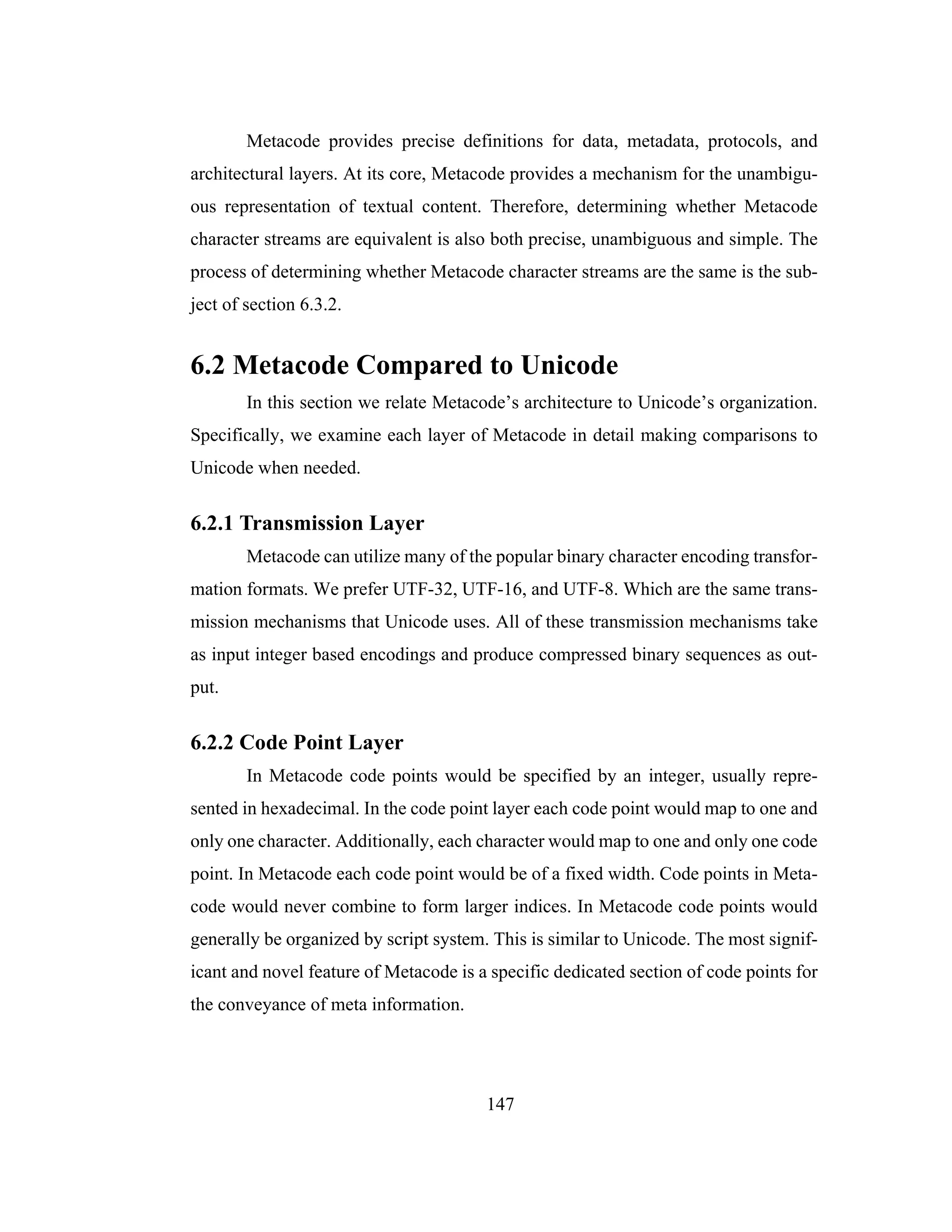
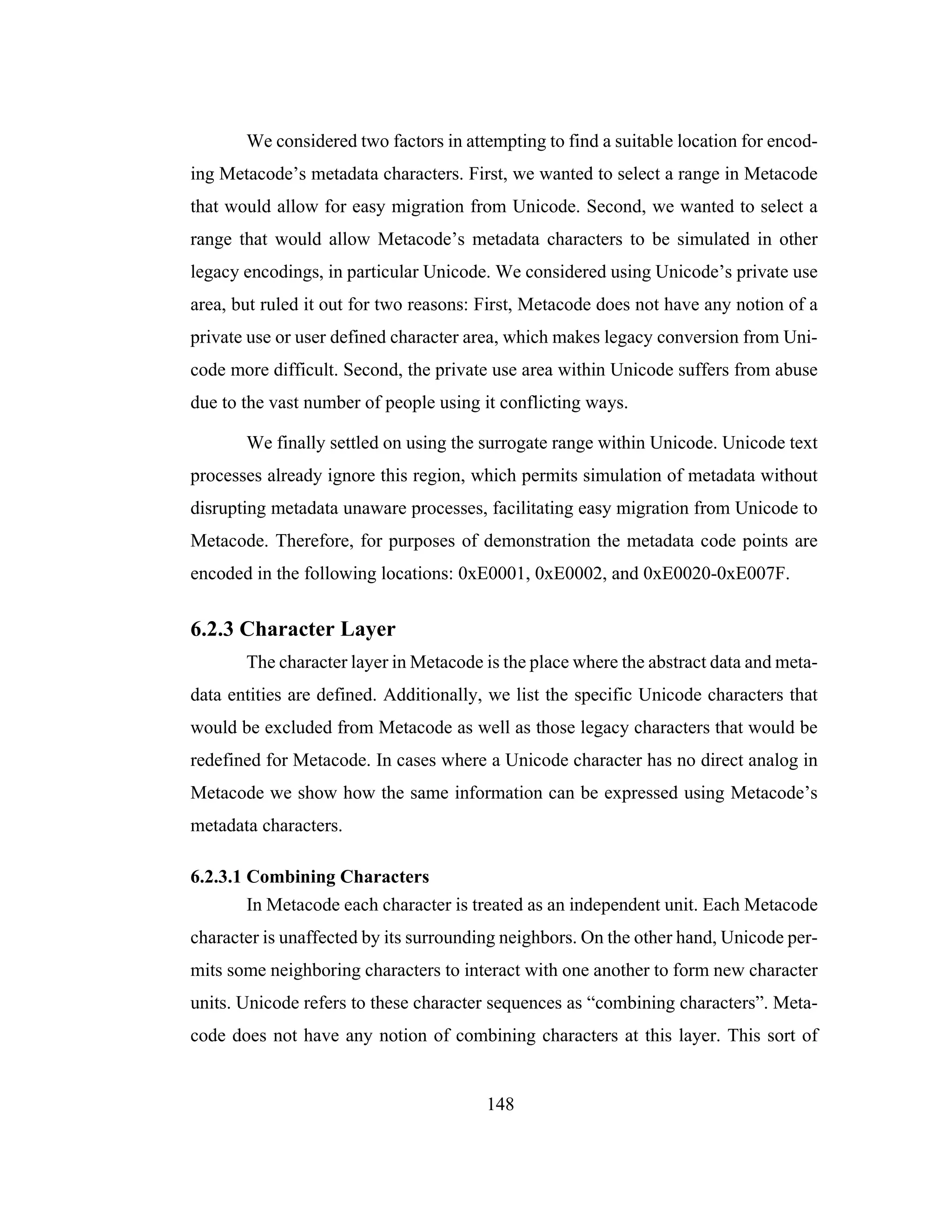
![149
interaction occurs within higher-order protocols. Therefore, we would not include
any of Unicode’s combining characters in Metacode. The Metacode stream on line 1
on Figure 6-2 illustrates the use of a higher-order protocol for the purpose of indicat-
ing combining characters.
Figure 6-2. Combining character protocol
ELM@CMBw¨/ELM — w diaeresis (1)
Table 6-1 lists the Unicode characters that would not be encoded in Meta-
code. The first column in Table 6-1 contains the excluded Unicode combining char-
acters, the second column specifies the name of each character, while the third
column contains the non-combining form for each character listed in the first column.
[96]
In Metacode we would still like to be able to use the combining characters as
pure data (content) minus their joining protocol, because in many instances these
characters represent linguistic elements. To accomplish this we would redefine the
combining characters for Metacode. In our redefinition these characters would be
“pure”, hence they would posses no special combining property. See Table 6-2 [96].
The first column in Table 6-2 lists the range of code points that would be redefined
in Metacode. The second column list the type of characters that these code points rep-
resent.
In cases where a non-combining legacy character, mostly diacritic marks,
already exists we would use it, rather than the newly redefined character. See
Table 6-1. We take this approach for two reasons. First, if legacy Unicode text con-
tained a diacritic character then there is a greater likelihood that they used the non-
combining form of the character, because few text processes actually support com-](https://image.slidesharecdn.com/0f3c79e3-c95a-412c-8137-2676e0a933c3-161215183642/75/cs-2002-01-163-2048.jpg)
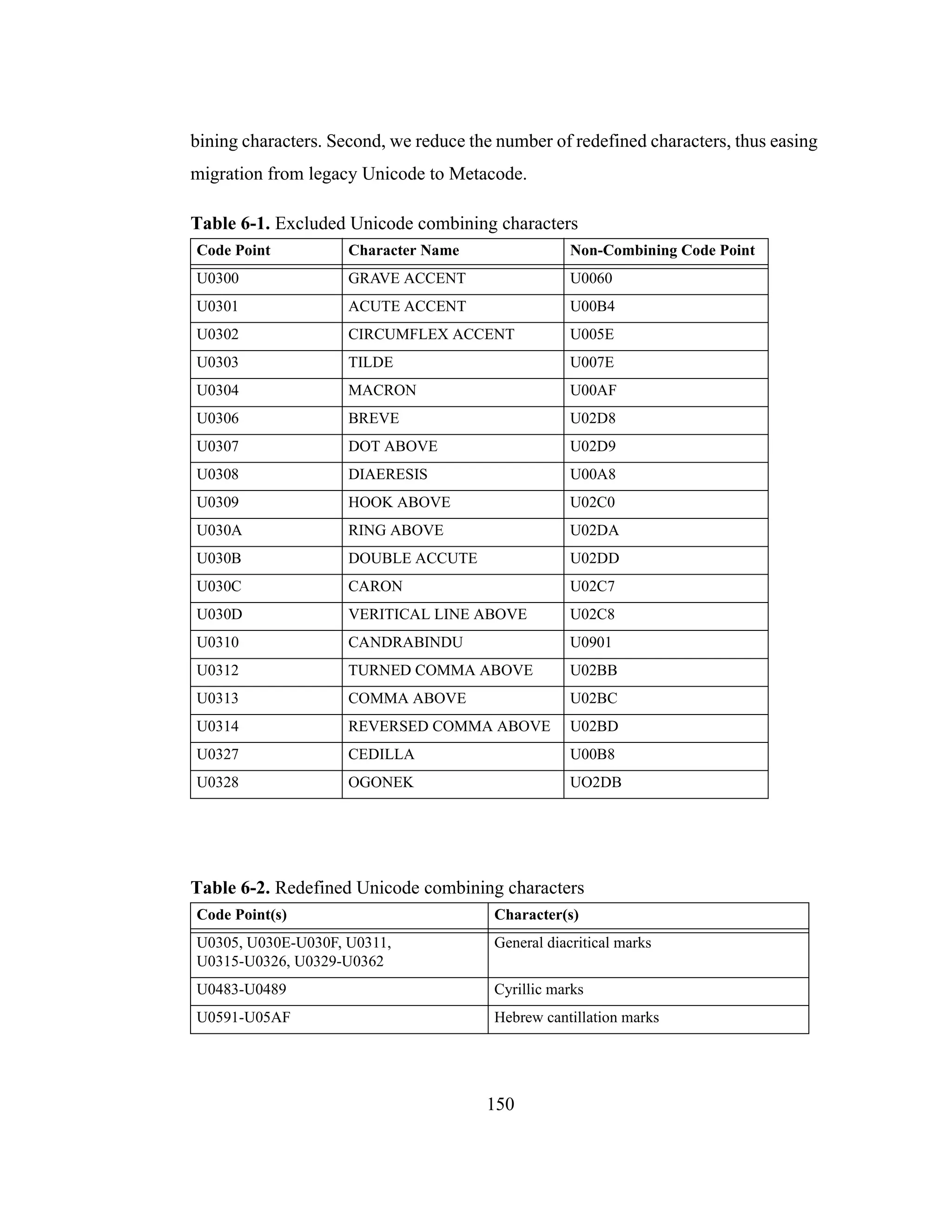

![152
6.2.3.2 Glyph Variants
In Metacode there is no notion of glyph specific characters. This means that
Metacode would not encode ligatures or specially shaped versions of characters.
Therefore, Metacode would not incorporate any Unicode characters that are glyph
composites or glyph variations of existing nominal characters. See Table 6-3 [96].
On the other hand, Metacode would provide a controlled mechanism for describing
such information. In metacode, glyph variations would be specified by using
U0E48-U0E4B Thai tone marks
U0E4C-U0E4E Thai signs
U0EB1, U0EB4-U0EBB Lao vowels
U0EBC, U0ECC-U0ECD Lao signs
U0EC8-U0ECB Lao tone marks
U0F35,U0F37, U0F39, U0F3E-U0F3F,
U0F82-U0F84, U0F86-U0F87
Tibetan marks and signs
U0F71-U0F7D, U0F80-U0F81 Tibetan vowels
U0F7E-U0F7F Tibetan vocalic modifiers
U0F90-U0FBC Tibetan subjoined consonants
U102C-U1032 Myanmar vowels
U1036-U1039 Myanmar signs
U1056-U1059 Myanmar volcalic modifiers
U17B4-U17C5 Khmer vowels
U17C6-U17C8, U17CB-U17D3 Khmer signs
U17C9-U17CA Khmer consonant shifters
U18A9 MONGOLIAN LETTER ALI GALI DAGALA
U20D0-U20E3 Diacritical marks for symbols
U302A-U302F Ideographic diacritics
U3099-U309A Hiragana voicing marks
UFE20-UFE23 Half marks
Table 6-2. Redefined Unicode combining characters (Continued)
Code Point(s) Character(s)](https://image.slidesharecdn.com/0f3c79e3-c95a-412c-8137-2676e0a933c3-161215183642/75/cs-2002-01-166-2048.jpg)
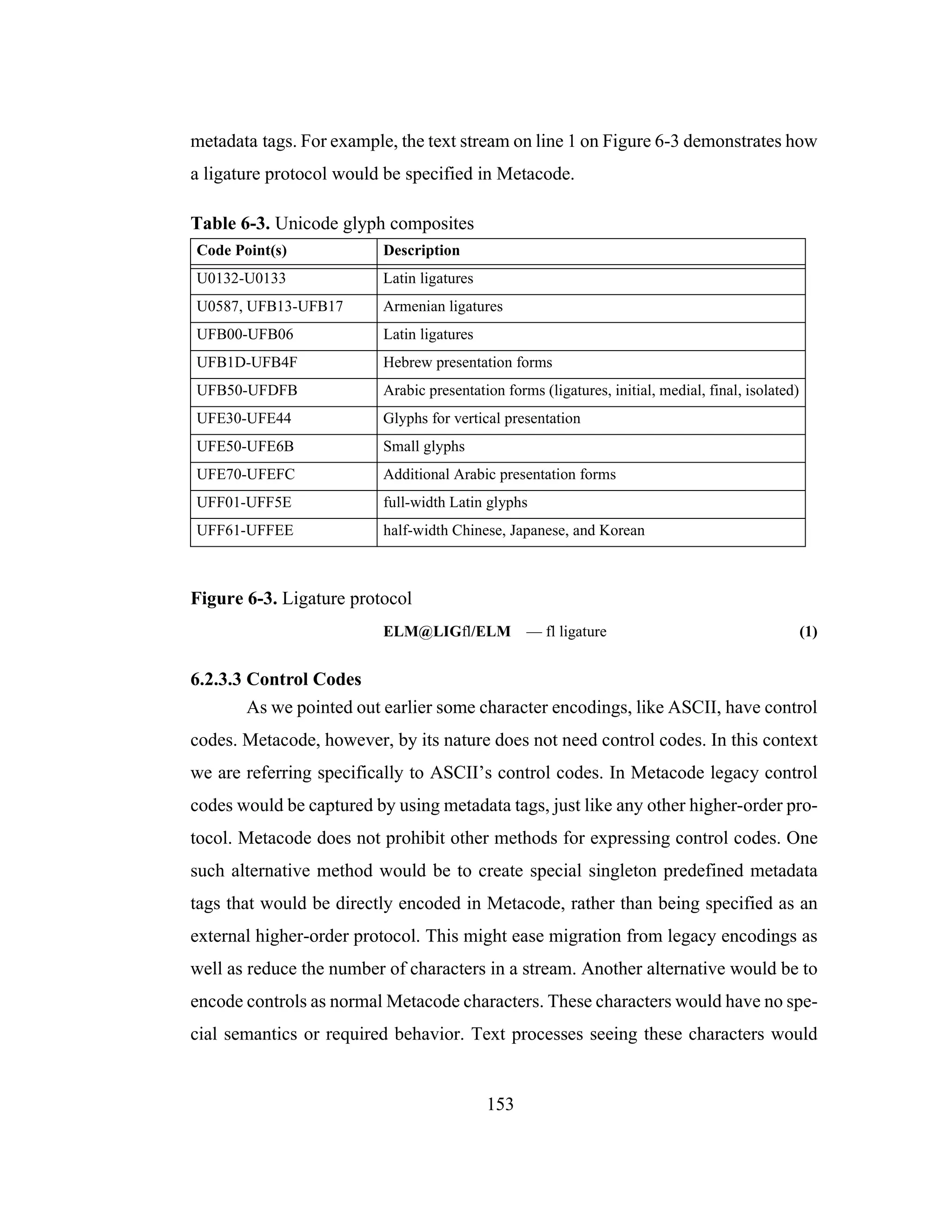
![154
have the freedom to treat them just like any other character or to assign them special
properties and behavior. It would be wise to limit these single meta characters other-
wise we would just recreate all the problems with Unicode.
Occasionally there are some characters in legacy encodings that do not appear
to be control codes, but behave as if they really are. For example, there are several
characters encoded in Unicode for the purpose of indicating a break or space. See
Table 6-4 [96]. The primary difference between each of these spacing characters is
the amount of space to insert. For the most part these characters were encoded for his-
torical reasons. Nonetheless, in Metacode we would not explicitly encode these char-
acters. We would argue that the ideas expressed in these characters are best described
as a higher-order protocol. In Metacode we would only encode a single space char-
acter. The single space character could be wrapped around a metadata tag that spec-
ified the exact amount of space to insert, which could be none. For example, the text
stream on line 1 on Figure 6-4 demonstrates how a spacing protocol would be spec-
ified in Metacode. In order to aid comprehension the space character is represented
by its code point value 0x0020.
Table 6-4. Unicode spacing characters
Code Point Description
U2000 EN QUAD SPACE
U2001 EM QUAD SPACE
U2002 EN SPACE
U2003 EM SPACE
U2004 THREE PER EM SPACE
U2005 FOUR PER EM SPACE
U2006 SIX PER EM SPACE
U2007 FIGURE SPACE
U2008 PUNCTUATION SPACE
U2009 THIN SPACE
U200A HAIR SPACE](https://image.slidesharecdn.com/0f3c79e3-c95a-412c-8137-2676e0a933c3-161215183642/75/cs-2002-01-168-2048.jpg)
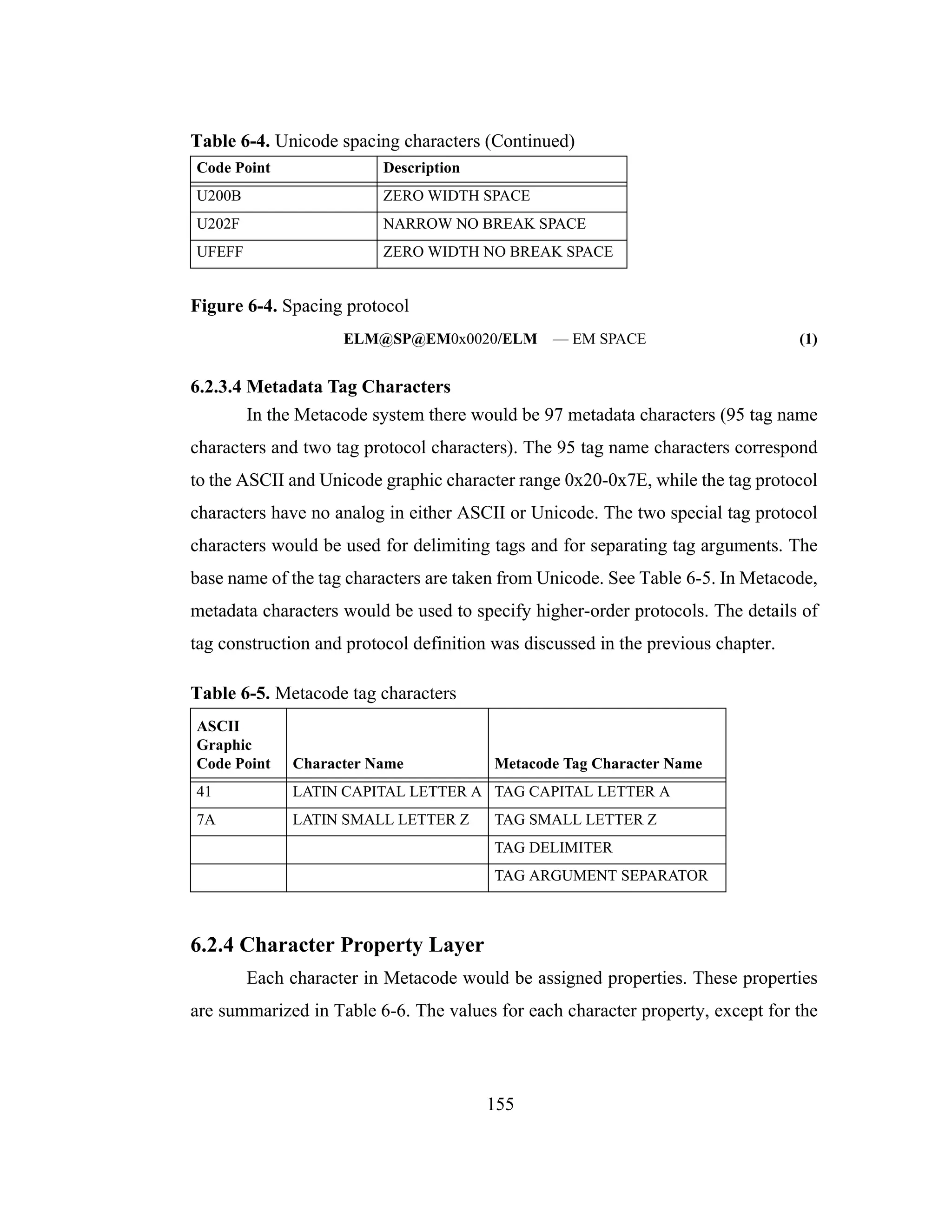
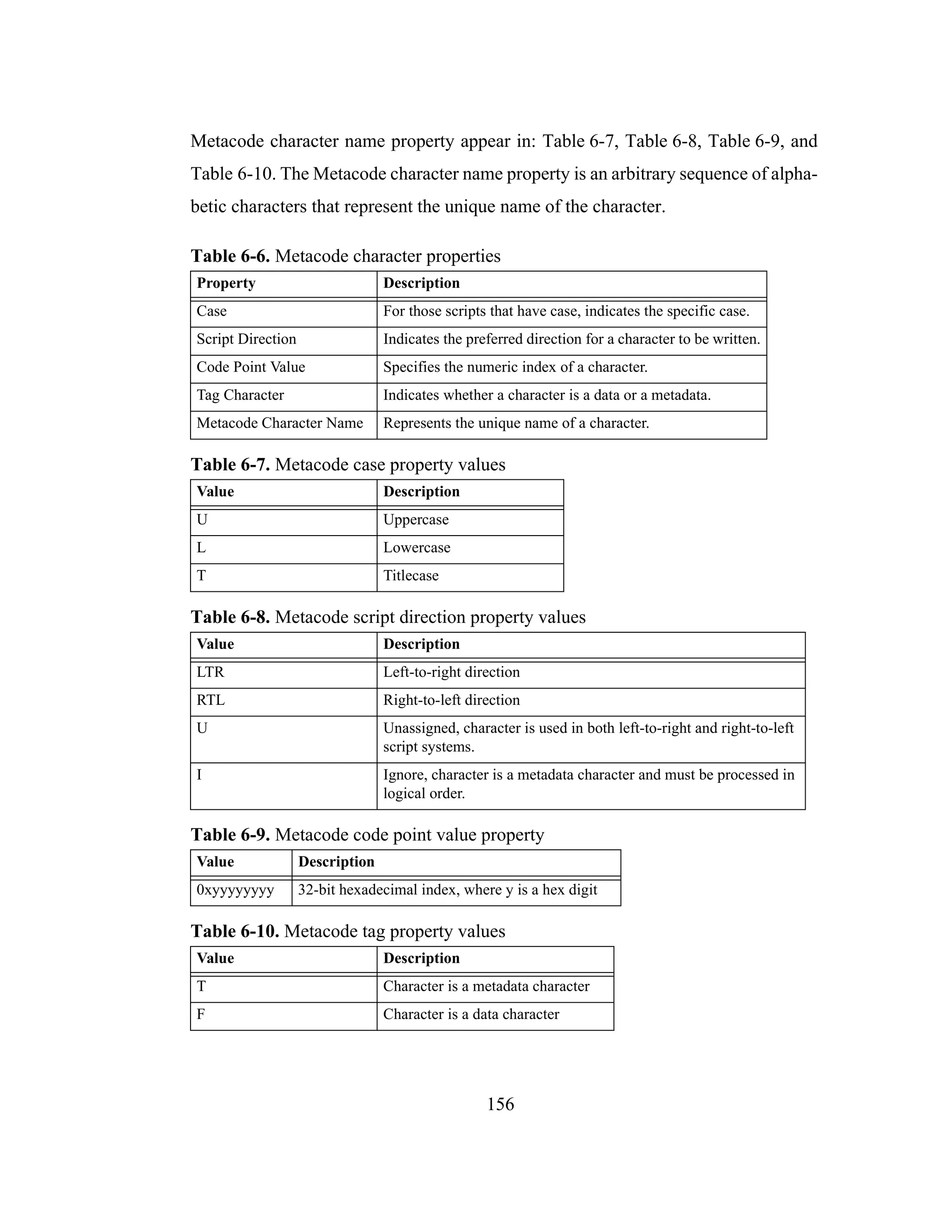

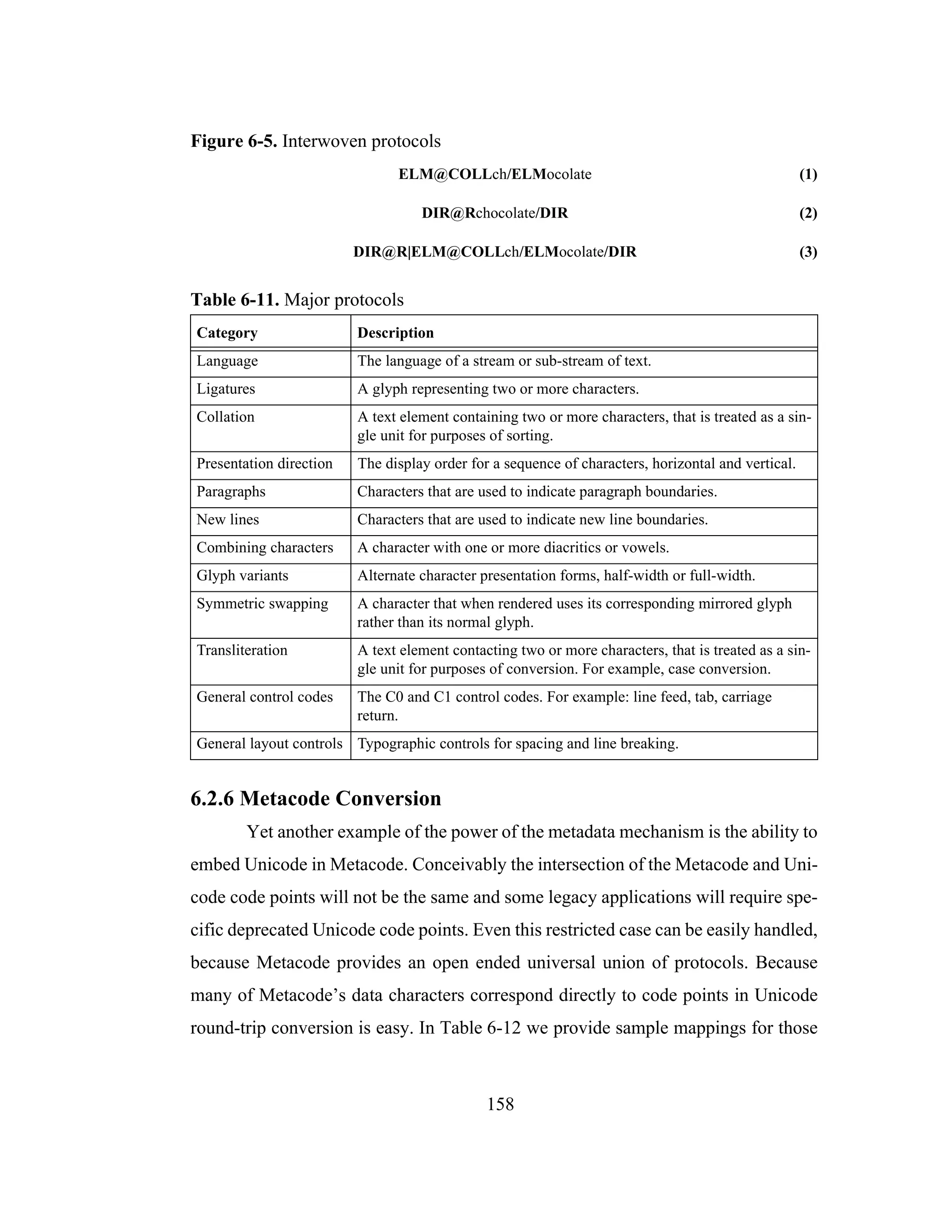
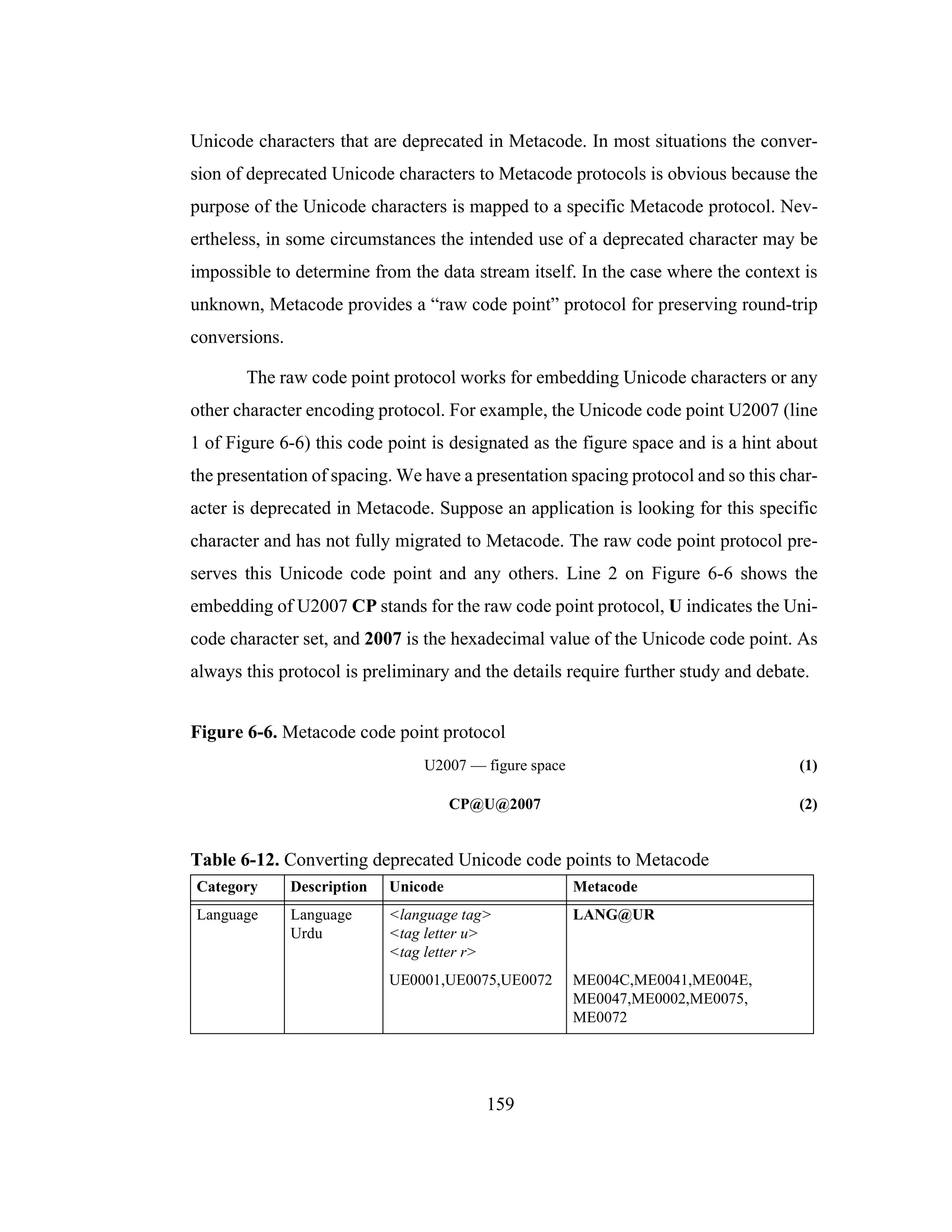
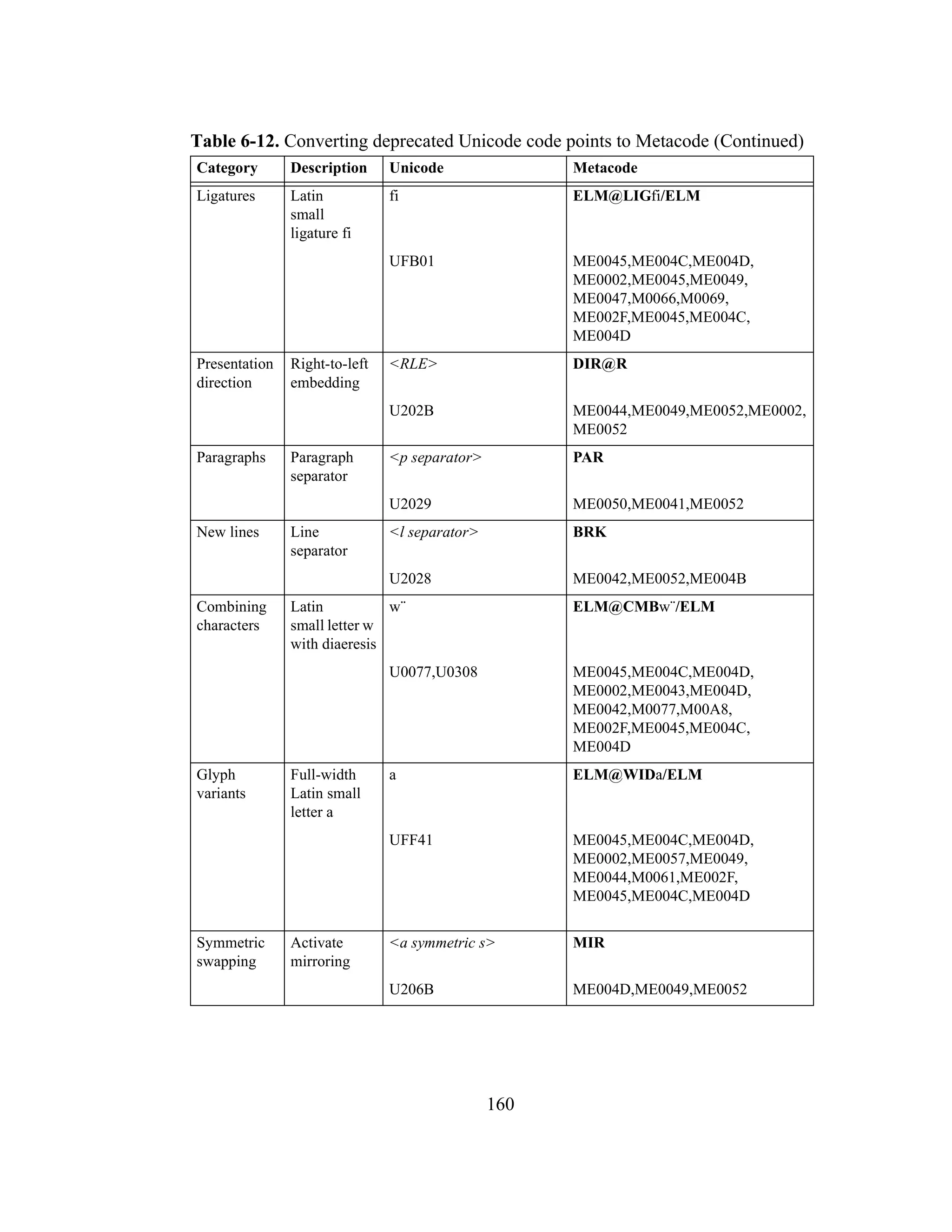

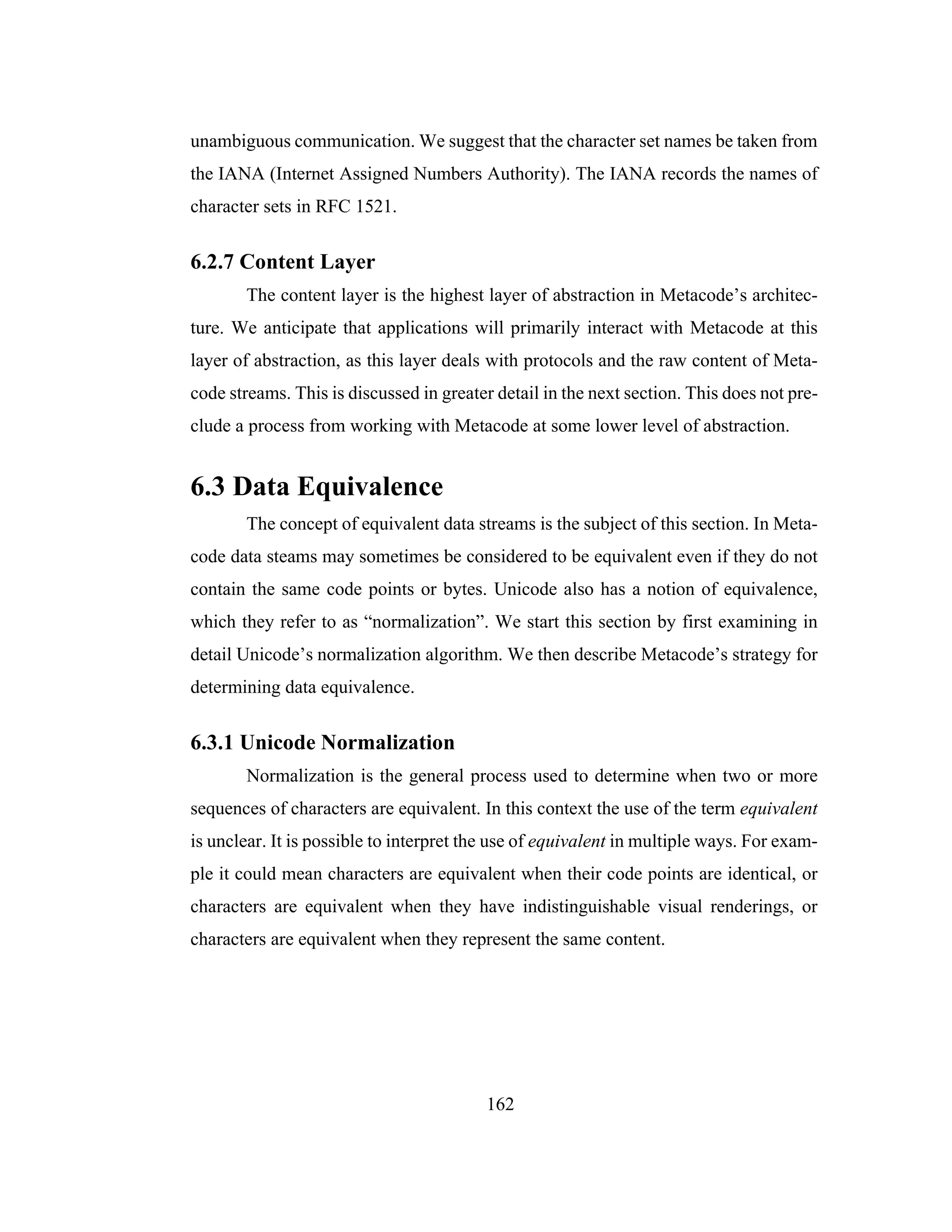
![163
Figure 6-8. Non interacting diacritics
c¸^ U0063,U0327,U0302 (1)
c^¸ U0063,U0302,U0327 (2)
þ (3)
Unicode supports two broad types of character equivalence, canonical and
compatibility. In canonical equivalence the term equivalent means character
sequences that exhibit the same visual rendering. For example, the character
sequences on lines 1 and 2 on Figure 6-8 both produce identical renderings, shown
on line 3. [101]
In compatibility equivalence the term equivalent is taken to mean characters
representing the same content. For example, line 1 on Figure 6-9 shows the single ü
ligature while line 2 on Figure 6-9 shows the compatible two character sequence f and
i. In this case both sequences of characters represent the same semantic content. The
only difference between the two is whether or not a ligature is used during render-
ing.[101]
Figure 6-9. Compatibility equivalence
ü UFB01 (1)
fi U0066,U0069 (2)
6.3.1.1 Unicode Normal Forms
Unicode defines four specific forms of normalization based upon the general
canonical and compatibility equivalences. These forms are listed on Table 6-13; the](https://image.slidesharecdn.com/0f3c79e3-c95a-412c-8137-2676e0a933c3-161215183642/75/cs-2002-01-177-2048.jpg)
![164
title column indicates the name of the normal form, while the category column indi-
cates the equivalence type. [101]
Normalization form NFD substitutes precomposed characters with their
equivalent canonical sequence. Characters that are not precomposed are left as is.
Diacritics (combining characters), however are subject to potential reordering. This
reordering only occurs when sequences of diacritics that do not interact typographi-
cally are encountered, those that do interact are left alone. [101]
In Unicode each character is assigned to a combining class. Non Combining
characters are assigned to the zero combining class, while combining characters are
assigned a positive integer value. The reordering of combining characters operates
according to the following three rules:
• Lookup the combining class for each character.
• For each pair of adjacent characters AB, if the combining class of B is not zero
and the combining class of A is greater than the combining class of B, swap the
characters.
• Repeat step 2 until no more exchanges can be made.
Table 6-13. Normalization forms
Title Category Description
Normalization
Form D (NFD)
Canonical = visually equivalent Canonical Decomposition
Normalization
Form C (NFC)
Canonical Decomposition followed by
Canonical Composition
Normalization
Form KD
(NFKD)
Compatibility = same content Compatibility Decomposition
Normalization
Form KC
(NFKC)
Compatibility Decomposition followed by
Canonical Composition](https://image.slidesharecdn.com/0f3c79e3-c95a-412c-8137-2676e0a933c3-161215183642/75/cs-2002-01-178-2048.jpg)
![165
After all of the precomposed characters are replaced by their canonical equiv-
alents and all non interacting combining characters have been reordered the sequence
is then said to be in NFD.[96]
Normalization form NFC uses precomposed characters where possible, main-
taining the distinction between characters that are compatibility equivalents. Most
sequences of Unicode characters are already in NFC. To convert a sequence of char-
acters into NFC the sequence is first placed into NFD. Each character is then exam-
ined to see if it should be replaced by a precomposed character according to the
following rule.
• If the character can be combined with the last character whose combining class
was zero, then replace the sequence with the appropriate precomposed character.
After all of the diacritics that can be combined with base characters are replaced by
precomposed characters, the sequence is said to be in NFC. [101]
Normalization form NFKD replaces precomposed characters by sequences of
combining characters and also replaces those characters that have compatibility map-
pings. In this normal form formatting distinctions may be lost. Additionally the abil-
ity to perform round trip conversion with legacy character encodings may be
impossible, because of the loss of formatting. Normalization form NFKC replaces
sequences of combining characters with their precomposed forms while also replac-
ing characters that have compatibility mappings. [101]
There are some characters encoded in Unicode that need to be ignored during
normalization. In particular, the bidirectional controls, the zero width joiner and non
joiner. These characters are used as format effectors. The joiners can be used to pro-
mote or inhibit the formation of ligatures. Unicode does not provide definitive guid-
ance as to when these characters can be safely ignored in normalization. Unicode
only states these characters should be filtered out before storing or comparing pro-
gramming language identifiers. [101]](https://image.slidesharecdn.com/0f3c79e3-c95a-412c-8137-2676e0a933c3-161215183642/75/cs-2002-01-179-2048.jpg)
![166
To assist in the construction of the normal forms, Unicode maintains a data
file listing each Unicode character along with any equivalent canonical or compatible
mappings. Algorithms that wish to perform normalization must use this data file. By
having all normalization algorithms rely on this data, the normal forms are guaran-
teed to remain stable over time. If this were not the case it would be necessary to com-
municate the version of the normalization algorithm along with the resultant normal
form. [101]
6.3.1.2 Unicode Normalization Algorithm
The best way to illustrate the use of normal forms is through an example.
Consider the general problem of searching for a string. In particular, assume that a
text process is searching for the string “flambé”. Table 6-14 lists just some of the pos-
sible ways in which the string “flambé” could be represented in Unicode.
Table 6-14. The string “flambé”
# Code Points Description
1 U0066,U006C,U0061,U006D,U0062,
U0065,U0301
decomposed
2 U0066,U006C,U0061,U006D,U0062,
U00E9
precomposed
3 UFB02,U0061,U006D,U0062,U00E9 fl ligature, precomposed
4 UFB02,U0061,U006D,U0062,U0065,
U0301
fl ligature, decomposed
5 UFF46,UFF4C,UFF41,UFF4D,UFF42,
U00E9
full-width, precomposed
6 UFB02,UFF41,UFF4D,UFF42,U00E9 fl ligature, full-width, precomposed
7 U0066,U200C,U006C,U0061,U006D,
U0062,U00E9
ligature supression,
precomposed
8 U0066,U200C,U006C,U0061,U006D,
U0062,U0065,U0301
ligature suppression,
decomposed
9 U0066,U200D,U006C,U0061,U006D,
U0062,U00E9
ligature promotion, precomposed](https://image.slidesharecdn.com/0f3c79e3-c95a-412c-8137-2676e0a933c3-161215183642/75/cs-2002-01-180-2048.jpg)
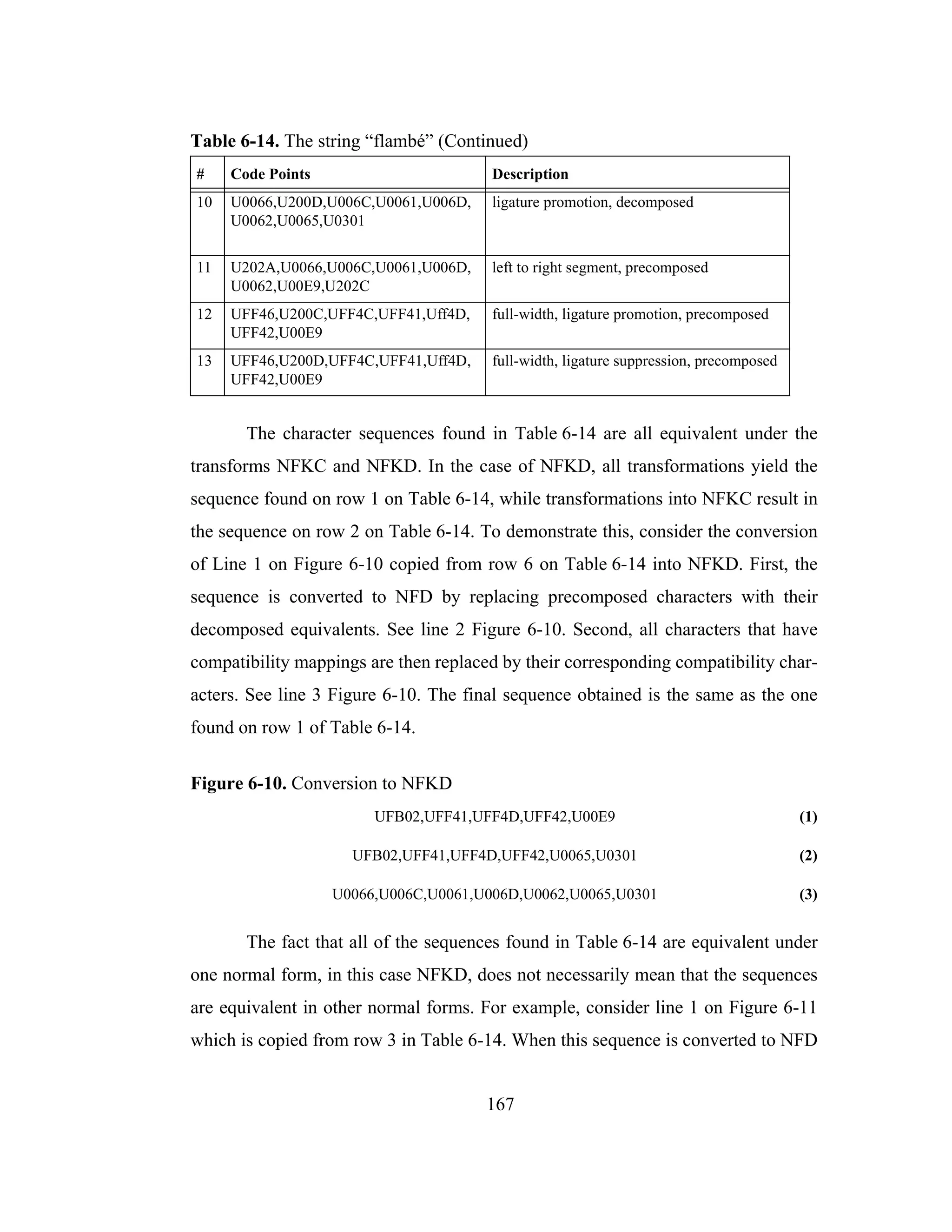
![168
the result is line 2 on Figure 6-11. This does not match the sequence on row 1 of
Table 6-14, therefore these sequences are not equivalent under NFD.
Figure 6-11. Conversion to NFD
UFB02,U0061,U006D,U0062,U00E9 (1)
UFB02,U0061,U006D,U0062,U0065,U0301 (2)
Thus far we have explored the details of data equivalence in Unicode. We
now examine some of the problems that are caused by Unicode’s normalization
forms. In particular, we consider the interaction between the normalization process
and other Unicode algorithms.
6.3.1.3 Problems with Unicode Normalization
The overall complexity of normalization presents serious problems for gen-
eral searching and pattern matching. Without a single normalization form, it is not
possible to determine reliably whether or not two strings are identical. The W3C
(World Wide Web Consortium) has advocated adopting Unicode’s NFC for use on
the web. Additionally, W3C recommends that normalization be performed early (by
the sender) rather than late (by the recipient). Their recommendation is to be conser-
vative in what you send, while being liberal in what you accept. The major arguments
for taking this approach are: [107]
• Almost all data on the web is already in NFC.
• Most receiving components assume early normalization.
• Not all components that perform string matching can be expected to do normal-
ization.
There are some problems with this strategy, however. It assumes that the pri-
mary purpose of normalization is to determine whether two sequences have identical
renderings which is appropriate for display but inappropriate for information proces-
ing. In Unicode’s NFC any and all formatting information is retained. This causes](https://image.slidesharecdn.com/0f3c79e3-c95a-412c-8137-2676e0a933c3-161215183642/75/cs-2002-01-182-2048.jpg)
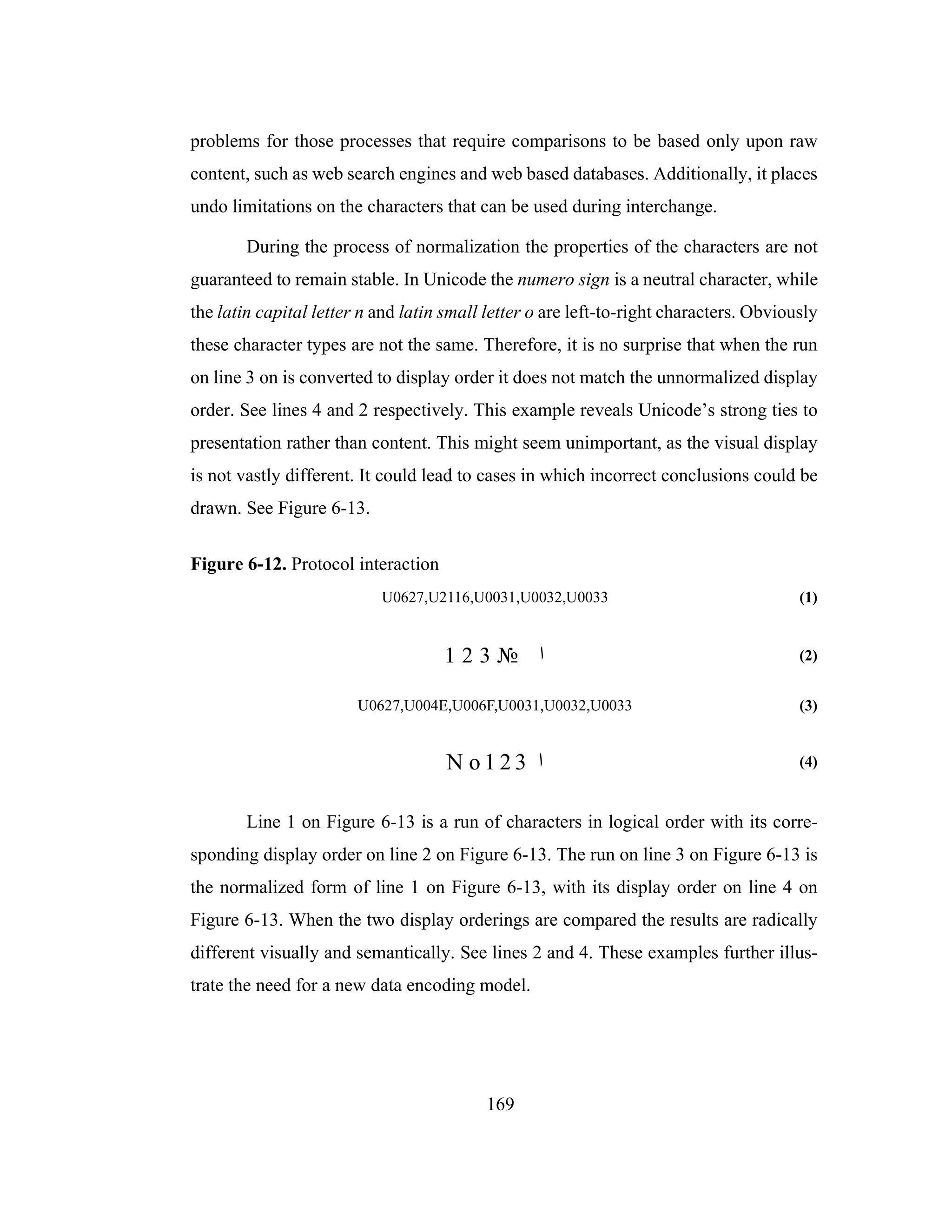
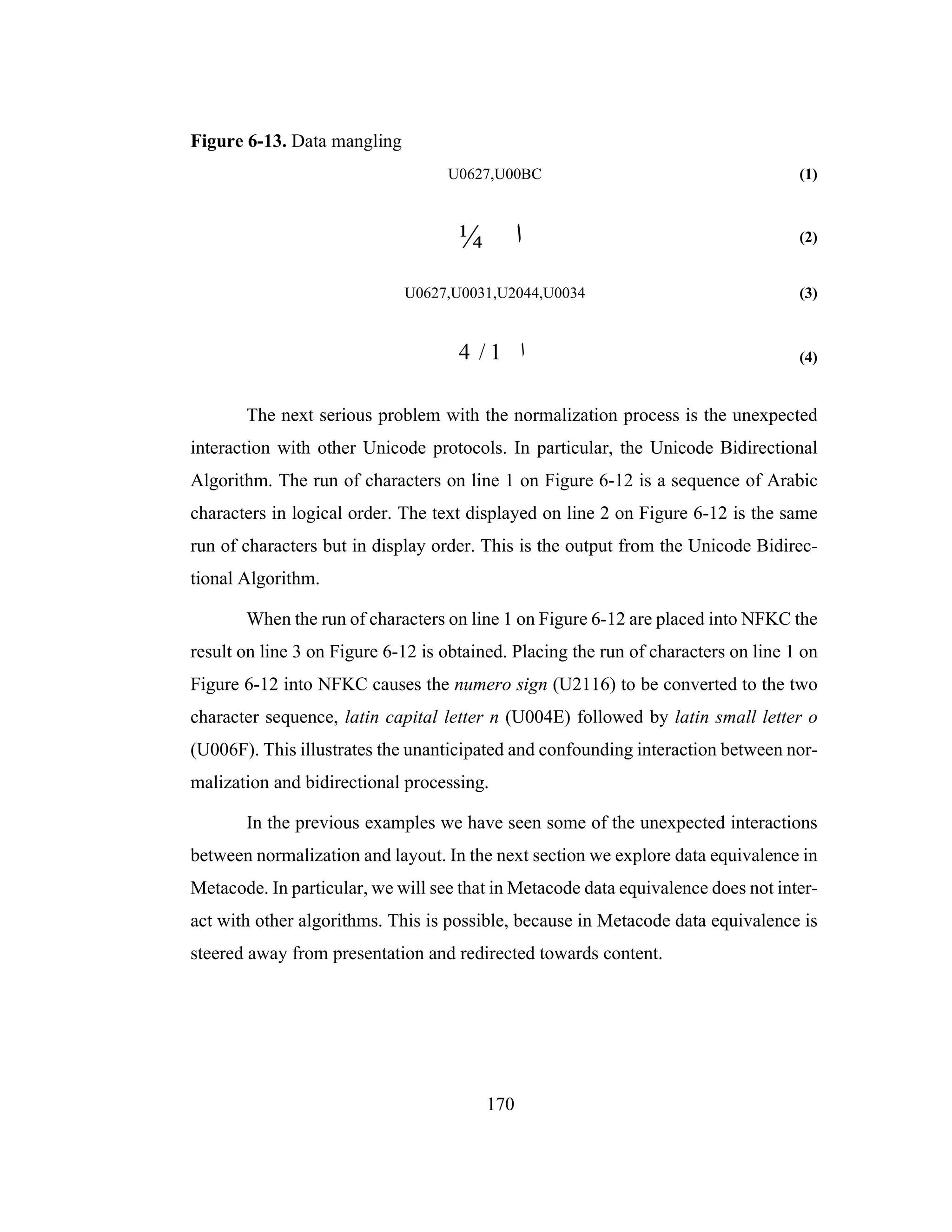
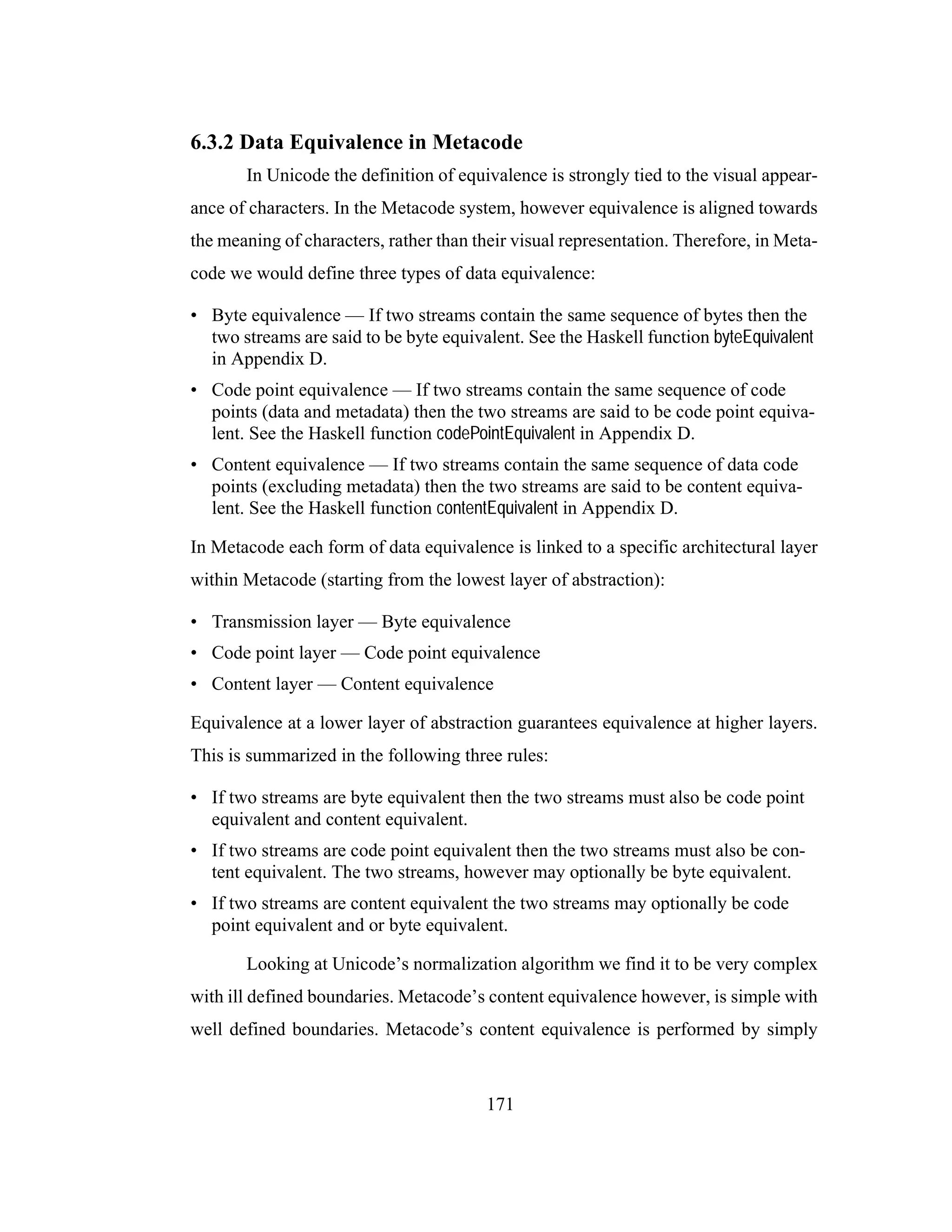

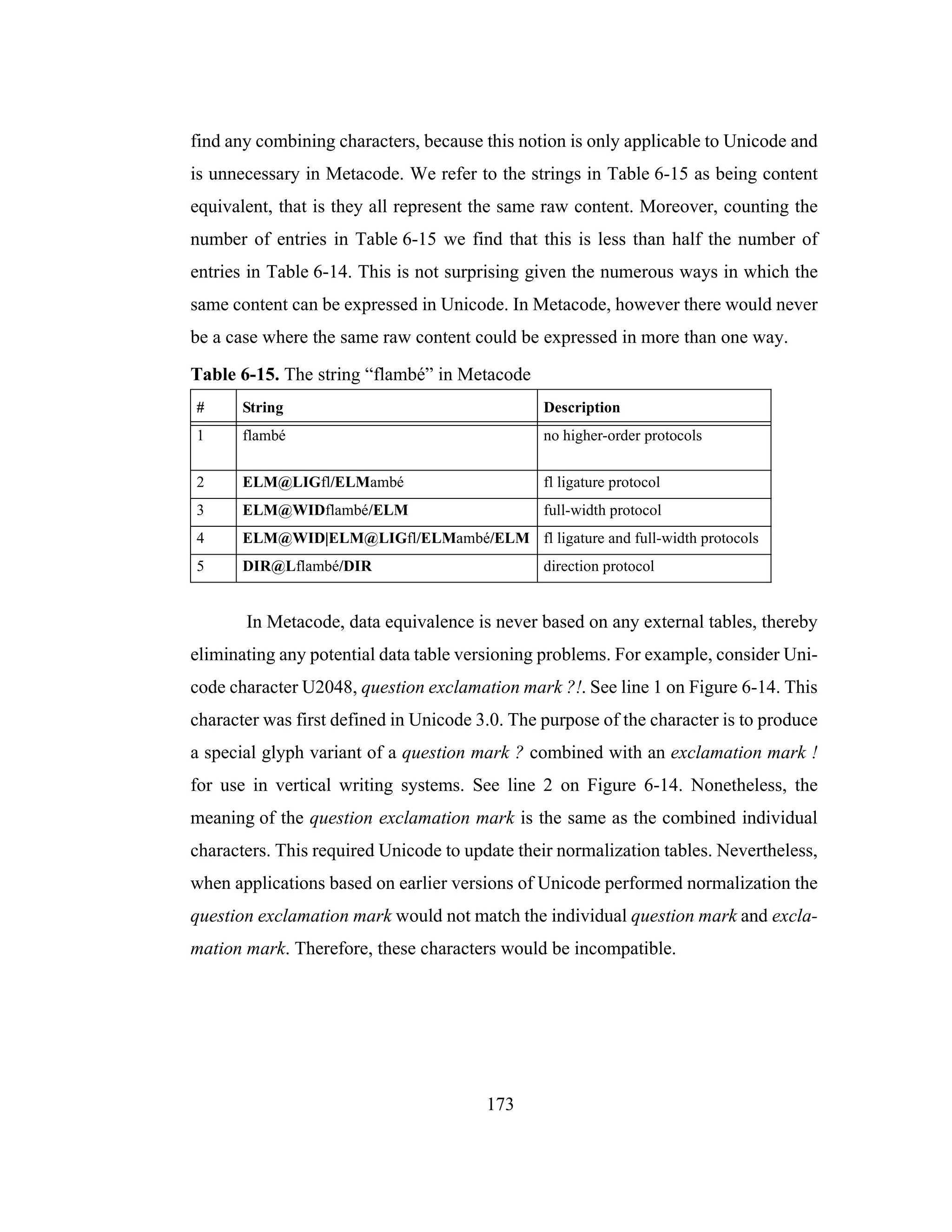
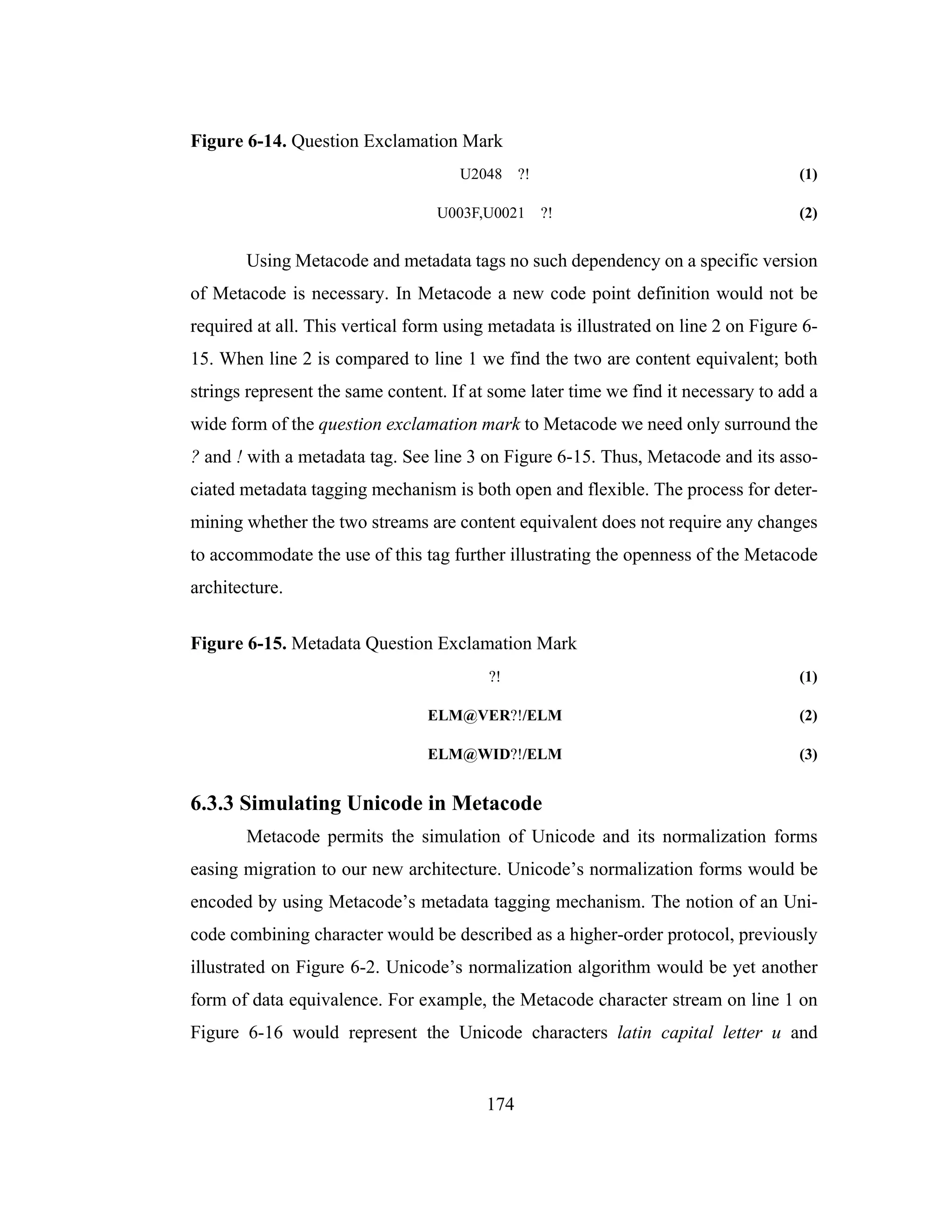
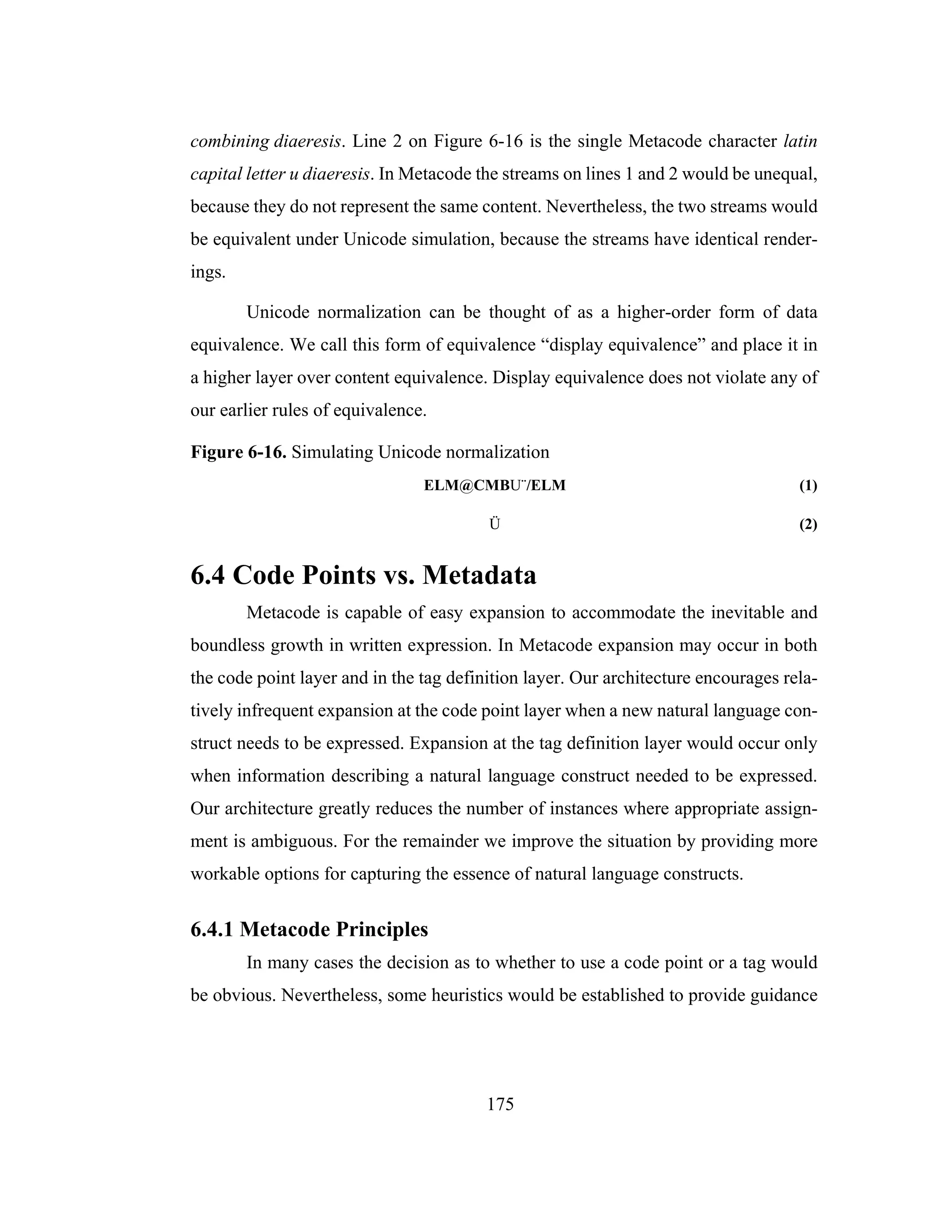
![176
with these decisions. For example, the following heuristics are indicators for encod-
ing a concept as a code point:
• The concept represents a natural language construct.
• The concept represents a fundamental element of some formal system.
The following list are indicators for encoding concepts as protocols, rather than as
code points.
• The concept is a stylistic variation of an already existing code point.
• The concept is used for signaling or control of some higher-order process.
• The concept causes the semantics of code points to change.
• The concept provides meta information about an existing code point.
• The concept is a specialization or generalization of an already existing tag.
6.4.2 Applying Metacode Heuristics
Bellow we illustrate how these Metacode heuristics would be applied to
encoding new objects within Metacode. We examine situations in which the decision
is easy to make as well as those in which the decision is less clear.
6.4.2.1 Natural language text
First, we explore the case where the decision as to whether to use a code point
or a tag is unambiguous. Let us look at the task of encoding Egyptian Hieroglyphic
symbols in Metacode. The Egyptian hieroglyphic symbols are divided into two
classes, phonograms and ideographs. Phonograms are used to write the sounds of the
language. The value of the sound was usually obtained from the name of the object
being depicted. The hieroglyphic symbol “foot” on Figure 6-17 represents a conso-
nant that is pronounced as the letter “b” in English. As the “foot” object is both an
element of a natural language (Egyptian) and an element of a formal system (hiero-
glyphics). It would be encoded as a code point. [17], [80]](https://image.slidesharecdn.com/0f3c79e3-c95a-412c-8137-2676e0a933c3-161215183642/75/cs-2002-01-190-2048.jpg)
![177
Figure 6-17. Egyptian hieroglyphic phonogram
In Egyptian, ideographs represent either the actual object being depicted or a
closely related idea. For example, consider the hieroglyphic symbol “ra” on Figure
6-18. The symbol ra stands for the sun. Even though this is not a phonogram, the ra
symbol is an element of written natural language and would also be encoded as a code
point.
Figure 6-18. Egyptian hieroglyphic ideograph
6.4.2.2 Mathematics
There currently exists several systems for representing mathematical docu-
ments, such as TeX, Mathematica, and MathML [65]. These systems, however, deal
with the representation of mathematics at the document level and not at the character
level. Unicode has recently taken steps to fill this gap by encoding a set of characters
within the surrogate range specifically designed for mathematics. These
mathematical characters include bold, italic and script Latin letters, bold and italic
Greek letters, and bold and italic European numerals [98]. Metacode would not
include such characters because such information is captured by Metacode’s higher-
order protocols. Unicode’s mathematical characters are really stylistic variations of
already encoded characters. On the other hand, it is true that the semantics of the
mathematical characters differ from the basic Latin, Greek, and European numerals.
In Metacode we would not prevent such semantics from being expressed, rather we](https://image.slidesharecdn.com/0f3c79e3-c95a-412c-8137-2676e0a933c3-161215183642/75/cs-2002-01-191-2048.jpg)
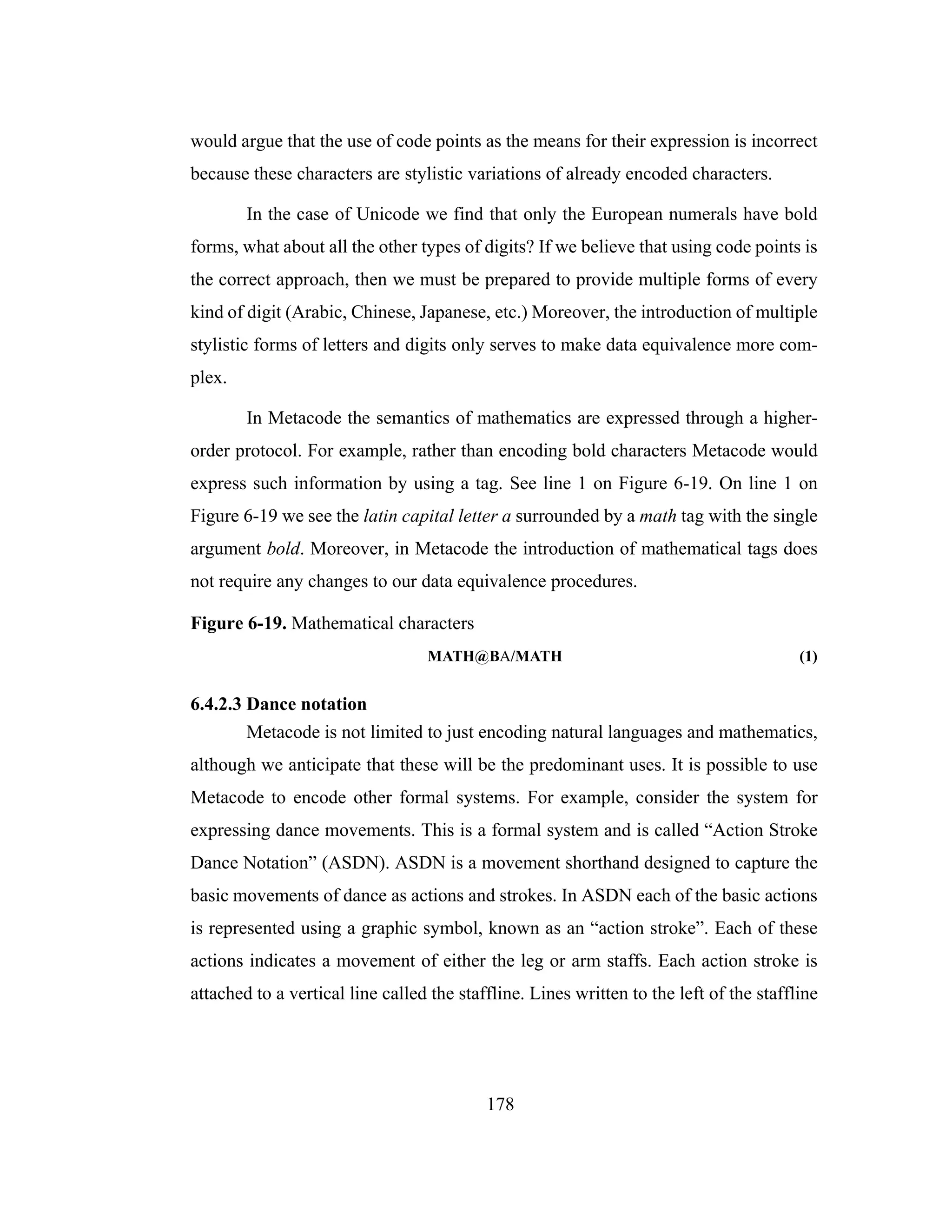
![179
signal a movement of a left limb, while lines written to the right signal a movement
of a right limb. [19]
In the illustration on Figure 6-20, #1 is a step with the right leg, #2 is an air
gesture with the left leg, #3 is a step with the left leg, and #4 is a touch gesture with
the right leg. In Metacode we would encode each of these symbols as individual code
points, because they represent the fundamental elements of ASDN and are part of a
formal written system. [19]
Figure 6-20. Action Stroke Dance Notation
In ASDN the direction of movement (forward and backward) can also be
expressed. In ASDN these are represented by using up and down arrows. In Meta-
code we would not encode these movement symbols, because these objects are
already encoded in Metacode, albeit not as part of ASDN notation. The movement
symbols are combined with action strokes to indicate the direction of a stroke. For
example, the action stroke on Figure 6-21 indicates a backward movement of the
right leg. [19]](https://image.slidesharecdn.com/0f3c79e3-c95a-412c-8137-2676e0a933c3-161215183642/75/cs-2002-01-193-2048.jpg)
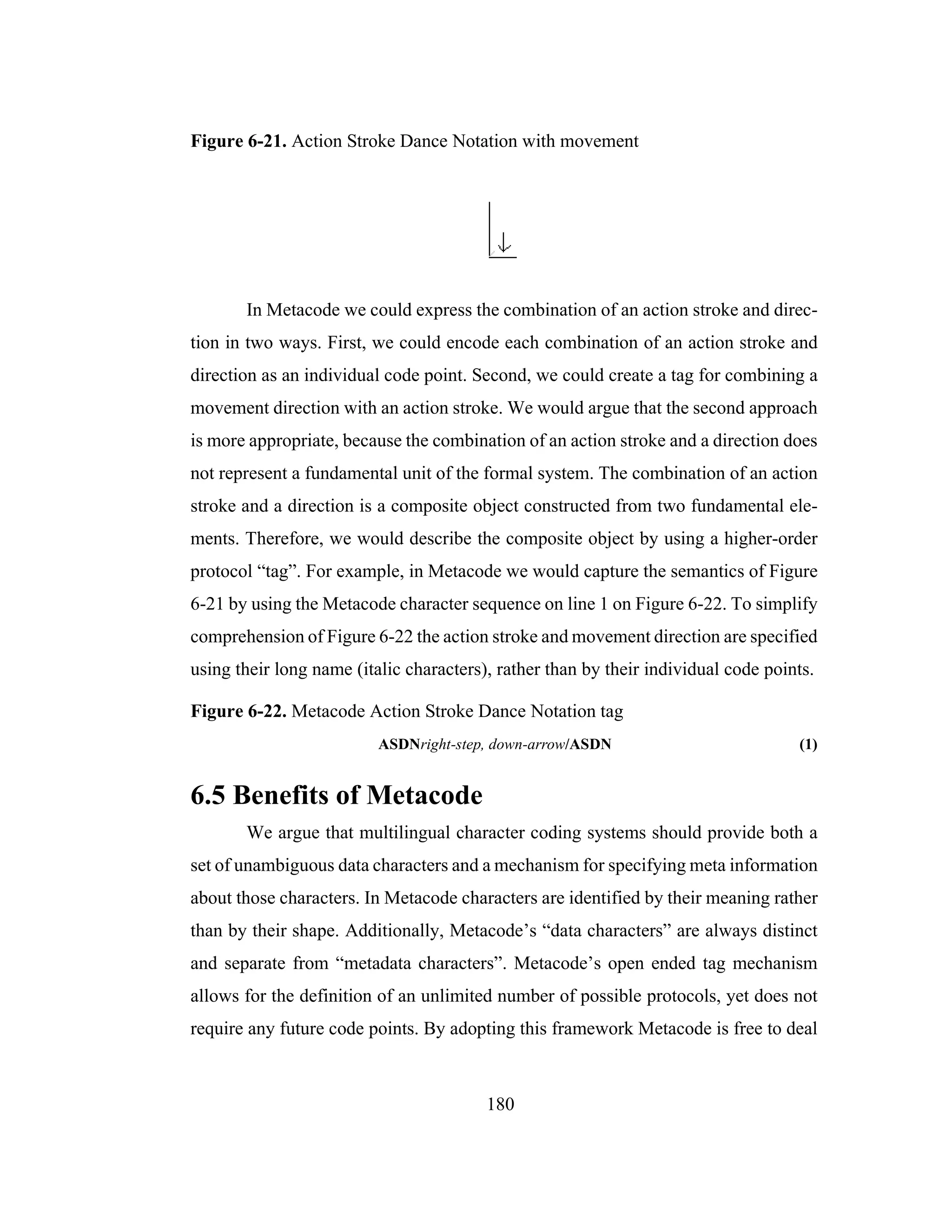
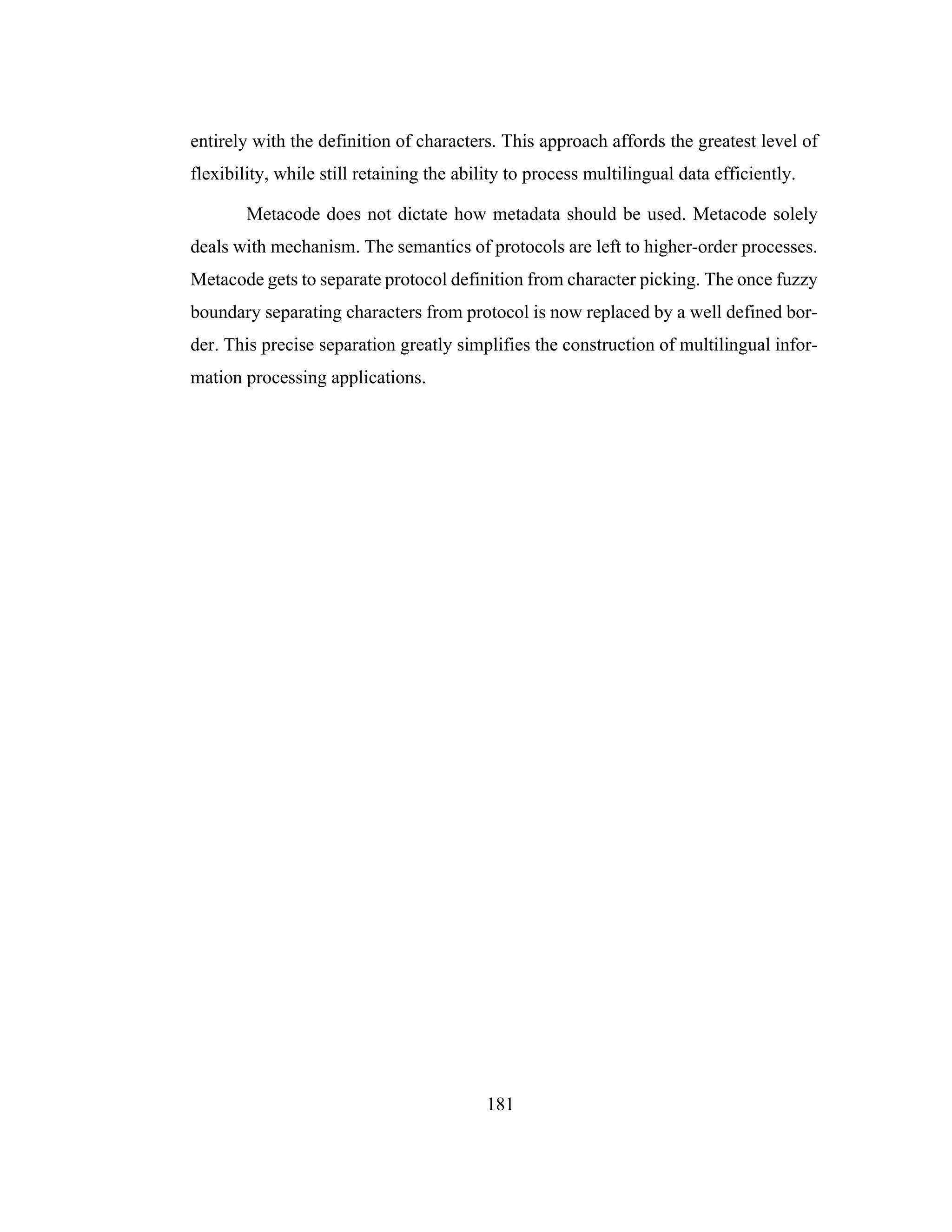
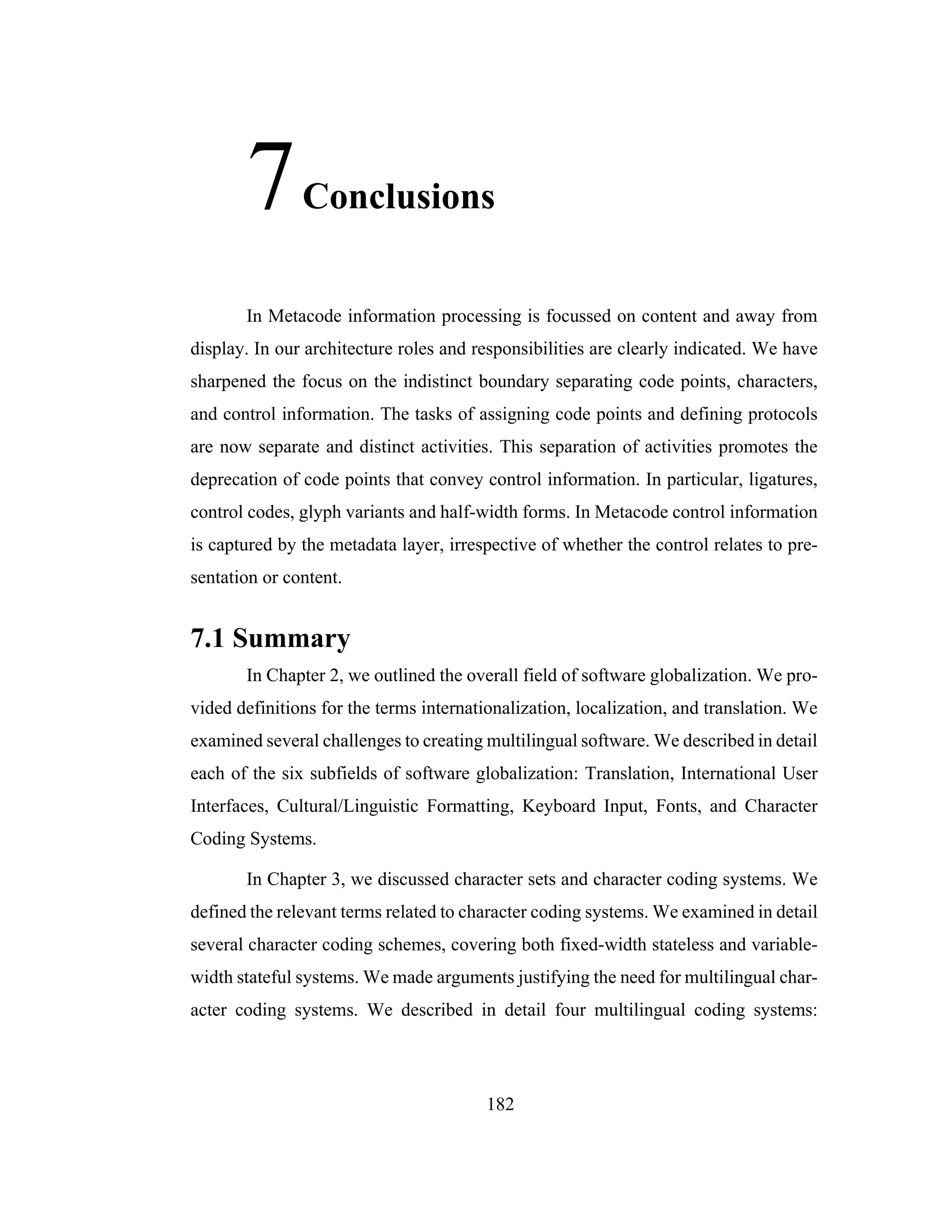
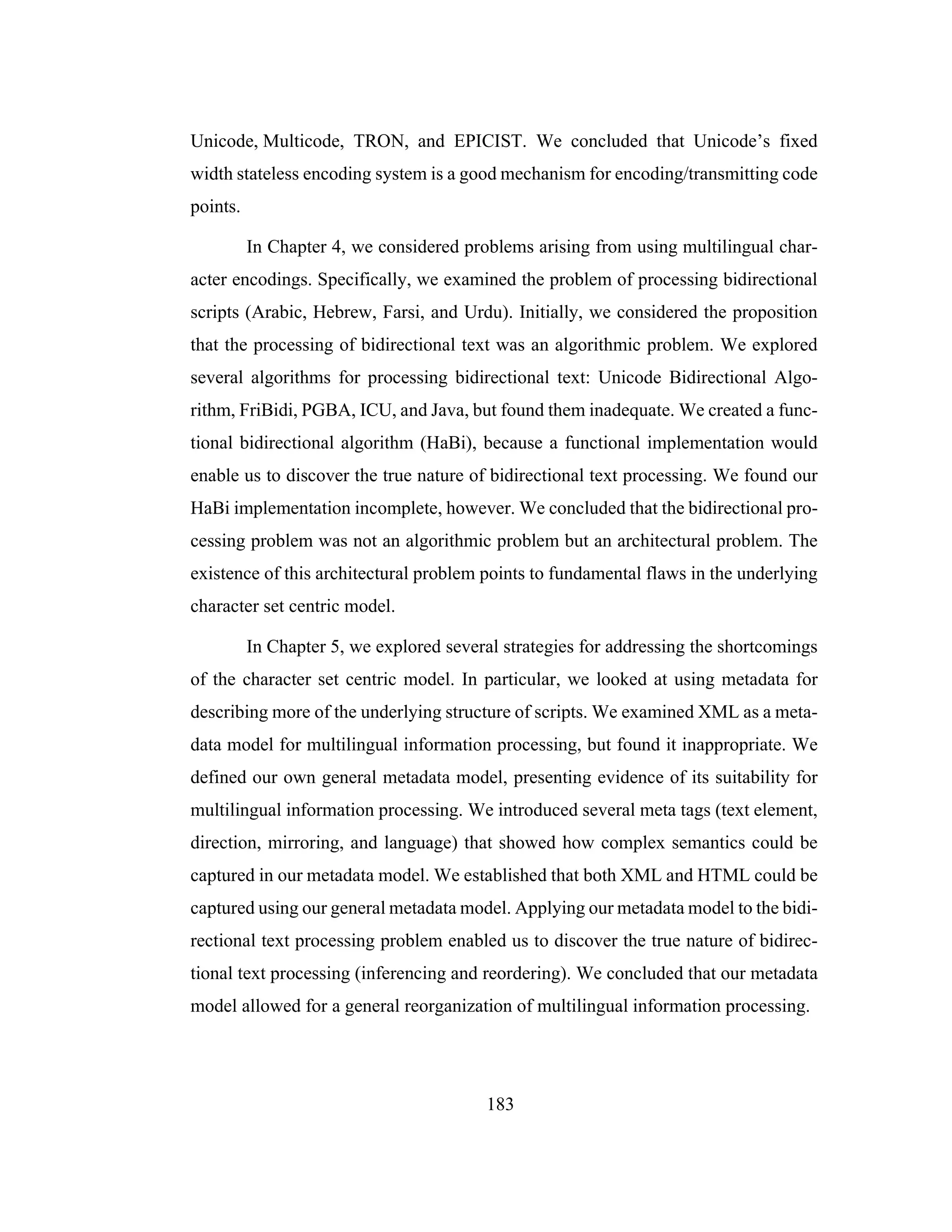
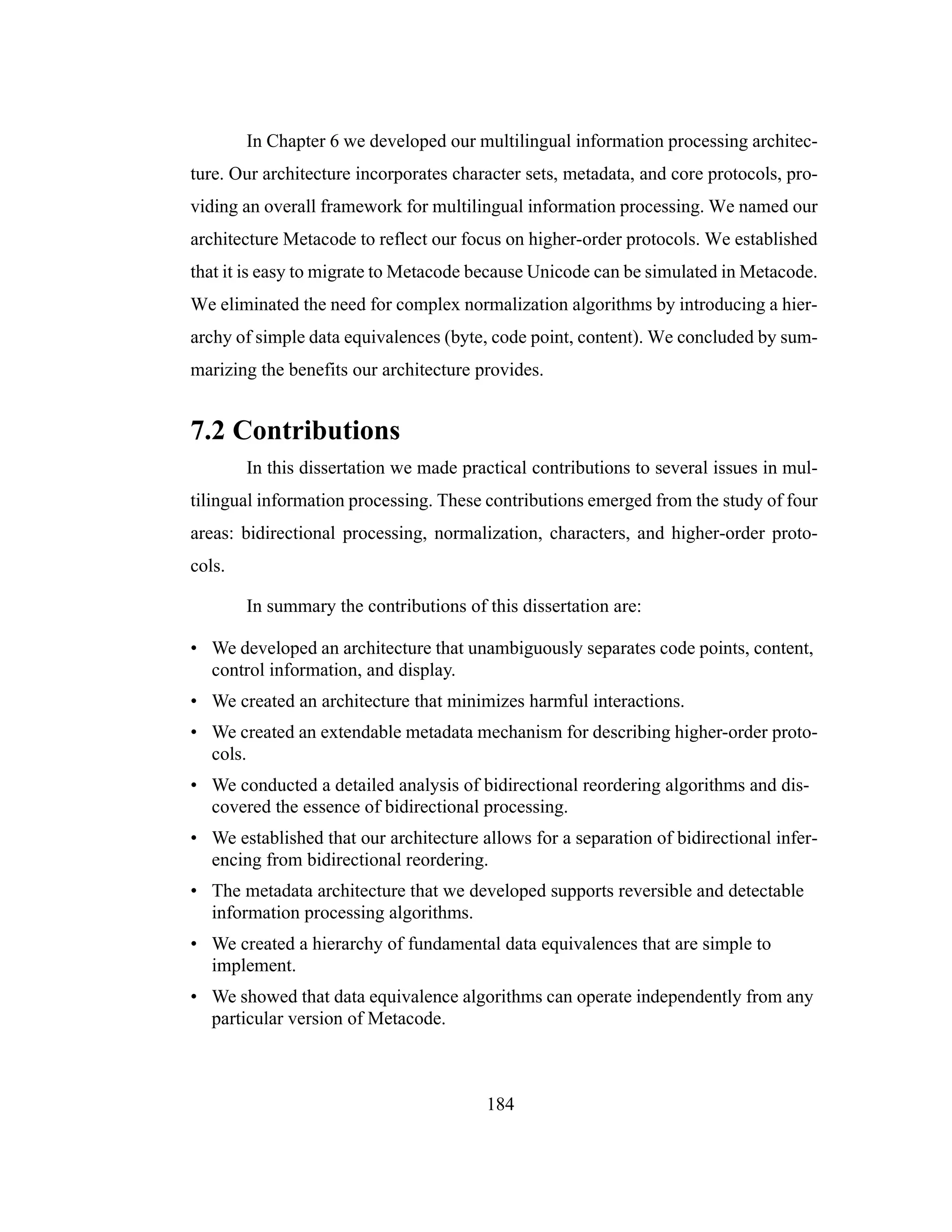

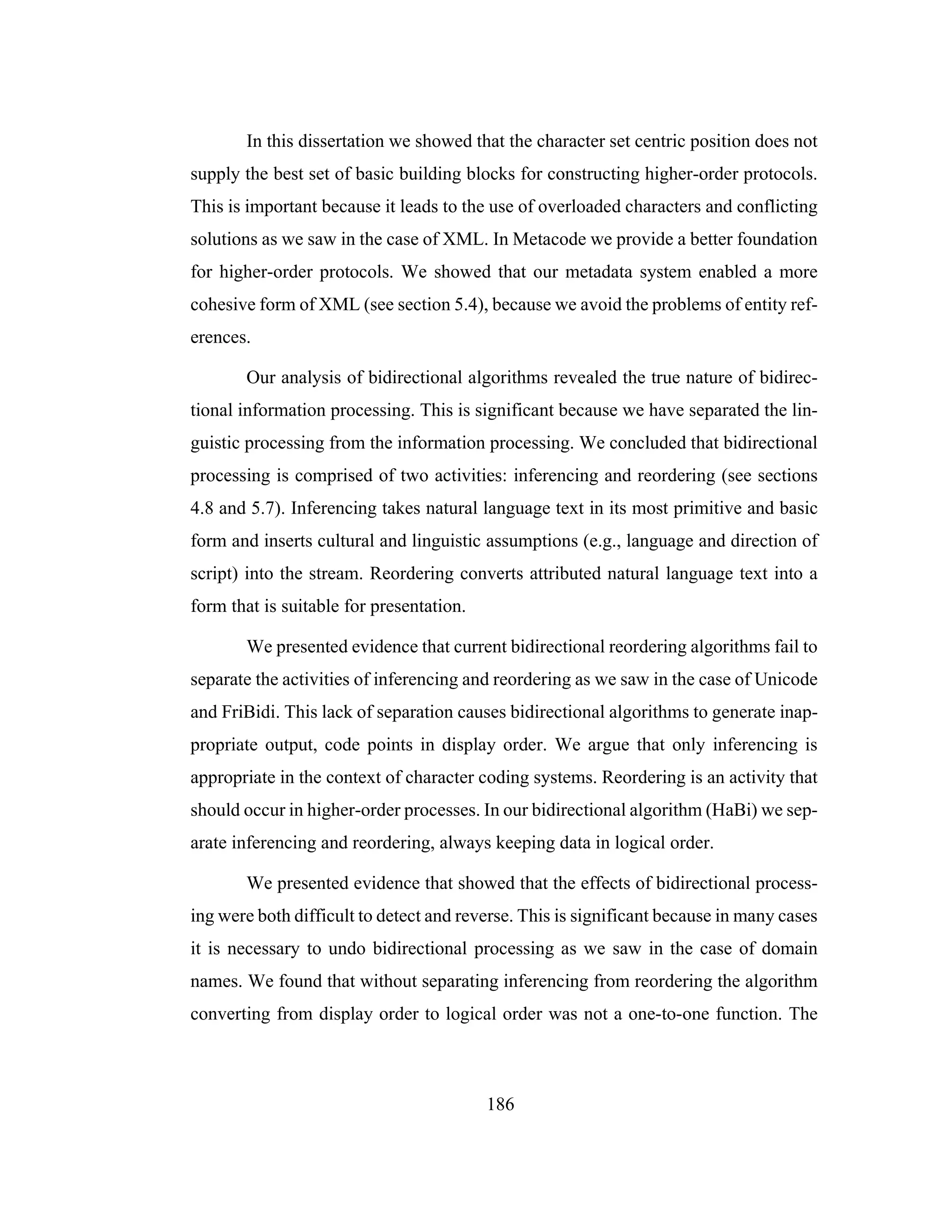


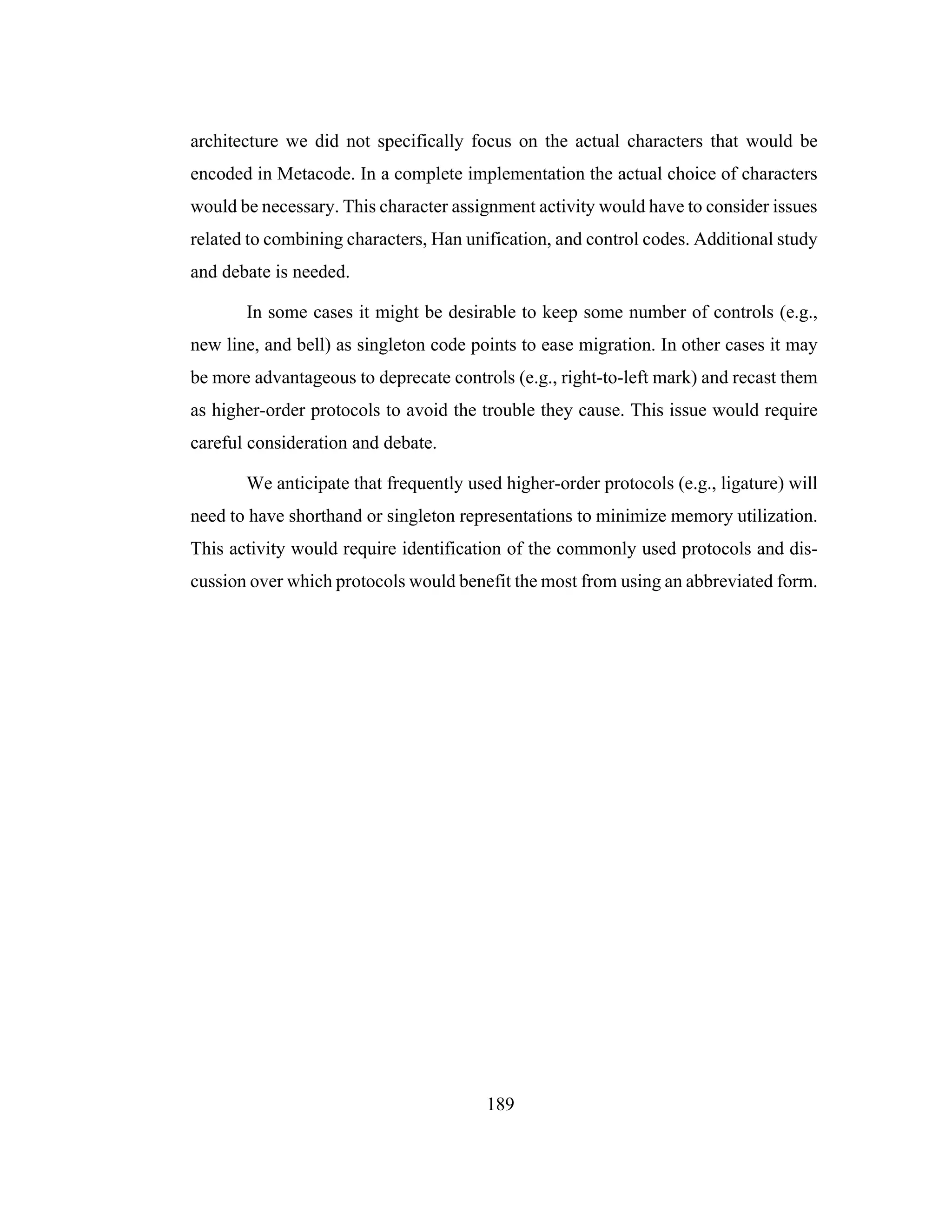
![190
References
[1] Abed, Farough. “Cultural Influences on Visual Scanning Patterns.” Journal of
Cross-Cultural Psychology, December 1991, pp 525-535.
[2] Abramson, Dean. “Optimized Implementations of Bidirectional Text Layout
and Bidirectional Caret Movement.” 13th International Unicode Conference,
September 1998.
[3] Adams, Glen. “Internationalization and Character Set Standards.” Standard
View, The ACM Journal on Standardization, Volume 1, 1993.
[4] Alhadif, Mohamed. “International Music Festival.” Alshafha, 10 July 2001,
p 3. (in Arabic)
[5] Alvestrand, Harald Tevit. “IETF Policy on Character Sets and Languages.”
RFC 1766, March 1995.
[6] Apple Computer. Inside Macintosh Text. Addison-Wesley. 1993.
[7] Apple Computer. “About Apple Advanced Typography Fonts.” February
1998.
[8] Atkin, Steven. “A Dynamic Object-Oriented Approach to Software
Internationalization.” Master’s Thesis Florida Institute of Technology,
December 1994.
[9] Atkin, Steven and Borgendale, Ken. “IBM Graphical Locale Builder.” 12th
International Unicode Conference, April 1998.
[10] Atkin, Steven and Stansifer, Ryan. “Implementations of Bidirectional
Reordering Algorithms.” 18th International Unicode Conference, April 2001.](https://image.slidesharecdn.com/0f3c79e3-c95a-412c-8137-2676e0a933c3-161215183642/75/cs-2002-01-204-2048.jpg)
![191
[11] Au, Sunny. “Hello, World! A Guide For Transmitting Multilingual Electronic
Mail.” Proceedings of the 23rd ACM SIGUCCS conference on Winning the
networking game, October 1995, pp 35-39.
[12] Becker, Joseph. “Arabic Word Processing.” Communications of the ACM,
July 1987, Volume 30, Number 7, pp 600-610.
[13] Becker, Joseph. “Unicode 88.” Xerox Corporation, 1988.
[14] Belge, Matt. “The Next Step In Software Internationalization.” Interactions,
January 1995, Volume 2, Number 1, pp 21-25.
[15] Bemer, R. W. “The American Standard Code For Information Interchange.”
Datamation, 9, No. 8, 32-36, August 1963, and ibid 9, No. 9, 39-44,
September 1963.
[16] Bettels, Jürgen and Bishop, Avery F. “Unicode: A Universal Character Code.”
Digital Technical Journal, 1993, Number 3, Volume 5, pp 21-31.
[17] Budge, E.A. Wallis. An Egyptian Hieroglyphic Dictionary. Dover
Publications. 1978.
[18] Clark, James. “Minority WG Opinion on XML C14N and Unicode C14N.”
Available: http://www19.w3.org/Archives/Public/www-xml-canonicalization-
comments/2000Jan/0000.html. Retrieved: January 21, 2001.
[19] Cooper, Iver P. “Action Stroke Dance Notation.” Available: http://
www.geocites.com/Broadway/Stage/2806/. Retrieved: August 12, 2001.
[20] Davis, Mark. et al. “Creating Global Software: Text Handling and
Localization in Taligent’s CommonPoint Application System.” IBM Systems
Journal, 1996, Number 2, Volume 35, pp 227-242.
[21] Davis, Mark. et al. “International Text In JDK 1.2.” Available: http://
www.ibm.com/java/education/international-text/. Retrieved: July 17, 2000.](https://image.slidesharecdn.com/0f3c79e3-c95a-412c-8137-2676e0a933c3-161215183642/75/cs-2002-01-205-2048.jpg)
![192
[22] Democratic Peoples Republic of Korea. “DPRK Standard Korean Graphic
Character Set for Information Interchange.” KPS 9566-97, 1997.
[23] Dürst, Martin and Freytag, Asmus “Unicode in XML and Other Markup
Languages.” Available: http://www.unicode.org/unicode/reports/tr20.
Retrieved: January 9, 2001.
[24] Edberg, Peter. “Tutorial: Survey of Character Encodings.” 11th International
Unicode Conference, September 1997.
[25] Erickson, Thomas D. “Working With Interface Metaphors.” in The Art of
Human Computer Interface Design. edited by Brenda Laurel, Addison-
Wesley. 1990.
[26] European Computer Manufacturers Association. “7-Bit Coded Character Set.”
ECMA-6, December 1991.
[27] European Computer Manufacturers Association. “Character Code Structure
and Extension Techniques.” ECMA-35, December 1994.
[28] Fateman, Richard “Algol 60, a language, a report.” Available: http://
www.cs.berkley.edu/~fateman/264/lec/notes17.pdf. Retrieved: April 17, 2001.
[29] Fernandes, Tony. Global Interface Design. AP Professional. 1995.
[30] Flanagan, David. Java in a Nutshell. O’Reilly and Associates. 1999.
[31] Goundry, Norman “Why Unicode Won’t Work On The Internet: Linguistic,
Political, and Technical Limitations.” Available: http://
www.hastingsresearch.com/net/04-unicode-limitations.shtml. Retrieved: June
5, 2001.
[32] Graham, Tony. Unicode A Primer. M&T Books. 2000.](https://image.slidesharecdn.com/0f3c79e3-c95a-412c-8137-2676e0a933c3-161215183642/75/cs-2002-01-206-2048.jpg)
![193
[33] Graham, Tony. “Changes in Unicode that led to changes in XML 1.0 Second
Edition.” Available: http://www-106.ibm.com/developerworks/library/u-
xml.html. Retrieved: January 20, 2001.
[34] Grobgeld, Dov. “A Free Implementation of the Unicode Bidi Algorithm.”
Available: http://imagic.weizmann.ac.il/~dov/freesw/FriBidi/. Retrieved: July
17, 2000.
[35] Hall, William S. “Internationalization in Windows NT, Part:1 Programming
with Unicode.” Microsoft Systems Journal, June 1994, pp 57-71.
[36] Holmes, Neville. “Toward Decent Text Encoding.” IEEE Computer, 1998,
Number 8, Volume 31, August, pp 108-109.
[37] Homes, Nigel. “An Introduction to Pictoral Symbols.” in Designing Pictoral
Symbols, Watson-Guptill, 1990.
[38] Horton, William. The Icon Book: Visual Symbols for Computer Systems and
Documentation. John Wiley & Sons. 1994.
[39] Hughes, John. “Why Functional Programming Matters.” Computer Journal,
1989, Volume 32, Number 2, pp 98-107.
[40] International Business Machines Corporation. National Language Design
Guide, NLDG Volume 2. IBM Canada Ltd. 1994.
[41] International Business Machines Corporation. National Language Support
Bidi Guide, NLDG Volume 3. IBM Canada Ltd. 1995.
[42] International Business Machines Corporation. MBCS/DBCS Character Set
and Code Page System Architecture. IBM Japan Ltd. 1996.
[43] International Business Machines Corporation. MBCS Cross System Guide:
Volume1 - Character Set and Code Page. IBM Japan Ltd. 1997.](https://image.slidesharecdn.com/0f3c79e3-c95a-412c-8137-2676e0a933c3-161215183642/75/cs-2002-01-207-2048.jpg)
![194
[44] International Business Machines Corporation. OS/2 Warp Server for e-
business Keyboards and Code Pages. IBM. 1999.
[45] International Business Machines Corporation. “IBM Classes for Unicode.”
Available: http://www.ibm.com/java/tools/international-classes/index.html.
Retrieved: July 17, 2000.
[46] International Organization for Standardization. “ISO 7-bit Coded Character
Set for Information Interchange.” International Standard ISO/IEC 646:1991,
1991.
[47] International Organization for Standardization. “8-bit Single-Byte Coded
Graphic Character Sets - Part 1: Latin Alphabet No. 1.” International
Standard ISO/IEC 8859-1: 1998, 1998.
[48] Ishida, Richard. “Non-Latin Writing Systems: Characteristics and Impact on
Multinational Product Design.” 18th International Unicode Conference, April
2001.
[49] Jennings, Tom. “ASCII: American Standard Code for Information
Infiltration.” Available: http://fido.wps.com/texts/codes. Retrieved: January 9,
2001.
[50] Jones, Scott. et. al. Digital Guide to Developing International User
Information. Digital Press. 1992.
[51] Jones, Simon P. et al. “Report on the Programming Language Haskell 98, A
Non-strict, Purely Functional Language.” Yale University, Department of
Computer Science Tech Report YALEU/DCS/RR-1106, February 1999.
[52] Kano, Nadine. Developing International Software For Windows 95 and
Windows NT. Microsoft Press. 1995.
[53] Kataoka, Tomoko I. et al. “Internationalized Text Manipulation Covering
Perso-Arabic Enhanced for Mongolian Scripts.” Lecture Notes in Computer
Science, 1998, Volume 1375, pp 305-318.](https://image.slidesharecdn.com/0f3c79e3-c95a-412c-8137-2676e0a933c3-161215183642/75/cs-2002-01-208-2048.jpg)
![195
[54] Korpela, Jukka. “A Tutorial on Character Code Issues.” Available: http://
www.hut.fi/u/jkorpela/chars.html. Retrieved: January 9, 2001.
[55] Lehtola, Aarno and Honkela, Timo. “A Framework for Global Software.”
Proceedings of the 1st ERCIM Workshop on ‘User Interfaces for All’, 1995.
[56] Leisher, Mark. “The UCData Unicode Character Properties and Bidi
Algorithm Package.” Available: http://crl.nmsu.edu/~mleisher/ucdata.html.
Retrieved: July 17, 2000.
[57] Lunde, Ken. CJKV Information Processing. O’Reilly. 1999.
[58] Lunde, Ken. “A New Standard For Japanese.” Multilingual Computing and
Technology, 2000, Number 35, Volume 11, Issue 7, pp 45-46.
[59] Lunde, Ken. “CJKV Character Set and Encoding Developments.”
Multilingual Computing and Technology, 2001, Number 39, Volume 12, Issue
3, pp 53-55.
[60] Lunde, Ken “What’s New In Unicode 3.1.” Multilingual Computing and
Technology, 2001, Number 42, Volume 12, Issue 6, p 51.
[61] Luong, Tuoc V. et. al. Internationalization Developing Software for Global
Markets. John Wiley and Sons Inc. 1995.
[62] MacKay, Pierre. “Typesetting Problem Scripts.” Byte Magazine, 1986,
Volume 11, Number 2, pp 201-218.
[63] Madell, Tom. et. al. Developing and Localizing International Software.
Prentice Hall. 1994.
[64] Maeda, Akira. “Studies on Multilingual Information Processing.” Doctor’s
Thesis Nara Institute of Science and Technology, September 18, 2000.
[65] Math Forum, The. “Math Typesetting for the Internet.” Available: http://
forum.swarthmore.edu/typesetting/. Retrieved: August 13, 2001.](https://image.slidesharecdn.com/0f3c79e3-c95a-412c-8137-2676e0a933c3-161215183642/75/cs-2002-01-209-2048.jpg)
![196
[66] Meyer, Dirk. “New Hong Kong Character Standard.” Multilingual Computing
and Technology, 2000, Number 30, Volume 11, Issue 2, pp 30-32.
[67] Meyer, Dirk. “A New Chinese Character Set Standard.” Multilingual
Computing and Technology, 2001, Number 37, Volume 12, Issue 1, pp 63-68.
[68] Meyer, Dirk. “Two New Chinese Character Standards: HK SCS & GB 18030-
2000.” 18th International Unicode Conference, April 2001.
[69] Microsoft. “TrueType Open Font Specification.” version 1.0. July 1995.
[70] Miller, Gary. Personal Correspondence. September 21, 2001.
[71] Milo, Thomas. “Creating Solutions for Arabic: A Case Study.” 18th
International Unicode Conference, April 2001.
[72] Morrison, Michael. et al. XML Unleashed. Sams Publishing. 1999.
[73] Mount Tahoma High School. “Japanese Tutorial.” Available: http://
www.tacoma.k12.wa.us/schools/hs/mount_tahoma/dept/japanese/. Retrieved:
August 24, 2001.
[74] Mudawwar, Muhammad F. “Multicode: A Truly Multilingual Approach to
Text Encoding.” IEEE Computer, 1997, Number 4, Volume 30, April, pp 37-
43.
[75] O’Donnell, Sandra M. Programming for the World - A Guide to
Internationalization. Prentice Hall. 1994.
[76] Ohta, Masataka. “On Plain Text.” International Symposium on Multilingual
Information Processing, Tsukuba Japan, March 25-26, 1996.
[77] Omniglot. “Phonetic Transcription of Chinese.” Available:
http:www.omniglot.com/writing/chinese2.htm. Retrieved: August 30, 2001.](https://image.slidesharecdn.com/0f3c79e3-c95a-412c-8137-2676e0a933c3-161215183642/75/cs-2002-01-210-2048.jpg)
![197
[78] Osawa, Noritaka. “EPICS: An Efficient, Programmable and Interchangeable
Code System for WWW.” 6th International World Wide Web Conference,
April, 1997.
[79] Osawa, Noritaka. “A Multilingual Information Processing Infrastructure for
Global Digital Libraries: EPICIST.” Proceedings of the International
Symposium on Research, Development and Practice in Digital Libraries,
November, 1997.
[80] Rossini, Stephane. Egyptian Hieroglyphics. Dover Publications. 1989.
[81] Ruesch, Jurgen and Kees, Weldon. “The Language of Identification and
Recognition.” in Nonverbal Communication, Berkeley: University of
California Press. 1970.
[82] Sakamura, Ken. “The TAD Language Environment and Multilingual
Handling.” TRONWARE, 1992, Volume 50, pp 49-57.
[83] Salomon, Gitta. “New Uses for Color.” in The Art of Human Computer
Interface Design. edited by Brenda Laurel, Addison-Wesley. 1990.
[84] Scherer, Markus. “GB 18030: A Mega-Codepage.” Available: http:www-
106.ibm.com/developerworks/unicode/library/u-china.html. Retrieved:
August 31, 2001.
[85] Schmitt, David A. International Programming for Microsoft Windows.
Microsoft Press. 2000.
[86] Searfoss, Glenn. JIS-Kanji Character Recognition. Van Nostrand Reinhold.
1994.
[87] Smura, Edwin J. and Provan, Archie D. “Toward a New Beginning: The
Development of a Standard for Font and Character Encoding to Control
Electronic Document Interchange.” IEEE Transactions on Professional
Communication. 1987, Number 4, Volume PC-30, pp 259-264.
[88] Stallman, Richard. GNU Emacs Manual. Free Software Foundation. 1999.](https://image.slidesharecdn.com/0f3c79e3-c95a-412c-8137-2676e0a933c3-161215183642/75/cs-2002-01-211-2048.jpg)
![198
[89] Sun Microsystems. “Complex Text Layout Language Support in the Solaris
Operating Environment.” Available: http://www.sun.com/software/white-
papers/wp-cttlanguage/. Retrieved: July 17, 2000.
[90] Tanenbaum, Andrew S. Computer Networks. Prentice Hall. 1996.
[91] Taylor, David. Global Software: Developing Applications for the
International Market. Springer-Verlag. 1992.
[92] Turley, James. “Computing In Vietnamese.” Multilingual Computing and
Technology, 1998, Number 20, Volume 9, Issue 4, pp 25-29.
[93] Turley, James. “Computing In Chinese Poses Unique Challenges.”
Multilingual Computing and Technology, 1999, Number 27, Volume 10, Issue
5, pp 30-33.
[94] Turley, James. “Computing in Chinese.” Multilingual Computing and
Technology, 2000, Number 28, Volume 10, Issue 6, pp 28-30.
[95] Tuthill, Bill. and Smallberg, David. Creating Worldwide Software. Sun
Microsystems Press. 1997.
[96] Unicode Consortium, The. The Unicode Standard, Version 3.0. Addison-
Wesley. 2000.
[97] Unicode Consortium, The. “Unicode 3.0.1.” Available: http://
www.unicode.org/unicode/standard/versions/Unicode3.0.1.html. Retrieved:
January 17, 2001.
[98] Unicode Consortium, The. “Unicode 3.1.” Available: http://www.unicode.org/
unicode/standard/versions/Unicode3.1.html. Retrieved: August 13, 2001.
[99] Unicode Consortium, The. “Plane 14 Characters for Language Tags.”
Available: http://www.unicode.org/reports/tr7. Retrieved: January 9, 2001.](https://image.slidesharecdn.com/0f3c79e3-c95a-412c-8137-2676e0a933c3-161215183642/75/cs-2002-01-212-2048.jpg)
![199
[100] Unicode Consortium, The. “Unicode Technical Report #9 - The Bidirectional
Algorithm.” Available: http://www.unicode.org/unicode/reports/tr9/tr9-6.html
Retrieved: July 17, 2000.
[101] Unicode Consortium, The. “Unicode Standard Annex #15 - Unicode
Normalization Forms.” Available: http://www.unicode.org/unicode/reports/
tr15. Retrieved: January 9, 2001.
[102] Van Camp, David. “Unicode and Software Globalization.” Dr. Dobb’s
Journal, 1994, March, pp 46-50.
[103] Vine, Andrea. “An Overview Of The Unicode Standard 2.1.” Multilingual
Computing and Technology, 1998, Number 23, Volume 10, Issue 1, pp 50-52.
[104] Vine, Andrea. “Demystifying Character Sets.” Multilingual Computing and
Technology, 1999, Number 26, Volume 10, Issue 4, pp 48-52.
[105] Walters, Richard F. “Design of a Bitmapped Multilingual Workstation.” IEEE
Computer, 1990, Number 2, Volume 23, February, pp 33-41.
[106] Weider, Chris. et. al. “The Report of the IAB Character Set Workshop.” RFC
2130, April 1997.
[107] World Wide Web Consortium, The. “Character Model for the World Wide
Web.” Available: http://www.w3.org/TR/charmod. Retrieved April 10, 2001.
[108] X/Open. X/Open Internationalisation Guide. X/Open Company Ltd. 1992.
[109] Yau, Michael M. T. “Supporting the Chinese, Japanese, and Korean
Languages in the OpenVMS Operating System.” Digital Technical Journal,
1993, Number 3, Volume 5, pp 63-79.
[110] Yergeau, F. “UTF-8 A Transformation Format of Unicode and ISO-10646.”
RFC 2044, October 1996.](https://image.slidesharecdn.com/0f3c79e3-c95a-412c-8137-2676e0a933c3-161215183642/75/cs-2002-01-213-2048.jpg)
![200
[111] Yevgrashina, Lada. “Azerbaijan Drops Cyrillic for Latin Script.” Reuters,
August 3, 2001.](https://image.slidesharecdn.com/0f3c79e3-c95a-412c-8137-2676e0a933c3-161215183642/75/cs-2002-01-214-2048.jpg)
![201
Appendix A
1 -- Rule P2, P3 determine base level of text from the first strong
2 -- directional character
3 p2_3 :: [Attributed] -> Int
4 p2_3 [] = 0
5 p2_3 ((_,L):xs) = 0
6 p2_3 ((_,AL):xs) = 1
7 p2_3 ((_,R):xs) = 1
8 p2_3 (_:xs) = p2_3(xs)
9
10 -- Rules X2 - X9
11 x2_9 :: [Int] -> [Bidi] -> [Bidi] -> [Attributed] -> [Level]
12 x2_9 _ _ _ [] = []
13 x2_9 (l:ls) os es ((x,RLE):xs)
14 = x2_9 ((add l R):l:ls) (N:os) (RLE:es) xs
15 x2_9 (l:ls) os es ((x,LRE):xs)
16 = x2_9 ((add l L):l:ls) (N:os) (LRE:es) xs
17 x2_9 (l:ls) os es ((x,RLO):xs)
18 = x2_9 ((add l R):l:ls) (R:os) (RLO:es) xs
19 x2_9 (l:ls) os es ((x,LRO):xs)
20 = x2_9 ((add l L):l:ls) (L:os) (LRO:es) xs
21 x2_9 ls os (e:es) ((x,PDF):xs)
22 | elem e [RLE,LRE,RLO,LRO] = x2_9 (tail ls) (tail os) es xs
23 x2_9 ls os es ((x,PDF):xs)
24 = x2_9 ls os es xs
25 x2_9 ls os es ((x,y):xs)
26 | (head os) == N = ((head ls),x,y) : x2_9 ls os es xs
27 | otherwise = ((head ls),x,(head os)) : x2_9 ls os es xs
28
29 -- Rule X10 group characters by level
30 x10 :: (Int, Int) -> [Level] -> Run
31 x10 (sor,eor) xs
32 | even sor && even eor = LL xs
33 | even sor && odd eor = LR xs
34 | odd sor && even eor = RL xs
35 | otherwise = RR xs
36
37 -- Process explicit characters X1 - X10
38 explicit :: Int -> [Attributed] -> [Run]
39 explicit l xs = zipWith x10 (runList levels l l) groups
40 where levels = (map (x -> level (head x)) groups)
41 groups = groupBy levelEql (x2_9 [l][N][] xs)
42
43
44
45](https://image.slidesharecdn.com/0f3c79e3-c95a-412c-8137-2676e0a933c3-161215183642/75/cs-2002-01-215-2048.jpg)
![202
46 -- Rules W1 - W7
47 w1_7 :: [Level] -> Bidi -> Bidi -> [Level]
48 w1_7 [] _ _ = []
49 w1_7 ((x,y,L):xs) _ _ = (x,y,L):(w1_7 xs L L)
50 w1_7 ((x,y,R):xs) _ _ = (x,y,R):(w1_7 xs R R)
51 w1_7 ((x,y,AL):xs) _ _ = (x,y,R):(w1_7 xs AL R)
52 w1_7 ((x,y,AN):xs) dir _ = (x,y,AN):(w1_7 xs dir AN)
53 w1_7 ((x,y,EN):xs) AL _ = (x,y,AN):(w1_7 xs AL AN)
54 w1_7 ((x,y,EN):xs) L _ = (x,y,L):(w1_7 xs L EN)
55 w1_7 ((x,y,EN):xs) dir _ = (x,y,EN):(w1_7 xs dir EN)
56 w1_7 ((x,y,NSM):xs) L N = (x,y,L):(w1_7 xs L L)
57 w1_7 ((x,y,NSM):xs) R N = (x,y,R):(w1_7 xs R R)
58 w1_7 ((x,y,NSM):xs) dir last = (x,y,last):(w1_7 xs dir last)
59 w1_7 ((a,b,ES):(x,y,EN):xs) dir EN =
60 (a,b,EN):(x,y,EN):(w1_7 xs dir EN)
61 w1_7 ((a,b,CS):(x,y,EN):xs) dir EN =
62 (a,b,EN):(x,y,EN):(w1_7 xs dir EN)
63 w1_7 ((a,b,CS):(x,y,EN):xs) AL AN =
64 (a,b,AN):(x,y,AN):(w1_7 xs AL AN)
65 w1_7 ((a,b,CS):(x,y,AN):xs) dir AN =
66 (a,b,AN):(x,y,AN):(w1_7 xs dir AN)
67 w1_7 ((x,y,ET):xs) dir EN = (x,y,EN):(w1_7 xs dir EN)
68 w1_7 ((x,y,z):xs) dir last
69 | z==ET && findEnd xs ET == EN && dir /= AL
70 = (x,y,EN):(w1_7 xs dir EN)
71 | elem z [CS,ES,ET] = (x,y,ON):(w1_7 xs dir ON)
72 | otherwise = (x,y,z):(w1_7 xs dir z)
73
74 -- Process a run of weak characters W1 - W7
75 weak :: Run -> Run
76 weak (LL xs) = LL (w1_7 xs L N)
77 weak (LR xs) = LR (w1_7 xs L N)
78 weak (RL xs) = RL (w1_7 xs R N)
79 weak (RR xs) = RR (w1_7 xs R N)
80
81 -- Rules N1 - N2
82 n1_2 :: [[Level]] -> Bidi -> Bidi -> Bidi -> [Level]
83 n1_2 [] _ _ base = []
84 n1_2 (x:xs) sor eor base
85 | isLeft x = x ++ (n1_2 xs L eor base)
86 | isRight x = x ++ (n1_2 xs R eor base)
87 | isNeutral x && sor == R && (dir xs eor) == R
88 = (map (newBidi R) x) ++ (n1_2 xs R eor base)
89 | isNeutral x && sor == L && (dir xs eor) == L
90 = (map (newBidi L) x) ++ (n1_2 xs L eor base)
91 | isNeutral x =
92 (map (newBidi base) x) ++ (n1_2 xs sor eor base)
93 | otherwise = x ++ (n1_2 xs sor eor base)
94](https://image.slidesharecdn.com/0f3c79e3-c95a-412c-8137-2676e0a933c3-161215183642/75/cs-2002-01-216-2048.jpg)
![203
95 -- Process a run of neutral characters N1 - N2
96 neutral :: Run -> Run
97 neutral (LL xs) = LL (n1_2 (groupBy neutralEql xs) L L L)
98 neutral (LR xs) = LR (n1_2 (groupBy neutralEql xs) L R L)
99 neutral (RL xs) = RL (n1_2 (groupBy neutralEql xs) R L R)
100 neutral (RR xs) = RR (n1_2 (groupBy neutralEql xs) R R R)
101
102
103 -- Rule I1, I2
104 i1_2 :: [[Level]] -> Bidi -> [Level]
105 i1_2 [] _ = []
106 i1_2 ((x:xs):ys) dir
107 | attrib x == R && dir == L
108 = (map (newLevel 1) (x:xs)) ++ (i1_2 ys L)
109 | elem (attrib x) [AN,EN] && dir == L
110 = (map (newLevel 2) (x:xs)) ++ (i1_2 ys L)
111 | elem (attrib x) [L,AN,EN] && dir == R
112 = (map (newLevel 1) (x:xs)) ++ (i1_2 ys R)
113 i1_2 (x:xs) dir = x ++ (i1_2 xs dir)
114
115 -- Process a run of implicit characters I1 - I2
116 implicit :: Run -> Run
117 implicit (LL xs) = LL (i1_2 (groupBy bidiEql xs) L)
118 implicit (LR xs) = LR (i1_2 (groupBy bidiEql xs) L)
119 implicit (RL xs) = RL (i1_2 (groupBy bidiEql xs) R)
120 implicit (RR xs) = RR (i1_2 (groupBy bidiEql xs) R)
121
122 -- If a run is odd (L) then reverse the characters
123 reverseRun :: [Level] -> [Level]
124 reverseRun [] = []
125 reverseRun (x:xs)
126 | even (level x) = x:xs
127 | otherwise = reverse (x:xs)
128
129 reverseLevels :: [[Level]] -> [[Level]] -> Int -> [[Level]]
130 reverseLevels w [] _ = w
131 reverseLevels w (x:xs) a = if (level (head x)) >= a
132 then reverseLevels (x:w) xs a
133 else w ++ [x] ++ (reverseLevels [] xs a)
134
135 -- Rule L2 Reorder
136 reorder:: [Run] -> Bidi -> [[Level]]
137 reorder xs base = foldl (reverseLevels []) runs levels
138 where
139 flat = concat (map toLevel xs)
140 runs = map reverseRun (groupBy levelEql flat)
141 levels = getLevels runs
142
143](https://image.slidesharecdn.com/0f3c79e3-c95a-412c-8137-2676e0a933c3-161215183642/75/cs-2002-01-217-2048.jpg)
![204
144 -- Rule L4 Mirrors
145 mirror:: [Level] -> [Level]
146 mirror [] = []
147 mirror ((x,y,R):xs) = case getMirror y of
148 Nothing -> (x,y,R):(mirror xs)
149 Just a -> (x,a,R):(mirror xs)
150 mirror (x:xs) = x:(mirror xs)
151
152 logicalToDisplay :: [Attributed] -> [Utf-32]
153 logicalToDisplay attribs
154 =let baseLevel = p2_3 attribs in
155 let baseDir = (if odd baseLevel then R else L) in
156 let x = explicit baseLevel attribs in
157 let w = map weak x in
158 let n = map neutral w in
159 let i = map implicit n in
160 map character (mirror (concat (reorder i baseDir)))](https://image.slidesharecdn.com/0f3c79e3-c95a-412c-8137-2676e0a933c3-161215183642/75/cs-2002-01-218-2048.jpg)
![205
Appendix B
1 -- Unicode metadata tags
2 dirL = map intToWord32 [0xe0044,0xe0049,0xe0052,0xe0002,0xe004c,0xe0001]
3 dirR = map intToWord32 [0xe0044,0xe004c,0xe0052,0xe0002,0xe0052,0xe0001]
4 dirEnd = map intToWord32 [0xe007f,0xe0044,0xe0049,0xe0052,0xe0001]
5 parL = map intToWord32 [0xe0050,0xe0041,0xe0052,0xe0002,0xe004c,0xe0001]
6 parR = map intToWord32 [0xe0050,0xe0041,0xe0052,0xe0002,0xe0052,0xe0001]
7 parEnd = map intToWord32 [0xe007f,0xe0050,0xe0041,0xe0052,0xe0001]
8
9 -- Mark the level with the bidi tags
10 tagLevel :: Int -> [Level] -> [Ucs4]
11 tagLevel _ [] = []
12 tagLevel level ((x,y,z):xs)
13 | level /= x && even x
14 = dirL ++ (map character ((x,y,z):xs)) ++ dirEnd
15 | level /= x && odd x
16 = dirR ++ (map character ((x,y,z):xs)) ++ dirEnd
17 | otherwise
18 = map character ((x,y,z):xs)
19
20 -- Mark the run with the bidi tags
21 tagRun :: Int -> Run -> [Ucs4]
22 tagRun z (LL xs) = parL ++ concat (map (tagLevel z)
23 (groupBy levelEql (mirror xs))) ++ parEnd
24 tagRun z (LR xs) = parL ++ concat (map (tagLevel z)
25 (groupBy levelEql (mirror xs))) ++ parEnd
26 tagRun z (RL xs) = parR ++ concat (map (tagLevel z)
27 (groupBy levelEql (mirror xs))) ++ parEnd
28 tagRun z (RR xs) = parR ++ concat (map (tagLevel z)
29 (groupBy levelEql (mirror xs))) ++ parEnd
30
31 -- Insert mirror tags
32 mirror :: [Level] -> [Level]
33 mirror [] = []
34 mirror ((x,y,R):xs)
35 | isMirrored y
36 = (x,0xe004d,R):(x,0xe0049,R):(x,0xe0052,R):(x,y,R)
37 : mirror xs
38 | otherwise = (x,y,R) : (mirror xs)
39 mirror (x:xs) = x : (mirror xs)](https://image.slidesharecdn.com/0f3c79e3-c95a-412c-8137-2676e0a933c3-161215183642/75/cs-2002-01-219-2048.jpg)
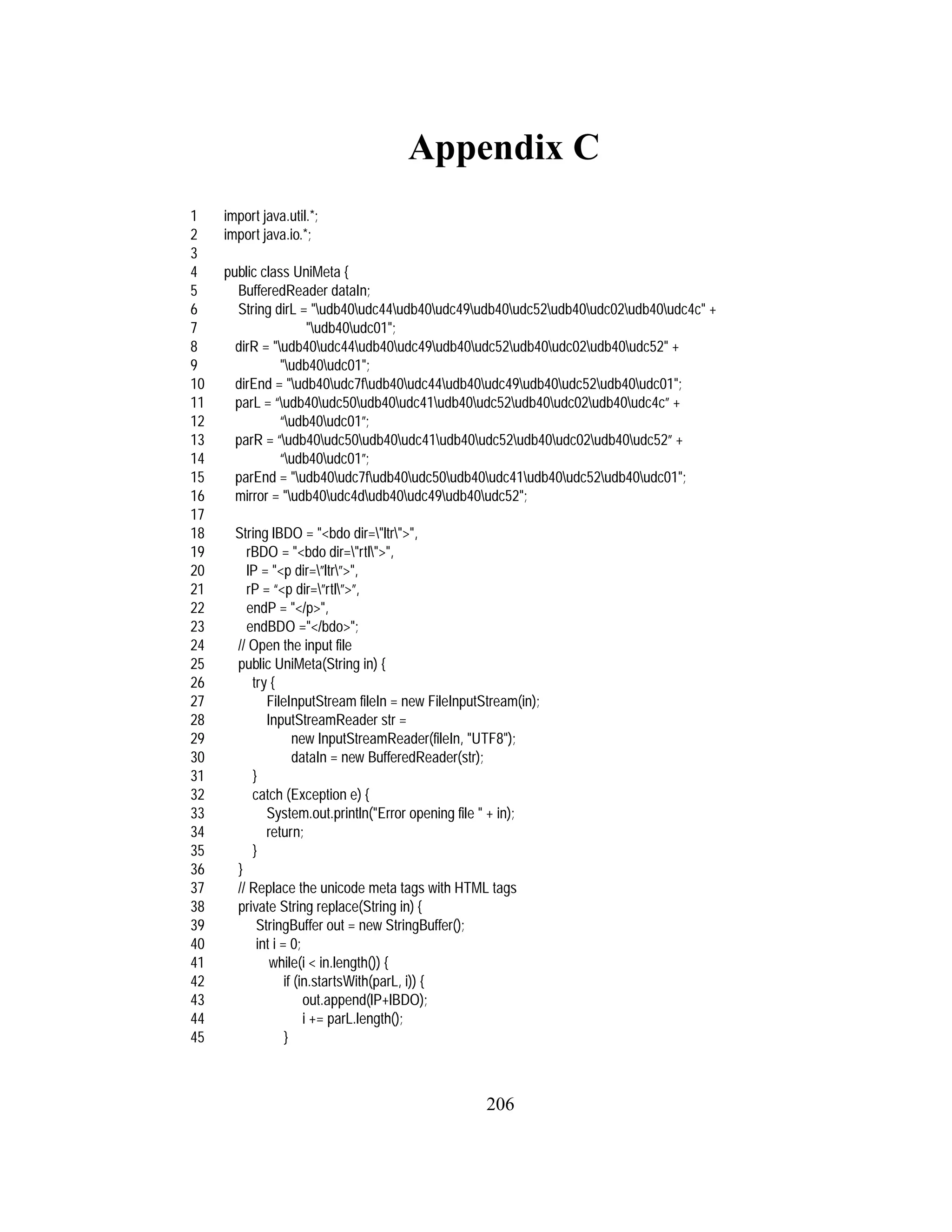
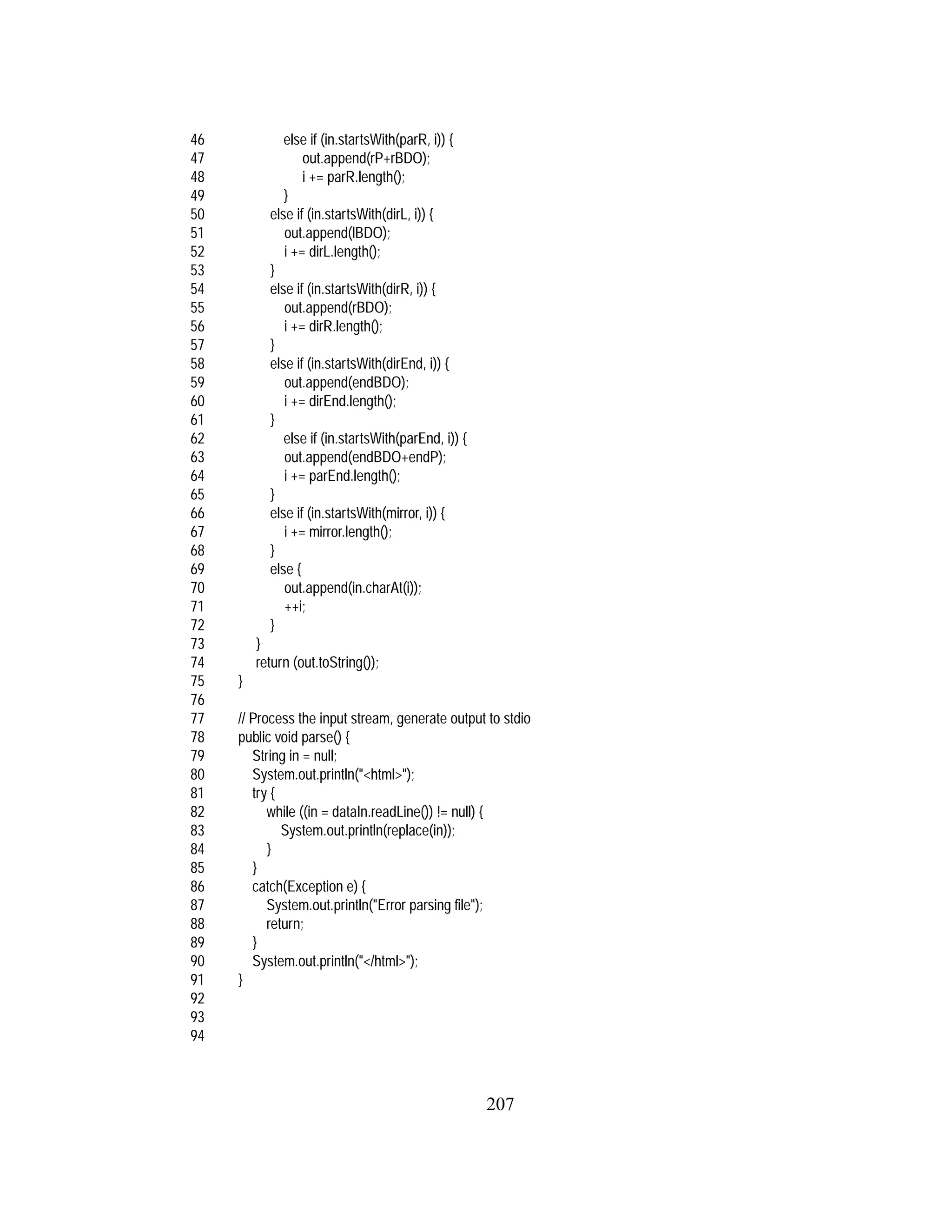
![208
95 public static void main(String[] args) {
96 UniMeta input = new UniMeta(args[0]);
97 input.parse();
98 }
99 }](https://image.slidesharecdn.com/0f3c79e3-c95a-412c-8137-2676e0a933c3-161215183642/75/cs-2002-01-222-2048.jpg)
![209
Appendix D
1 module Metacode where
2
3 import Unicode
4 import Word
5
6 type MetaChar = Ucs4
7
8 listFilter :: Eq a => (a -> Bool) -> [a] -> [a]
9 listFilter _ [] = []
10 listFilter f (x:xs) = if f x then listFilter f xs else x:(listFilter f xs)
11
12 listEqual :: Eq a => [a] -> [a] -> Bool
13 listEqual [] [] = True
14 listEqual [] _ = False
15 listEqual _ [] = False
16 listEqual (x:xs) (y:ys) = if x == y then listEqual xs ys else False
17
18 isMetadata :: MetaChar -> Bool
19 isMetadata x
20 | x >= 0xe0000 && x <= 0xe007f = True
21 | otherwise = False
22
23 byteEquivalent :: [Word8] -> [Word8] -> Bool
24 byteEquivalent xs ys = listEqual xs ys
25
26 codePointEquivalent :: [MetaChar] -> [MetaChar] -> Bool
27 codePointEquivalent xs ys = listEqual xs ys
28
29 contentEquivalent :: [MetaChar] -> [MetaChar] -> Bool
30 contentEquivalent xs ys
31 = let fxs = listFilter isMetadata xs
32 fys = listFilter isMetadata ys in
33 codePointEquivalent fxs fys](https://image.slidesharecdn.com/0f3c79e3-c95a-412c-8137-2676e0a933c3-161215183642/75/cs-2002-01-223-2048.jpg)